- Skip to primary navigation
- Skip to main content
- Skip to primary sidebar
- Skip to footer
Yacht Cruising Lifestyle
Everything fun you can do from your yacht

Boat Restoration Tips, Tricks, and Costs
August 29, 2021 by Martin Parker 6 Comments
Are you considering boat restoration as a cheap way to get on the water? While restoring a tired boat can save you money if you do most of the work yourself, there is a lot to consider and plan for if the costs are not to get out of hand.
Restoring a boat is a labor of love and something you are not likely to take on unless the boat concerned has some special meaning for you or you’re trying to save money. It is vital to understand that boats do not generally appreciate value unless they have some historical significance. Unlike car restoration, where collectors will pay big money for classic cars, the same is not true in the yachting world.
Don’t let that put you off, though. Bringing a boat back to pristine condition is hugely satisfying and something to be proud of.
Step-By-Step Process of Boat Restoration
Do You Need a Survey Before Commiting to Boat Restoration?
If you’ve recently purchased a boat, then you should have had a survey carried out already. If this is a boat you’ve owned for a while and intend to restore it, then a survey could be a good idea before you start. There are different types of surveys available, but the most common is the condition and value survey. The surveyor assesses the boat’s overall condition, reports any problems, and gives a market valuation.
You may need specialized surveys for the engine and other systems, and you can find accredited surveyors on the NAMSGLobal website or the Society of Accredited Marine Surveyors .
Clean the Boat Thoroughly
While it may seem an odd suggestion, thoroughly cleaning the boat has a practical purpose. While cleaning your boat, you can spot any problems you may have missed previously. Cleaning also gives you a base standard to start from and will save you time in the long run. Unblock all the drainage holes, thoroughly clean the bilge, and lift any hull access points to clean and inspect.
List Broken Items
Making a list of parts that need replacing or repairing is vital. Some areas of the boat will only be accessible during the restoration. Suddenly remembering a component that you needed to replace when the restoration is complete is not great! Completing this step enables you to plan the boat restoration in a logical order.
Check Any Through-Hull Fittings
Any fitting that penetrates the hull can potentially flood the boat, so these must be checked and repaired. All through-hull fittings use specialized sealants where they mate with the hull. Don’t skimp in this area, as you will regret it when the first leak appears.
Check the Seacocks Are Working
Seacocks have two purposes. Some are there to let water in, for engine cooling, for example, while others let water out, such as cockpit drains. In either case, it’s vital to ensure they are working correctly. The seacocks for cockpit drains and sinks etc., are usually closed at sea as the rolling movement of the boat can let water enter the hull. A seacock seized open has caused many boats to flood and sink.
Check the Condition of the Hull
What you are looking for will depend on the materials used to make the hull. A thorough inspection inside and out is required.
Fiberglass Hulls have a gel coat to protect the surface, but water may have penetrated the core if cracked and damaged. You can repair small areas of damage yourself, but extensive damage will need a professional eye. Pay particular attention to any fittings, such as cleats, stanchions, and chainplates, as cracking often occurs here. On older boats, the gel coat may have faded and stained. As long as the surface is good, you can restore it using a jetwash and readily available materials.
Wooden Hulls can suffer from rotten or dried-out wood if the protective coating is damaged. Repairing wooden hulls is a specialist skill that you shouldn’t attempt unless you are very confident. If the woodwork is sound, then resealing is a simple but time-consuming task.
The surveyor’s report should have highlighted all the damaged areas that he can see, but it depends on the type of survey you commissioned.
Check Load-Bearing Fixtures
Load-bearing fixtures such as cleats and chainplates put immense stress on the deck. Behind every load-bearing fixture, there should be a backing plate to spread the load and prevent damage. Make sure the backing plates are in place and in good condition.
Inspect Every Halyard, Sheet, or Control Line
The materials used in making halyards and sheets are very resistant to the damage caused by saltwater and the sun. But over time, they do weaken. Inspect all the lines carefully for any wear or fraying, and replace where necessary. Any lines in good condition can be washed in a very light non-bio detergent but ensure you rinse with plenty of fresh water.
Inspect Your Sails
Your sails work in a hostile environment, constantly exposed to UV light, saltwater, and extreme tension in heavy winds. Checking your sails during a restoration is a vital step to getting back on the water.
Check the following areas particularly:
Stitching: The sails stitching is the most common area affected by ultraviolet light from the sun. If you find anything, you should send the sail to a professional for repair.
Cringles: A cringle is stitched in to feed a sheet or line through at each attachment point. Check for damage to the metal or fraying of the stitching. Anything you spot here will most likely need professional attention from a sailmaker.
Sail Surface: Look out for fraying stitching, tears, and holes. Small holes can be repaired using repair tape or by sewing.
Sail Edges: Again, look out for fraying or loose stitching, but also signs of stretching.
Mold: Although mold won’t damage a sail, it looks unsightly, but luckily it is relatively easy to remove. Any sails that pass inspection should be thoroughly washed, dried, folded, and stored in a cool, dry location. Do not be tempted to put your sails away wet, as this encourages mold.
Engine: You can commission a separate survey for the engine, but if you have just lifted the boat out of the water to restore it, then a good service is probably the only thing required. For any boat that has been unused for a long time, it may be more economical to lift the engine out for a complete overhaul. Each situation will be different, and getting several quotes is a good idea.
If you decide to leave the engine in place, then at the very least do the following:
– Drain fuel tank
– Change engine oil
– Change gearbox oil
– Replace oil and air filters
Estimate the Cost of Boat Restoration
You’ve completed a complete survey of your boat, and it’s time to start the task of estimating the cost of the repairs. This is a critical stage and not one to rush. Finding the cost of replacement parts is relatively easy, so long as they are available. Older boats will be out of production, and the boatyard that built it may no longer be in business. A degree of improvisation and adapting similar parts may be required, which takes longer and costs more.
Many jobs may be labor-intensive, such as stripping back the Gelcoat or sanding down wooden decks. If you can do these jobs yourself, you’ll save a lot of dollars, but don’t exclude the cost of your time in the restoration cost. If you need to use skilled trades, then ask for quotes.
Once you’ve built a complete estimate of the cost of restoration, only you can decide if it’s feasible or not. If you hope to profit by selling the restored boat, this is a simple financial decision. A boat with some historical or sentimental value can make a choice more difficult.
Planning For Boat Restoration
Now you have a good idea of the costs involved, and you’ve decided to go ahead and embark on your boat restoration project. Congratulations! It’s probably going to be a long but worthwhile road ahead.
Take some time now to plan out the restoration in stages. You should complete some jobs before others, such as replacing damaged structural parts before relaying the deck. It’s also worth setting yourself some realistic deadlines to complete the stages. Not only is it something to aim for, but there is a sense of satisfaction as you complete stages. It sounds obvious, but it is easy to miss or forget something along the way if it’s not written down.
Boat Restoration Costs
Some people will say pick a number out of the air and then double it, and you’ll still be well under the final cost! There are so many factors to consider. If you are restoring a small boat, say 25 feet LOA, a conservative estimate might be $15,000 to $20,000. But as you discover more problems along the way, the final bill could be much higher. As the size of the boat increases, the cost increases exponentially.
The final cost will depend on how much needs doing and the quality of the work. We cannot emphasize enough the importance of a good inspection, cost estimate, and a well-thought-out plan.
As an example, you may buy a tired-looking 30-foot boat for $30,000. Add on around $25,000 for the restoration work carried out by skilled trades, plus $15,000 for your own time—a total cost of approximately $70,000. Compared to the price of a new 30-foot yacht of around $120,000, that’s quite a saving. On the flip side, the resale value of the restored boat may only be around $45,000. Having spent so much time, money, and effort on the restoration, you’re unlikely to sell any time soon.
Boat Restoration Tools
Apart from some specialist tools for specific jobs, you will need a good set of basic hand and power tools. When you are buying tools, it is better to buy quality rather than quantity. The cheap grocery store tool kit with 100 items for 20 bucks will not stand the test of time.
The best advice I ever got was to buy the quality tool you need when you need it, rather than trying to build a complete tool kit from the beginning with cheap items.
Boat Restoration Materials
The list below gives you an idea of the materials you may need to buy based on a 30-foot yacht. There will be more. Make sure you add these items to your estimate of costs.
Rigging: An older boat that needs restoring will most likely need some of the rigging replaced. If you don’t like heights, this is a job for professionals. Expect a cost of around $1000 to $1500.
Metalwork: Replacing broken cleats, chainplates, etc. Replacing the chainplates could cost a few hundred dollars if you do the work yourself or several thousand if you employ skilled trades.
Sails: Replacing any damaged sails and repairing where possible. For a new jib and mainsail, expect somewhere between $2,500 and $4,000
Halyards, Sheets, and Control Lines: Replace any that are past their useable life. Prices for rope can range between $2 to $10 per meter, depending on thickness and quality.
Engine: Replacing oils, fuel, and filters and renewing coolant hoses, fuel lines, and pump belts.
Batteries: Any yacht that has stood for a long time will probably need new batteries, but get them tested first.
Gelcoat Repair Kits and Polishing Tools, or Varnish for Wooden Hulls: Gelcoat can be bought in bulk if needed. Around $30 for a 1kg tin.
Winches and Blocks: After cleaning them with fresh water, check for smooth operation and service them. If you need to buy new winches, budget for at least $500 upwards for a self-tailing version.
Expert Help
Specialized expert help in the boating world is expensive. The more you can do yourself, the better, but include your labor cost in the final estimate. Qualified tradespeople may cost you more, but they will complete the job in a shorter time, getting you out of the yard and on to the water sooner. Experienced, skilled tradespeople can charge around $100 an hour for their services.
Boatyard Fees
Many people overlook the cost of storing your boat in the yard while the work is in progress. If you only work on your boat at weekends, it could be several years in the yard before you finish the restoration.
Continuing Costs
Owning a boat has continuing costs if you plan to maintain your restored yacht to the standard you’ve made it. We wrote an article covering the cost of boat ownership to help you know what to expect as a first-time boat owner.
Boat Restoration Tips and Tricks
When to Replace or Repair Yacht Components
A yacht operates in corrosive conditions of saltwater and sun, and particular items need regular checks and repairs. We’ve compiled a table below for the average lifespans of components, but many variables affect these estimates.
Component Expected Life Before Repair or Replacement
– Standing Rigging 10 years
– Sails 4,000 hours
– Halyards and Lines 5 to 10 years
– Engine (Diesel) 5,000 hours
– Mast Inspect and repair every five to six years depending on use
– Batteries 4 to 5 years
– Gelcoat 5 years
– Wooden deck stain Yearly
Do You Have the Skills for Boat Restoration?
Be very honest with yourself about your skills. Some jobs should be left to the professionals unless you are very confident. Electrics and the engine, for example, both require specialist skills.
Gelcoat Repairs
An older fiberglass boat will very likely have some Gelcoat damage, so how do you repair this? We have chosen three videos showing the standard method for gelcoat repairs.
The first Gelcoat repair video is from someone attempting it for the first time. Watching this video should help you to avoid some common mistakes. The repairer uses a patch paste kit that is available from most boatyards.
In this next video, we follow another Gelcoat repair, but this time mixing the Gelcoat by hand and repairing small cracks instead of a hole.
The last video on Gelcoat repairs focuses on spider cracks that are so common in fiberglass boats.
Buffing and Polishing the Hull of a Fiberglass Boat
You’ve repaired the Gelcoat and now need to bring back the lustrous shine that your boat had when it was new. Here are a couple of videos showing you how to buff and polish Gelcoat.
This method uses only polishing creams and buffing tools to restore the Gelcoat finish . An alternative approach is to start with 2000 grit sandpaper before using the buffing tools and rubbing compound to polish the Gelcoat .
Finally, this time-lapse video shows a complete boat restoration from start to finish , completed in an incredible six weeks.
Do you Need Certifications for Any of the Work?
There are no requirements to have your electrical or mechanical work certified for privately-owned pleasure boats that don’t take paying customers. However, your insurer may insist that a qualified person approves any work you have completed. We would suggest that it’s in your interest to have the work checked before you first launch your restored boat.
If you intend to use your boat commercially, then a whole set of regulations will apply.
Sell Your Boat or Restore It?
As we previously mentioned, restoring a boat is not going to make you a profit. But you’ll finish up with a boat that was cheaper than buying brand new. The decision between selling the boat and restoring it will depend on numerous factors.
– Does the boat have any sentimental value to you?
– Do you have the time and money to complete the restoration?
– Will you lose interest partway through the restoration? Be honest with yourself!
Only by answering those questions can you decide whether to sell or restore your boat.
Avoid Expensive Brand Name Products
Boatyards will happily sell you branded products, but it is possible to use cheaper alternatives in some cases.
– Regularly wash your boat with fresh water to reduce the need for chemical products
– Use household products instead of chemicals where possible
– Use chemicals sparingly
– Vinegar is good for removing stains on cloth materials
General Cleaner: Use one cup of white vinegar in a gallon of water to scrub decks and surfaces, then rinse with fresh water.
Stain Remover: Mix baking soda and water to form a paste. Use it to remove fiberglass stains, then rinse.
Mildew Remover: A 1:1 mix of lemon juice and salt will remove mildew stains on cloth and canvas.
Need more information on a specific boat restoration project or task? Reach out to the #BoatLife community with a question or comment on our community forum!
If you found this article helpful, please leave a comment below, share it on social media, and subscribe to our email list.
For direct questions and comments, shoot me an email at [email protected]
Sharing is caring!
Reader Interactions
September 24, 2021 at 9:11 pm
I found it helpful when you said that you would need to replace your boat’s chainplates for a few hundred dollars when restoring a boat. This is something that I will share with my father so he could be financially prepared in restoring his boat. He said yesterday morning that he is planning to shop for used boat parts that would meet his budget. Thanks for sharing this.
September 27, 2021 at 4:26 pm
Hi Shammy, thanks for reading!
We’re happy that this guide could be of some help to you and your father. Buying used parts is a great way to cut down on the financial burden of restoring a boat, and we’re huge fans of budget-minded boating over here at #Boatlife.
We wrote an article that would be of some big help when considering used boat parts. Here’s the link: https://www.hashtagboatlife.com/buy-boat-for-sale/
The article covers everything you need to know about buying used, what to look for in a boat and its parts, how to source things, and much more. Take a look and let us know if anything is missing or if you have any additional questions! We are always happy to help out where we can.
December 11, 2021 at 12:00 pm
I am a marine artisan and restore boats on a daily basis. I enjoyed this article, it provides a fair representation of the “hidden” or seldom thought of expenses. For example storage fee’s. Sometimes people have a niave, over simple impression of how much work and time is involved. The author did an excellent job touching on so many issues.
December 24, 2021 at 12:36 pm
Quality content is important to interest the viewers to visit the website, that’s what this site is providing.
August 8, 2022 at 8:56 pm
I appreciate all of the tips you provided for properly restoring a boat. I agree that it is smart to clean a boat thoroughly to help you spot problems you had not noticed before. It would also be smart to invest in quality marine paint so you can restore the appearance of your boat as well.
July 14, 2023 at 6:26 am
thank you so much for this cool post.
Leave a Reply Cancel reply
Your email address will not be published. Required fields are marked *
Save my name, email, and website in this browser for the next time I comment.
MB #20512 PO BOX 480 Sevenoaks Kent TN13 9JY
Tel: +44 56 0386 9163
Keep In Touch
Thank you for reading.
Join our online crew and find more about the #boatlife
Sign-Up for News & Stories
Stephens Waring Yacht Design
Spirit of Tradition Yachts Designed In Maine
Home » News » SWD News & Stories » Boat Renovations and Restorations 101
Boat Renovations and Restorations 101
Posted on March 8, 2022 and filed under SWD News & Stories
There’s an intangible, but visceral feeling we get when we hear the rumble of the engine and smell the exhaust of a Porsche 911 2.7 Carrera RS or view the way the bow of 1962 Riva Aquarama cuts through the water. It’s almost hard to put into words other than to say it’s magical. And despite the best efforts of the modern design world, there’s just something about the classics that can’t be replicated or replaced. Some things simply can’t be improved upon.
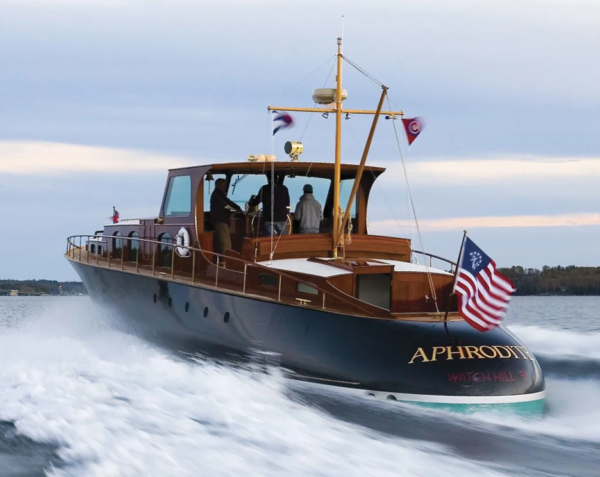
This mighty 1937 Purdy commuter yacht, Aphrodite , was completely restored at Brooklin Boat Yard with design support from Stephens Waring. Her rehabilitation shows how traditional design and technological innovation each have their place on the water. With redesigned propulsion and steering systems, new tanks and plumbing systems, and completely revamped interior, she offers a thrilling glimpse at what yachting was like in the 1930s—with all the comforts of today. Photo credit: Benjamin Mendlowitz
And in the fast-fashion world we live in, where it seems like half of what we buy has been replaced with a newer version before we leave the store, it gives us a good feeling to keep something old going, or better yet, to bring something from the past back to life.
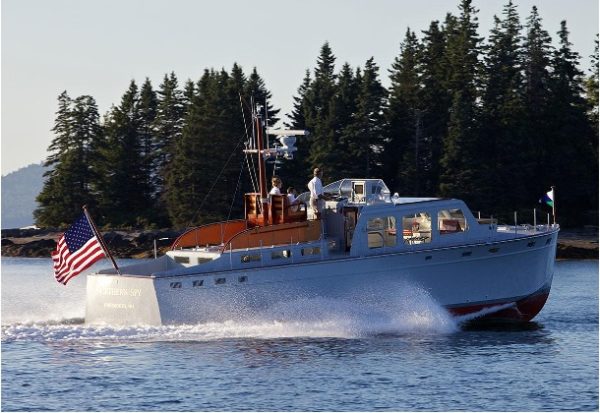
Stephens Waring worked with the owner of this classic 45’ Huckins, called Northern Spy , to rebuild the hull structure to accept the most modern of power plants: twin Volvo IPS drives. In the classic Huckins QuadroConic hull form, the IPS performs marvelously, boosting speed, cutting fuel consumption, and increasing maneuverability. Photo credit: Alison Langley
But for every unicorn rebuild project, there are plenty of renovation and restoration disasters along the way. Conversely, there is a mountain of smaller, less illustrious restorations and renovations, implemented successfully, which didn’t require the net worth of a Saudi Sheik to accomplish, but still extended the life and enjoyment of an old and beloved boat.
Big or small, iconic or sentimental, the key to any successful restoration project is figuring out how to identify the right fixer-upper and arming oneself with the knowledge to enter into a rebuild project with a clear understanding of the challenges, costs, and risks along the way.
Renovations vs. Restorations
The terms renovation and restoration are often used interchangeably. And while they may be close cousins, the goal and outcomes of a renovation or restoration project can be quite different in terms of objective, scope, and cost.
What is Restoration?

The bridge of Aphrodite was restored to match the original materials and controls of the vessel. Materials including varnished mahogany were carefully matched and rebuilt based on the original design specifications. Right image photo credit: Benjamin Mendlowitz
The primary objective of a restoration project is to bring a boat back to its original design and construction as closely as possible. Good restoration experts put significant time into researching the origins and background of the original build including understanding the history of the designer, construction techniques of the time, design philosophy, parts suppliers, and material sources.
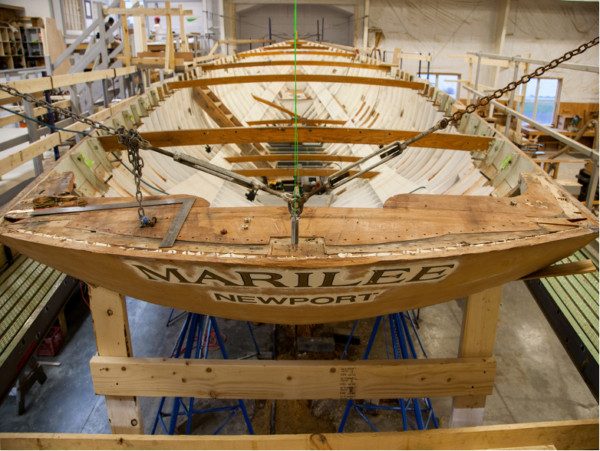
In 2014, French & Webb and Kurt Hasselbalch, curator of the MIT (Massachusetts Institute of Technology) Hart Nautical Collections, began restoration of Marilee originally built in 1926. In early winter 2014 they began with a 3D scan of the existing hull. This, combined with a CAD drawing created from the original Herreshoff plans, enabled the team to accurately examine Marilee’s current shape and compare it with the design from 1926. Photo credit: Alison Langley
Restoration experts often embark on a difficult treasure hunt as they scour the world for rare and comparable historical parts. This process can almost be as time consuming as the construction work itself.
During the restoration process, original materials are matched, and methods of construction are reused. Modifications from the original design are generally limited to changes necessary to bring a project up to modern codes and standards including electrical and life-safety. Stepping aboard a fully restored vessel should be like taking a step back in time.
What is Renovation?
Renovation is a much broader term. Generally speaking, it’s the process of renewing a boat or structure by fixing what’s present and adding something new or modern. This includes the integration of new materials, technologies, and even major structural design changes. We often think of a renovation as being built on the “spirit” of the original design while leaving the door open to new opportunities for creativity and innovation.
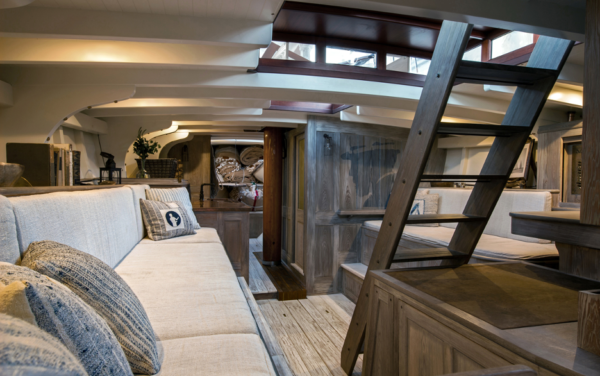
The owner of Marilee (built in 1926) had the bold vision to create an interior that reflected the yacht’s century-long provenance while creating an open space below. However, he wanted to get away from the dark “cigar room” interiors typical of so many classic yachts. The team worked with Paul Waring of Stephens Waring Yacht Design, to create a traditional and properly constructed interior with an updated layout for relaxed, modern day use. Photo credit: Alison Langley
Renovation can include adding new engines, propeller systems, updated electronics, efficient keels and hulls, and electrical systems. It can also include a refresh of the interior design elements and decor.
In some cases, renovation can be cheaper than restoration, especially for very old or historic boats where access to original parts and materials are rare or don’t exist at all.
Often renovations are completed in conjunction with restoration. In architecture we often see this with an old home or building where great lengths are taken to restore the exterior facade back to the original design, while inside, cutting-edge kitchens and bathrooms are installed. The effect is a blend of classic elegance with creature comfort and modern living.
What to Know Before Embarking on a Restoration or Renovation Project
There are no two ways about it, a major restoration or renovation can be costly and time consuming. They can also be extremely rewarding. The most successful projects are born from a sentimental and emotional objective rather than a purely economic consideration (although there are times when the economics pan out as well). Key to success is starting a restoration or renovation project with the right foundation. This may includes several of the following principles:
Starting with the Right Boat
Not all boats make good restoration projects. In fact, most don’t. The ones that do have that special something that may be referred to as being a “classic”. A good restoration candidate should have a historical or emotional value, or simply, a unique “wow” factor that makes it worthy of a second life.
Building on Good Bones
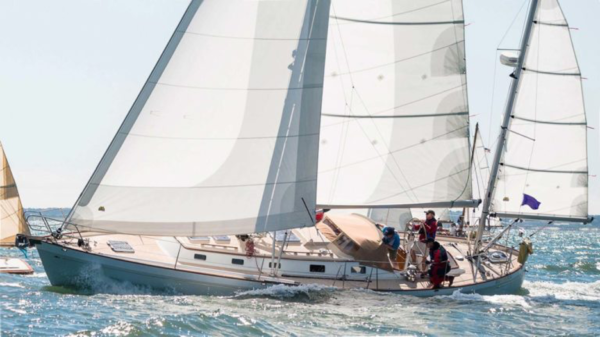
Zingara was originally designed by Bill Peterson, conceived to participate in the 1990 BOC-British Oxygen Company Challenge, a solo event ‘round-the-world yacht race. By the time we met her, the yacht was a long way from finished. Our renovation made the best use of her potential as a solid sailing yacht: the thoughtful design of the sailing platform, deck arrangement, and cockpit were to be functional in blue water; and down below her interior was to be spacious and comfortable, safe and relatively simple.
When possible, find a boat in which the problems are more cosmetic in nature than major costly systems repairs or replacements. At some point deterioration of major structures such as stringers and bulkheads may make restoration impractical. You should consider consulting with a professional designer like Stephens Waring to get an accurate assessment of major structural components and systems to fully understand the scope and resources necessary for a restoration or renovation.
Set a Realistic Budget and Timeline to Complete the Job
It is said that God created the world in seven days. That’s probably because he didn’t have to clean up anyone’s mess first. Realize that restoration and renovations are often as time and resource consuming as the original build itself. It takes time to undo the bad and rebuild with the good. Sweat equity can only carry your project so far and there are many hard costs and professional skillsets you’ll need to complete a big job. Working with a professional can help to set a realistic budget and define clear expectations and goals.
Size Does Matter
It’s easy to want to bite off more than you can chew. However, as a boat gets bigger the complexities of the systems become exponentially larger. The difference between a 30’ and 40’ boat can be immense. Experts generally recommend that no one attempt to restore a boat bigger than 35’ without professional support.
Where to Make Your Money Go the Distance
When done correctly, there are a number of benefits to upgrading and renovating rather than buying new. The key is to identify where to get the most bang for the buck. Finding a project where cosmetic repairs are the main problem is the best place to get a strong ROI. Renovations such as replacing upholstery, fixtures, refinishing surfaces, and painting can do wonders to make an old vessel feel new and increase the economic value.
Where to Start
Whether looking to renovate a boat you currently own or looking to purchase a used fixer-upper, we strongly suggest starting with a professional evaluation. Engaging an expert to inspect the hard to reach structures and systems can save a lot of money in the long run. A renovation expert like Stephens Waring can also help determine a solid triage strategy for what to discard, repair, and replace. For bigger projects, having a design expert create a detailed design and engineering plan, complete with 3D renderings, can provide a way for owners to better conceptualize the scope, cost, and outcome of the renovation and finished product.
Further Reading:
The Renovation of Marilee
The Renovation of Zingara
site by: slickfish studios
- Practical Boat Owner
- Digital edition

How to buy an old boat as a project – DIY yacht restoration advice
- October 31, 2019
Yacht broker and part-time boat restorer Will Higgs shares his passion for buying old boats and making them as good as new

Firebird is a Mirage 28 restored then sold on
Growing up sailing on the East Coast it’s fair to say that I caught the bug pretty early on. Family sailing on my father’s yachts and starting in dinghies from the age of five, it was clear from the outset that boats were going to play a central role in my life in one form or another.

My first project boat was a dinghy which my dad brought home when I was around four years old. She was 7ft 6in length overall and far too wide to sail well, but she had a gunter rig, foils that needed varnishing, rubbing strakes to replace and a hull that needed painting. Her name was Jake and she was going to be my boat. I was hooked.
Through my teens the boats grew until at 18 I purchased my first yacht – a Hurley 20. I couldn’t have been prouder, she needed new windows and a complete repaint right through but she was mine and I poured every spare minute and penny I had into her for six months before she was ready for sea.
As time has gone on, the boats have got bigger, but the principle remains the same: buy a green one and polish the love into it. A Hunter 701, a Seamaster 23, a Mirage 28 and now a 32ft Barbary Ketch – all made possible by adding a little more value to each boat as I went along.
Now my family and I can cruise the West Country in relative comfort and have clocked up some respectable sea miles, not to mention a few stamps in the passport. But it all started from bailing out the cabin of that first Hurley and wondering where to start.

My first project boat: “She was 7ft 6in length overall and far too wide to sail well, but she had a gunter rig, foils that needed varnishing, rubbing strakes to replace and a hull that needed painting.”
Why refit a boat?
For some, the pleasure of bringing an old boat back to life is the driving force; for others it’s a means of getting afloat on a tight budget. Whatever the motivation, all boat restorers share a love of the sturdily built and seaworthy lines of craft designed, in many cases, over half a century ago.
Indeed it is the robust construction of these old hulls that has led to the wide availability of potential projects which can be found in the damp, dark corners of almost every boatyard in the country and I dare say the world over.
These are boats that were designed in the days when a family of four would have bravely put to sea in a 20-footer for their summer holiday and that are still robust enough to earn their keep not only as a vintage item to be varnished and polished, but also as originally intended – fully functional cruising yachts.
So what are the benefits? It’s clearly a major undertaking, a modest refit project could easily see you through six months’ worth of evenings and weekends – not to mention the expense. Why do so many start and fail to finish?
Firstly, a refit is an excellent way to get to know a boat. For the DIY boat owner it makes perfect sense to go through her with a fine-tooth comb and address any issues along the way. It’s an excellent way of stretching the budget: real value can be added to a project boat, so whether the plan is to keep it long term or trade up, the minimum result to aim for should be a newly refurbished boat for a similar cost to a tired one on the open market.
Those who undertake boat projects for the simple pleasure of returning something sore and neglected to its former glory can be seen standing back at the end of each day of work with the sun setting behind them and a satisfied smile on their face. The sweat and occasionally blood poured into their pride and joy barely registers against the surging pride at every inch closer the boat gets to touching down in the water.

Before and after images: This Dufour 2800 required a £3,500 restoration budget and 50 hours’ skilled labour
How much will a yacht restoration cost? Even if you can commit £1,500 and 1-2 days per week for three months, you should still only be considering project boats under 26ft long. · The skill level, budget and timescale requirements increase exponentially with the size of the boat so careful planning and a couple of attempts with smaller craft first would be well advised. · As a case in point this Dufour 2800 (above) required a budget of close to £3,500 as well as 50 hours’ skilled labour. Keep control of the costs on a project – it really is possible to keep spending if you are not careful.
Key considerations when choosing a boat for a restoration project
Selecting the right project boat carries many of the same criteria as any yacht purchase might, with a few specific additions. Scope of use and budget are fairly standard considerations as is the availability of a suitable mooring. However, it is easy to forget about these important points when looking at a boat that may be months or even years away from her launch date.
How will the boat be used?
Picking a boat that’ll meet your requirements when she’s ready for sea is critical to a successful refit. There will be times when walking away will seem like the easiest option. On the days when the paint won’t wash off, the splinters won’t come out and the head is sore from banging it repeatedly against the bank balance, even the most ardent enthusiasts need a vision of the finished article to remind themselves why they started down this road. There are plenty of tough moments restoring old boats, but for me, thinking about launch day sees me through every challenge.
What is my budget? What is my skill level? How much time can I commit?
It may sound obvious but blowing the entire budget on buying a boat that will require significant additional repairs is a recipe for failure. At best it will result in extensive and unnecessary storage fees that will further eat into the budget and add to the overall costs. There’s a certain principle of frugality at the heart of restoring boats and perhaps hand in hand with budget comes time. For these reasons it’s important to consider how big the boat really needs to be. A large project will incur far higher overheads and take much longer to complete. It is also more likely to require a higher level of expertise to tackle the more complex systems and structural issues.
Will it fit on my mooring?
It is advisable to have somewhere lined up to keep the boat before choosing one: the size and type of mooring available can play a part in the selection.
Pitfalls to avoid
The following hints and tips apply to beginner/intermediate standard DIYers on the majority of yachts. Ignore for boats with a high end value, or if you consider yourself to have a high skill level:
· Boats that are just a shell with no salvageable equipment. The cost of replacing gear can snowball very quickly so it’s important to factor this in before getting started
· Boats with faulty keelbolts can be expensive to put right and tackling it properly on a DIY basis is not for the faint-hearted.
· Avoid boats that are going to cost far more than their end value to put right. There’s nothing more soul destroying; check the market first!
· Boats that have major structural defects. There are plenty of boats out there that only need TLC.
· Boats that are too big for your budget and timescale will sap resources and demoralise. There are occasions where a refit could be programmed over months or even years, but as far as shoestring projects go, every week in the yard is added cost to be avoided.
Restoring a Leisure 20 for a client
A few months ago I decided that I wanted to take my lifelong passion to the next level, so I set up a brokerage through Imperial Yachtbrokers ( www.imperial-yachtbrokers.com ) and started refurbishing yachts in a local yard where I have some history of carrying out boat projects for myself.
So far we have refitted a Sadler 29 , a Dufour 28, and are in progress with a Westerly Centaur and a Westerly Griffin.
I was also approached by a lady at a local yacht club who wanted a daysailer/weekender to keep on a swinging mooring. We chatted about her requirements and settled on a Leisure 20 for its sailing characteristics and ease of handling while still providing overnight accommodation and somewhere to make a cup of tea!
She struggled to find a good example, so I had a look around and located one in a nearby yard that was in a sorry state but could be bought for £300 on condition we move it straight away. We sourced an engine, had her dropped in and motored her around to our base at the Lynher Boatyard in Torpoint to do the work, starting with emptying her of gear and cleaning her from end to end.

Leisure 20 as found in need of TLC – but was only £300 to buy

Hull was grubby but basically sound

Deck’s non-slip paint was looking worse for wear

Interior needed a good clean and a retrim to modernise
The brief with this boat was to keep her simple, set up for day sailing and with a minimum of potential failure points. One of our first jobs was to remove and glass in all of the through hull fittings as these would not be required.
We spent some time carrying out the usual sanding of woodwork and polishing of the hull. New vinyl decals were added to draw the eye and the deck paint was re-applied in a more modern looking light grey.
We also repaired the redundant screw holes in the mouldings and retrimmed the interior to make it functional and attractive.
Externally, we cleaned and applied silicone grease to all the fittings’ moving parts and replaced any fittings and lines that were broken or worn out. We then raised the mast, dressed it with sails and relaunched the boat ready for a shakedown en route to her new mooring.
There are few more satisfying moments than raising the sails for the first time on a resurrected boat.

Cleaned, polished and varnished – what a difference!

Launch day! There are few prouder moments…

Restored. Afloat. A Leisure 20 ready for new sailing adventures

Key figures
Initial purchase: £300 Yard costs: £330 Engine: £275 Misc parts: £400 Total : £1,305 Time commitment: 50 hours’ labour over four weeks
We had to allow for around 50 hours of labour as well as the costs of various parts and yard storage costs, but what is very clear from the figures is that refurbishing a modest yacht is an affordable undertaking.
DIY boating on a budget
With determination and a basic skill level, anyone can get on the water without going bankrupt. It’s simply a case of being sensible: pay attention to boat selection, programming and budgeting the project then stay focussed and work hard.
Read Online
Full Chapter One
Fundamentals of Restoration Projects
Part i part ii, by david pascoe.
During my three decades as a marine surveyor, I've always been amazed about two aspects of restoring old boats what, in the marine trade, is known as a refit.
First is that the people who can best afford to do them, usually don't. Followed by those who can't afford such projects are usually the ones that attempt them. Such projects usually go wrong because the owner failed to appreciate the costs, and to estimate them in advance. There are no good deals on fixer uppers with boats. There is just expensive and more expensive. Money is the name of the game, and if you haven't got it, then it's a mistake to think that you can do a refit on the cheap.
Even so, the fact is that taking a good, well built, but aging and clapped out older boat and restoring it can be the most cost effective way to get yourself into a good quality boat that you would not otherwise be able to afford. It is possible for the economics of such a venture to work out because a lot of the investment is going to be good ole "sweat equity."
In fact, if you watch any of the many home improvement shows on cable TV, you'll see this very same thing done all the time. It requires a homeowner with at least a reasonable degree of manual skills, along with the time and commitment to get the job done. And most importantly, if you tune in to some of these programs, you'll hear architects and contractors giving some real straight talk about good intentions versus the actual ability of the homeowner to complete the jobs he intends to accomplish. Indeed, most of the same principles you hear discussed on these shows apply directly to old boat restoration or refits. Here are the primary ingredients:
- The boat you start with must be basically sound, and not require extensive rebuilding of structural elements.
- Stylistically, the boat remains highly desirable on the market. It's got that certain "something" that boaters love.
- Close consideration must be given to refit cost versus resale value.
- A complete cost estimate should be made prior to acquisition.
- You have the money available to complete the job.
- You have sufficient time and ability to provide about 25% of the cost in sweat equity.
- You permanently banish from your mind all thoughts of buying cheap materials and components.
- You automatically understand that every job takes 4 times longer than you thought it would.
- It never crosses your mind that any little job will ever be easy.
- Patience and persistence are your strong points.
- It never occurs to you that the lowest priced contractor will do a good job. Rest assured, he won't.
If you can meet these requirements, then, and only then, are you (1) likely to complete the project, and (2), end up in a financially sound position with a boat that can sell for significantly more than you paid for it.
Not all boats make for good projects. In fact, most don't. The ones that do are those that have enjoyed an excellent reputation, and are sometimes referred to as classics, or just have that certain "something." we can't name. A well-known example would be a 31 Bertram. Just because a boat is old, and you can get it for next to nothing, doesn't mean that it's a good subject. What makes for a good subject is a boat other people would want to pay good money for when you're finished. Basically, this means the high end boats that most people can't afford when these boats are still high on their depreciation curve.
This is easily determined by researching the resale values of similar boats. For example, if you search for old Bertrams on the boat sale sites, you'll find dozens of them at very respectable asking prices. If you do a similar search for old Carvers or Chris Crafts, the result will not be the same.
Money. If you think you can buy an old boat and fix it up with the leftovers from your weekly paycheck, you are mistaken. Old boat restoration is very costly, and no one who is employed full time has sufficient sweat equity to be able to complete a project in lieu of significant cash transfusions. These usually come in the form of hiring professionals to complete some of the more technical jobs. This is where most people who attempt such projects go wrong. They think they can get the job done for next to no money if only they can work hard enough. Unfortunately, it doesn't work that way. If you doubt that, just take a tour of the back lots of boat yards and observe all the failed attempts. The best you can expect for you sweat is about 25% - 35% of the total cost. The remainder you will pay to someone else.
Estimating. If you are capable of producing a reasonable estimate of the cost to complete the job, then you are probably qualified to attempt it. If you're not qualified, but are willing to pay someone who is to make an estimate for you, then you are also likely a suitable candidate for the project. Smart people who lack certain skills are not unwilling to pay people who have what they lack, and thereby save themselves a lot of grief in the end.
Planning is another major ingredient, a major key to success. A typical planning failure is attending to the cosmetic appearance of the boat first, while neglecting the more important systems. Surveyors see this all the time: the outside and interior looks great, but when he opens the hatches he is greeted with thousands of dollars worth of worn out systems that render the effort little more than a pretty wreck that can't be sold.
Knowledge. While you may not need a high degree of technical boat knowledge, there are necessary prerequisites. Some of the better ones are people from the building trades, engineers or other trades involving the creation of things. People who know and understand materials, systems and things mechanical and electrical.
Time. The ability to estimate the amount of time to complete a job is the other major factor in most project failures. If it took 2000 man hours to create a 30 foot boat, ask yourself how many man hours it will take to restore it. Bear in mind that it takes more time to undo something and then restore it, than it took to create the thing in the first place. Re-creation always takes longer than creation. It is said that God created the world in seven days. That's probably because He didn't have to clean up anyone's mess first.
The trick to selecting the right boat for such a project is to find one in which the major problems involve more cosmetics than major, costly systems. For example, a boat on which the wiring, plumbing and engines are all shot is not a good candidate because these are amongst the most costly systems to replace. Conversely, the better subject is one for which these systems need more in the way of repair, and less in way of replacement.
Engines. The difference in cost between engines that need to be replaced, versus those that can be rebuilt, is around 60% to 70%. A pair of gas engines may be rebuildable for $8,000 but replacement cost is $22,000 including installation, a difference of 67% or $14,000. The best candidates are always going to be those boats with engines that can be rebuilt.
Repowering Some people make the mistake of thinking that they can put bigger, heavier engines in a boat that was originally designed for x- amount of power. Before you do this, you need to find out whether the structure can withstand greater speed and heavier engines. Often times it can, and a major structural failure occurs. The time to do this research is Before you buy.
Painting. There are few things that can make an old boat look nearly new than to paint the worn out gel coat finish with a urethane paint. But, as we know, urethane painting can be very expensive. Yet much depends on the complexity of the boat involved. Painting a fly bridge sedan costs vastly more than an express or open type boat. It also makes a huge difference in the amount of clutter on the boat, meaning all the things that have to be painted around or removed first. The simpler the boat, the less the cost to repaint it.
Size. Our final and one of the most important factors. The rule is this: the larger the boat, the more systems and complexities it contains, and therefore not only will the absolute cost be higher, but the cost will be proportionately higher than smaller boats. The difference in cost between restoring a 40 footer versus a 30 foot can be on the order of magnitudes. Generally, we would not recommend that anyone but an expert attempt to restore a boat bigger than 35 feet.
A Brief Picture. So what does a reasonable restoration project look like in terms of money? Here's a typical example. A run down 30 foot "classic" FRP boat is purchased for $25,000. The cost to rebuild engines, and hire tradesmen to make necessary repairs and restorations is another $25,000. In addition, the owner invests another $10,000 in sweat equity, for a total investment of $60,000. The new replacement cost of the boat is $125,000; the resale value of this boat upon completion is $40,000, giving him a 2:3 return on investment. This is pretty good since no one makes money on the sale of used boats except brokers. Thus the owner ends up with a boat that is in nearly new condition for a shade over half the price of a new boat. Yet the other part of the payoff is the satisfaction he gets from a job well done, plus all those head-turning glances at his "new old boat."
Needless to say, such projects are not for everyone. But for those that have requisite skills, time, money and determination, such projects can be extremely rewarding. The ultimate trick to being successful is to treat the task like a business proposition.
Additional Reading: MARLIN MONROE at www.yachtsurvey.com
David Pascoe - Biography
David Pascoe is a second generation marine surveyor in his family who began his surveying career at age 16 as an apprentice in 1965 as the era of wooden boats was drawing to a close.
Certified by the National Association of Marine Surveyors in 1972, he has conducted over 5,000 pre purchase surveys in addition to having conducted hundreds of boating accident investigations, including fires, sinkings, hull failures and machinery failure analysis.
Over forty years of knowledge and experience are brought to bear in following books. David Pascoe is the author of:
- " Mid Size Power Boats " (2003)
- " Buyers’ Guide to Outboard Boats " (2002)
- " Surveying Fiberglass Power Boats " (2001, 2nd Edition - 2005)
- " Marine Investigations " (2004).
In addition to readers in the United States, boaters and boat industry professionals worldwide from nearly 80 countries have purchased David Pascoe's books, since introduction of his first book in 2001.
In 2012, David Pascoe has retired from marine surveying business at age 65.
On November 23rd, 2018, David Pascoe has passed away at age 71.
Biography - Long version
Fundamentals of restoration project: part i.
What makes for a suitable candidate for a major boat restoration project, both in terms of the boat and the person attempting it.
Fundamentals of Restoration Projects: Part II
How to proceed with such a project, and what you need to consider before you buy.
Related Reading at yachtsurvey.com
Marlin monroe bertram 42 convertible - making an old boat new, all about buying used and older boats.
There are Great Values in Used Boats, But the Cost is More Than Just the Price

Buying, Owning, Maintaining a Boat or Yacht.
Over 160 articles by David Pascoe.

- Basic Considerations
- Boat Types: Which is Right for You?
- Old Boats, New Boats and Quality
- Basic Hull Construction
- Evaluating Boat Hulls
- Performance and Sea Keeping
- Decks & Superstructure
- Stress Cracks,Finishes and Surface Defects
- Power Options
- The Engine Room
- Electrical & Plumbing Systems
- Design Details
- Steering, Controls, Systems & Equipment
- The Art of the Deal
- Boat Shopping
- The Survey & Post Survey
- Boat Builders by Company

- What is Pre-Purchase Survey?
- Business Practices and Client Relations
- Sound vs. Seaworthiness
- Hull and Its Structure
- Surveying the Hull
- Using Moisture Meters
- Stress Cracks & Surface Irregularities
- Deck & Superstructure
- Drive Train
- Gas Engines
- Fuel Systems
- Exhaust Systems
- Electrical Systems
- Plumbing Systems

- The Marine Investigator Read Online Full Chapter 1
- The Nature of Investigations
- The Nature of Evidence
- Marine Insurance and Issues of Law
- Bilge Pumps & Batteries
- Finding the Leak
- Sinking Due To Rain
- Fire Investigations
- Machinery Failure Analysis
- Fraud Investigations
- Interrogation Techniques
- Deposition & Court Testimony
- Paddle Board

How to Restore a Boat: Complete Guide for Beginners
Boating offers you a fun way to spend time out on the water with family and friends. There are dozens of boat brands and designs with purposeful builds to suit any boating activity. From fishing in the flats in the estuary to taking on the waves in the open ocean, there’s a boat designed to do anything on the water.
While boating is fun, it’s an expensive hobby. Buying a new boat is as serious as purchasing a new car, and you need to carefully consider the right model and brand to match your motoring style. It’s the same thing with boats; you need a model that offers you the best performance for what you want to do out on the water.
Unfortunately, some decent boats can cost you north of $35,000 for an entry-level model. At the minimum, you’re looking at spending $15,000 to $20,000 on a new boat. So, it makes more sense to buy a used model, right? Going with a pre-owned boat can save you thousands on the costs of your vessel.
Just like cars, you get used boats in a variety of conditions, from those that need huge amounts of repairs to those that only need a few touch-ups. However, chances are you’re going to need some level of refurbishment to your boat, regardless of the age,
Refurbishing a used boat can save you thousands on the price tag, especially if you have the handy skills to do it yourself. This guide gives you everything you need to know about how to restore a boat.
Plan and Set Up Your Workspace
If you’re purchasing a boat, make sure you have a dedicated space on your property for the restoration. Storing the vessel in a shipyard at the marina means you’ll have to waste time traveling between the shipyard and your home when restoring the boat.
That’s time you could be putting into the work, and having your workshop close to where you live saves you hours of time, getting the project finished in the fastest time possible. When you have a workspace at your home, you have access to outlets and better security for the boat and your tooling.
Workspace Requirement
If you don’t have the space to store the boat at your home, look for suitable premises you can rent close to where you live. We recommend finding a place with an overhead cover allowing you to work in all weather conditions, and don’t forget the need for power outlets for your tools. You’ll also need access to water on the property and security for the boat.
Basic Restoration Tools
You’ll need to make sure you have the following restoration items and tools before starting your project.
Try and get two if there are two of you working on the project. The boat’s sides are steep when mounted on the trailer or at the yard. The ladder helps you climb in and out of the vessel and reach the high spots on the sides from the ground.
Flexible Hoses
These hoses are easy to coil up and move around the boat.
Personal Protection Equipment (PPE)
You’ll need respirators, surgical gloves, and safety goggles for your protective gear. The respirator is critical when sanding away paint and fiberglass, keeping the particles out of your lungs.
Entertainment
Get yourself a Bluetooth speaker to play your favorite songs when working on your boat – it helps to pass the time on long restoration jobs!

Boat Inspection
When purchasing your boat, make sure you give it a complete inspection before making your final offer. It’s a good idea to have a professional inspect the boat for you and point out any problems before you make your purchase. The last thing you need is to discover damage or engine/electronics problems after paying the owner.
Talk to the Seller
Before calling the pros, ask the seller if they have anything they want to disclose with their boat before handing it over to you. If you’re purchasing from a used dealer, ask the following questions to your agent before closing the deal.
- How did the previous owner treat the vessel?
- How did the previous owner store the boat?
- Is there any existing damage or repairs required?
- What are the service history and previous repairs done on the boat?
- How often did the previous owner use the boat?
- What maintenance did the previous owner do on the boat?
Restoring a boat is a big undertaking, especially if it’s in poor condition. Make sure you understand the task you’re taking on before you decide to buy the boat and make a huge mistake.
If you give up on the project halfway through it, you’re not going to make any money on the work you did to the boat. You might sit with it for a while before you find a buyer willing to commit to the restoration project, leaving you out of pocket.
Some repair jobs with boats just aren’t worth the hassle. The bigger the restoration project, the more money and time it takes to finish the restoration. Some of the major restoration problems to avoid include the following.
Wood looks fantastic on boats, providing a classic look and a wonderful aesthetic to the vessel’s finish. However, the issue with wood is that it rots. If the previous owners didn’t maintain the wood, you could be in for a serious, costly replacement when refurbishing the boat.
Wood finishes are more popular on older boats, so the chances are that you’re going to need to remove and replace all the rotted wood, and that can get expensive. However, if you find a boat with mildly deteriorating wood finishes, it may be possible to salvage it with the right tools, materials, and care.
If the boat is 25-years old or older, then the chances are that damage to wooden components on the vessel will have some rot in them. Almost every wooden boat would experience wood rot at some stage, especially if the owner didn’t take the necessary care of the vessel.
Some of the older boats may have a “cored” hull. Purchasing a boat with this design is a mistake. Eventually, you’re going to have to remove and refurbish the core, and that’s going to be a huge hassle in your project, taking up hours of your time. The coring in these older models typically features balsa or thin plywood.
If you’re dealing with someone on a prospective older model, it’s a good idea to do some research online into that specific model. If it has coring, then rather walk away and look for something else.
Some of the boats don’t have a cored construction, and that has that one advantage when it comes to the complexity of the restoration, and the time it will take. Other components on the boat that are at risk of developing rot include the transom, seats, floors, and stringers.
While wood offers an impressive finish, most modern boats replaced this material with fiberglass or aluminum over the last two or three decades. The paint on the boat comes from the factory looking fantastic. However, a few years in the sun at the marina will take the luster out of the paint job.
Most old boats come with a gel coat direct from the factory, adding extra protection to the paint. Some of the earlier models may also feature a metal flake, which has an impressive look. If you’re completing a restoration, the paint will probably be the most expensive part of the process.
So, we don’t recommend painting the boat after you finish the restoration if you want to save money on the job. It’s a better idea to try and restore the factory finish as best as possible.
If the old gelcoat needs some attention, you can buff it out and make the boat look 10% to 20% better with this simple task, saving you the paint costs. If the gel coat is repairable, don’t waste your time and money on repainting the boat.
The motor is another considerable point of failure when purchasing a boat. First, make sure that the engine is still in production. If you’re buying a boat from a manufacturer that went under, then the chances are those spares are not available anymore. As a result, you’ll have to spend hours digging through wrecks at the local salvage yard to find what you need for the job.
If you have the chance, purchase a boat from a person that works on the engine themselves. These people will take the best care of the motor. If that’s not an option, look for boats with the most extensive service history possible.
Ask the owner to start the motor, and ensure that it runs correctly. If you have no experience with boat engines, find a mechanic that can give the motor a once-over inspection and tell you about the problems you need to fix.

Get a Second Look
Buying boats and motors aren’t a good idea if you don’t have any experience with boats and don’t know what you’re looking at during the inspection. On the surface, the boat might look fine, but there might be a slew of problems with the vessel under the surface.
The last thing you need is to buy a lemon and never finish the restoration. So, it pays to have a professional assessor look over the boat before you close the deal. The professional will run over the electrical and mechanical components of the boat, the wiring, and the engine to point out any problems with the vessel.
While it’s easy to see the exterior damage and damage to the boat’s body, the stuff out of sight is a real concern, and the professional assessor will remove this risk from the deal.
Create a Master Restoration List and Prioritize Tasks
After you finalize your purchase and have the boat assessed by a professional, it’s time to plan the restoration. Planning doesn’t take much time, and it will end up saving you plenty of time and money in the restoration process.
You’ll need to create a master priority list for the restoration tasks involved with the project. When creating your priority schedule, ask yourself the following questions.
- What work do I need to do to make the boat run safely?
- What work do I need to do to get the boat to float?
- What damage is cosmetic, and what damage is structural?
- What are the vital tasks to complete, and what would be nice to have?
- Do I need specific workshop conditions for this restoration?
These questions help you form the framework around the restoration project. Organize your list, starting with the most labor-intensive tasks at the top of the list. Make sure you focus on safety and never work on the boat without wearing the correct safety gear.
Create a Restoration Calendar
After you finish prioritizing the tasks involved with your project, it’s time to map out your schedule on your calendar. A goal is only a dream until you put a timeline to it, and this phase of your planning is as critical as the prioritization phase.
Set realistic goals for completing each of the tasks, and stretch yourself to make the project challenging. If you don’t hit your timelines, that’s fine; just make sure you’re focusing on the quality of your work at all times.
If you make your purchase in October, you could set a date for having your boat in the water by the following July. That sounds like a great way to start the summer, right? With this goal in mind, you’ll need to complete the preliminary work involved with the project by June and leave the aesthetic repairs for the fall after the summer ends.
Taking the time to plan out your project relieves the stress and uncertainty involved with the restoration. With the right milestones in place for your project, you’ll find you feel more confident, with the momentum of your achievements pulling you through the project’s timeline to a successful restoration.
Some boat owners find that the length of the project becomes a chore to manage, and they lose interest over time. When you plan the project carefully, you’re consistently moving through it, and you know what to expect. Sure, there might be setbacks, but you’ll eventually achieve your goal with the restoration with the right planning.

How to Restore a Boat – Checklist
By now, you should understand the basics of what you need for a boat restoration project. It’s no simple task, and you can expect to spend anywhere from a year to two years or more on the restoration, depending on the condition of your boat.
However, with the right planning and execution, the time will fly by, and before you know it, you’ll be out on the water. We decided to give you this checklist to help you navigate your way through your boat restoration project.
- Make sure you have an adequate workspace for the project.
- Take an inventory of your materials and tooling.
- Clean the boat properly and remove all dirt before you start the project.
- Remove all organic material and water from the boat to prevent mold and pest infestations.
- Inspect the boat and identify any problems with the exterior.
- Contact a boat inspection service and have them go over the boat to confirm the final issues involved with your restoration project.
- Drain the fuel tank and remove the engine from the boat.
- Drain the gear case of the old oil.
- Remove old hoses and belts on the motor and replace damaged parts,
- Check through-hull fittings and ensure they have tight seals. Replace any perished seals.
- Check the seacocks to ensure they are in working order. Replace any damaged parts.
- Inspect the hull of the boat for signs of any cracks.
- Check for cracks in the fiberglass around fittings and fixtures.
- Ensure that any load-bearing fixtures have the proper backing plate for support.
- Check the boat from top to bottom for any evidence or signs of wood rot.
- Check the deck flooring, bases of seats, and the ransom. Look for any signs of decay or deterioration.
- Strip the old and rotted wood from the boat. Replace it with marine-grade cored composites or plywood.
- If you’re having issues with a specific part of the restoration project, research it on YouTube.
- Look on forums if you have trouble working out any problems – the people there have loads of experience, and they are great resources for knowledge.
Wrapping Up
After you have all your planning ready and the boat set up in the workshop, it’s time to roll those sleeves up and get to work!
The biggest issue with any restoration is the time involved with the project. During the planning phase, map out the time you have to work on your project each week and outline the required finish date for your restoration.
Stay committed to your project, and don’t give up!

John is an experienced journalist and veteran boater. He heads up the content team at BoatingBeast and aims to share his many years experience of the marine world with our readers.
What to Do If Your Boat Engine Won’t Start? Common Problems & How to Fix Them
How to launch a boat by yourself: complete beginner’s guide, how to surf: complete beginner’s guide to get you started.
Comments are closed.
Type above and press Enter to search. Press Esc to cancel.
How to Restore a Boat (And What to Consider)
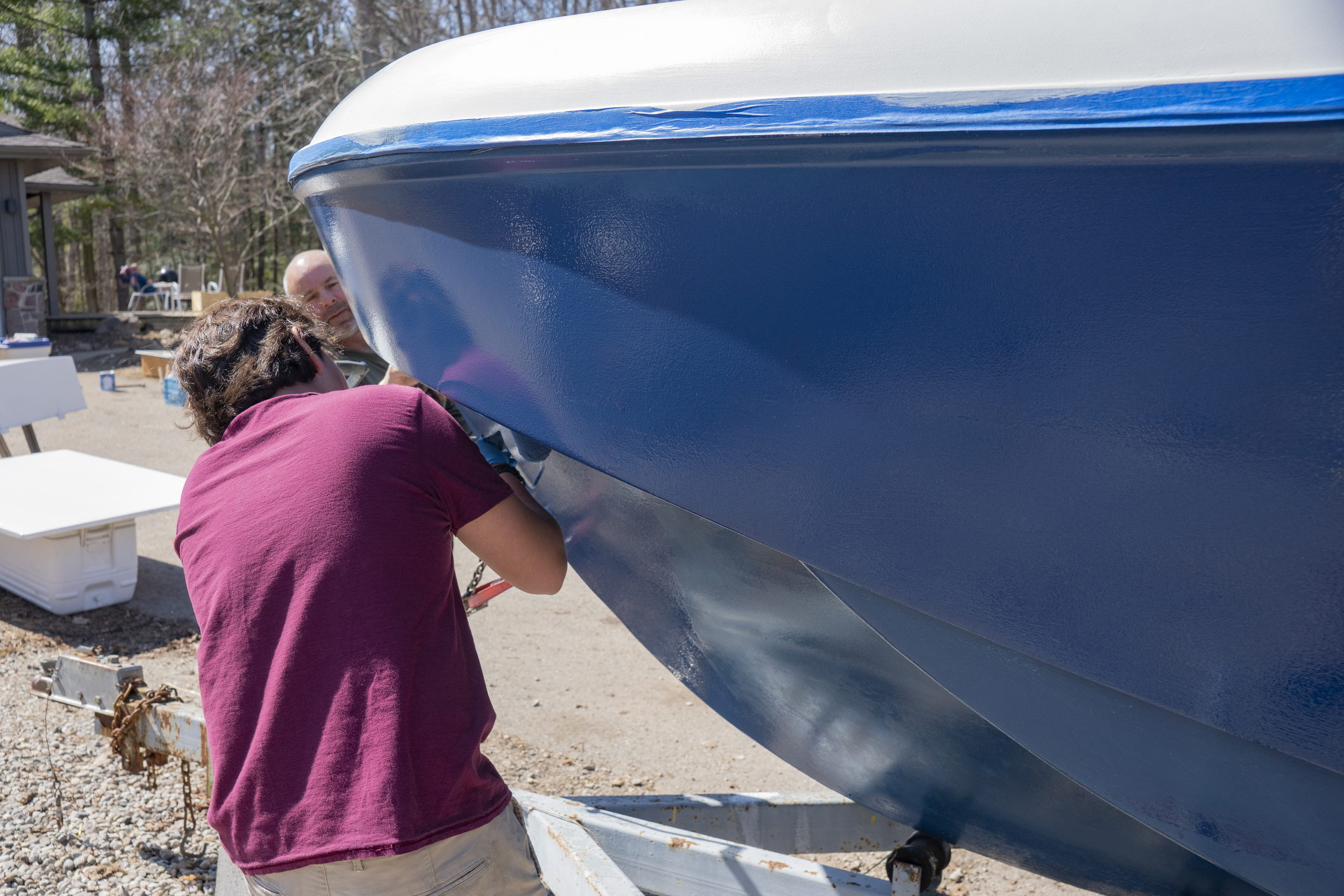
Boat owners often form deep bonds with their vessels, motivating them to restore rather than replace them. This commitment to preservation allows us to appreciate the enduring beauty of classic and antique boats. Plus, it's a budget-friendly option compared to purchasing new.
But before diving into boat refurbishing, it's essential to understand that restoring a boat requires considerable time, effort, and resources. This blog post will explain how to restore a boat, the pros and cons, and restoration alternatives.
The Pros of Restoring Your Boat
Let's discuss why people choose to restore their boats:
1. Cost Compared to Buying New
Aside from sentimental value, many people opt for restoration because it's cost-effective compared to purchasing a new boat . While material expenses can accumulate, they don't compare to the hefty price tags of brand-new boats. Restoration expenses primarily involve the cost of supplies and occasional assistance from a laborer for more challenging tasks.
2. Sense of Accomplishment and Pride
Building and restoring your boat creates a unique masterpiece tailored to your style and preferences. Your one-of-a-kind creation will be a testament to your dedication and craftsmanship – a vessel built with your own two hands.
3. Develop New Skills or Improve Old Ones
Every restoration project is an opportunity to learn valuable boat skills! Throughout your journey, you'll gain practical knowledge about mechanics, parts, and additional information needed to complete your project.
The Cons of Boat Restoration
Restoration projects can be demanding, and many sailors are hesitant to commit. Several factors influence people's decision not to undertake these types of projects:
1. Time and Effort
Restoring a boat can be seriously labor-intensive! Restorations require a significant time commitment, as you must allocate several hours. Many people find long-term restorations peaceful and satisfying. However, others find the pressure to complete it before the season begins overwhelming.
2. Unknown Challenges
You'll inevitably encounter unforeseen challenges. For instance, depending on your boat's make, model, and year, the manufacturer might not even sell that part anymore – meaning you'll have to get creative. If you expect the unexpected, you'll overcome any challenges!
3. Liability Concerns
In the unfortunate event of an injury, you'll likely bear responsibility for any resulting damages. Additionally, note that the quality of your craft can impact your boat's warranty and cause potential insurance complications. For this reason, it's best to hire a professional if you're unsure how to restore boat parts.
How to Restore Boat Accessories and Parts
Before you begin restoring, it's essential to have your vessel surveyed by a professional. This helps uncover hidden problems lurking beneath the surface (pun intended). In addition, doing so saves you time, money, and headaches.
Next, make sure to clean every nook and cranny. This step might seem counterintuitive but will benefit you in the long run. Cleaning removes obstructions and makes inspection easier. You should also remove any unnecessary hardware and finishes.
Now it's time to carefully plan your restoration, making a list of materials you need and the order in which you'll tackle tasks. Once you're ready to begin, start with essential structural repairs like fixing holes, leaks, or rot. This includes inspecting, repairing, or replacing weakened parts.
The next step is to repair all lines and sails . Then, decide whether engine repairs or replacements are the way to go. Once you restore the major components, it's time to sand, seal, add finishes, and replace hardware. Then, you can address interior elements like floors and seats.
Finally, test everything on both land and water to ensure it functions as it should. We also recommend creating a maintenance plan to ensure your hard work stays at its best.
Additional Tips for Boat Restoration
If you're up for a rewarding restoration project, consider checking out repossessed boats available for purchase online or at boat lots. These are significantly more affordable than their new or used counterparts. Additional alternatives to boat restoration include buying a used vessel or hiring a crew to restore a boat.
Here's another money-saving tip: Consider purchasing upcycled or repurposed parts instead of brand-new ones. Not only will you save money, but you'll be breathing new life into old pieces.
Lastly, you'll want to document your progress with photos and notes and test everything you do. This helps you keep track of your work and ensures you have proper insurance company documentation.
Wrapping Up Boat Restoration Advice
Refurbishing a boat can be a rewarding and uniquely challenging experience. And trust us when we say there's no greater satisfaction than seeing your vision come to life. If you are considering boat restoration, we hope this article points you in the right direction! Good luck, captain.
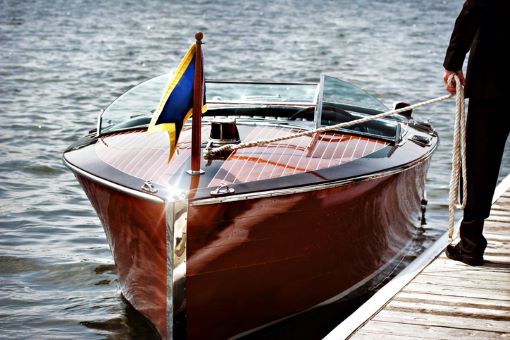
Join Our Newsletter!
Get community news, buying bargains, and how-to guides at your fingertips.

12 Tips For Restoring an Old Boat: Costs, Time, And Expert Advice
Looking at restoring an old boat chris mccall shares his expert advice..

So, you’re thinking of buying an old boat and bringing her back to her former glory? Awesome! Get ready for hard work and frustration culminating in an ultra-rewarding experience.
Buying and refitting an old sailboat is totally worth it! You won’t build a ton of equity in the boat, but you will know every square inch of that vessel, and the skills you gain will be invaluable.
My wife and I just finished the three-year refit of our 1972 Nauticat 38, Drifter, and now live aboard in Portland Oregon. As soon as the weather cooperates, we plan to take him (Yep, Drifter’s a fella) south and begin cruising full-time.
Feel free to check out our progress along the way and the results of our labor; you can find us on YouTube at YouTube.com/SailingAdrift

As an Amazon Associate, we earn from qualifying purchases. We also earn from other affiliate programs. This means we may receive a small commission on products purchased through our links at no extra cost to you.
Here are my top tips to help with your refit. Most I followed; some I wish I would have.
During The Buying Process
Get one of the best knives for sailing
Before you buy your perfect renovation project boat, here are a few tips to follow so you don’t fall short at the first hurdle.
#1 Know what you’re getting into

Refitting a boat is not an easy undertaking, and the single biggest thing keeping you from success is your tenacity to see it through. There are so many boats for sale, half-finished, because the undertaking was a lot more than their owners predicted. So….
#2 Plan, Plan, Plan.
This post is a great place to start. Start taking notes and tour as many boats as you can to gather ideas.
Talk to people that know. Read books. Read articles. Watch YouTube refit videos. Join social media groups focusing on refits, interior design, electrical systems, electronics, and boat makes you’re interested in.
I know the excitement is high but take a beat and make sure you make a logic driven decision based on research. There will be time to fall in love later.
#3 Make a core list of what you want from restoring an old boat

List the makes, lengths, characteristics, and price range and stick to it.
Then make a list of “nice to haves” and look for boats that have as many as you can find. If you go in with a clear understanding of what you want, and the deal breakers associated, it’s much easier to make a smart decision.
#4 Let someone else take the depreciation if you can
If you’re going to be refitting, you’ll be taking on plenty of depreciation as soon as you start installing your new electronics, appliances, and equipment, so minimize it by finding a boat where the previous owner has installed as much of this stuff as possible.
New engine? Awesome! Just upgraded all the navigation equipment? Great. New refrigeration unit? That helps. Let the last guy take the hit for 50 cents on the dollar.
Wondering how much sailboats cost ? Get a rough idea here.
#5 Buy cheap and pay cash if you can

Boats are not like houses. There isn’t nearly as much competition for boats that need a fair bit of work, because you won’t build a bunch of equity refitting like you would flipping a home.
Don’t expect to save tons of money refitting the boat yourself. You may save yourself a little but the real value is in the knowledge of the vessel and the skills you’ll gain.
So be ready to offer significantly less than asking, and don’t be surprised if they take it.
#6 Include a survey contingency and evaluate your prospective project from top to bottom
Do you have to hire a surveyor? No. But if you don’t, get ready to learn all you can about the process, and go over every square inch.
Know someone super knowledgeable you can ask to help? DO IT! Do not be afraid to walk away. Getting attached leads to bad decisions.
Now That You’ve Got Your Boat Restoration Project

So you’ve found your dream boat (to be!) Here are the next steps in restoring an old boat.
#7 Create a conservative budget
Take your number and pad it by 30%. It is all too easy to let costs get out of hand. Do your homework. The more knowledge that goes into that budget, the less costs will surprise you. Front end work pays huge dividends.
#8 Come up with an educated guess at the timeline in total work hours
And then multiply it by 4 (If you know someone who does this work a lot, take their estimate and double it; they are faster than you)!
Then break it down into phases to make the overall project less daunting. Tracking your working time in hours keeps focus and doesn’t punish you for life getting in the way.
I made a game of it by tracking my active work-on-the-boat time in hours with an app called Toggl. If you’re at all competitive, this really pushes you to keep getting out there to beat your weekly and monthly bests. Celebrate the small victories; don’t punish the shortcomings.
#9 Build in expandability, especially in your electoral system (think battery space)

Make sure you have spare breakers on your panel and room in your conduits. Always install pull strings. No one in the 70s could have imagined the electrical needs of the modern boat, so don’t make the same mistake.
Future you will thank you.
If you’re reinstalling batteries then check out the best lithium marine batteries . Aim for a slightly bigger bank than you think you’ll need! ⚡ We highly recommend BattleBorn LiFePO4 batteries ⚡
#10 Experiment with clever ideas for maximizing your space
Keep what works. Tweak what needs adjusting. And scrap the flops. This is your opportunity to get creative. Test your original ideas.
Copy what others have done on their boats and modify what you find when researching tiny living and RV sources. Sometimes building a custom solution is the right way to go, but they often don’t work as expected.
If a production solution is available, it may cost slightly more but will save you more in time and headache.
As an example, we built our own propane alarm and on/off solenoid because the commercially available one seemed so expensive (and I thought it was ugly).
Finding all the components took hours and hours, and when I had collected them all, I’d only saved about 25%. Installing everything, and getting the sniffer, switches, and solenoid to all work together, was a huge headache. If I could do it all again, I’d just buy that ugly thing.
#11 Stick with it

The paradox of a major boat refit is that with little exception, every job sucks. Some suck a lot. You’ll have your head below your ass, sanding for hours, crammed in a tiny locker, but the satisfaction you’ll feel at the end of the day makes it all worthwhile.
Over the weeks and months of our old sailboat restoration, I experienced periods of high motivation where working on the boat was the only thing I wanted to do.
Things like eating, sleeping, and my day job just got in the way.
Other times, making myself get out there was like getting a 6-year-old to eat peas: damn near impossible. Motivational ebb and flow is a natural part of any long undertaking, but you have to push through it and keep going.
Don’t be another person selling a partially refitted boat. STICK WITH IT!
#12 Use perfection as the unachievable goal that it is

Instead, focus on safety and functionality. The goal is to get out there and enjoy your hard work, not worry away over every imperfection. You’re the only one that will notice anyway.
You’re never going to actually finish the boat refit; there will always be items on the to-do list. Once she’s fully functional and safe, go enjoy her. You can work on the never-ending list as you go.
Refitting Drifter was one of the single most rewarding undertakings I’ve ever done.
We live aboard, so every day I’m surrounded by the fruits of our labor. While there are flaws, the good far exceeds the bad. I know every system, and every nook and cranny. Get out there and find your opportunity. In the end, you’ll be so glad that you did!
Conclusion: Tips For Restoring an Old Boat
If you’re lucky enough to find an old boat that’s still in good shape, then you’re well on your way to having a great time out on the water. With just a little bit of elbow grease and know-how, you can have your boat sailing like new again.
Thanks for reading and we hope these tips helped!
Wondering what it’s like to live on a boat on land in a boatyard? Give this article a read to prepare you!

Chris and his wife Kelly bought their 1972 Nauticat 38 in April of 2017, and in May of 2019 went full steam ahead with an extensive refit in the driveway of their home in Portland OR.
They splashed and christened Drifter in the summer of 2022 and moved aboard full-time that September.
They are awaiting a weather window to tackle the wild west coast of the United States and begin cruising full-time starting with Mexico and Central America with the intent of continuing west.
Find their whole refit adventure documented along the way at YouTube.com/SailingAdrift. Feel free to contact them directly with any thoughts and questions through their website: www.SailingAdrift.com or by emailing [email protected]
Similar Posts

The 11 Most Expensive Sailboats Of 2024
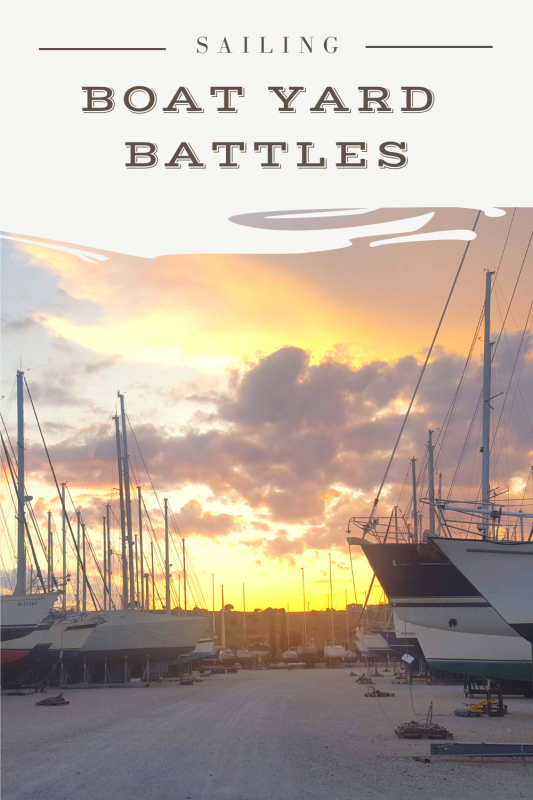
Boat Yard Battles

Storm Sails: The Ultimate Guide

Gill OS2 Jacket Review: Tried And Tested Offshore Gear 2024

Top Ways To Get Fresh Water On A Sailboat

Sailboat Provisioning: How To Provision For A Sailing Trip
One comment.
Should be able to pay moorage before launching and make the rest of us look like vagrants with 3 kids
Comments are closed.
How to restore a classic sailboat
Restoring a classic sailboat can be a fulfilling and rewarding process, allowing you to create a personalized vessel for exploring the open sea with your family.
How to Restore a Classic Sailboat
Restoring a classic sailboat is a labor of love that can bring immense satisfaction and pride to those who embark on this journey. It’s a chance to breathe new life into a vessel that has seen better days, and to create a unique and personalized space for you and your family to enjoy the open sea. In this article, we’ll guide you through the process of restoring a classic sailboat, from finding the right boat to the final touches that make it truly your own.
Table of Contents
Finding the right sailboat, assessing the condition, creating a restoration plan, hull and deck repairs, interior restoration, rigging and sails, electrical and plumbing systems, engine and propulsion, final touches.
The first step in restoring a classic sailboat is finding the right boat. This can be a challenging process, as there are many factors to consider, such as the size, age, and condition of the boat, as well as your budget and personal preferences.
When searching for a sailboat, consider the following:
- Size : Think about how much space you and your family will need, both for living and storage. A larger boat may offer more comfort and amenities, but it will also require more work and expense to restore and maintain.
- Age : Older boats may have more character and history, but they may also require more extensive restoration work. Be prepared to invest more time and money into an older boat.
- Condition : Assess the overall condition of the boat, including the hull, deck, rigging, sails, and interior. A boat in poor condition may be a good candidate for restoration, but it will also require more work and expense.
- Budget : Determine your budget for both the purchase of the boat and the restoration process. Keep in mind that restoration costs can quickly add up, so it’s important to have a realistic understanding of what you can afford.
Once you’ve found a sailboat that meets your criteria, it’s time to assess its condition in more detail. This will help you determine the extent of the restoration work required and whether the project is feasible for your budget and skill level.
Consider hiring a marine surveyor to conduct a thorough inspection of the boat. They can provide valuable insights into the condition of the hull, deck, rigging, sails, and other components, as well as identify any potential safety issues or structural problems.
Take note of any areas that require immediate attention, such as leaks, cracks, or signs of rot. These issues should be addressed before any cosmetic work is done, as they can compromise the integrity of the boat and lead to more serious problems down the line.
With a clear understanding of the boat’s condition, you can now create a restoration plan. This should outline the work that needs to be done, the order in which it should be completed, and an estimated timeline and budget for the project.
Start by prioritizing the most critical repairs, such as fixing leaks or addressing structural issues. Then, move on to less urgent tasks, such as cosmetic improvements and upgrades.
Be realistic about your abilities and the amount of time you can dedicate to the project. Restoring a sailboat can be a time-consuming and labor-intensive process, so it’s important to have a clear understanding of what you’re getting into before you begin.
The hull and deck are the foundation of your sailboat, and any issues with these components should be addressed as soon as possible. Common problems include cracks, blisters, and signs of rot or corrosion.
To repair cracks or holes in the hull or deck, you’ll need to clean the area thoroughly, remove any damaged material, and fill the void with an appropriate filler or epoxy. Once the repair has cured, sand the area smooth and apply a protective coating, such as paint or gelcoat.
For more extensive repairs, such as replacing large sections of the hull or deck, it may be necessary to consult with a professional boatyard or shipwright. They can provide guidance on the best materials and techniques for your specific boat and ensure that the repairs are done correctly.
Restoring the interior of your sailboat can be a rewarding process, as it allows you to create a comfortable and personalized space for you and your family. Start by assessing the condition of the interior, including the cabinetry, upholstery, and flooring.
If the cabinetry is in good condition, you may be able to simply refinish or paint the surfaces to give them a fresh look. If the cabinets are damaged or outdated, consider replacing them with new, custom-built units that meet your needs and preferences.
Upholstery can be cleaned or replaced, depending on its condition and your personal taste. New cushions, curtains, and other soft furnishings can make a big difference in the overall appearance and comfort of the interior.
Flooring options for sailboats include marine-grade carpet, vinyl, or teak. Choose a material that is durable, easy to clean, and complements the overall aesthetic of the boat.
The rigging and sails are essential components of your sailboat, and their condition will have a significant impact on the boat’s performance and safety. Inspect the rigging for signs of wear or damage, such as frayed lines, corroded fittings, or bent or cracked hardware. Replace any components that are in poor condition or no longer meet safety standards.
Sails should be inspected for tears, fraying, or signs of UV damage. Small repairs can often be made with sail tape or by sewing, but larger issues may require professional repair or replacement. Consider upgrading to modern sail materials and designs for improved performance and durability.
The electrical and plumbing systems on a classic sailboat may require updating or replacement to meet modern standards and ensure safety and reliability. Inspect the wiring, switches, and electrical components for signs of wear or damage, and replace any outdated or faulty parts.
Plumbing systems should be checked for leaks, corrosion, or other issues. Replace any damaged hoses, fittings, or fixtures, and consider upgrading to modern materials and designs for improved performance and ease of maintenance.
The engine and propulsion system are critical to the performance and safety of your sailboat. Inspect the engine for signs of wear or damage, and perform any necessary maintenance or repairs. This may include changing the oil and filters, replacing belts or hoses, or overhauling the entire engine.
The propeller and shaft should also be inspected for signs of wear or damage, and any issues should be addressed promptly. Consider upgrading to a modern, efficient propulsion system for improved performance and fuel efficiency.
With the major restoration work complete, it’s time to add the final touches that make your sailboat truly your own. This may include installing new electronics and navigation equipment, adding custom artwork or graphics, or outfitting the boat with personalized accessories and gear.
Take the time to celebrate your hard work and enjoy the fruits of your labor. Your restored classic sailboat is now ready for new adventures and memories with your family.
Restoring a classic sailboat is a challenging but rewarding endeavor that can provide you and your family with a unique and personalized vessel for exploring the open sea. By carefully assessing the condition of the boat, creating a detailed restoration plan, and tackling the project one step at a time, you can breathe new life into a once-neglected boat and create a lasting legacy for future generations.
404 Not found
- AB Inflatables
- Limitless Seas
- Hunt Yachts
- New Inventory
- Pre-owned Inventory
- Outboard Service & Repower
- Boat Storage
- Request a Quote
- Financing Application
- Meet the Team
- Yachting Insider
- RestoMod/Tuning
- Types of Yachts
- Outboard Service and Repower Center
- Volvo Penta
- Finance Application
- About Us / History
- YACHTING INSIDER
- Resto-mod Gallery
YACHT RESTORATION PROJECTS
If you've ever dreamed of updating or restoring an older boat like a car enthusiast revives a classic '71 Thunderbird, the Yachting Solutions team will follow your lead and bring that vision into reality. Using our resto-mod process, we refurbish the classic lines of vintage vessels while incorporating modern performance features, all to deliver a customized watercraft that speaks to your soul.
A hybrid of restoration and modification, Yachting Solution's resto-mod process preserves your boat's timeless look with modern upgrades to meet today's performance needs. From small lake boats to large motor yachts, we're passionate about the art of boat restoration. We'll work closely with you to create a personalized resto-mod concept and deliver a fully realized remodel you can take pride in.
Whether you want to restore a 60s Boston Whaler, refresh your boat's exterior paint, refurbish your yacht's interior, or get a quick installation of the latest boat mods, give Yachting Solutions a call. Our expert shipwrights, painters, varnishers, and technicians are here to help return your watercraft to its former glory and provide cutting-edge upgrades to enhance all your boating adventures.
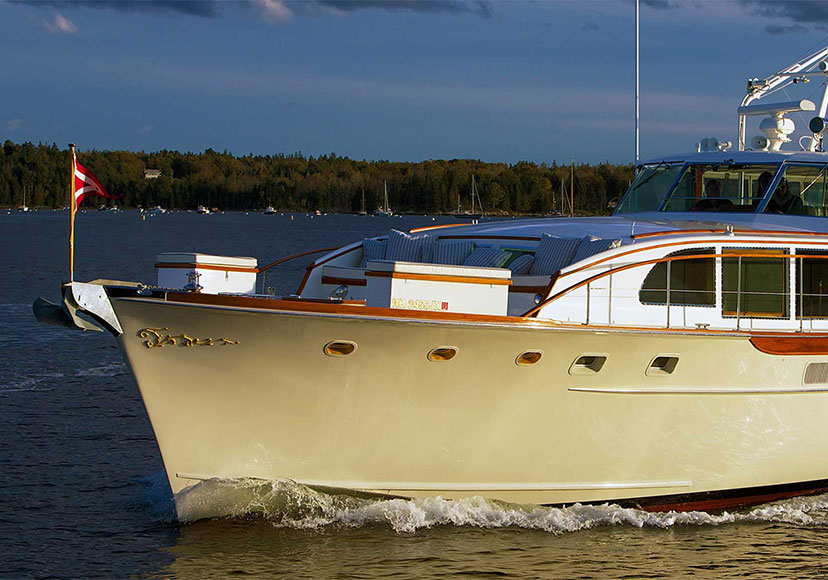
1971 TRUMPY
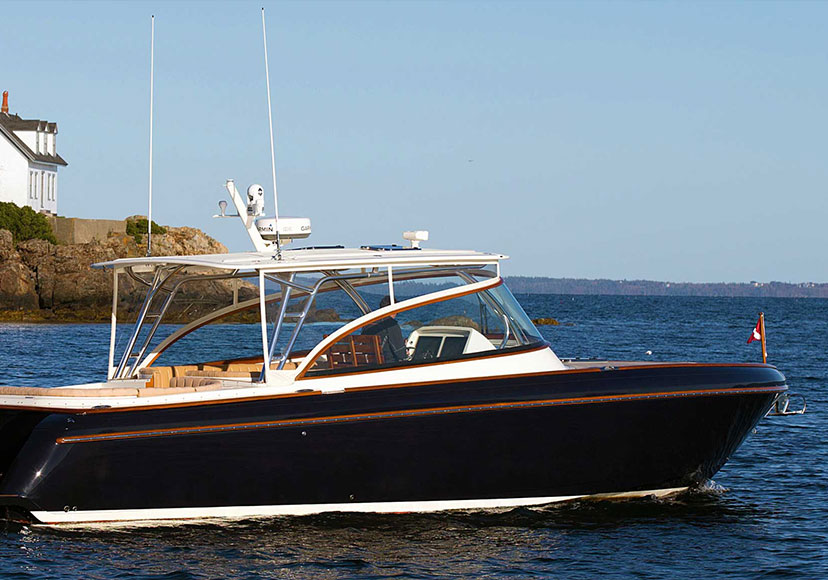
2013 INTREPID
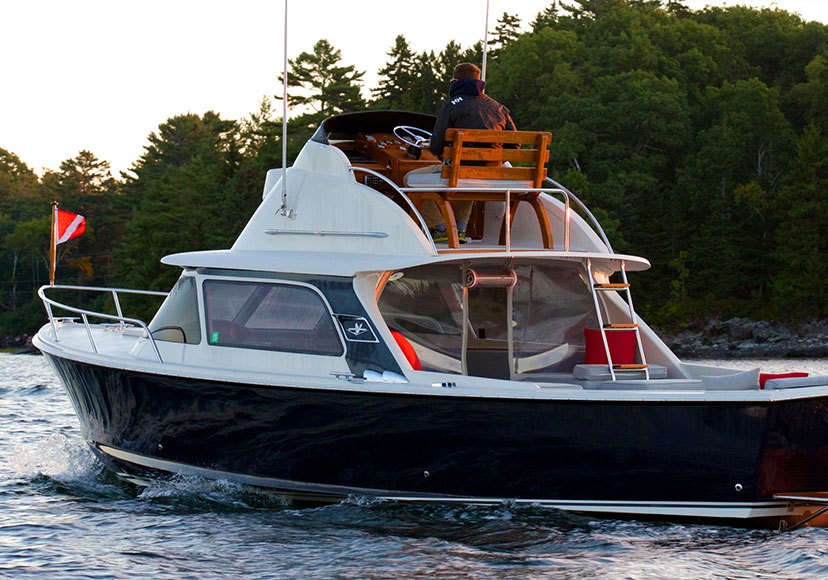
1963 BERTRAM
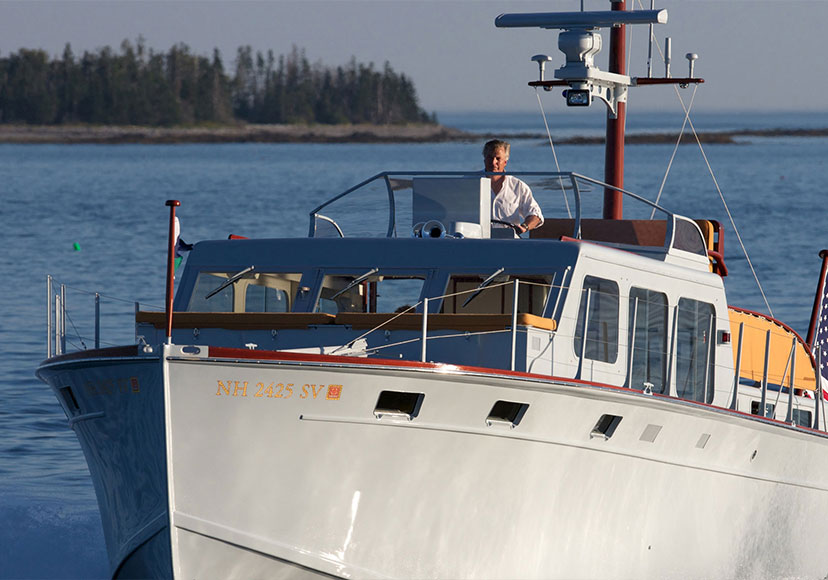
1954 HUCKINS
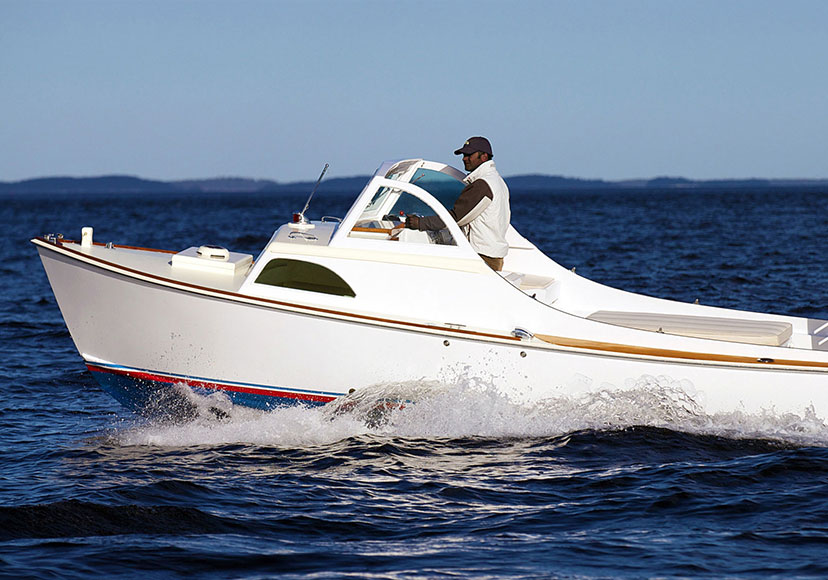
1964 WHITICAR
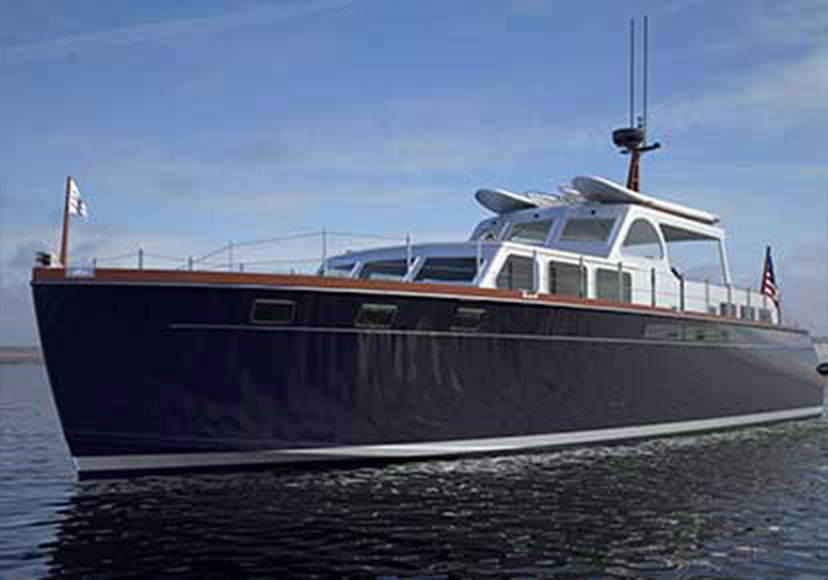
1956 HUCKINS
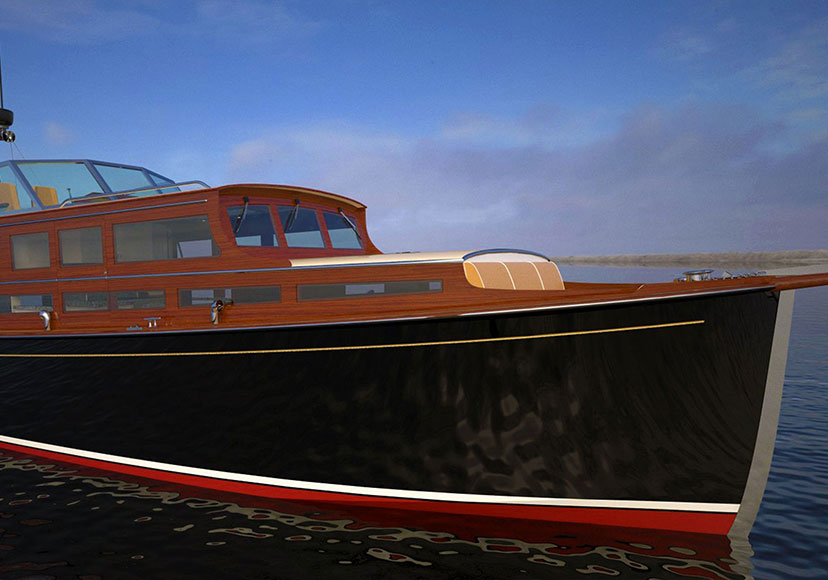
1930 HUCKINS
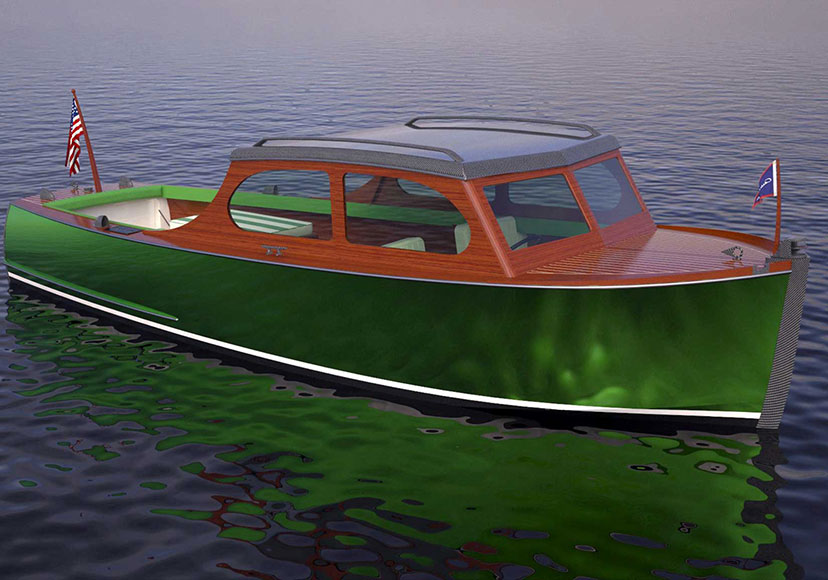
1940 CHRIS-CRAFT
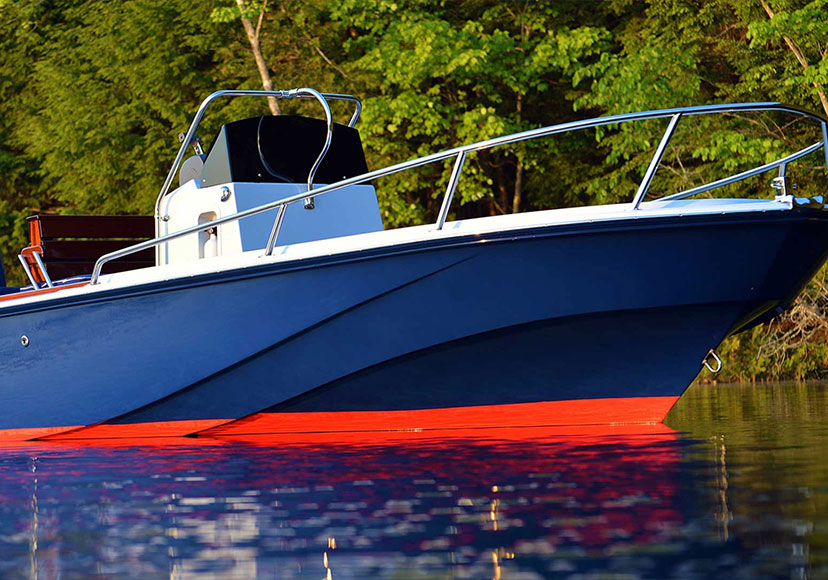
1989 BOSTON WHALER
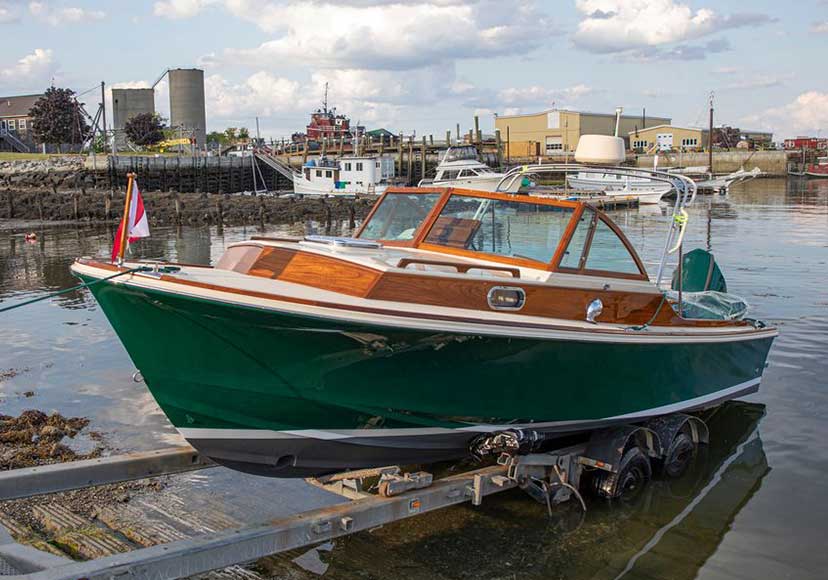
1972 AURELIA CLASSIC
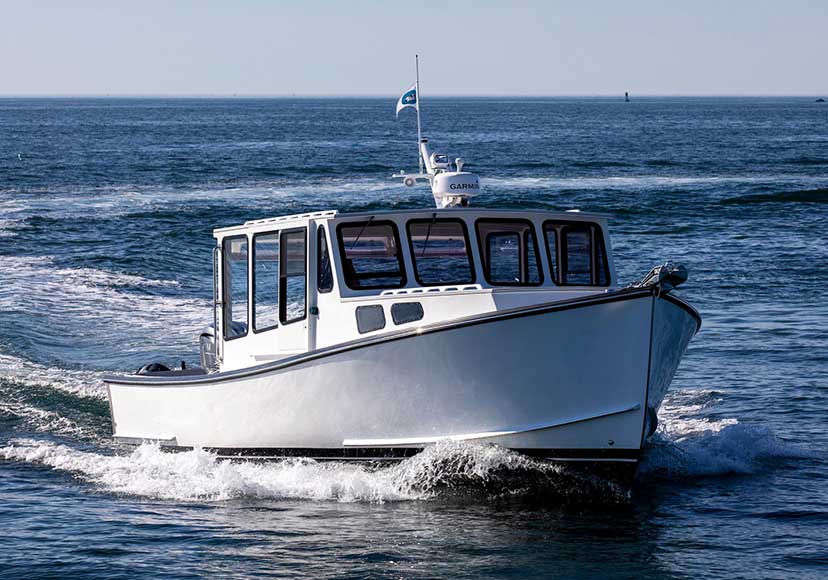
COW TOW LOBSTER
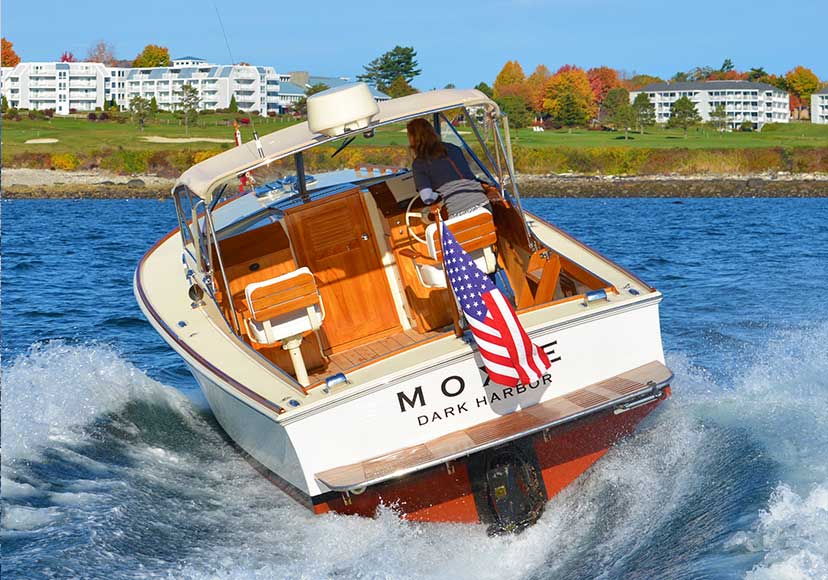

Service Locator
- Angler Endorsement
- Boat Towing Coverage
- Mechanical Breakdown
- Insurance Requirements in Mexico
- Agreed Hull Value
- Actual Cash Value
- Liability Only
- Insurance Payment Options
- Claims Information
- Towing Service Agreement
- Membership Plans
- Boat Show Tickets
- BoatUS Boats For Sale
- Membership Payment Options
- Consumer Affairs
- Boat Documentation Requirements
- Installation Instructions
- Shipping & Handling Information
- Contact Boat Lettering
- End User Agreement
- Frequently Asked Questions
- Vessel Documentation
- BoatUS Foundation
- Government Affairs
- Powercruisers
- Buying & Selling Advice
- Maintenance
- Tow Vehicles
- Make & Create
- Makeovers & Refitting
- Accessories
- Electronics
- Skills, Tips, Tools
- Spring Preparation
- Winterization
- Boaters’ Rights
- Environment & Clean Water
- Boat Safety
- Navigational Hazards
- Personal Safety
- Batteries & Onboard Power
- Motors, Engines, Propulsion
- Best Day on the Water
- Books & Movies
- Communication & Etiquette
- Contests & Sweepstakes
- Colleges & Tech Schools
- Food, Drink, Entertainment
- New To Boating
- Travel & Destinations
- Watersports
- Anchors & Anchoring
- Boat Handling
- ← Lifestyle
Keeping The Past Alive: Restoring Wooden Boats
Advertisement
Meet these passionate boaters who share the same devotion to restoring vintage craft.
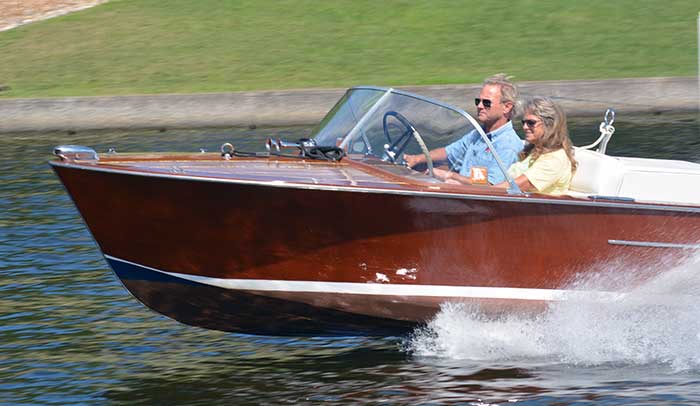
Turning the past into the present: Terry Hart salvages sunken wooden boats, then restores them to their former glory.
As Terry Hart's ski boat knifes through the waves on Lake of the Ozarks, he commands attention. Some boaters steer closer to get a good look. Others wave or honk their horns.
It isn't every day that you see a boat like Hart's on the big lake. His 1961 wooden Chris-Craft ski boat is definitely a showboat, and a magnet for attention on the water.
"This is our go-to-dinner boat," Hart said above the rumbling of the engine. "When we pull up to a waterfront restaurant, people aren't rushing out to look at the million-dollar cruisers that dock there," he says. "They're coming out to look at our old wooden boat."
The ski boat, which Hart named Chug in honor of her past owner's sons, Charles and Doug, is a reminder of the lake's rich past when wooden boats were common. Spot one on Lake of the Ozarks and, chances are, Hart is behind the steering wheel. He's owned as many as 25 classic and antique wooden boats.
Society Of Wood Boat Aficionados
Among a select group of discerning boaters, Kathy Parker would much rather cruise the lake in a vintage boat than a new one.
"Being seen in a vintage boat lets viewers know that you are not just satisfied with the ordinary," says Parker, the interim director of the national Antique and Classic Boat Society (ACBS).
Parker finds it easy to promote the lifestyle her organization is dedicated to. She and her husband, Don, live near Table Rock Lake in the Missouri Ozarks, and they have three vintage boats — a 1965 Carver, a 1954 Chris Craft, and a 1989 Century Arabian.
"We came from Nebraska where there aren't many good boating lakes," Parker said. "Now in retirement years, we get to enjoy living by a lake."
Many others are enjoying that same lifestyle. That is reflected through the ACBS membership, which counts more than 12,000 members nationally and includes almost 100 boats that were built in the 19th century. The oldest was launched in 1860.
How old does a boat have to be before it is considered an antique? The society has five categories:
- Historic: A boat built up to and including 1918
- Antique: A boat built between 1919 and 1942
- Classic: A boat built between 1943 and 1975
- Late Classic: A boat built after 1975 up to the time 25 years prior to the current year
- Contemporary: A wooden boat built in the last 25 years
ACBS is an international organization. There are chapters in the United States, Canada, and France, but there are members from New Zealand, Australia, Bermuda, Germany, England, Iceland, Denmark, Sweden, Puerto Rico, China, Spain, Switzerland, and the Virgin Islands.
The most common vintage boat is a Chris-Craft. But there also are many Century boats. And in the Midwest, Higgins, Lyman, Thompson, and Dunphy are all lapstrake boats that are popular.
The cost and value of antique and classic boats vary widely with the condition they are in when purchased. For example, many collectors pay less than $10,000 for a boat that has been sitting in storage for years and put in the time to restore it themselves. Rare and fully restored boats can cost much higher.
For more information on the ACBS, visit ACBS.org .
— Brent Frazee
"Some people would call me a hoarder," Hart says with a laugh. "I prefer to call myself a collector. I'm just fascinated by these old wooden boats. Each of them has a story." In Chug's case, that story can be traced to the former CEO of 7-Up, who used the boat in Michigan. When the boat was only two years old, he advertised it for sale, and Hart's uncle purchased it and brought it to Lake of the Ozarks, where he and his family used it for about five years. Eventually, Hart's relative fell ill and the boat sat unused for three years.
When Hart purchased the boat, he lifted the cover to find wasp nests and mildew. He later discovered there was some wood rot on the bottom. He brought it back to his shop and spent several months working on it, putting in 1,000 hours of sanding, varnishing, painting, and working on the mahogany. By the time he was done, he and his wife, Sue, were ready to start cruising.
"This boat will go 40 miles per hour, tops. And I sure didn't buy it for its ride. It's a rough-riding boat," says Hart, 64, who lives in Lake Ozark, Missouri. "I love these boats' history, and I was looking forward to really working on one and getting it back to good running shape."
Reclaiming The Past
Hart doesn't have to kick around old storage sheds and barns to find the vintage boats he desires. He owns a long-standing dive and salvage business at the sprawling lake located in central Missouri, and that gives him ready access to the old boats he restores.
"A lot of the boats that we find have sunk from neglect right at the dock. We'll pull them up and we'll buy them from either the owner or the insurance company," he says. "If they're not damaged too badly, they can be saved."
Often, Hart will strip them down and just rebuild them with wood like cedar or oak. So by the time Hart and his crew members are done, boats such as Chug must be worth a lot, right? Well, not exactly. Hart estimates that Chug might be worth $25,000 at most. "One time a guy asked me how much it would take to buy my boat," he says. "I threw out what I thought was a high figure, $13,000, thinking there was no way he would go for it. Well, he did, and I had to back out of it."
The masterpiece of Hart's present collection is a 1926 Lake Union Dreamboat, an ahead-of-its-time cabin cruiser. That boat features a rich wood finish, sliding windows, a cabin with living space, sleeping quarters, and a galley.
"It was being restored on this lake, and the owner had already put $90,000 in it," Hart says. "But he didn't get it done. We saved it from sinking, and the owner didn't want to part it out, so we bought it."
In the winter months, Hart can be found in his workshop, restoring vintage boats. "We do it all," Hart said. "We do the sanding, woodwork, painting, varnishing, upholstery, engine, everything.
"It really is fun to compare what shape some of these boats were in when we got them and how they look after we're done."
A Passion For Wooden Boats
Kevin Hogan and his wife, Jeanne, who live in Olathe, Kansas, are among the many who share a passion for wooden boats. They have displayed their 1958 Century 21-foot Coronado at local boat shows and other events.

"We decided to name it Love Me Timber because it's a wooden boat," Hogan says.
This is the second classic boat Hogan has purchased. A retired industrial-arts teacher, he was looking for a project he could enjoy. He found one when he bid for a 1954 Century Resorter runabout.
"I got it for $2,050," he says.
He also got a big challenge. The boat was stripped, except for the hardware and the engine. So Hogan went to work on his restoration. "It was ready for the burn pile," he says. "Everything was rotten."
It took Hogan 1,200 hours to restore the boat to its stylish self. Then he and Jeanne were able to launch it and get out on the water.
"It was a thrilling moment when we were able to use it for the first time," he said.
The mind of Eugene Lee works in intricate ways, which helps explain how the Tony-award-winning set designer approaches his trade. He hopes to immerse all your senses in the experience of live theater, so you forget about everything else and are completely enveloped in the now. For this man, whose name is most associated with "Saturday Night Live" and "Wicked," television and theater are work. His passion? Owning and restoring wooden boats.
"You know, I've never met a stagehand who didn't love boating," Lee says. "If that's not a sign from the universe that I've chosen the perfect profession and hobby, I don't know what is." Lee's wood fleet totals about 10, including a Concordia 31, a pair of Laurent Giles-designed Vertue sloops, a couple of Herreshoff 12-1/2s, a Herreshoff Buzzards Bay 15, a Beetle Cat, a Pete Culler lapstrake yawl, and a Pulsifer Hampton launch.

Such drama rises from boats: For Tony-award-winner Eugene Lee, theatrical set design and wooden boats go tongue and groove. (Photo: Billy Black)
The 79-year-old Lee, whose career spans more than 40 years, better resembles a Yankee shipwright than a denizen of the Great White Way. Round, clear eyeglasses frame a balding head of gray hair. Red, white, and blue suspenders hold up rugged khakis over his thin frame. Worn-out boat shoes complete the picture. He may be unassuming, but whether advising Steve Martin and Edie Brickell on their Broadway musical "Bright Star," or showing off a scale model of the miniature Manhattan skyline he created for "The Tonight Show Starring Jimmy Fallon," he's still in the thick of A-list entertainment.
Connecting A Fleet Of Passions
Lee commutes into New York City weekly from his home and studio in Providence, Rhode Island, which he shares with his wife, Brooke. Wedged into every square foot, Lee's house and work space are eclectic collections, among them miniature barnyard animals, model skyscrapers, old typewriters, fans, framed prints, wooden stacking toys, T-squares, salt-and-pepper shakers, oars, vintage wooden rulers, giant clothespins, at least one life-size stuffed bear, walking canes, and canisters of pencils. Surrounded by all this stuff, and with the score of "Bright Star" playing on the stereo, he talks about his fleet of wood sailboats.

Eclectic collections are wedged into every corner of Lee's work space. (Photo: Billy Black)
" Jerry Todd , my Herreshoff 12-1/2, was named after a character in my grandfather's books," Lee says. "Named after my father, actually." Lee's grandfather, Edward Edson Lee, was the author of children's books such as Jerry Todd , Pirate , and Jerry Todd and the Oak Island Treasure , under the pen name Leo Edwards. "Ronald Reagan said my grandfather's books were his favorite growing up."
Lee and his twin brother, Tom, spent carefree Wisconsin summers full of DIY projects, shooting sun sights with a sextant, sailing, rowing, and whipping up magic tricks. There was always lots of bustle around Lake Ripley, and lots of boats, which is where Ole Evinrude tested out his great invention, the outboard motor. Summer also gave the boys time to read books by sailors Eric and Susan Hiscock, which sent Lee's imagination soaring beyond the lake, to the challenges of bluewater voyaging.
"I was always interested in Vertues because the Hiscocks sailed Wanderer III , a 30-foot Vertue, around the world," he recalls, then adds, "I'd live on a boat in a second."

Lee aboard Karesta Ferida at the Wickford Shipyard in Wickford, Rhode Island. (Photo: Billy Black)
Years passed, the boys grew, and while Tom got a commission to West Point, Eugene was drawn to sketchpads, isometric drawings, and the theater. He received BFA degrees from Carnegie Tech and the Art Institute Of Chicago, and a Master of Fine Arts from Yale School of Drama.
"I'm just doing now what I was doing in high school, to be honest," Lee says. "It hasn't changed. A lot of the technology of the theater comes from sailing ships. The systems that were used in the theater to fly things involved counterweights and blocks and falls. All that's right out of how the mechanics of theater used to be done.
"Set designers like me, we know a little bit about engineering, but we're not engineers. We do things architects might do, but we're not architects" he says, spreading out drafting paper that contains his storyboard from the musical "Wicked," which would become the blockbuster Broadway hit. "It's a funny profession."
— Elaine Lembo
Related Articles
The truth about ceramic coatings for boats.
Our editor investigates the marketing claims of consumer-grade ceramic coatings.
Fine-Tune Your Side Scan Fishfinder
Take your side-scanning fishfinder off auto mode, and you’ll be spotting your prey from afar in no time
DIY Boat Foam Decking
Closed-cell foam flooring helps make boating more comfortable. Here’s how to install it on your vessel
Click to explore related articles
Brent Frazee and Elaine Lembo
Contributors, BoatUS Magazine
Award-winning BoatUS Magazine is the official publication of Boat Owners Association of The United States. The magazine provides boating skills, DIY maintenance, safety, news and more from top experts.
BoatUS Magazine Is A Benefit Of BoatUS Membership
Membership Benefits Include:
Subscription to the print version of BoatUS Magazine
4% back on purchases from West Marine stores or online at WestMarine.com
Discounts on fuel, transient slips, repairs and more at over 1,200 businesses
Deals on cruises, charters, car rentals, hotel stays and more…
All for only $25/year!
We use cookies to enhance your visit to our website and to improve your experience. By continuing to use our website, you’re agreeing to our cookie policy.
- 2024 BOAT BUYERS GUIDE
- Email Newsletters
- Boat of the Year
- 2024 Freshwater Boat and Gear Buyers Guide
- 2024 Boat Buyers Guide
- 2024 Water Sports Boat Buyers Guide
- 2023 Pontoon Boat Buyers Guide
- Cruising Boats
- Pontoon Boats
- Fishing Boats
- Personal Watercraft
- Water Sports
- Boat Walkthroughs
- What To Look For
- Best Marine Electronics & Technology
- Watersports Favorites Spring 2022
- Boating Lab
- Boating Safety

Easy Tips for Boat Restoration
- By Heather Steinberger
- Updated: February 10, 2020
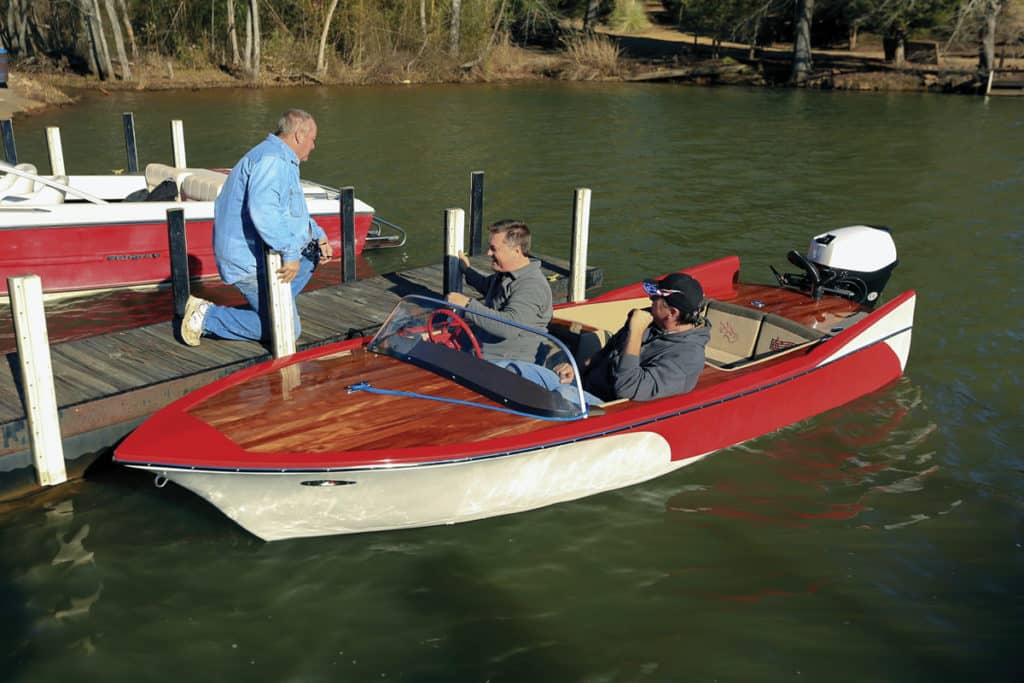
If you’ve got an aging or damaged boat that has sentimental value, you might be ready to tackle a restoration project. Here are 11 tips to keep in mind when restoring an older boat.
1. Take an inventory of your tools, and then roll up your sleeves and start. It’s that simple.
2. Clean the boat from stem to stern so you can see exactly what you have to work with.
3. Remove all the water, leaves and debris from the boat. Organic material is your enemy.
4. Identify what’s broken. Seat bases? Fiberglass components? The steering system? Will you need fiberglass boat restoration?
5. Remove the old fuel from the fuel tank, as well as the old oil from the engine and gear case.
6. Remove the old belts and hoses on the engine and replace them with new ones.
7. Check the through-hull fittings to make sure they are still properly sealed. Also check the seacocks to make sure they are in working order. Replace any broken ones.
8. Look for cracking and crazing in the fiberglass around fixtures and fittings, such as cleats. Make sure load-bearing fixtures have a proper backing plate.
9. Old boats may have lots of rotting wood. Check the deck floor, seat bases and especially the transom for sagging, rot or decay. Strip old wood out of the boat and replace it with marine-grade plywood or a modern cored composite.
10. Go to YouTube and find at least three step-by-step DIY videos that say the same thing. These guys might not be “experts,” but they at least have experience.
11. Have a specific job in mind? Check out all of our content dedicated to DIY projects.
Boat refurbishing and boat restoration can be much more complicated than the tips above, but the checklist will allow you to work on basic exterior and boat interior restoration.
- More: diy projects , How-To , Used Boats
More How To
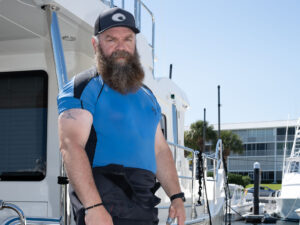
On Board With: Jeremy Dennard
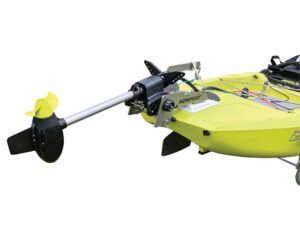
Installing an Electric Motor on a Kayak
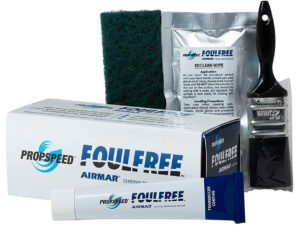
We Test: Foulfree by Propspeed
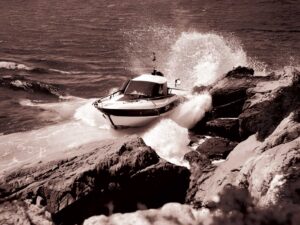
What to Do if Your Boat’s Engine Dies
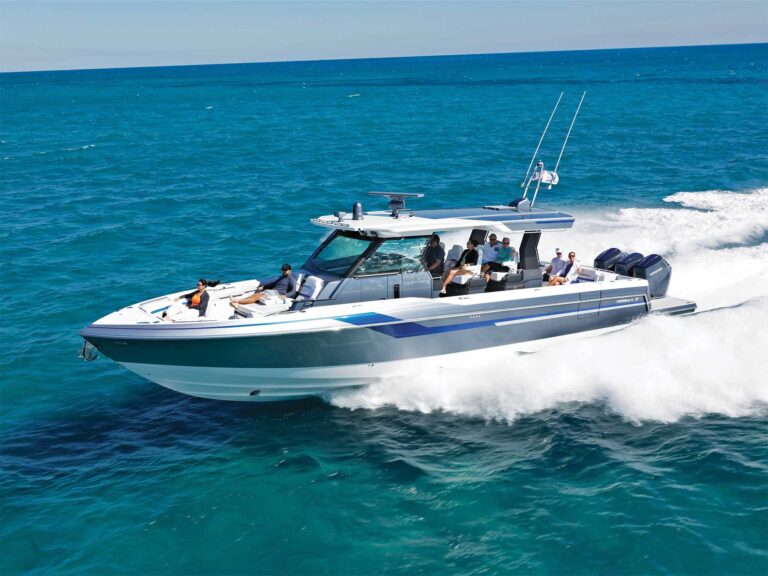
Boat Test: 2024 Formula 457 CCS
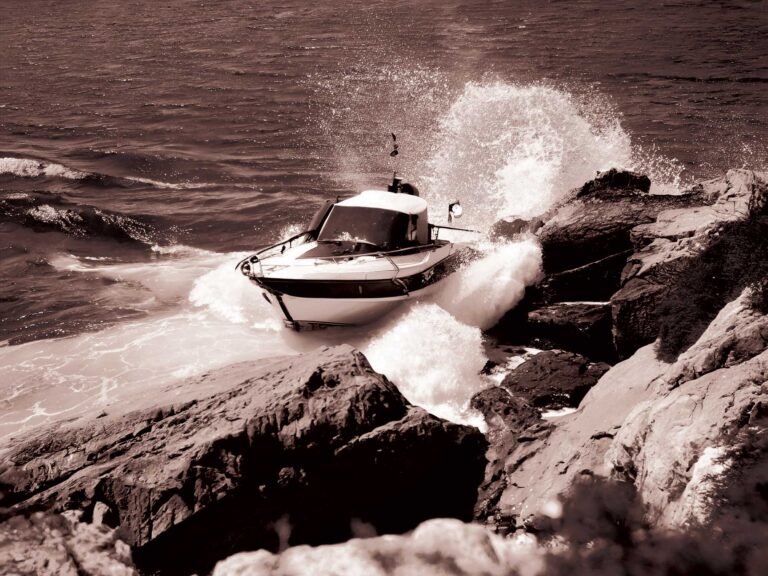
A New Electric-Powered-Boat Speed Record
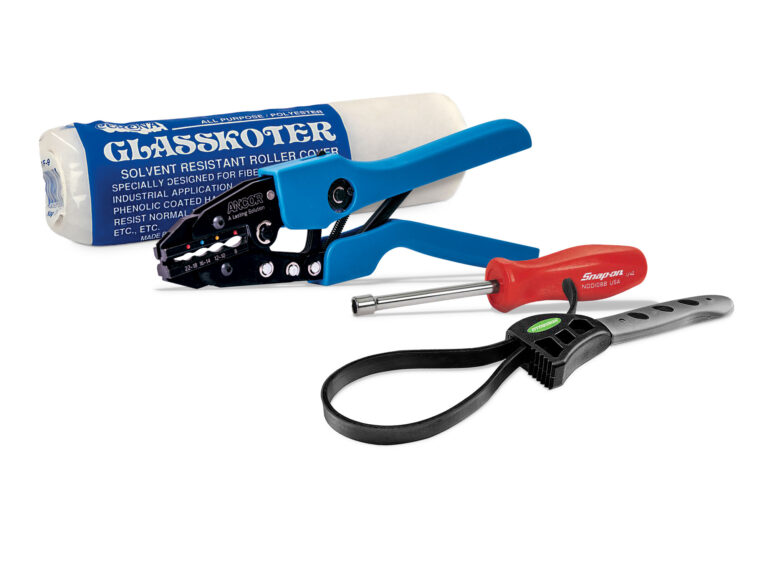
Six Tools for Spring Make-Ready

- Digital Edition
- Customer Service
- Privacy Policy
- Cruising World
- Sailing World
- Salt Water Sportsman
- Sport Fishing
- Wakeboarding
Many products featured on this site were editorially chosen. Boating may receive financial compensation for products purchased through this site.
Copyright © 2024 Boating Firecrown . All rights reserved. Reproduction in whole or in part without permission is prohibited.

DIY Boat Restoration: Tips and Tricks for a Budget-Friendly Makeover
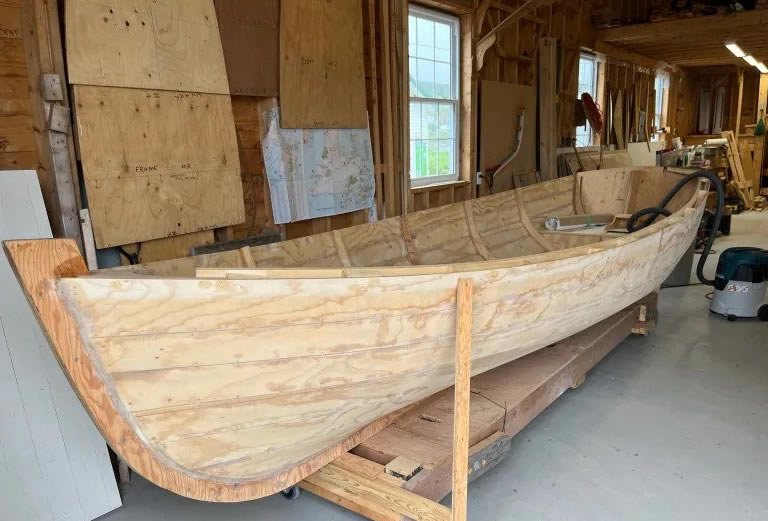
Restoring an old boat can be a rewarding and cost-effective way to breathe new life into a beloved vessel.
While it may seem like a daunting task, with the right tips and tricks, you can embark on a DIY boat restoration project that’s easier on your wallet and more satisfying than you might expect.
Helpful Boat Restoration Guides
1. set clear goals, 2. create a detailed plan, 3. prioritize safety, 4. do your own research, 5. salvage and recycle, 6. budget-friendly materials, 7. diy fiberglass repairs, 8. refinishing and painting, 9. upholstery on a budget, 10. routine maintenance.
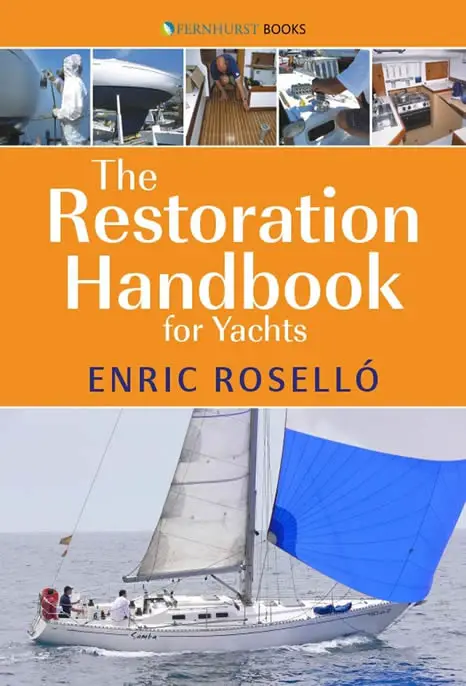
Boat Restoration Guide
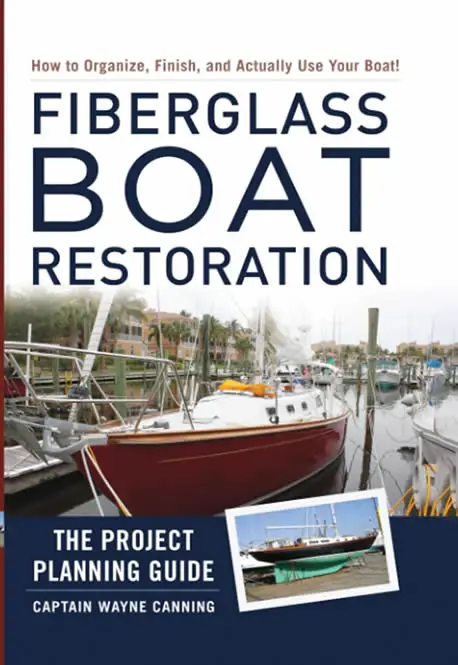
Fiberglass Boat Restoration Guide
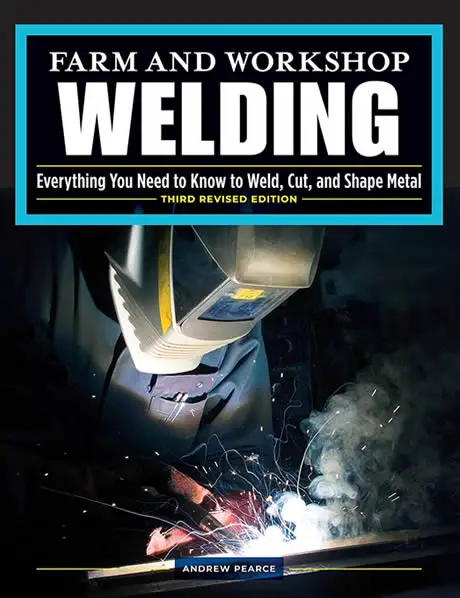
Metal Shape Welding Instructions For Boat Building
10 Tips To Make Boat Restoration Simple
In this guide, we’ll share valuable insights and cost-saving strategies to help you navigate your boat restoration journey with confidence.
Before you dive into your boat restoration, determine the scope of your project.
Are you looking for a complete overhaul or just some minor repairs and cosmetic touch-ups?
Setting clear goals will help you avoid overspending and stay focused on your budget.
A well-thought-out plan is essential. Take the time to assess the boat’s condition and identify areas that require attention.
Create a checklist of tasks, including materials and tools needed.
A comprehensive plan will prevent impulse purchases and keep you on track.
Safety should always be a top priority.
Inspect the boat for structural issues, such as rot or damage, and address them first.
This ensures that your boat is safe for use, and you won’t compromise your safety while on the water.
Become a savvy researcher. Look for DIY boat restoration resources, such as books, online forums, and video tutorials.
Learning from others’ experiences can save you from common pitfalls and provide valuable insights.
When possible, salvage and recycle materials from your boat. Old hardware, wood, and even upholstery can often be refurbished or repurposed.
This not only saves money but also adds character to your project.
Shopping for materials doesn’t have to break the bank.
Consider marine-grade plywood alternatives, explore second-hand stores for décor, and compare prices from different suppliers to find the best deals.
Don’t forget to inquire about discounts or bulk rates.
Many small fiberglass repairs can be done at home.
Learning basic fiberglass repair techniques will save you money on hiring professionals.
Invest in a fiberglass repair kit and follow instructional videos to tackle small cracks or holes.
For cosmetic improvements, you can save money by refinishing and painting your boat yourself.
Proper sanding, priming, and using quality marine paint can make your boat look as good as new. Don’t forget to choose colors that won’t fade quickly under the sun.
Reupholstering your boat’s seats and cushions can be expensive. Consider buying discounted marine-grade vinyl and learning basic sewing skills to make your own seat covers.
Alternatively, look for deals on pre-made seat covers.
After your boat is restored, keep it in top condition by following a regular maintenance schedule.
Routine care will extend the life of your boat and prevent costly repairs in the future.
Embarking on a DIY boat restoration project can be both a labor of love and an excellent way to save money.
By setting clear goals, creating a detailed plan, and implementing these tips and tricks, you can transform your old boat into a source of pride without breaking the bank.
Remember that patience and perseverance are key to a successful boat restoration, and the satisfaction of sailing in a vessel you’ve restored with your own hands is truly priceless.
You may also be interested in reading our guide that shows you how to build a flat bottom boat and also our boat building plans .
Mick McGrath
Recent Content
518 Illustrated Boat Plans
518 boat plans for less than the price of your lunch! MyBoatPlans Reviews MyBoatPlans is a comprehensive collection of 518 boat plans, 40 videos and about 500 pages of boat building guides. I've...
Set Sail with Confidence: Essential Boat Safety Tips for All Ages and Furry Friends
Picture yourself gliding over crystal-clear waters, the wind in your hair, and the sun kissing your skin. The open sea offers endless possibilities for adventure, but before you hoist the sails, it's...
Log in or Sign up
You are using an out of date browser. It may not display this or other websites correctly. You should upgrade or use an alternative browser .
Want to know how much a restoration might cost you? Read on.....
Discussion in ' Boatbuilding ' started by missinginaction , Apr 7, 2019 .
missinginaction Senior Member
Most of you know I did a restoration on a small cruiser from 2007 until 2014. I'm actually still at it, even though I've been using the boat since 2014. I make improvements every year, some big, some small. Keep in mind that this 1973 Silverton sedan is only 25.5 LOA with a 10.5' beam. I'm writing this because I see so many people wanting to do repair work or a restoration and I usually see the same word used over and over. Cheap. They might say inexpensive, or "I'm on a tight budget" or something similar. I see guys down at the boat club with these huge cruisers that are just used up. They tell me they're going to restore them and some cosmetic work might get done. But usually that's the extent of it as they get overwhelmed, run out of money or their attention span is limited. As I moved through the long process of restoring my little boat I kept almost all of my receipts. Just kept stuffing them into this big manila envelope. I've looked at that envelope for years, always being afraid to add up those receipts. A week ago I took a deep breath and poured them out on the dining room table. It was a two/three hour job just organizing and adding. Here's where I'm going with this and it's not bragging, it's a cautionary tale. Doing a good, first class restoration on a small cruiser has cost well over $40,000.00 in materials alone. There are no labor charges, as I did 99% of the work myself. The hours spent planning, fabricating and installing are in the thousands, easily. I'm out there now but for seven years I spent my summers in the yard while the rest of the boat club was out at the docks having fun. I enjoyed the build and got a lot of satisfaction out of it but I'll be the first to say it's not something most people would choose to do. I'm going to Florida in the fall of 2020. I'll either have the existing engine rebuilt or install a fresh engine over the next 12 months or so. Transmission and V-drive will be checked. Walters makes a great v-drive but they don't work cheap. They shouldn't, they make a quality product that I depend on. That will add another $5,000 or more to the tab as long as I do the installation myself. I'm a single. Thinking of buying a twin engine boat? I don't have to tell you that two is greater than one, do I? Since I certainly lost some receipts along the way and didn't include 7 years of yard charges while I was doing the work let's round off the total cost at $52,000.00. That's a little better than $2 grand a foot, and it is conservative. So, if you think that you're going to buy an old boat, fix a little dry rot or do a little painting and upholstery and have a new boat to impress your friends think again. OK, that is my Sunday morning rant! I'm glad I did my boat but just wanted to post this as a public service. Before you buy an old boat, think. Just think. Regards, MIA
JamesG123 Senior Member
What do you call the amount you spend on a "free" or cheap old boat? The down payment. Great cautionary bit of reality. But OTOH: You have to consider the multiples of what the OP has paid, that a new boat of the same class costs. And even a boat fresh from the factory rarely has zero problems, or doesn't quickly develop them. Or even what a house on dry land costs and costs to maintain.
Tiny Turnip Senior Member
Great thread starter - many thanks MIA. I would add - especially if anyone is contemplating a restoration or build at the same time as a full time job, raising a family, studying or similar, the ability to keep working at it evening after evening for perhaps several years is a HUGE ask - keeping the morale going. I've fought shy of major boat projects so far (OK I have an ongoing church restoration - I'm an architect and living in it - taken me 19 years so far and I'm not done) because I know I just don't have the emotional/psychological resource that it would demand. At the moment
Ike Senior Member
When I restored my 1972 18 foot Sea Ray SRV190, I stopped adding up the cost at around $6000.00. I never did track my labor, but it took about 6 mos, working almost every day, just to get it where I could put it in the water, and then the engine needed a lot of work. Now 10 years later I am having an engine installed (by professionals) and the cost is going to top $3k But I got the engine cheap! LOL Last summer I had to buy a new trailer (the old one collapsed) which cost just under $3k. I am a member paid in full of the hole in the water club.
grady Novice
So....If I may. I'm in a slightly different "Boat", I've always purchased boats that were in the best condition i could afford. Which has always been just above average. My problems start when I go in for upgrades and improvements. For whatever reason one system leads my to another...next thing you know I'm doing a complete restoration of engines, fuel tanks, paint, electronics etc etc.... I own a 1986 24' Grady White that I restored over a 3 year period with a price tag in excess of $45,0000.00 (including a complete hull side and topside awlgrip paint job that I sprayed myself) that boat freshly finished wasn't worth a nickel more than $15.000.00 also own a 1994 33' Blackfin Combi w/twin Cat 3208 TA's @375 hp.......what started as a oil pan leak has turned into a complete rebuild of the Cats at a cost of $60,000.00. and a full refit of the engine compartment all new hoses, battery cables, and batteries, water heater, new paint imron industrial coatings , raw and fresh water pumps, hose clamps, reverso oil exchanger, new Racor fuel filter system complete restored gen set.....etc...etc. the worst part is I olny budgeted $5,000.00 for this job.......Kicked My bank account's ***. Moral of the story is......take your estimated restoration budget and multiply by 4 then take your estimated elapsed time frame and triple that......and you will still by off by 10%. LOL.......labor of love you just have to be prepared...or do what I do lie to my wife. Tony G.
tpenfield Senior Member
MIA- Your restoration might be on the high end of the cost scale. I totally get your comments about folks asking guidance on doing restoration on the cheap. . . it doesn't happen . . . and they end up spending the amount of money necessary or abandoning the project. The cost depends on how much a particular boat needs and the owner's desire for the level of materials and craftsmanship. . . but if you have to do deck, hull structure, engine, and interior restoration, on a 25 foot-ish boat, at least $15,000 - $20,000 would certainly be expected. Of course someone who picks up an old hull for $1,000 with the dreams of making it a boat again for a few $K doesn't really want to hear that
As I read these replies a few things cone to mind. First, Tiny Turnip is a wise man. I could never have done what I did had I been working. I poked and planned a little but waited until I was done working before starting in earnest. It's also a good idea to consider your family. I see a lot of divorced boaters and I wonder...... I promised my wife when I started that I wouldn't let the boat effect the family financially. I kept my promise. Kids need attention as do spouses. The house needs maintenance and he property needs to be kept up. I took two long cross country road trips with my son, putting the boat on the back burner. Best thing I ever did, we have a lot of great memories and those days are now gone forever. Because I've been a boater I kept a log of our road trip journey. He doesn't realize it but someday perhaps he'll look at the log and retrace the trip he took with his old man with his own son or daughter. Maybe I could have done the whole boat in four years instead of seven. I'd probably be divorced and I'd probably not have the relationship with my son that I do now. As for costs being on the higher end......that's true. The boat had a horribly uncomfortable flybridge arrangement that cost a lot of time effort and money to redesign. I added an auxiliary outboard, and autopilot and chart plotter. The modifications to the transom, a new larger, stronger swim platform to support the outboard and the electronics to control it cost right about $10,000.00. Could I have skipped that and still had a nice boat? Yes sir. But it wouldn't have been nearly the boat that it's turned out to be. Since I run single handed most of the time it wouldn't be nearly as safe. Thanks to Garmin, I've learned to do things with that TR-1 autopilot and the little outboard that I never considered when I decided to install them. I don't have "two foot'itis". I see so many people down at the boat club who are trading boats every couple of years. They usually end up in something approaching 40 feet at exactly the time that their bodies start failing them. So many of these boats never seem to leave the dock. So while it's true that restorations are very expensive, I'd argue that because this is the last boat I will ever own it is money well spent. Everything that's been installed is still there and working correctly. I had one problem with an electronic component in the past 5 years. I called Blue Sea Systems, we went through a diagnostic procedure and the man said "Well, it seems to have failed. I'll ship you out a new one. Could you please send me the old ACR after you swap it out? We want to take a look at it." No charge. Guaranteed for life. Who can argue with that? But.....you pay for it. I guess the reason for my original post is that I see so many people wasting time and money thinking they can do a restoration. They don't realize the amount of time, money and study involved. When people ask me who made my boat I tell then "I did". If they show some interest I'll talk to them a little about what it involved. Then I almost always say the same thing. "Don't".
- Advertisement:
chowdan 1980 PAC41 Liveaboard
missinginaction said: ↑ As I read these replies a few things cone to mind. First, Tiny Turnip is a wise man. I could never have done what I did had I been working. I poked and planned a little but waited until I was done working before starting in earnest. It's also a good idea to consider your family. I see a lot of divorced boaters and I wonder...... I promised my wife when I started that I wouldn't let the boat effect the family financially. I kept my promise. Kids need attention as do spouses. The house needs maintenance and he property needs to be kept up. I took two long cross country road trips with my son, putting the boat on the back burner. Best thing I ever did, we have a lot of great memories and those days are now gone forever. Because I've been a boater I kept a log of our road trip journey. He doesn't realize it but someday perhaps he'll look at the log and retrace the trip he took with his old man with his own son or daughter. Maybe I could have done the whole boat in four years instead of seven. I'd probably be divorced and I'd probably not have the relationship with my son that I do now. As for costs being on the higher end......that's true. The boat had a horribly uncomfortable flybridge arrangement that cost a lot of time effort and money to redesign. I added an auxiliary outboard, and autopilot and chart plotter. The modifications to the transom, a new larger, stronger swim platform to support the outboard and the electronics to control it cost right about $10,000.00. Could I have skipped that and still had a nice boat? Yes sir. But it wouldn't have been nearly the boat that it's turned out to be. Since I run single handed most of the time it wouldn't be nearly as safe. Thanks to Garmin, I've learned to do things with that TR-1 autopilot and the little outboard that I never considered when I decided to install them. I don't have "two foot'itis". I see so many people down at the boat club who are trading boats every couple of years. They usually end up in something approaching 40 feet at exactly the time that their bodies start failing them. So many of these boats never seem to leave the dock. So while it's true that restorations are very expensive, I'd argue that because this is the last boat I will ever own it is money well spent. Everything that's been installed is still there and working correctly. I had one problem with an electronic component in the past 5 years. I called Blue Sea Systems, we went through a diagnostic procedure and the man said "Well, it seems to have failed. I'll ship you out a new one. Could you please send me the old ACR after you swap it out? We want to take a look at it." No charge. Guaranteed for life. Who can argue with that? But.....you pay for it. I guess the reason for my original post is that I see so many people wasting time and money thinking they can do a restoration. They don't realize the amount of time, money and study involved. When people ask me who made my boat I tell then "I did". If they show some interest I'll talk to them a little about what it involved. Then I almost always say the same thing. "Don't". Click to expand...
How much pressure to use when clamping wood together with epoxy/silica glue?
As much as I hate it, I love it....
How much steel have this tanker?
18ft Console Boat Restoration and Modification
Restoration flooring
Kevlar Canoe Restoration
Paddlewheel Restoration - Questions
Stringer help - 19ft fleetcraft full restoration
Boat Restoration Project
Restoration vs New build
- No, create an account now.
- Yes, my password is:
- Forgot your password?

Yacht Refit Cost
There is a false impression about yachts – that they only require a refit if they are on their last legs and are barely seaworthy. This simply isn’t the case.
If you think in terms of houses, you refit your home from time to time to update how it looks, to reflect both your personal taste and changing trends: to future proof it and ensure it remains fit for purpose.
Now consider when you would usually renovate your house. Normally, the highest expenditure is when you move in, as you want it exactly the way that suits you before settling in. You might spend smaller amounts updating it from time to time, as fashions change, before spending the second highest amount of money when you plan to move out.
Why? Because you realise that, by making it look more up-to-date and attractive to potential buyers, you’ll get better value for it. The cost of any work is justified by the proportionally far larger increase it adds to the value.
Delivering Value
Much the same applies to yachts. A refit by Setag is there to add value. It isn’t the equivalent of fixing a dilapidated house – rather it should be seen as a way to futureproof your yacht and make it reflect your taste, personality and needs.
One of the most common customer situations the yacht business caters for is the returning customer who wants to upgrade their vessel. Our solution at Setag is to offer a larger pre-owned model, without the depreciation and work with the customer to carry out a thorough refit at the fraction of the cost. That way they have all the benefits of a new build – with bespoke interiors created for them as well as up-to-date electronics systems, but delivered at value.
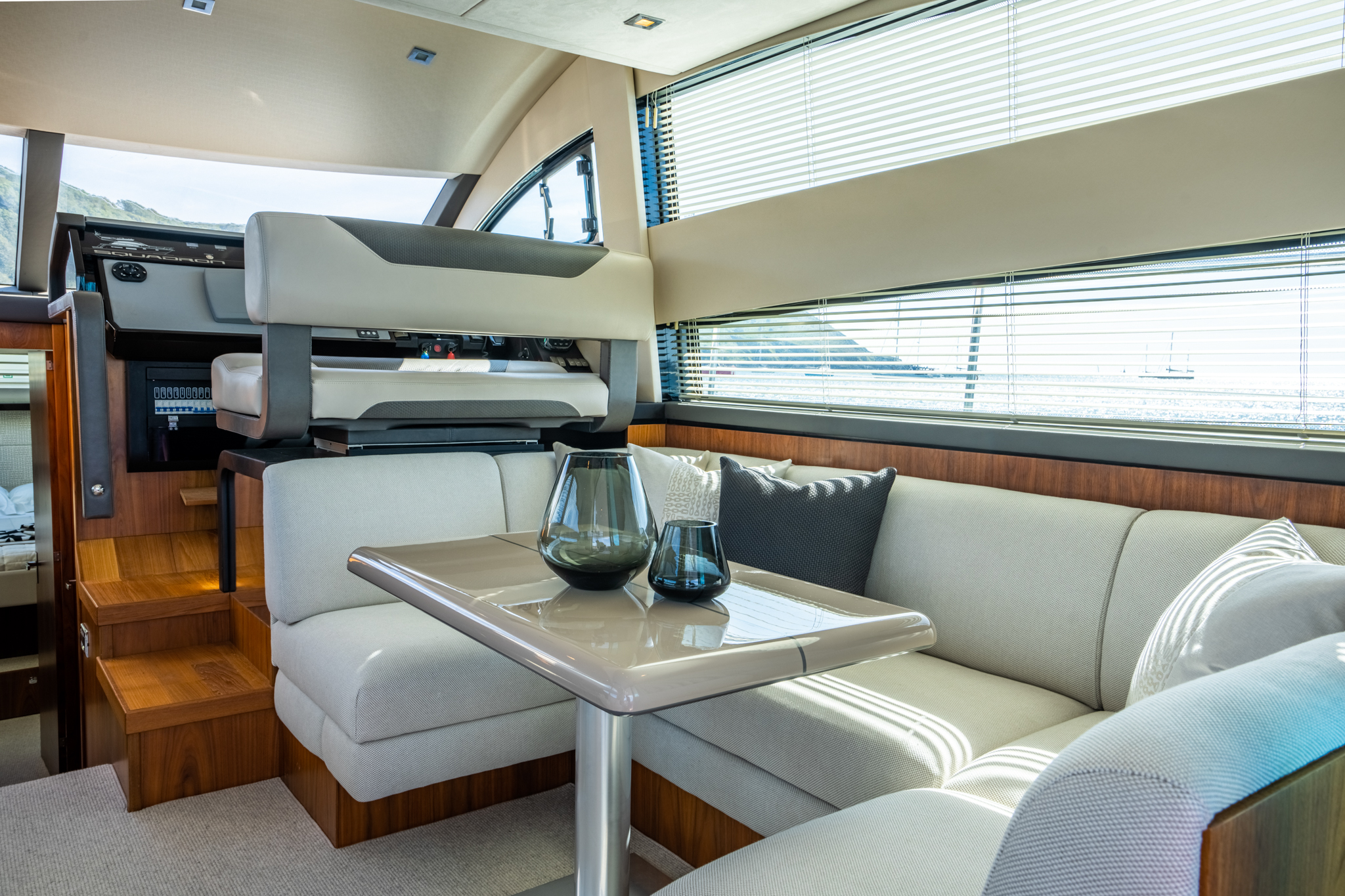
A Sustainable Transformation
We provide a beautiful level of service, offering luxury to the pre-owned market – ensuring that you are in control of your yacht’s refit at every stage. You get to sit down with one of the best interior designers in the business and work with them to create the yacht that you have always dreamt of, rather than simply making do with the pre-owned boats available, in the state that you find them.
In turn, we can make a very significant impact on the vessel for 10-15% of the boat value . So there’s a good economic answer for having a Setag design & refit, but a full, dedicated refit service simply hasn’t existed until now.
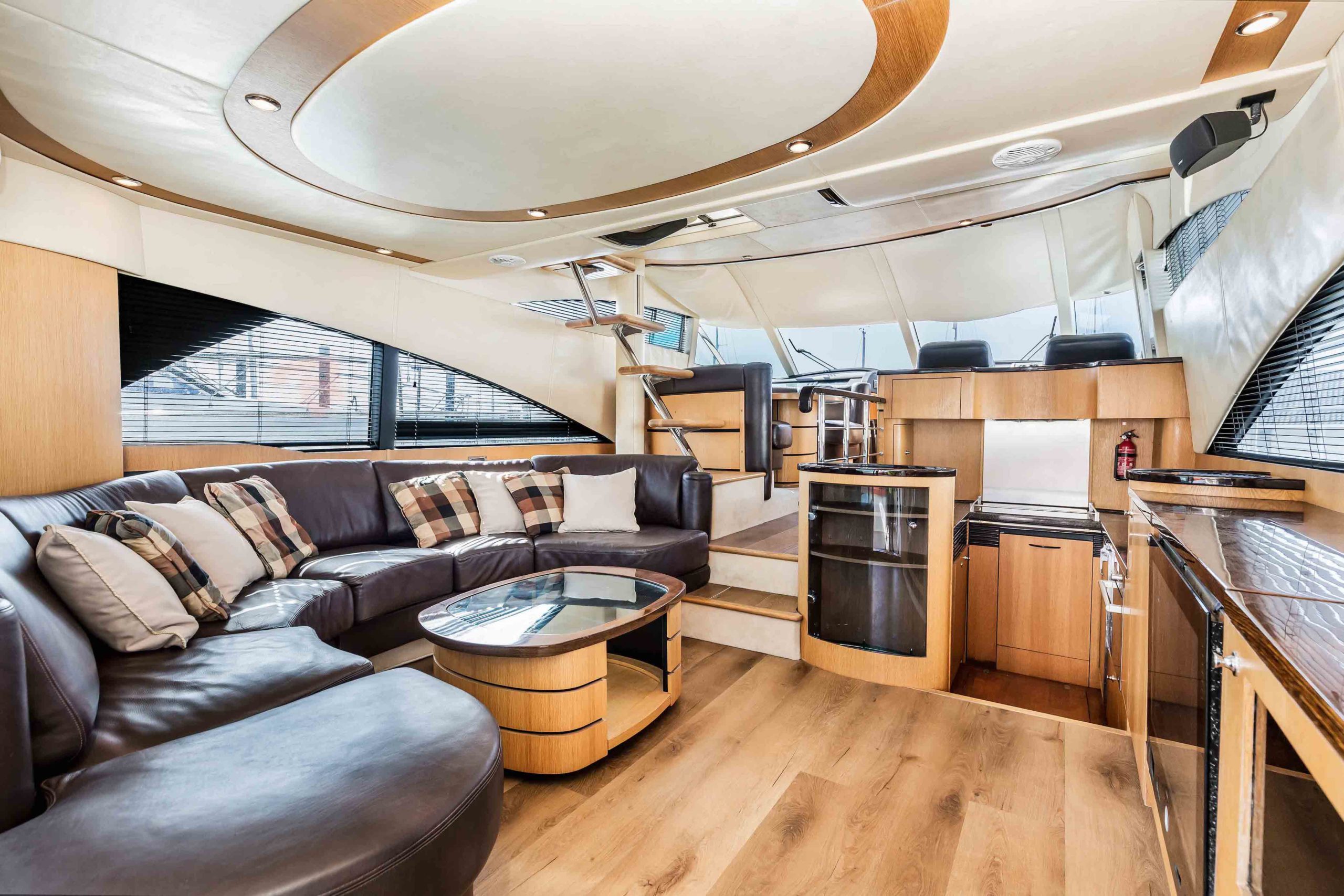
We’re ready to redefine, refit and remaster your yacht, according to your needs. Get in touch today to Realise the Art of the Possible.
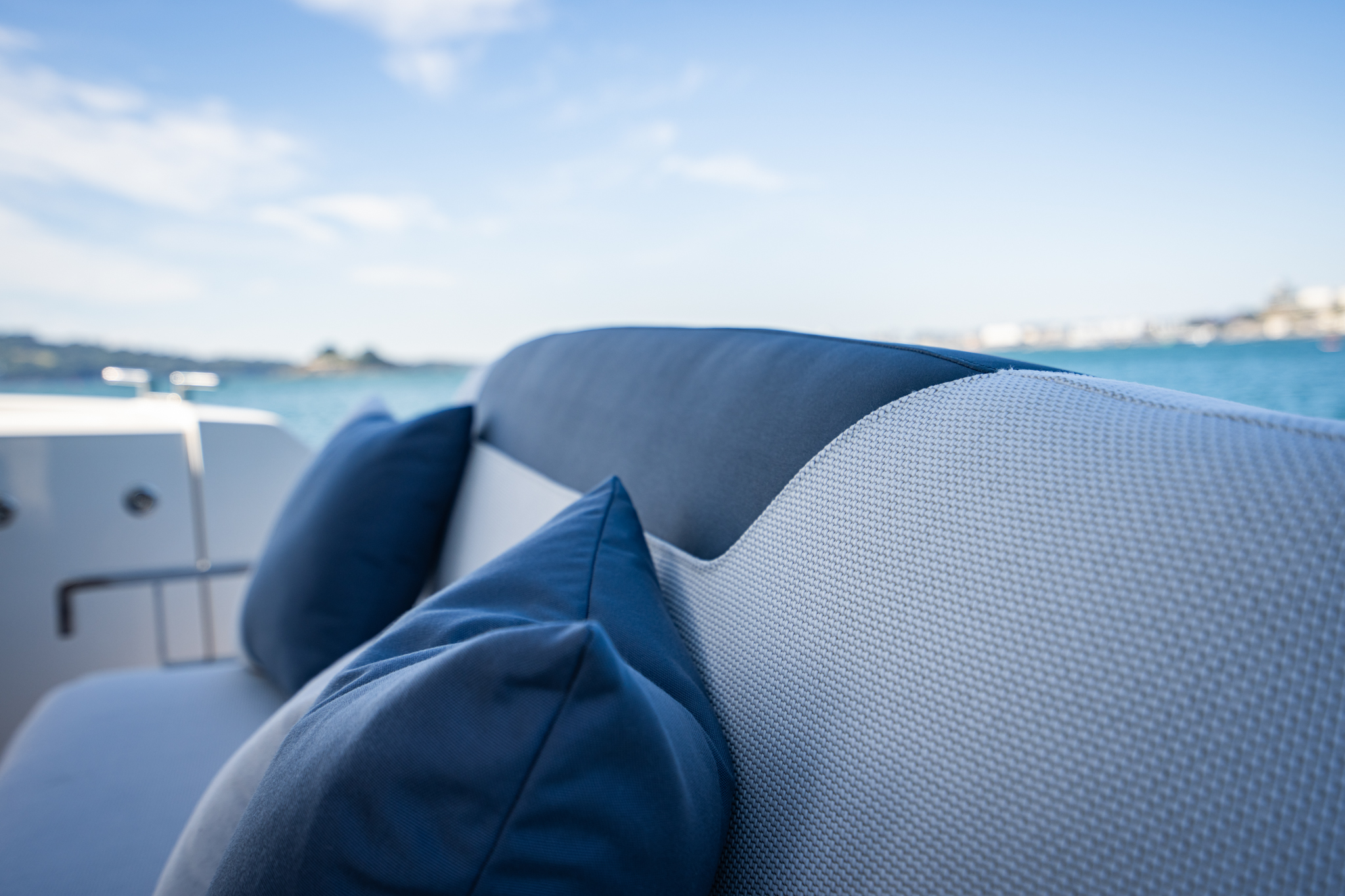
Redefined by Setag
Each project is truly bespoke, catering to individual needs. If you are moving into a new house, you naturally want to renovate to put your own stamp on it – to make it feel like your home. So, why would you be happy to live with someone else’s taste when it comes to your yacht?
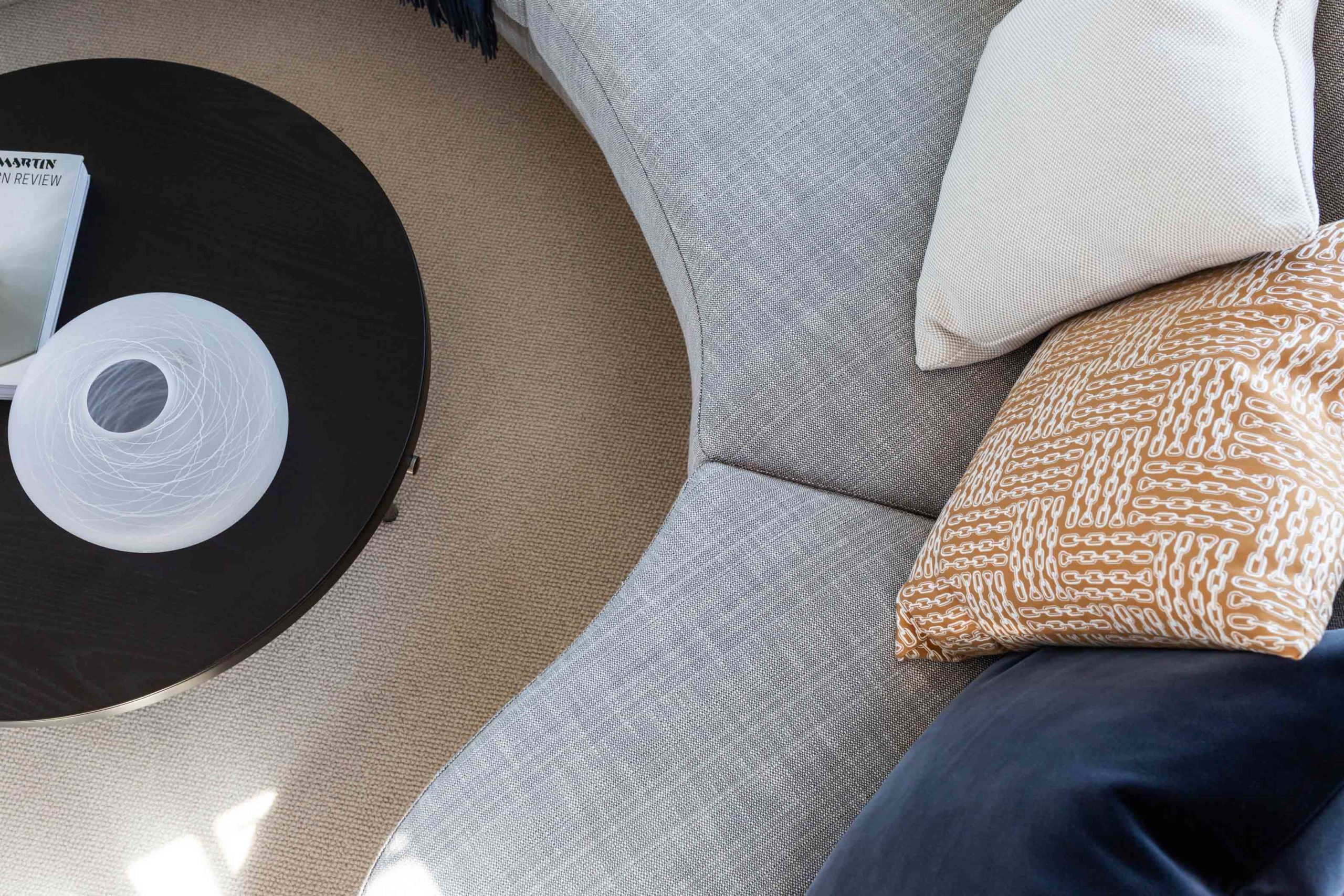

Yacht Refit
One of the most common questions we are asked by potential clients is what we mean exactly when we talk about offering a refit service for yachts. There is a false impression about yachts that they only require a refit if they are on their last legs and are barely seaworthy. This simply isn’t the case.
With SETAG, you can make a huge difference when you buy something secondhand, maybe a bit tired and then you put all of this beauty in it and you create what effectively is a brand new boat. Completely to your own liking, your own standard...creating the perfect boat for us.
Brilliant concept...new boat look and feel at pre-owned prices - by the industry experts. Recycling at its best!
The great thing is, none of this is off the shelf - I love this boat and now she’s got her frock on...this is the best money I've spent.
If you want to redefine, refit and remaster your boat who better to do it than the people who designed it in the first place? "What a fantastic idea!"
We cannot recommend the SETAG team highly enough. If you love your current boat, then for a fraction of the cost to change it, have it SETAG’d. The SY branding certainly helped us obtain a premium price. We got what we paid for her in 2017 plus what we spent with you!
I have worked with Chris for over 30 years and I’m pleased to see him develop his own brand - along with likeminded people with industry-leading expertise. The future is bright for Setag Yachts and pre-owned yacht owners, who can now refurbish their vessels to today’s - or even tomorrow's standards.
That has been one of the key selling points for us – having that personalised service and having a boat that is unique to us – is standout in its own right. We are pretty blown away…very very pleased. I think it’s fabulous…it has transformed the boat.
The perfect way to open up a new market: the "true reflection of luxury". Setag gets it: simplicity and personalisation are key – with the depth of knowledge to deliver.
Setag are probably the only company who can carry out all the tasks as a ‘one stop shop’. Other yards were reluctant to price work and needed to subcontract many tasks meaning higher costs and longer lead times. If you are in any doubt speak to Chris and his team, they know boats like no one else.
We have been waiting for this quality of service: a comprehensive, professional refit that we can rely on – because of the pedigree of its staff, with over 200 years' experience in our market.
You have put Princess magic into our beloved Broom.
Never have I come across a more able collection of professionals in this market. We have complete trust in Setag, since its team has been in the business for as long as we can remember. We're very excited to welcome this specialist refit company into our portfolio.
Testimonials
Don't just take our word for it...

- CREATE AN ACCOUNT
- Boat Cover Finder
- Bimini Top Finder
- Boat Propeller Finder
- Engine Parts Finder
- Anchor & Dock
- Watersports
- Clothing and Footwear
- Engine Parts
- Cabin and Galley
- Covers and Biminis
- Electronics
- Paint and Maintenance
- Pumps and Plumbing
- Anchor Chains & Ropes
- Boat Fenders
- Boat Mooring
- Boat Protection
- Dock Storage & Protection
- Ladders, Steps, & Platforms
- Top Sellers

- Fishing Rods
- Fishing Reels
- Fishing Rod & Reel Combos
- Fishing Tools & Tackle Boxes
- Fishing Line
- Fly Fishing
- Fishing Bait & Fishing Lures
- Fishing Rod Holders & Storage Racks
- Fish Finders, Sounders & Sonar
- Trolling Motors
- Fishing Nets
- Fishing Downriggers & Acessories
- Fishing Outriggers & Acessories
- Fishing Kayaks
- Fish Cleaning Tables

- Inflatable Rafts
- Paddle Boarding
- Paddles & Oars
- Wakeboard, Wakesurf & Ski
- Wakeboard Towers
- Tow Ropes & Handles
- Life Jackets & PFDs
- Snow Sports
- Roof Racks, Carriers, Dollies

Men's Clothing
- Accessories
Men's Footwear
- Atheltic Shoes
- Water Shoes
Women's Clothing
- Dresses & Skirts
Women's Footwear
- Fuel Systems
- Sacrificial Anodes & Zincs
- Generator Parts
- Inflatable Boats
- Propeller Parts & Accessories
- Boat Manuals
- PWC Parts & Accessories

- Fishing Boat Seats
- Offshore Boat Seats
- Ski Boat Seats
- Pontoon Boat Seats & Furniture
- Boat Seat Pedestals & Hardware
- Boat Seats by Manufacturer
- Boat Tables & Hardware
- Boat Seat Covers
- Boat Seat Vinyl
- Floating Boat Cushions

- Barbeque Grills
- Boat Drink Holders
- Cabin Accessories & Hardware
- Boat Ventilation
- Interior & Cabin Lighting
- Marine Teak Products
- Carbon Monoxide & Smoke Detectors
- Binoculars & Telescopes

Boat Bimini Tops
- Bimini Top Accessories
- Pontoon Bimini Tops
- Other Biminis
- RV & Trailer Covers
- Boat Shrink Wrap & Accessories
- Boat Shelters
Boat Covers
- Boat Cover Accessories
- Boat Lift Canopy Covers
- Other Covers
- Boat Wiring & Cable
- Marine Batteries & Accessories
- Marine DC Power Plugs & Sockets
- Marine Electrical Meters
- Boat Lights
- Marine Electrical Panels & Circuit Breakers
- Power Packs & Jump Starters
- Marine Solar Power Accessories
- Marine Electrical Terminals
- Marine Fuse Blocks & Terminal Blocks
- Marine Switches
- Shore Power & AC Distribution

- Marine Audio & Video
- GPS Chartplotters & Accessories
- Electronic Navigation Charts & Software
- Digital Instruments
- Display Mounts
- VHF Radios & Communication
- Marine Radar
- Auto Pilot Systems
- Action Cameras

- Fiberglass & Epoxy Boat Repair
- Boat Paint & Varnish
- Marine Adhesives, Sealant, & Caulking
- Marine Engine Maintenance
- Boat Cleaners & Waxes
- Boat Cleaning Supplies

- Fresh Water Boat Systems
- Bilge Pumps
- Marine Plumbing Parts
- Wash Down Pumps
- Livewell Aerator Pumps & Live Bait Wells
- Toilet & Waste Pumps
- Marine Pump Replacement Parts

- Tires, Rims, & Hub Kits
- Boat Trailer Winches
- Boat Motor Supports & Transom Savers
- Boat Trailer Guides & Rollers
- Boat Trailer Fenders
- Boat Trailer Lights
- Boat Trailer Hardware
- Boat Trailer Jacks
- Boat Trailer Brakes & Axles
- Boat Trailer Tie Downs
- Couplers, Mounts, Hitches, & Locks

- Boat Deck Harware
- Marine Nuts, Bolts, & Screws
- Boat Handles, Pulls, & Rings
- Prop Nut Kits & Hardware
- Boat Cabin Hardware
- Marine Fasteners
- Boat Windshield Parts
- Boat Tubing & Rails
- Boat Mirrors
- Marine Tools & Tool Kits
- Boat Lettering

- Women's Clothing Deals
- Men's Clothing Deals
- Fishing Deals
- Anchor & Dock Deals
- Electrical Deals
- Electronics Deals
- Paint & Maintenance Deals
- Pumps & Plumbing Deals
- Boat Seats Deals
- Trailering Deals
- Camping & RV Deals
- Dealer Login

- Forums Login

- Search forums
- Boat Repair and Restoration
- Boat Restoration, Building, and Hull Repair
Restoring boat costs
- Thread starter salmonee
- Start date Mar 8, 2010
Chief Petty Officer
- Mar 8, 2010
Isn't restoring boat more expensive than buying one in descent shape? If you love working on boat, that's fine. Who goes out of their way on purpose, to buy a piece of junk just to put $ and time into it? Just seem like it would cost way more $$ than buying one in descent shape.
HopeSheFloats
Lieutenant commander.
Lieutenant Junior Grade
Senior Chief Petty Officer
Re: Restoring boat costs I'm fairly certain my rig will be worth approximately twice what I have into it when it's complete. Doing this sort of project is not for everyone. At times it seems there is an element of self-masochism involved in restoration projects, but if you stick with it and do it right, it can be quite rewarding.
Petty Officer 1st Class
Re: Restoring boat costs my bud bought a new 16' skiff, mtr, trailer bout 15k, i have a 1978 hull 1989mtr and trlr, will put it toghether for 1/3 his cost, and be able to do all he can. plus ill have the satisfaction mine will last longer than a new boat when im done D
Supreme Mariner
Re: Restoring boat costs I'll probably have $5k in mine when it's all said an done. A new one reasonably equivalent would be over $20k. I don't have that.
ezmobee said: I'll probably have $5k in mine when it's all said an done. A new one reasonably equivalent would be over $20k. I don't have that. Click to expand...
Re: Restoring boat costs People like restoring because it gives them a chance to change what they don't like.. Erikgreen for example is redoing his to fit his needs.. another guy wants to change his fishing boat to a family boat.... and like stated its a passion doing this and its the satisfaction at the end of a long day and looking at it come together and saying to yourself.. i made it look like that
salmonee said: Isn't restoring boat more expensive than buying one in descent shape? If you love working on boat, that's fine. Who goes out of their way on purpose, to buy a piece of junk just to put $ and time into it? Just seem like it would cost way more $$ than buying one in descent shape. Click to expand...
thrillhouse700
Re: Restoring boat costs I'm scared to total all the costs up. I looked locally at a 18.5 foot aluminum with an outboard 42,000 Even if I'm at 10k when I'm done with a rebuilt motor, leg, all new interior and paint then I'm of with that in comparison. I would definately been willing to pay more for a restored boat from the guys in this forum knowing what went into the restore.
Silverado6x6
- Mar 9, 2010
Re: Restoring boat costs Well I was wondering the same thing but on a bigger scale, for the most part I really have no intention of cruising around spending $200 an hour on fuel, I'm looking for a project in my golden years before I retire, I can do absolutely any repair needed, I am a certified diesel mechanic up front and I do work recently of hull restoration, so I have my eye on these two boats, the 61' is basically a shell, its big, would make a great liveaboard vessel, but to make it seaworthy would require over $100k, the second boat the 53' is a little older, its in running shape, needs a thorough inspection and some minor repairs but is ready to move around, in bristol condition these are reliable sturdy vessels that sell well. I would buy the 61' immediately because its probably open for a lower offer, the 53' is in the water, would require insurance and a dock, the 61' is on the hard so its not requiring much in upkeep, again the 53' is almost ready to go but at a higher initial cost and an immediate attention to moorage and such, myself I would like to have the 61', sure its going to be an anchor to me financial wise for who knows how many years, but like it is its all I have looking ahead of me, I just need something for a goal as I am 53, I have been there and done that, now I just want to relax a bit but still stay busy. http://www.yachtworld.com/boats/1982/Hatteras-Motoryacht-2170248/Gibsonton/FL/United-States http://www.yachtworld.com/boats/1973/Hatteras-53-Motoryacht-2182835/Tampa/FL/United-States
Re: Restoring boat costs I suppose it all depends... If you were to pick up a junk boat and then paid somebody to restore it, you'd be upside down in a half a second! I think if you are wise about spending your money, willing to work really hard, a bit of a scavenger, a cross between a redneck and a yankee, already own a bunch of tools, efficient and effective at using duct tape, good looking (or not, either way works) can sift out the great deals from the on craigslist, snipe on eBay, a carpenter/welder/marine tech/engineer/painter/plumber/tradesman (or a least a couple of those), a good husband (or at least a good liar but I wouldn't recommend that, and no, you can't be both) or have a good buddy that is all of these things, than you should be in great shape! Yah, I don't think it's for everyone. As I see it, when I am through, I should have a boat that is every bit as good as any $8000ish used rig that is out there and I won't spend even a fraction of that. Shoot, new rigs are around the $40K mark! I am way too poor for that! Cheers!!!
proshadetree
Re: Restoring boat costs I like working on stuff.I have 2500 in my baylinner. I could sell it for 3 to 4 thousand. Maybe more if you found a buyer that wanted a known solid boat. Now I have saved 500 dollars if you look at the market. But I have a tank that will take all I can trow at it. I wont go out twice only to find my transom or floor is rotten. My boat looks great in the water and waxed a few new rides last year. If you cant afford a new boat and want the reliability of one build it. Now if you want a cheap boat look on this board and find one someone has build in a reliable fashion. Wait till they find their next boat and jump on it. It will still cost more that some but you know its built right.
Re: Restoring boat costs jones, i could have stacked boats in my backyard a few years ago after our 3 hurricane year, have buddies in the transport business would take them to a surverors yard, if they were deemed totaled to the dump the went, i skavenged, parts for the rest of the year, have a 5 gallon bucket full of screws nuts and bolts another with deck hardware, also my livewell deck and console came out of one of these. if you are creative you can even avoid cl and ebay. im shoting for under 3k in mine but we know how boat budgets go. D
- Mar 10, 2010
Re: Restoring boat costs It normally does cost more to fix one up than to buy one in working condition and when you sell it you rarely get back even close to the $$$$$ you have into it and that doesn't include the hours spent working on it. If you look on CL you frequently see older boats that have everything rebuilt with lots of extras going for very little money. So money wise it rarely pays off. There are a few brands and models that it can pay to restore, they may be good boats, or it may just be a perception of quality that creates the following, but the vast majority of hulls have little value after a decade or two. After saying that, I too will pick up a boat that needs time and money to get back on the water and make it usable again, I don?t do it thinking it will be worth money though, it may just fit a need I have at the time. Some of these are given away after having not been used in years. I think I have seven boats here right now and only two have been used in the last year. I will be picking up a boat from my mom this week that will need to be given away. She lives on the water, but at 90 she said doesn?t want to go out and check crab pots anymore. A couple of years ago she gave me her chainsaw, said she was tired of burning wood.
single outrigger sailboat
- The Proafile Primer
08 July 2014 Editor 0 Comments.
GALLERY | Click images to enlarge
The illustrated glossary of bilaterally asymmetrical sailboats.
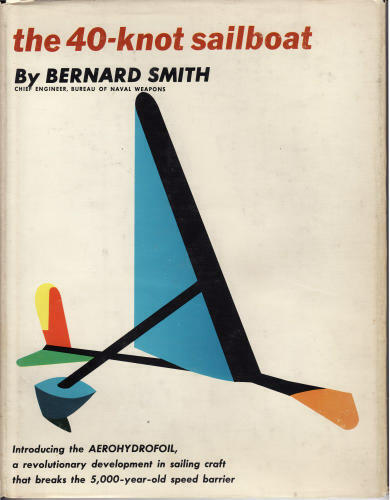
ama Polynesian for outrigger float or log, in common use among multihull designers.
aka Polynesian for outrigger cross beam.
“It is hard for one who has been accustomed to traditional naval architecture to think straight about the outrigger canoe. We in the West have always thought of a boat as bilaterally symmetric along a fore-and-aft centerline, that is, one side is supposed to be the mirror image of the other. The outrigger canoe, with its strange appendage jutting out to one side, supported on its outer end with a smaller hull or a float, plainly violates this principle. I have heard people who should know better speak of the outrigger as an asymmetrical craft, but it really is not. The sailing outrigger canoe is just as symmetrical as our boats, but the axis of symmetry has been rotated ninety degrees. Stand on the outrigger side of one of these canoes that has been correctly built and you will see what I mean. It is the two ends, rather than the two sides, which are exactly alike. These identical ends serve alternately as bow and stem, and the outrigger is always on the windward side when the boat is under sail. Not only are these boats symmetrical, but that symmetry has a certain relation to the direction of the wind, and what could be more logical in a sailing craft?” Euell Gibbons The Beachcomber Afloat

AYRS Amateur Yacht Research Society. Founded in 1955, the AYRS boasts members from around the world, both amateurs and professionals. The society prints books and journals filled with research on all matter of sail craft, from hydrofoils to kite rigs. AYRS members have experimented with the proa form for decades, and have a searchable index of all proa articles. If you think you have a great new proa idea, better check the AYRS index first.
AYRS sail See Bolger rig .
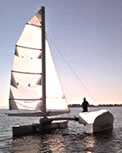
Bolger proa rig (AYRS Sail) Designed by small boat designer Phil Bolger. This sail echoes the rotated 90 degree symmetry of the proa, in that it has an interchangeable leach and luff, and dedicated windward and leeward sides. Bolger writes:
“The battens and boom are permanently curved. For a proa, it is most appropriate to change ends, letting go the taut tack downhaul and hardening down on the other. The one not acting as a tack downhaul serves as the sheet. The sail is pivoted around the axis from the tack downhaul up to the head. Four-fifths of its area is abaft this pivot axis, so it will luff reliably (unlike a squaresail) when its sheet is started. It does not pivot on the mast and is attached to the mast only by the halyard." Boats with an Open Mind International Marine, 1994
Because of its obvious appeal, the Bolger rig has been tried by several proa experimenters - however so far, practice has not lived up to theory. Read Rig Options: The Bolger Rig
caught aback Being "caught aback" is what happens when the wind accidentally comes from the wrong side of the boat. This canbe either completely traumatic and lead to a capsize, or it can be a non-event, depending upon what sort of rig design the proa uses.
counterpoise See lee platform .
The crab claw rig has been tested in a wind tunnel by the famed aerodynamicist C. A. Marchaj:
"Even more startling is the extraordinary performance of the crab claw sail… which demonstrates its superiority to a Bermuda mainsail right from the close-hauled condition. Its superiority increases when the boat bears away, and on reaching, with the heading angle 90 degrees, the driving force coefficient of the crab claw rig is about 1.7, whereas that of the Bermuda rig is about 0.9. That is, the crab claw delivers about 90 per cent more driving power than the Bermudan rig." Sail Performance International Marine, 1996
The modern scientific validation of the crab claw has sparked new interest in this ancient sail form. Read Rig Options: The Crab Claw
flying proa Term used by European navigators to describe the indigenous sailing canoes of the Marianas island chain.
"More than those of any other island group, the sailing craft of the Marianas Islands, by reason of their swiftness and elegance, riveted the attention and aroused the admiration of every navigator who had the good fortune to see them. Their large sailing canoes came to be known as "flying proas" and one of the early names of the archipelago was "Islas de las Velas" from the great number of sails seen passing to and fro between the islands." Haddon & Hornell Canoes of Oceania Bishop Museum Press, Honolulu, Hawaii
"triangular in shape, with a long, light bamboo yard permanently fastened along one edge of the sail. A stout bamboo mast was stepped in the very center of the main hull, right on the sidewise axis of symmetry , and stayed in place with clothesline wire and turnbuckles. The sail was hoisted up the mast by a halyard attached to the exact middle of the yard. The end of the yard that would be the forward end on the first tack was pulled down and fastened to what would be the forward deck on that tack, making the yard rise diagonally up and aft, the after end projecting behind and above the top of the comparatively short mast. The sheet, the line with which the sail is handled, was fastened to the corner of the triangle opposite the yard, and led through a block on the afterdeck." Euell Gibbons The Beachcomber Afloat
This rig is receiving new attention from several proa developers lately, most notably Gary Dierking. Read Rig Options: The Gibbons Rig
iako arched crossbeams which fasten the floater (ama) to the hull of a Hawaiian outrigger canoe. On the web: Hawaiian canoe parts .

lee platform (counterpoise, lee pod) A platform that cantilevers out from the leeward side of the hull on Marshall and Caroline island proas. It is angled up away from the water, so that waves will not hit it while sailing. It is used to carry people and cargo, and ads auxiliary stability in the event of a knockdown. Some modern proas have enlarged the lee platform to allow more interior volume, and to create buoyancy to leeward that aids in capsize recovery. It is theoretically possible to design a lee platform that will allow the proa to self-right from a 90 degree capsize.
lifting rig Term used to describe a sailing rig that creates an upward aerodynamic force as well as a forward one. Traditional proa rigs are lifting rigs, and may help explain the reason for the proa’s legendary speed.
log See ama .
Micronesia Ethnographic area of Oceania north of New Guinea and east of the Philippines comprised of the Federated States of Micronesia, Republic of the Marshall Islands, Republic of Palau, Kiribati, and Guam. It is here that the Oceanic sailing canoe reached its highest development.
ndrua Fijian voyaging canoe that was the largest and finest craft ever built by the Oceanic peoples, some as large as 100’ long.

outrigger canoe A canoe type found throughout the South Pacific and Indian oceans, stabilized by a small float or log that is held alongside and parallel to the canoe hull by a connective structure of a certain length. All proas are outrigger canoes, but not all outrigger canoes are proas.
Pacific proa A term created to delineate the traditional, outrigger to windward proa type from the modern Atlantic proa derivation.
popo Sailing canoe of the Caroline islands.

A traditional proa consists of a very slender canoe hull, often with a sharp keel and side-to-side asymmetry. Power to carry sail is derived from a heavy log slung parallel and to windward of the hull by an often elaborate system of beams and struts, all lashed together with twine. Motive power is a large Oceanic lateen or crab claw sail rigged to a pivoting mast that is stepped upon the canoe hull. Steering is via an oar or paddle, and as has more recently come to light, via weight shift of the crew. All proas are symmetrical end-to-end, and asymmetrical side-to-side, or opposite to all other sailing craft geometry. The outrigger is always kept to windward to oppose the overturning force of the sail, and is often kept flying above the water’s surface.

Parts of a Micronesian Proa
- Outrigger platform (aka)
- Outrigger float (log, ama)
- Hull (vaka)
- Lee platform (counterpoise)
- Spilling lines
Modern Western proas may be rigged identically to the traditional version, or more commonly, employ western style rigs and rudders, as well as modern materials and construction techniques.
riak Micronesian for shunt.
rudder An extremely useful invention unknown on native proas. Much creative thought by modern proa experimenters goes into adopting the rudder for use onto a shunting sailing canoe.
This arrangement puts the center of lateral resistance aft, which is where it happens to balance the aft location of the schooner rig’s center of effort. The forward board can be adjusted to fine tune the balance, for self-steering.
Contrast this arrangement with the Oceanic proa, which places the sail in the extreme forward end of the canoe, and uses no boards or rudders. The deep, sharp keel of a flying proa has the center of lateral resistance forward of the athwartship centerline, so the forward rig naturally lines up the rig and hull forces to maintain balance.
steering oar Micronesian canoe sailors use an oar for downwind steering courses, when the sail creates too much weather helm for weight-shift steering to be effective. Read The Case for the Steering Oar .
te puke (tepukei) Voyaging canoe of the Santa Cruz islands. These canoes exhibit some of the most fascinating geometry of all the south pacific sailing canoes.
vaka Polynesian for canoe.
wa’a Hawaiian for canoe.
waka Maori (New Zealand) for canoe.
wa lap Sailing canoe of the Marshall islands.
weight-shift steering Traditional proas are steered on all reaching and windward courses with no rudder, paddle, or steering oar at all. Steering is achieved in a similar way to the rudderless windsurfer, by adjusting the relative fore and aft positions of the sail center of effort and the hull center of lateral resistance. Rudders are problematic at best on a proa, and the Oceanic solution is to simply not need them. Doing away with rudders also does away with vulnerable underwater foils, and removes the hydrodynamic drag of the rudder, which is considerably greater than its small surface area would suggest.
weight-to-windward proa (W2W proa, Harryproa™) A recent variety of Pacific proa that positions most of the weight (crew, accommodations, stores) in the windward ama - to create the greatest possible righting moment for a given displacement.
Adjusting the lateral resistance to steer is essentially what the Micronesians do as well, and this canoe shows another way to go about it. See also: leeboard , weight-shift steering .
Proas
Make a Comment
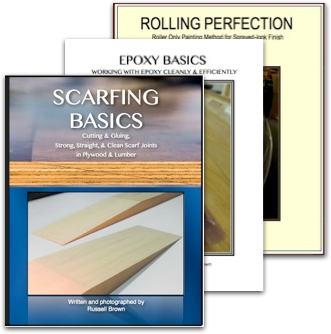
E-Books by Russell Brown
Russell Brown's boat building series will soon become your favorite shop tool
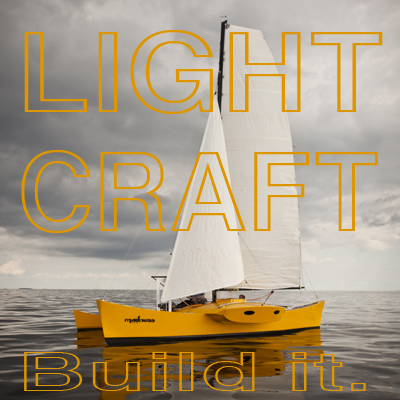
Featured Articles
- Proa Rig Options: the Biplane
- Proa Rig Options: Overview
- Proa Rig Options: Crab Claw
- Proa Rig Options: Gibbons Rig
- Proa Rig Options: The Sloop
- Proa Rig Options: Bolger Rig
Recent Comments
Hi this looks very proa-like but when I go to look at Google…
- 13 Feb: Not on Bing either sadly. Topher Dawson
- 13 Feb: Alas, Topher, the proa is indeed gone. I can't imagine such a… Editor
Hello, I have discovered something! Go to the site on Bing Maps…
- 14 Feb: Good catch Fulgencio! The Bing image is quite a bit higher… Editor
Goggle Earth has a history feature. Craft was there 8/2020 Hello All! I am new to this exciting world of exotic Proa craft… You asked, I answered. According to contemporary newspaper… Hi Skip, Sorry, I’ve got a ton of questions because I really… I’m interested in your balanced lug schooner rig. It appears… It dawns on me that this is a new type of proa; one deserving of… I’m trying to find information on the result of the race. Where… That last photo on the list there is a fascinating one. You… If what you're doing is like the things you read about here - please write and tell us what you're up to. We're easy to reach right here .Do you have news for us?
Sites of Interest

James Wharram Designs
Search Our Site
- Self Build Boats
- Professionally Built Boats
- Choosing a Boat
- How We Design
- Photo Gallery
- Video Gallery
- Articles & Blogs
- Wharram World
Lessons From The Stone Age Sailors
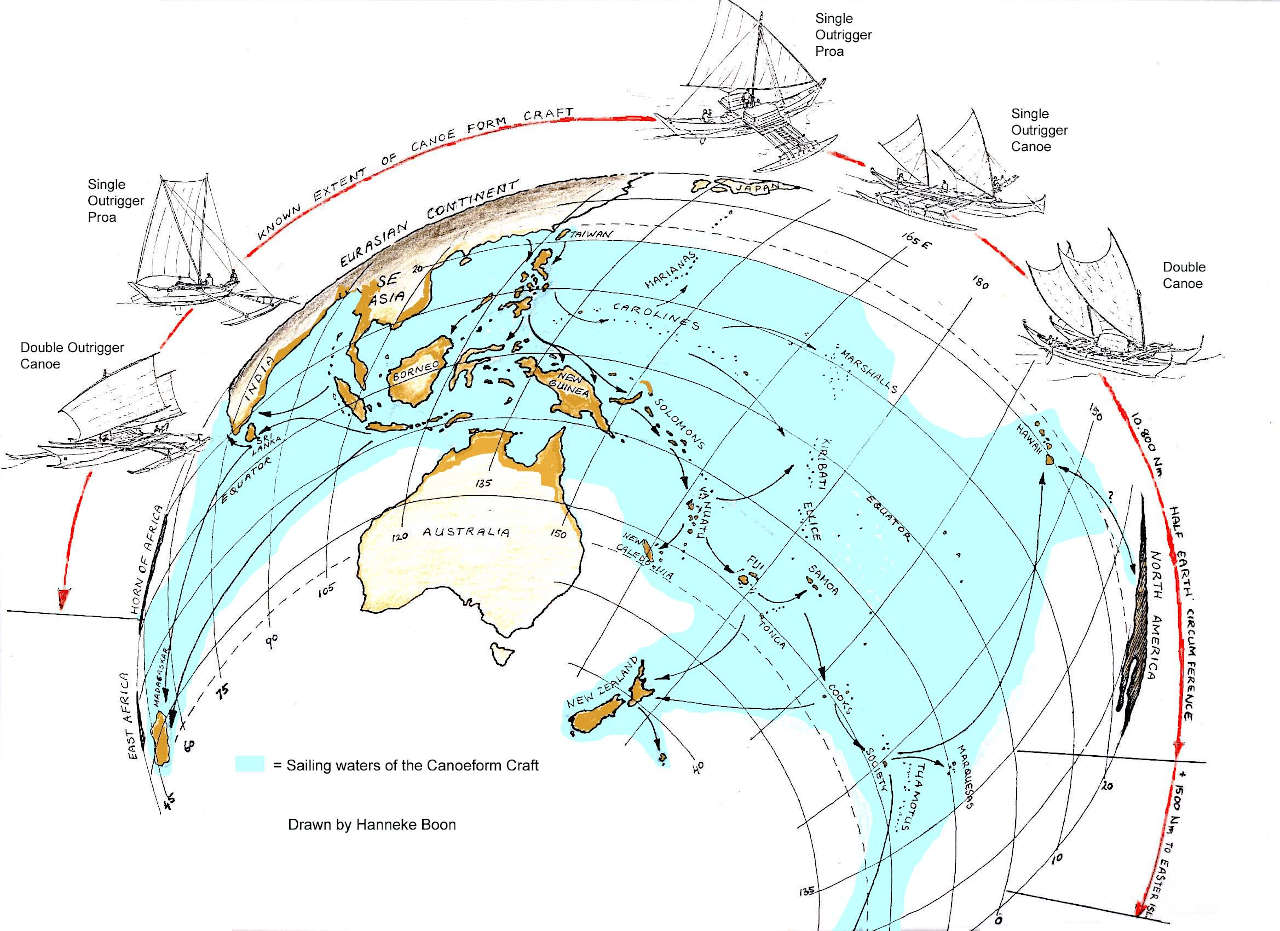
In February 1998 an interesting debate held at the Royal Lymington Yacht Club with the motion: "This house believes that the future of cruising yachts are the fast, light displacement boats that are fun to sail and that are seaworthy. "
At this public debate the two sides of british yacht designers had gathered, the extreme 'modern' and the more traditional designers. The term 'Light Displacement Boat' was meant to mean the highly expensive modern monohulls with deep fin keels and tall, high tension masts. "and that are seaworthy" shows that the proposers consider some modern light displacement boats lack seaworthiness.
In general, the phrasing of the motion implied a disappointing lack of knowledge of the world's sailing craft, for seaworthy, light displacement cruising craft - coastal and ocean - have been around for thousands of years and have been, and are being, adapted for present day sailors.
The Viking ship was a light displacement craft, and modern descendants of such craft, like the Norwegian fishing boat the 'FEMBORING' or some of Ian Outrecht's excellent Viking era style craft are "fun to sail" and like FEMBORINGs are seaworthy craft.
Long before the Viking ship era, 800 - 1100 AD, - long, long before that, about 10,000 years ago at the end of the Ice Age - fast, light displacement Canoeform Craft, started migrating out from areas around Taiwan (long before Chinese settlement) and continued from Indonesia across oceans against prevailing winds to eventually settle Hawaii, New Zealand and across the Indian Ocean to Sri Lanka, South India and Madagascar (which is just off Africa) - see the chart .
This ocean wide settlement of over half the world's circumference - took about 8,000 years ; 8,000 years during which the principles of the Canoeform light displacement sailing ship evolved not by 'Regulations' but in the organic way of a living creature like a seal, dolphin or seaotter - their evolution speeded up by the minds and wishes of practical sailors.
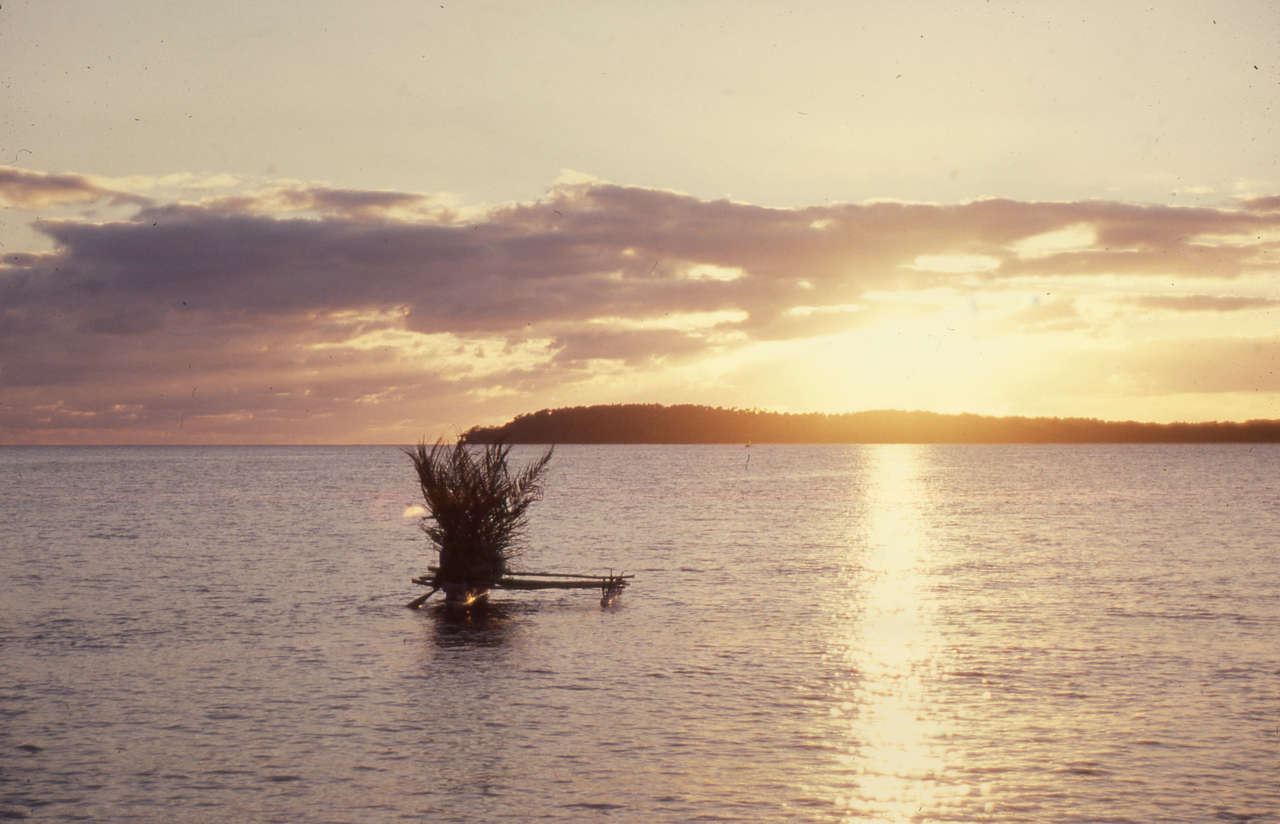
The First Sailors
This school of practical sailing design has existed longer than most people realize. The latest palaeo/anthropological studies of the evolution of humans show that the island of Flores in Indonesia was 'settled' 800,000 years ago. Flores has always been an island and the 'settlers' must have travelled by watercraft to get there. However, Man, Homo Sapiens, you, me, Asiatics, Africans and the rest of the present day world population have only evolved out of Africa in the last 100,000 years!! (This is the majority opinion, disputed by a few Asian Anthropologists). Therefore, watercraft of some sea survivable type were being used by what has so far been popularly presented as the semi animal/pre human Homo Erectus some 700,000 years "'before"' the Homo Sapiens species developed!!
There is a less arguable later date of the settlement of Lombok from Bali 250,000 years ago, but again 150,000 years before our ancestors walked out of Africa. The evidence shows seagoing watercraft existed before 'Man' existed!! Homo Sapiens only settled Australia by watercraft 60,000 years ago.
Archaeological evidence shows the next wave of modern Man spreading and migrating out of the Eurasian Continent from the end of the Ice Age 10,000 years ago, not by foot but by sea-going craft. (Whether they would have been allowed to do it under the proposed 'Recreational Craft Directive' is highly doubtful). For interest, the first wheeled land vehicles were only invented about 6,000 years ago.
Small boat sailing is so old, it is a deep, instinctive part of our behaviour pattern like throwing a stone (inherent in cricket, football, tennis and other ball sports) wishing to light fires or find peace in the quiet sound of moving water. It is the reason for the world wide Classic Boat revival in recent years. Readers of this magazine and others like it, have an 'instinctive' feeling that something has got lost in recent sailing craft and sailing attitudes. Our ancient sailing history explains the roots of their instinctive feelings.
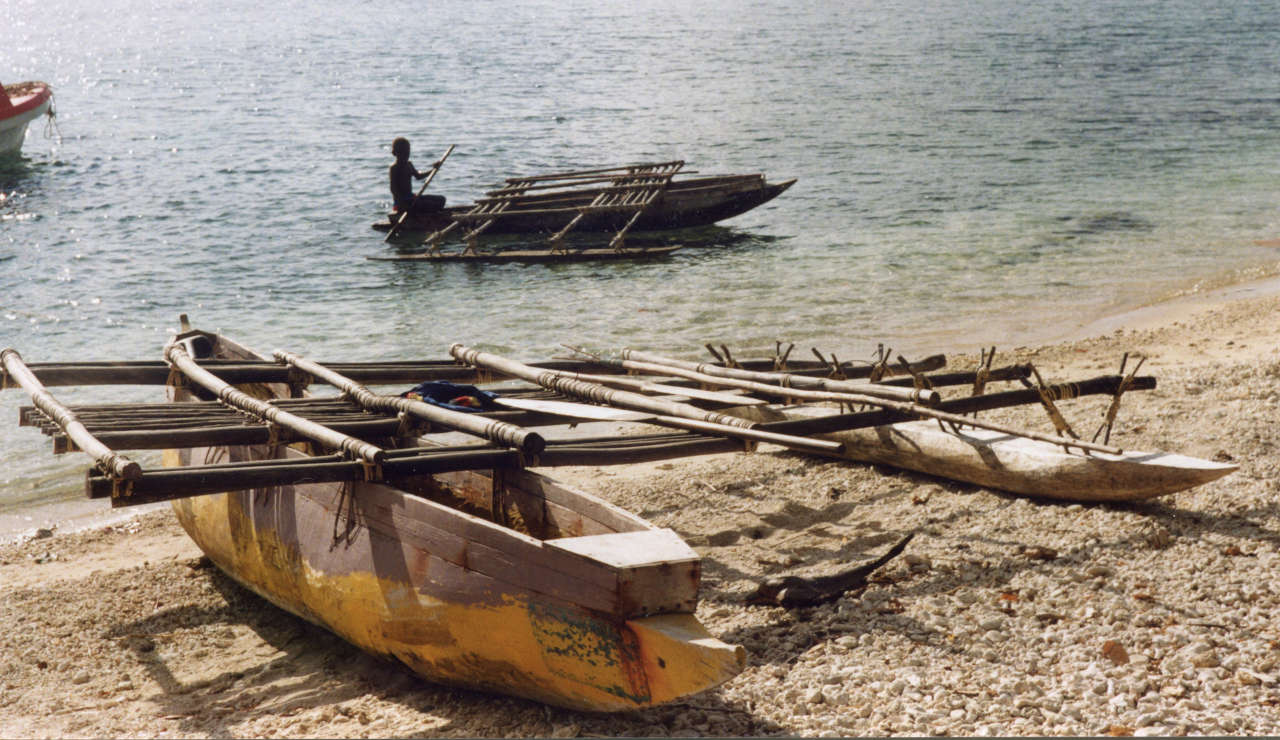
As most of urban man are in in-debt slavery to a life mortgage to buy their house, modern yachts that cost as much as their home are no longer affordable to a major group of would be sailors.
One reason for the expense of modern yachts, multihulls or mono, is that they are increasingly designed to accommodate the body comfort and mental attitudes of soft urban Man.
Some rare souls like Frank and Margaret Dye adapted their bodies and mental attitudes to the sea (as all sea-going people until relatively recently) and with minimal expense have sailed their 16ft. camping WAYFARER around Europe through fine weather and foul to experience the joy of becoming 'People of the Sea'.
In 1997, Rory McDougall completed a round the world voyage on a Wharram 21ft. TIKI. He, too, as described in his articles, adapted himself to the sea.
On many Oceanic archipelagos in the ancient Canoeform World, suitable stone for tools was in short supply, suitable boat material either hard to work or again short in supply. However, with determination these past Sea People developed with minimum materials and tools, craft that could sail fast, ride out ocean storms and land, when necessary, on open beaches. Their craft were simple and practical , single outrigger canoes, double outrigger canoes and the double canoe, depending on available material and the waters they sailed on. They were the ultimate 'Sea People', who had completely adapted themselves to a life on the ocean.
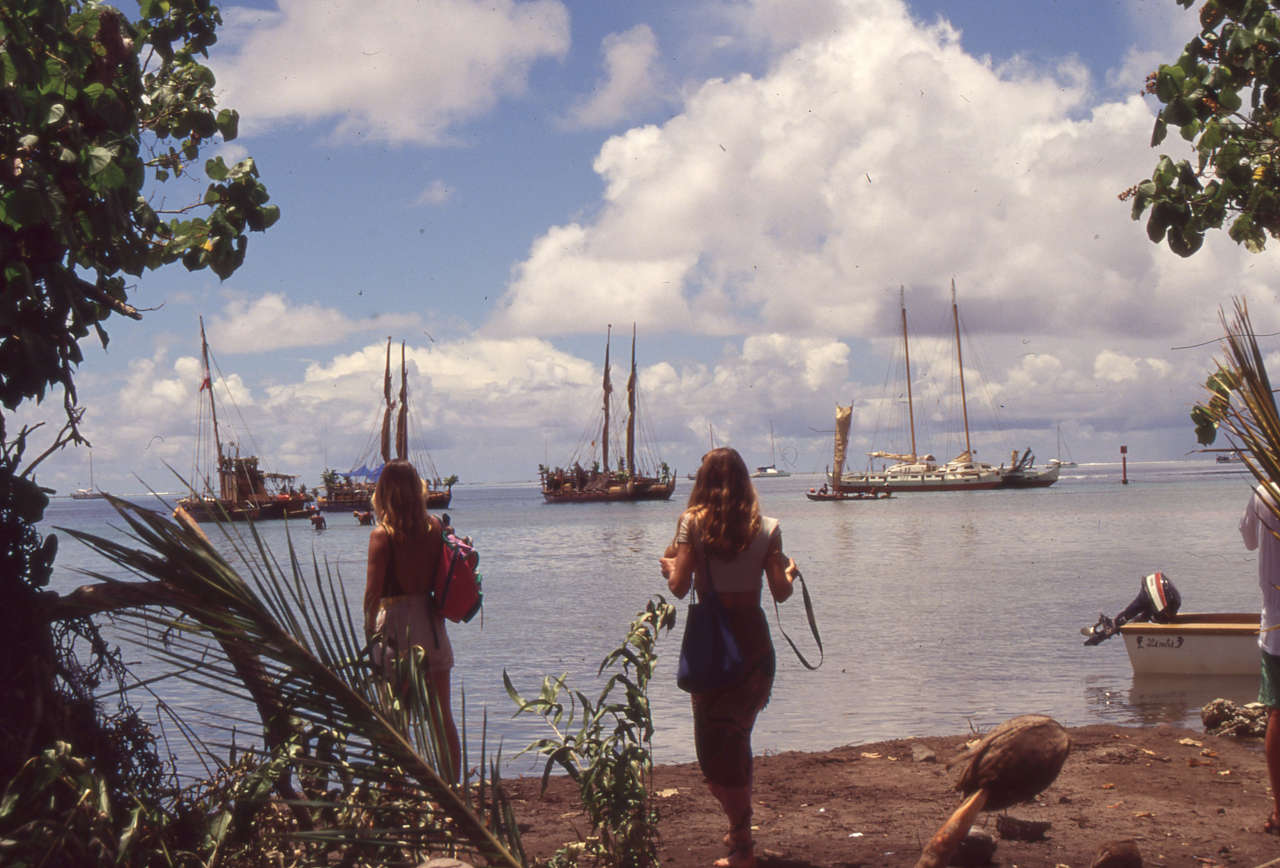
Canoeform Craft
For four years, my partner, Hanneke Boon, and I with a number of interested sailors have been sailing in the Pacific and Indian Ocean aboard our double canoe/catamaran, the 63ft. 'SPIRIT OF GAIA', studying the last surviving Light Displacement Canoe ships of this great first chapter of Man's sailing history.
Hanneke's chart and Fig. 1 - 4 show what we mean when we write 'Canoeform vessel', the main canoe ships that explored the Pacific and Indian Oceans.
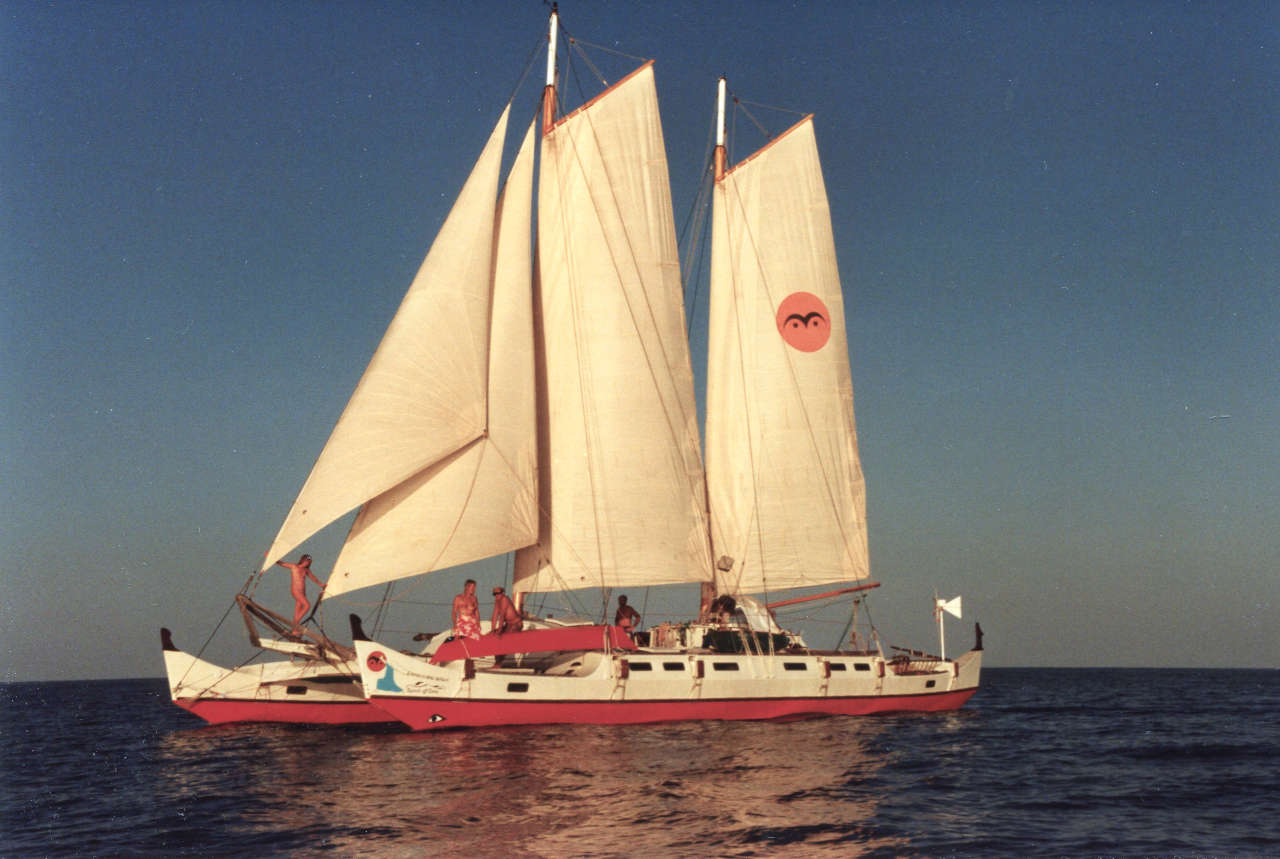
I have a replica collection of stone hand axes, available to Man 60,000 years ago which look like crude broken stones with sharp edges. However, with them you can cut bamboos or reeds to make a sturdy, seaworthy raft, or you can skin the bark of a large tree to make a short lived, delicate bark skin canoe, but the Dugout Canoeform Craft needs better woodwork tools.
By 30,000 years ago, Man had a kit of stone tools that could duplicate the work of the steel tools of this century. A stone adze, which I saw in use in New Zealand was sending the chips flying at the speed of a modern steel adze.
The 'Dugout' was a natural progress from the bark canoe and is often wrongly seen as the crudest form of boat built. A natural 'tree' log is an ideal structural material that can be subtly shaped and is free from leaking (unless you find a bad log). Some modern yachtsmen are gluing hundreds of strips of wood together, i.e. 'Strip Planking', to get the quality of wood construction inherent in developed carved dugout hulls."'
When big trees are not or no longer available, you have to develop planked canoe hulls. Sewn or lashed together planked hulls were used all over the world. The sewn boats that have survived in the Pacific and Indian Ocean until today show the strength and durability of this plank joining method and its suitability for hard long distance sailing, though like all planked boats they can leak.
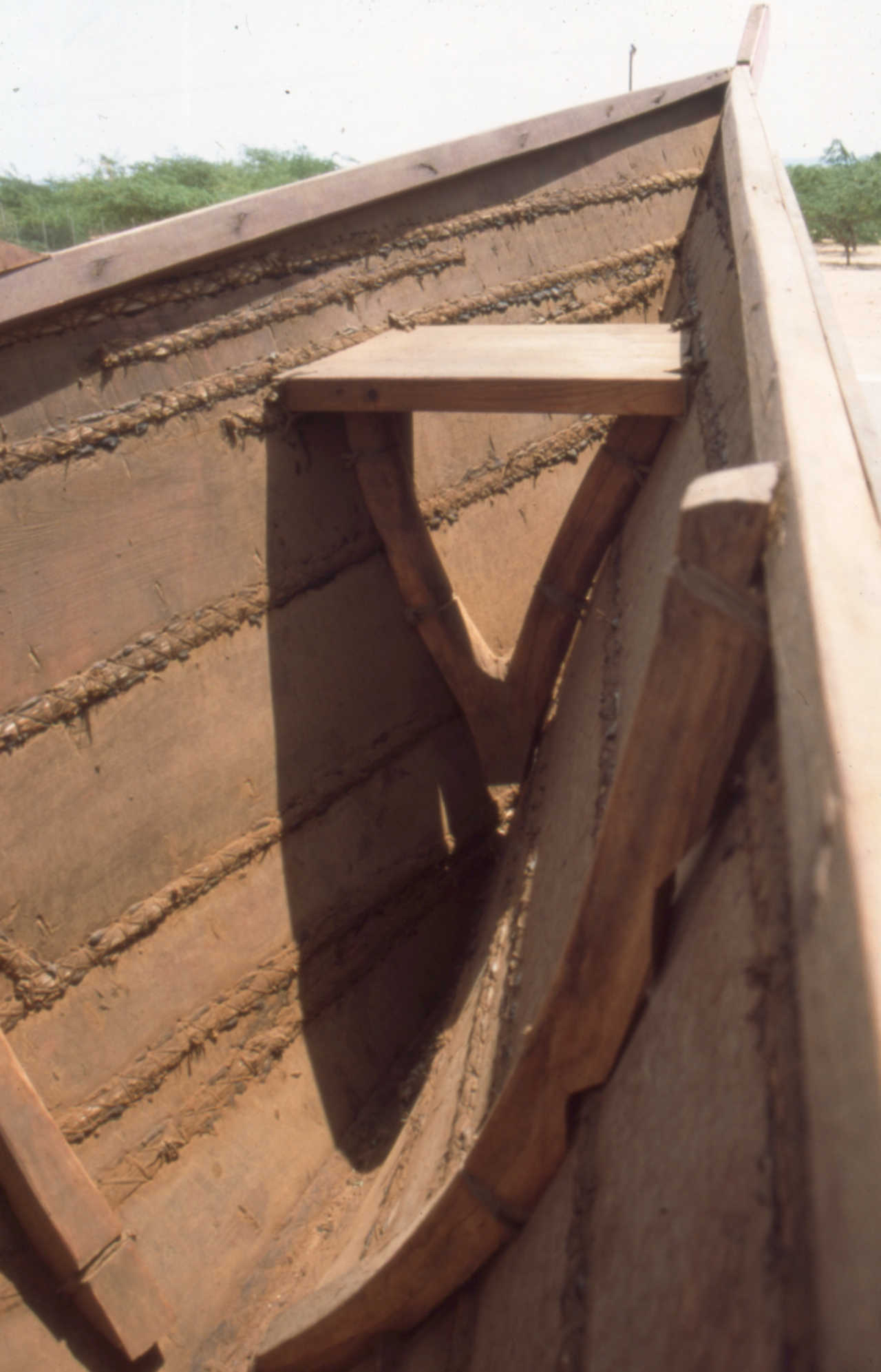
Dugout hulls have the rigidity to crash land on a beach and be hauled out. Sewn boats have the elasticity to do the same, whilst modern light displacement yachts require very expensive wheeled boat hoisting vehicles to lift them and their slender fin keels out of the water for repair, painting or stowage!! Whilst going aground - horror, horror!!
Single canoeform vessels up to 60ft. (19m) long, with a hull length/beam ratio of between 12:1 and 20:1, are ideal for river use. Jungle and heavily wooded country is easier to move through by river than hacking your way over land. For sea use, with their narrow beam, to resist capsizing by wave and sail they need to be stabilized.
The slower, heavier, beamier rafts with a length/beam ratio of 3:1 - 5:1 have always existed along with the canoe. It does not take much thinking for practical sailors to combine 2,3,4,5 canoes into a stable load-carrying raft.
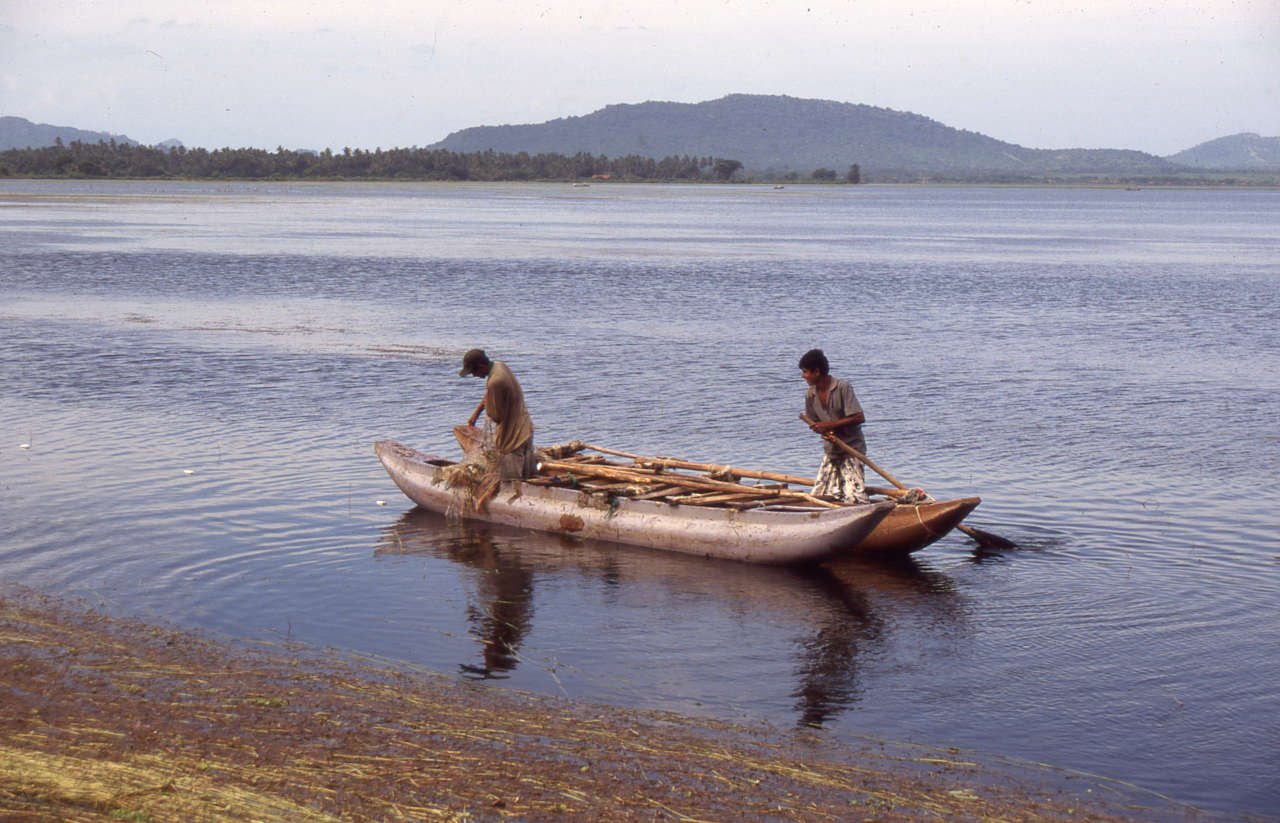
A canoe raft of this type, the Lakatoi, existed in Papua New Guinea into the 1950s (and, I believe still exists). With several masts, they sailed to windward at least as well as our Squareriggers. Rafts are seaworthy. Increasingly, 'regulators' are demanding yachts to carry small inflatable 'Liferafts for safety'.
When these first canoe rafts got sailing we do not know. Papua New Guineans, builders of the Lakatoi, are descendants of the first human seafarers of 60,000 years ago who colonized the then combined Australia/New Guinea continent.
The Double Canoe
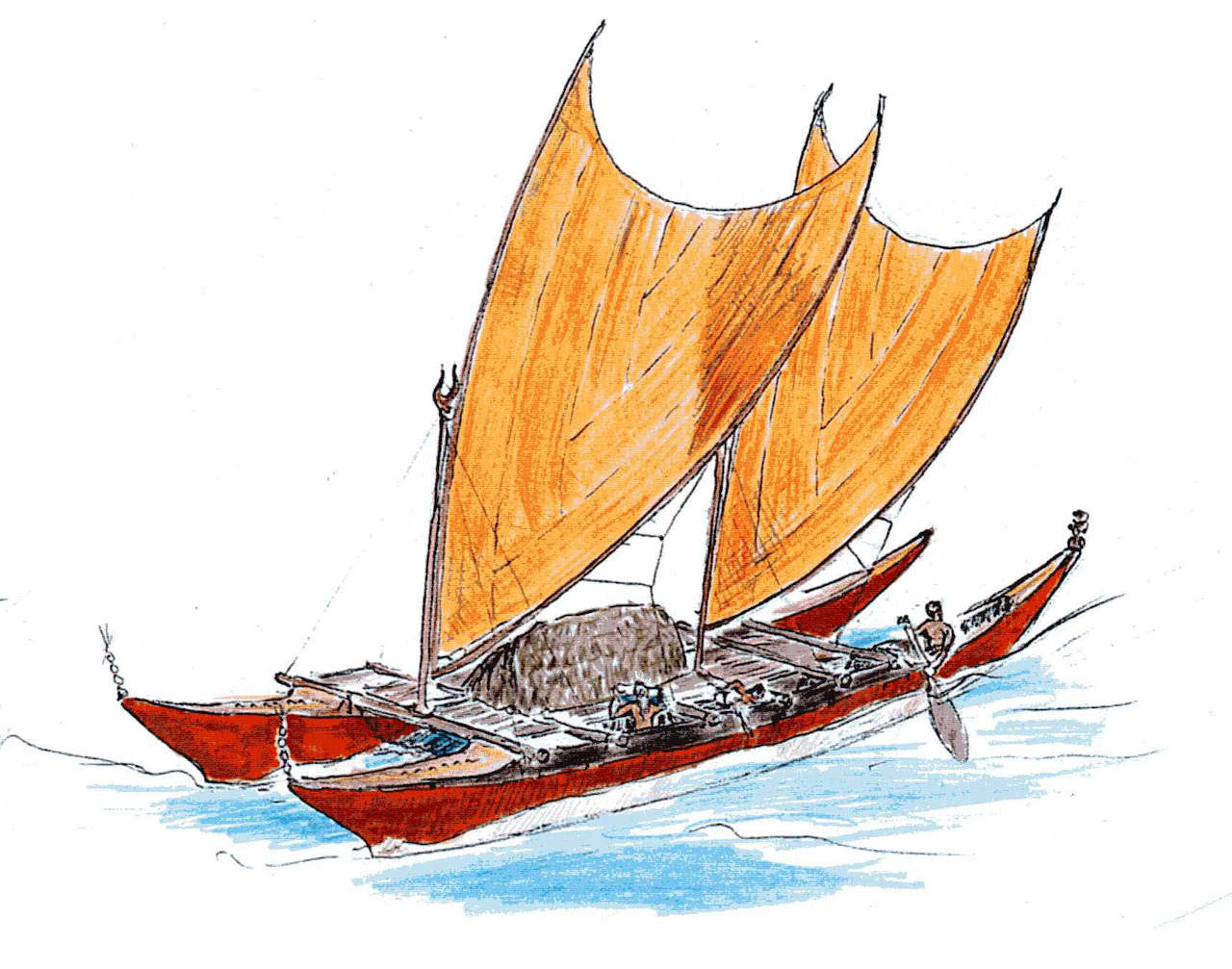
What we do know is that when Europeans began sailing in the Pacific in the 17th century they met over a wide area Double Canoe 'rafts' - as in Fig. 1 . This is a typical Double Canoe 'Raft', known to Polynesians as 'Vaka' or 'Pahi' and to Western sailors who call its modern version, a 'Catamaran'.
Purists, like myself, have argued that the ancient and modern double canoes should not be called catamarans because catamaran comes from the Tamil word katta-maran , meaning tied logs. Perhaps, on reflection, the word catamaran, even though of the wrong language, is the right word to describe past and modern double-hulled Raft vessels. I have been sailing them offshore for nearly 45 years and can be allowed to be realistic in describing them as 'Rafts', for the stability calculations are the same as for the raft, and their 'feel' when sailing is comparable to a speeded up raft.
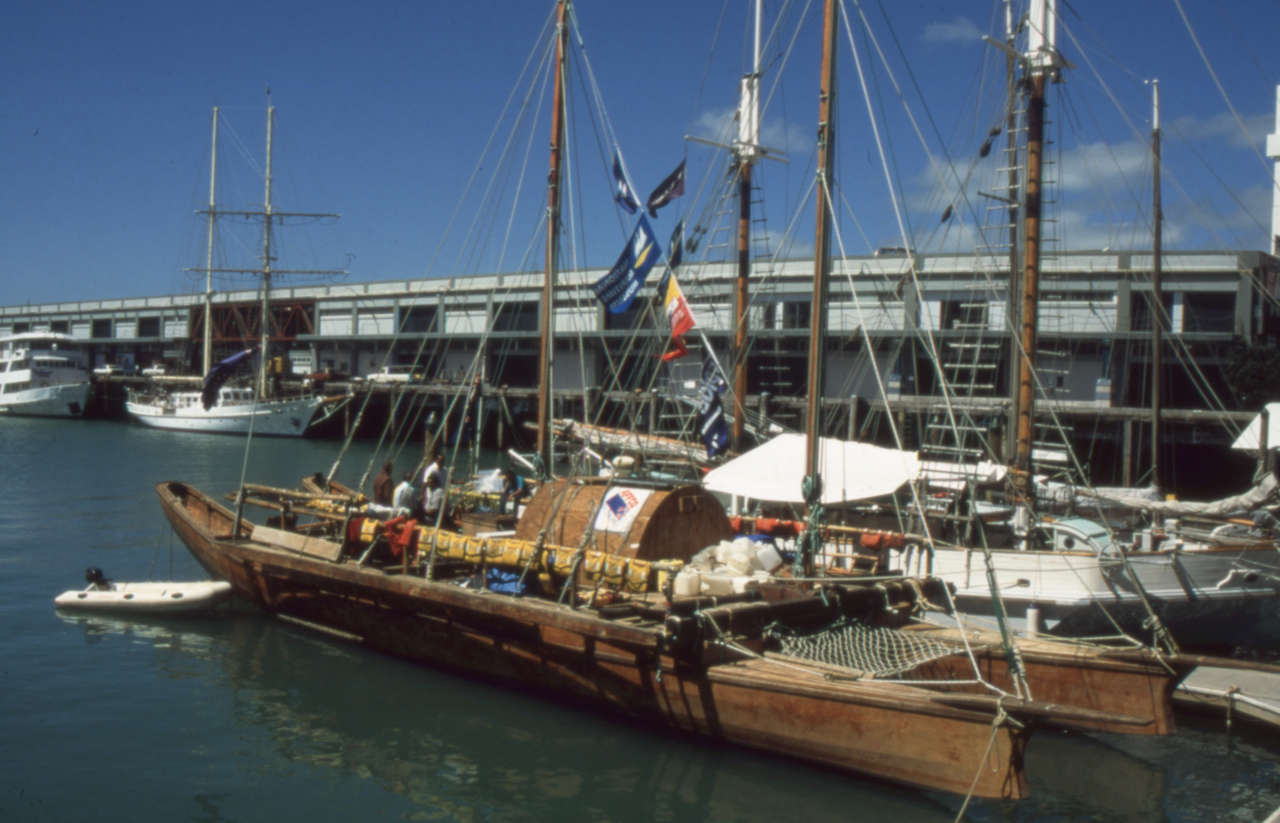
Double Canoe Sailing Rafts sail without heeling or rolling. Their large deck areas allow space to build fair sized deck cabins either in bamboo and mats as in the ancient canoes, or elaborate fibreglass houses as on the modern Catamarans.
The miniumum wave drag and wetted surface of the two canoe hulls give the stable raft shape a good, or high, speed potential. These inherent qualities have made the modern Catamaran , developed over the last 40 years out of the ancient Pacific craft, a successful part of the modern sailing scene.
The Double Outrigger Canoe
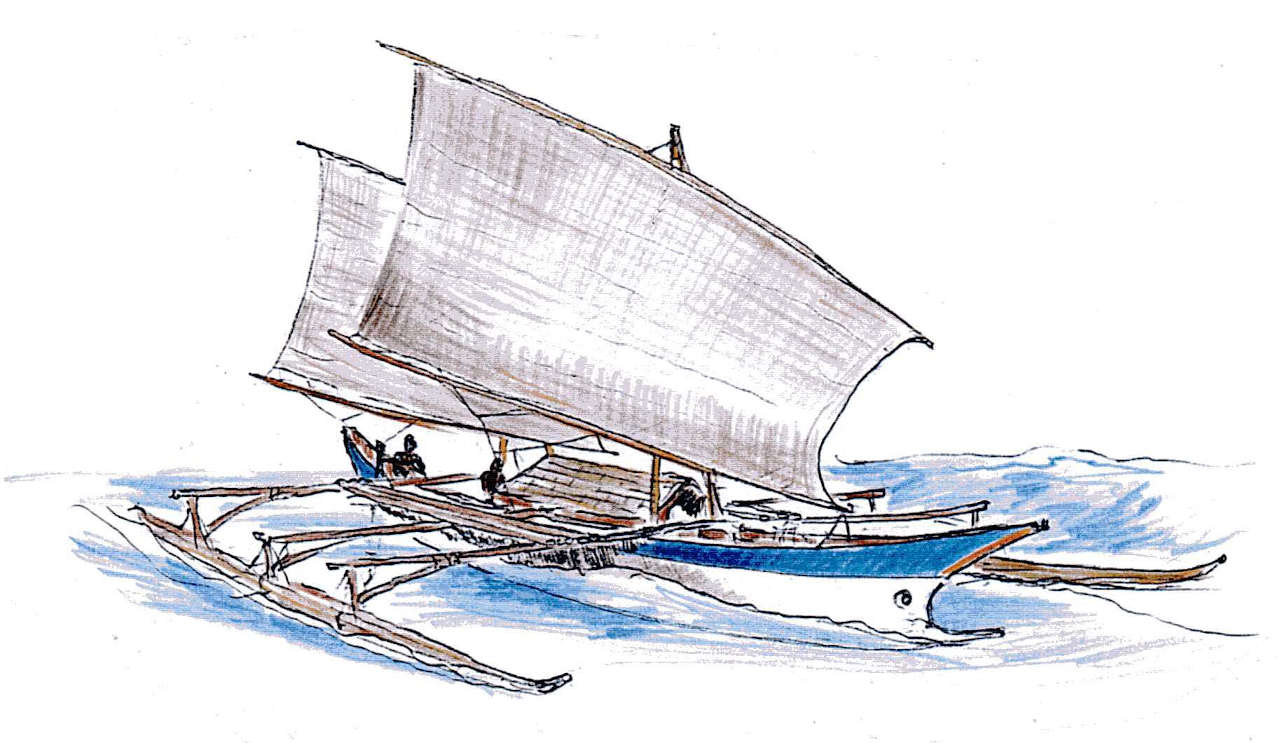
Another modern craft developed out of the canoeform past is the Trimaran , a word I dislike. It is a mixture of the Greek 'Tri', meaning three, and the Tamil 'maran'. It signifies the mixed up Western modern design approach to the Double Outrigger. Fig. 2 is a Double Outrigger of the type used in the settlement of Madagascar from Indonesia about 2,000 years ago. Today, the Double Outrigger Canoe type is sailed from the Philippines (where with 4 big outboards, when used for smuggling, they can outrun many high speed Naval patrol craft), through Indonesia, to Madagascar.
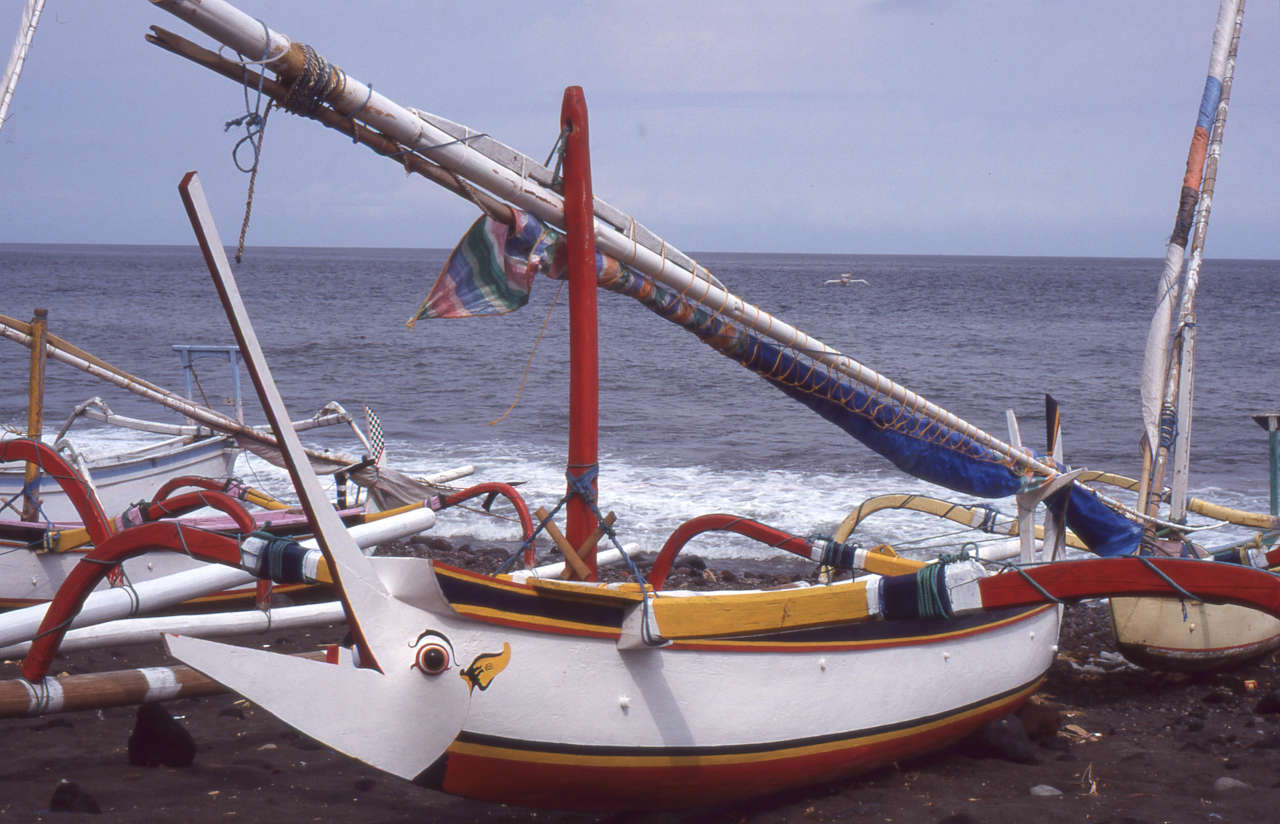
The present day Balinese 'Jukung' is one of the most beautiful of these double outrigger craft. To see them ride white crested waves, their floats balancing their main hull like gentle hands, or swooping up to crunch land on the beach, is to observe a kinetic art form. Technically, the hulls are superbly shaped dugouts, semi-circular in cross section with greater buoyancy aft of the hull centre. An important part of the design is its outrigger floats, made of special thick bamboo , which are 1/3 longer than the mainhull with 1/6 projecting forward and 1/6 behind the main hull and have 30% of the buoyancy of the underwater section of the mainhull.
The Single Outrigger Canoe
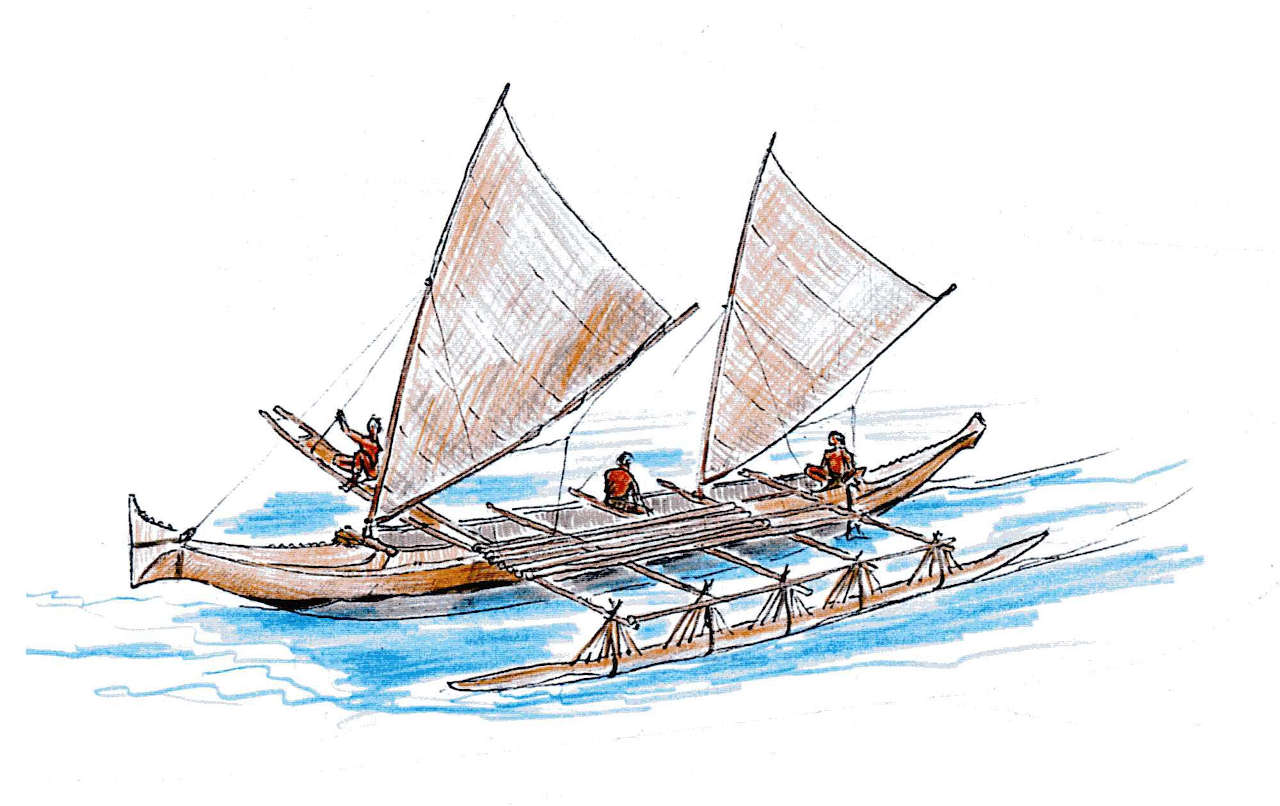
Catamarans and trimarans are to us, certainly in their present day form, well-known craft, but the canoe with just one outrigger is in our waters nearly unknown. (see Fig. 3 & 4 )
However, to-day in the area of Indonesia and the Pacific Ocean they survive in sizes from 12' to 30', made out of carved logs, planks of wood or plywood and in the case of modern, expensive racing team paddling canoes, glass and carbon fibres.
In the Melanesian areas of the Pacific, like Vanuatu (former New Hebrides) and the Solomons, the small canoes are as common as bicycles in Holland. They are used for personal transport, fishing and as small trucks to carry produce from main island gardens to the smaller offshore dormitory islands. (see photos: Maskelyn canoe carrying log and canoes on beach)
Different Ways Of Tacking
Sailing outrigger canoes are sailed with two distinct sailing techniques. The first type of outrigger canoe - ( Fig. 3 ) has a distinct bow and stern. It tacks like a Western craft with the bow going through the wind. On one tack the float is to windward and has less stress on it. On the other tack, the float is to leeward and is pressed into the sea. To prevent the submergence of the float a balance board is added on which the crew as moving ballast can sit or stand.
The second type of Outrigger Canoe ( Fig. 4 ) usually called the proa, always has the float to windward. To tack, you turn the forward bow away from the wind and, when beam on, change the sail and mast positions, then turn what was the stern into the wind, tighten up the sheets and away you go on a new tack. (It is called shunting by Western writers). To assist tacking, you need a specially designed hull profile with a symmetric fore and aft keel line and with a similar bow at each end.
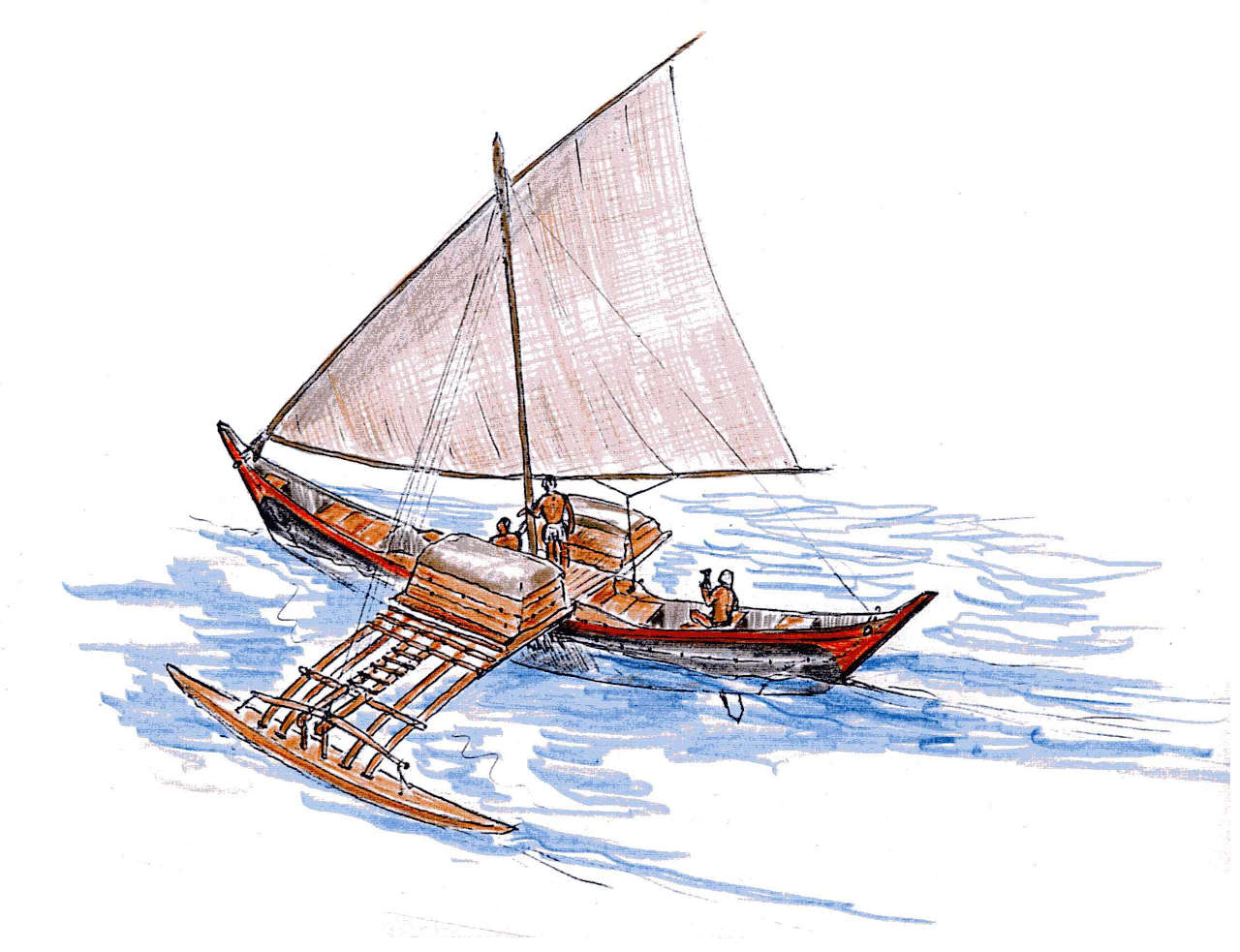
During our 4 years of seasonal sailing in the Pacific and Indian Ocean we had close experience of both types of sailing outrigger canoes. Both have advantages and disadvantages in building and sailing and are capable of sailing in turbulent coastal waters or offshore with a chance of meeting storms.
The Outrigger Canoes Of Vanuatu
In 1996, studying Melanesian sailing craft, we sailed into Lelepa Island, Vanuatu. Two small sailing canoes were launched off the beach to guide us 5 miles into the anchorage (see photograph). They were keen sailors and sailed hard keeping ahead of us. Our speed log showed 6 knots. Later, on measuring the canoes, they were about 16ft. long. Using the speed/length ratio formula, these simple outrigger canoes with crude sails were sailing at a speed/length ratio equalling that of displacement racing monohulls (i.e. 1.5 x WLL).
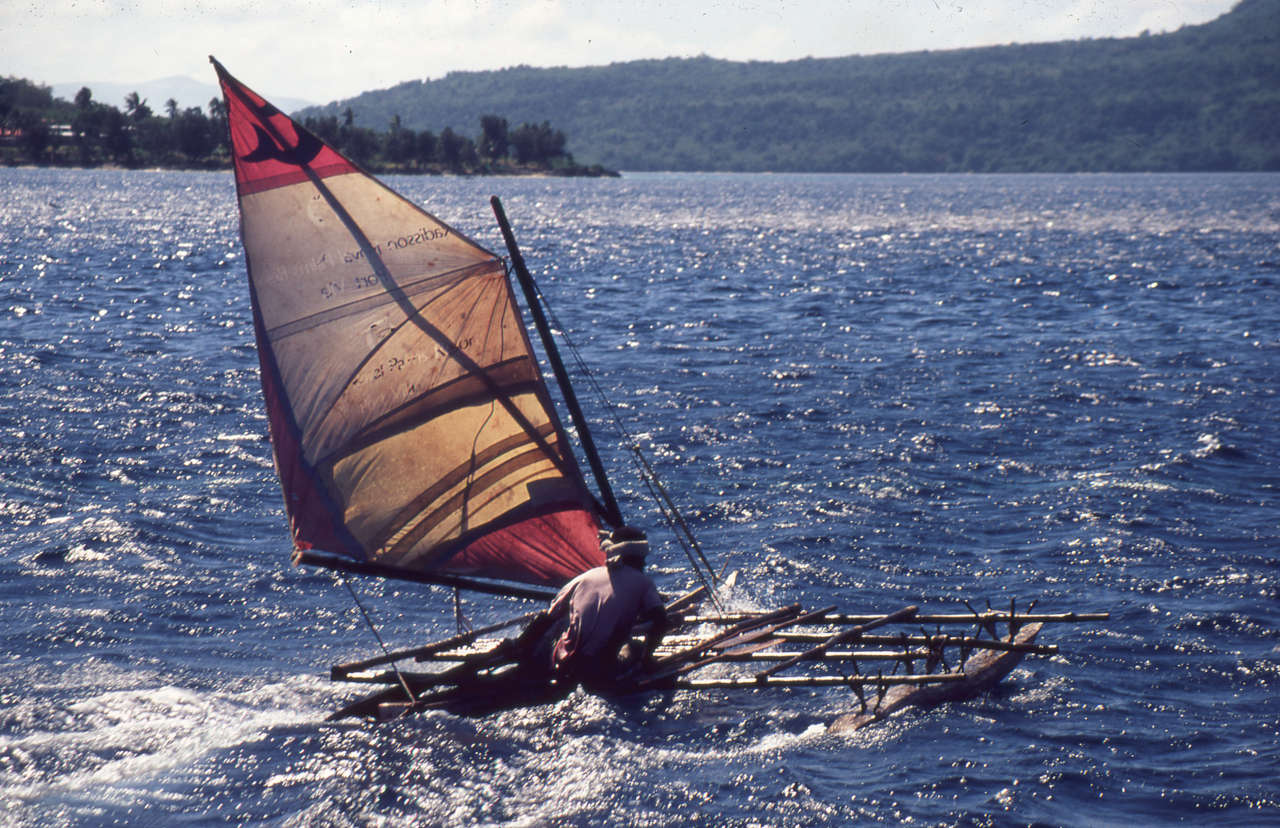
The chief canoe builder, using a local softwood, could carve out a 16ft. dugout hull in two days. Unpainted, these softwood canoes have a life of at least 4 years. Nor were the experienced builders blindly following tradition. They understood the why and how of hull design.
Sailing aboard our 63ft. Double Canoe, one old canoe builder hanging his head over the bow studied carefully our V-eed hull entry wave pattern, then said that he was going to modify his special Racing Canoes to have a more V-eed entry. As he had no 'Recreational Craft Directive' official to consult he could achieve design development in 2 days.
On one island in the Maskelyns (Vanuatu) we met the people of a village which had run short of softwood trees. They wanted to build in plywood and asked us whether we could give them any advice.
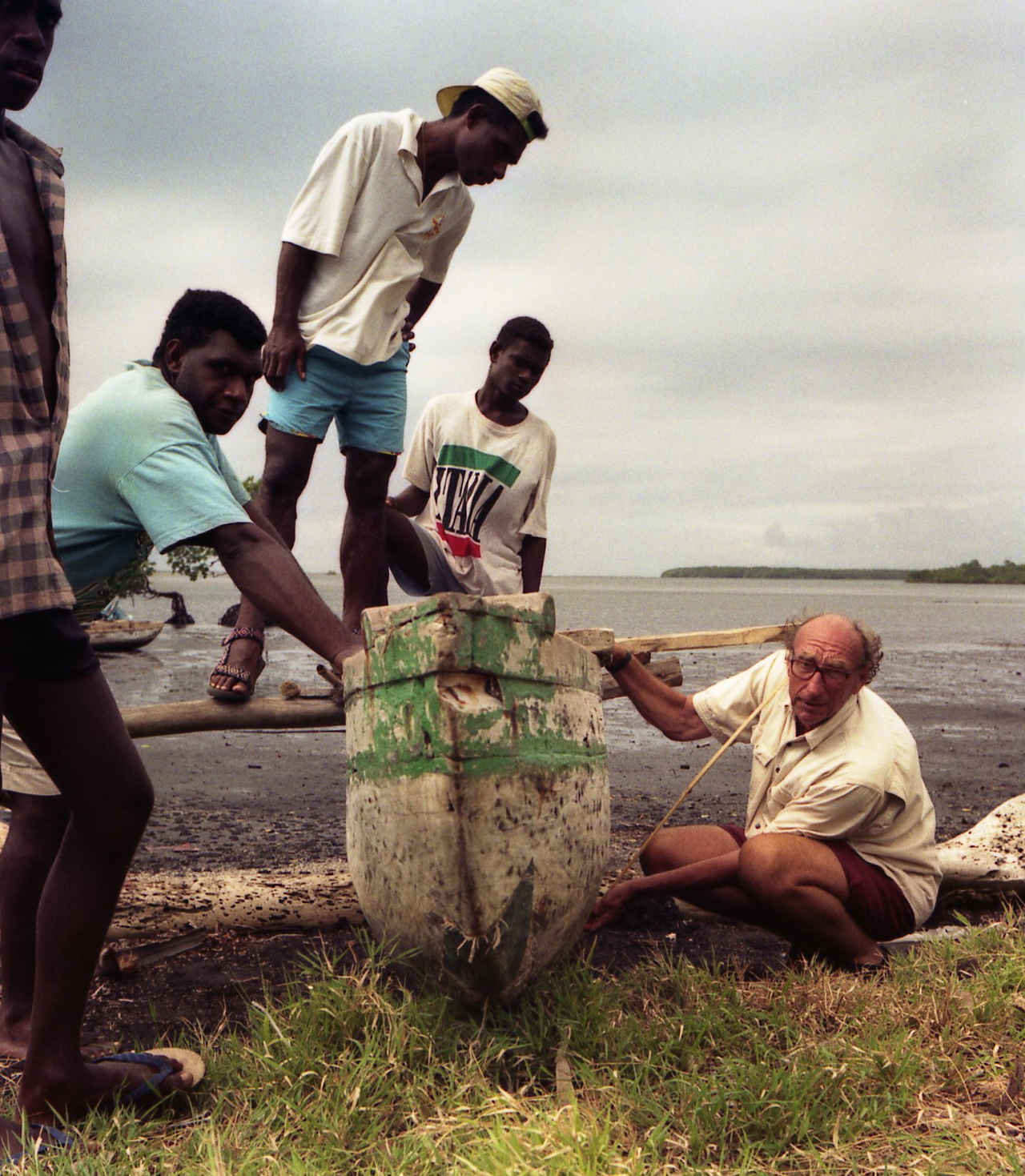
For them we designed the 16ft. 'MELANESIA' outrigger canoe made out of 2 sheets of plywood, which we exhibited at the 1997 'Wooden Boatshow' in Greenwich. It has been of great interest to Western sailors.
From sailing studies of the 'MELANESIA' it does seem that a major factor in sailing outrigger design is Flexibility in the structure, crossbeam attachment, float attachment to the crossbeam, mast and sail. When sailing, the craft seems to 'wriggle' its way to windward, and the flexibility of crossbeam, mast and sail seem to add to stability. When the float is to leeward there is less drag than we expected.
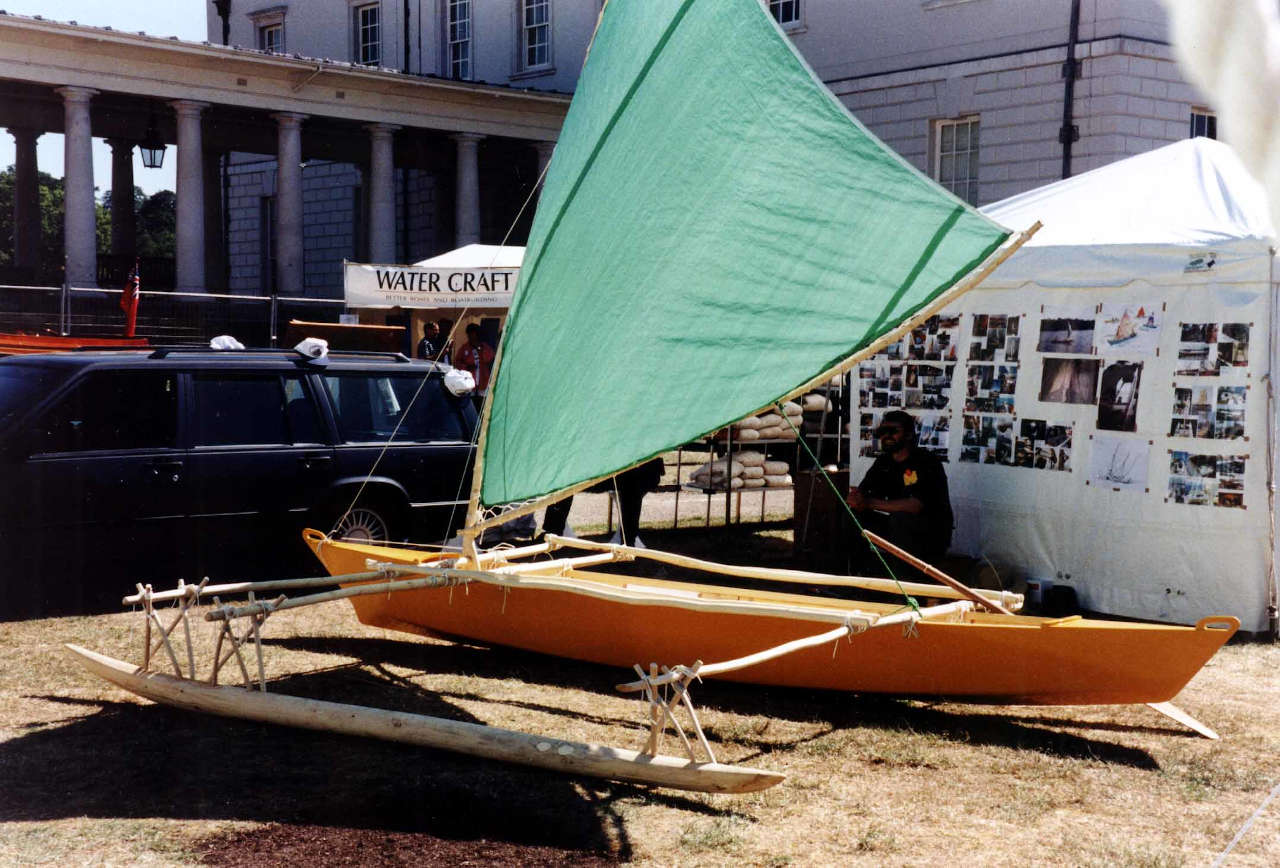
The Outrigger Canoes Of The Polynesians
Outrigger fig. 5 is a Tikopian outrigger. There is a saying about boats: "If it looks right, it is right." Tikopia is a 'Polynesian' island in the Solomon Islands, which are part of Melanesia. I discovered one of these craft in 1995 in the Imperial War Museum in Auckland, New Zealand, half hidden in the small, crowded hall of 'Pacific Canoes'. It was 9m long (see photos). At first glance, I fell in love with this Tikopian canoe. Then, from a small plaque, I found out that it had been in the museum for 80 years, a Sacred canoe presented to the museum when the island was 'missionized' (they objected to the 'fun' with the vahines that went on at the beginning and end of the voyages). It was probably built nearly 100 years ago and was a genuine hull form from the Pacific sailing past.
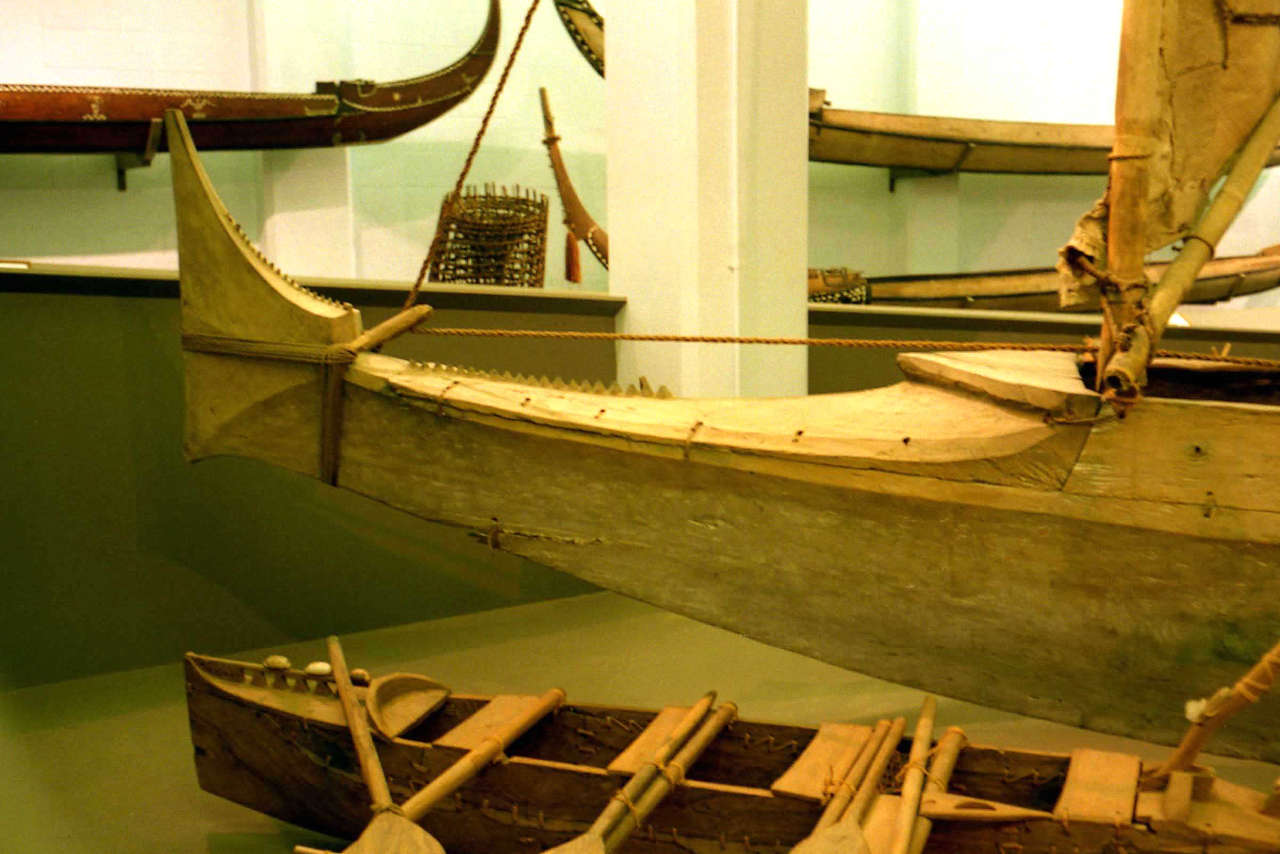
The keel profile is a graceful curve, and its long overhangs would gently lift in rough seas or ride through surf. The cross section of the hull was an exquisite rounded V. (See photo). In all respects, this sacred canoe was sculpted by a genius of design and wood shaping ability.
The question was, how would this canoe or a bigger, say 45ft, ocean cruising version sail? During the winter of 1996, out of curiosity, we laid a scaled transparency of the 9m Tikopian canoe lines on the lines of our 63ft. 'SPIRIT OF GAIA' hull. The keel lines and cross sections practically matched. It was an inspiring and humbling moment.
In our 1996 sailing season we made the effort of sailing to the lonely island of Tikopia, to meet the Chief whose great-grandfather had presented the craft to the museum.
From sailing to Tikopia I know the roughness of the seas they sailed in and of the regular 150-200 miles voyages they made to the Melanesian Vanuatu group. I also know from our similar hull form that theirs has sufficient lateral resistance to sail 45 degrees off the apparent wind without making leeway.
On a waterline of 36ft (11m), from our hull form experience the canoe can be expected to attain average speeds of between 1xè LWL to 1.5xè LWL, i.e. 6 to 9 knots. Therefore, this Tikopian outrigger craft would be able to average through rough seas 150-200 miles a day, i.e. in 6-7 days in a force 4 wind one could plan to sail 1,000 miles.

Sea-going canoes of this type and size were recorded all over the Polynesian Pacific , from Samoa to Tahiti and up to Hawaii (Unfortunately, the use of these craft was abandoned in most islands with the coming of the missionaries, and little concrete data remains). We do know , that they were sailed on thousand miles journeys. However, we do not know how often they used the balance board or how difficult it was to use it when the float was on the leeside.
The Micronesian Proa
The solution to the design problem of the float burying in the sea when on the leeside is the major difference between the outrigger canoe and the Proa.
In the vast area of the Canoeform sailing world, there is one area, Micronesia in the NW Pacific, that is but a few chains of small islands and atolls spread over thousands of square miles of ocean. As late as the 1950s, there were sailors there who would sail 500 miles for a few packets of tobacco. There is a report of a 27-30 ft. proa on such a voyage being 'rescued' in a storm by a steamship. The crew of the steamship then observed, that these Micronesians did not perceive themselves as being 'rescued' but as being 'given a lift'. Their proa was the outrigger craft that always sails with the float to windward. The name Proa, I think, comes from the Indonesian boat name Prahu. It has come to mean the distinctive end for end, or bow for bow, tacking technique.
Fig. 6 is a Marshall Island voyaging proa of the beginning of this century. Notice the small but comfortable deck cabins giving shelter from sun and rain. Though the 'WALAP', the local name for such a craft, shown here, no longer sails the seas, in 1992, for the 'Pacific Arts and Crafts Festival' in Rarotonga, the Marshall islanders built for the first time in 20 years a slimmer, 52 x 28ft. faster version of the Walap, the type know as ' Flying Proa ', i.e. it lifts its float out of the sea. It is a craft that has been recorded 'flying' at 20 knots. After the 1992 Pacific Arts Festival, it was loaned to the Auckland Maritime Museum in New Zealand where, re-launched in 1995 for the 'Vaka Moana Symposium', being a planked boat, it had dried out and kept sinking. We had it hanging off the stern of our Double Canoe until it 'took up'. While there we made a close study of its construction. Hanneke also had the opportunity to sail on 'him' (canoes in the Marshalls are male!)
All Pacific canoeform craft steer like a sailboard by moving the centre of effort of the sails. Tilting the mast and sail forward, and the craft turns away from the wind. Tilting the mast and sail backwards, the craft goes into the wind. The steerboard/paddle is mainly a trimming device.
On the Double Canoe, the Double Outrigger and the Single Outrigger (Tikopia style) sail and mast movement is minimal.
With the end-for-end proa to get steering balance on tacking, there is a considerable movement of mast and sail, requiring strength, agility and careful teamwork.
The photo sequence ( Fig. 6 ) shows the 'shunting' of this 52ft. racing Walap proa, using 4 strong experienced men. Get it wrong, and you risk bruised fingers, strained muscles and the odd hernia.
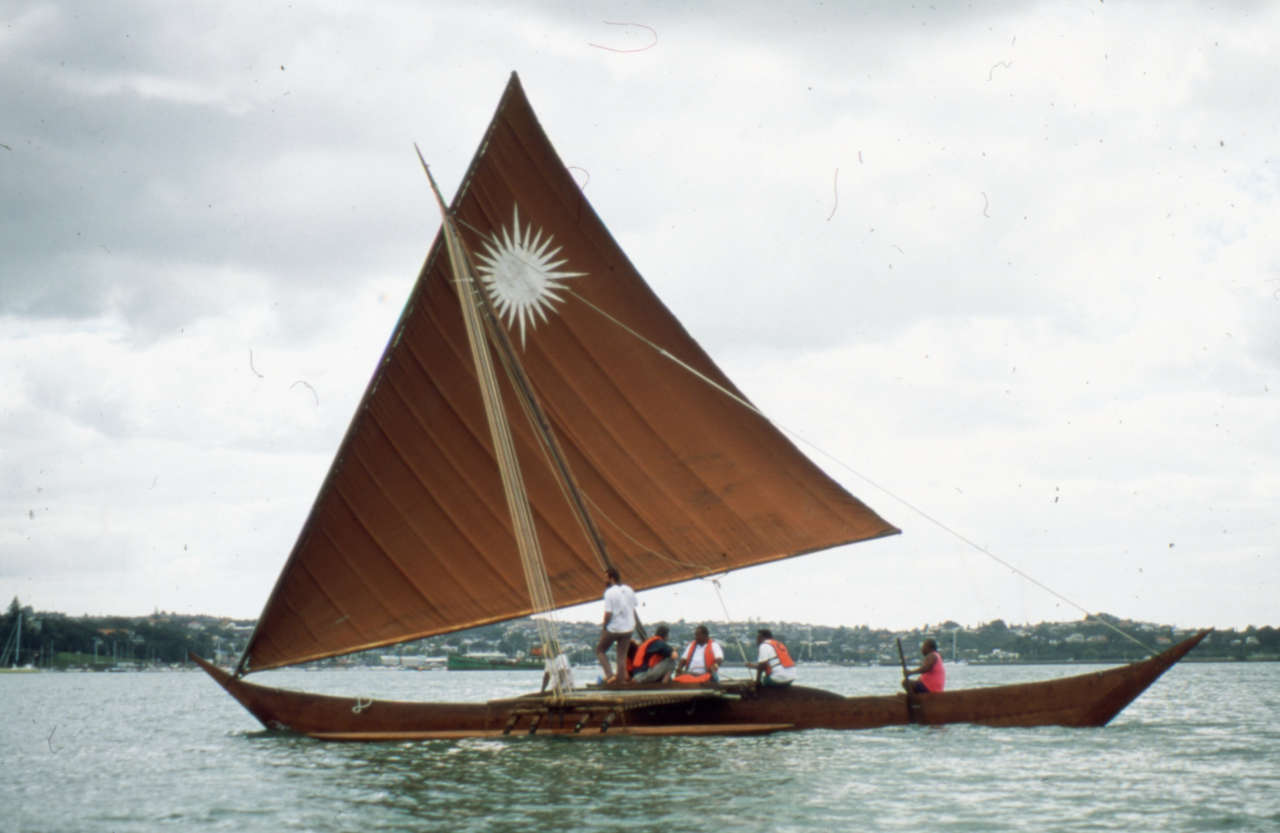
On sailing aboard the proa, Hanneke noticed another problem. Get too close to fluky winds, and you can go aback, with minimal or no mast staying on the normal leeward side, the mast and sail can collapse over the beam platform and float.
On our observation of the 52ft. shunting proa in Auckland we, at the time, favoured the outrigger canoe as being easier to handle.
The Sri Lankan Proa
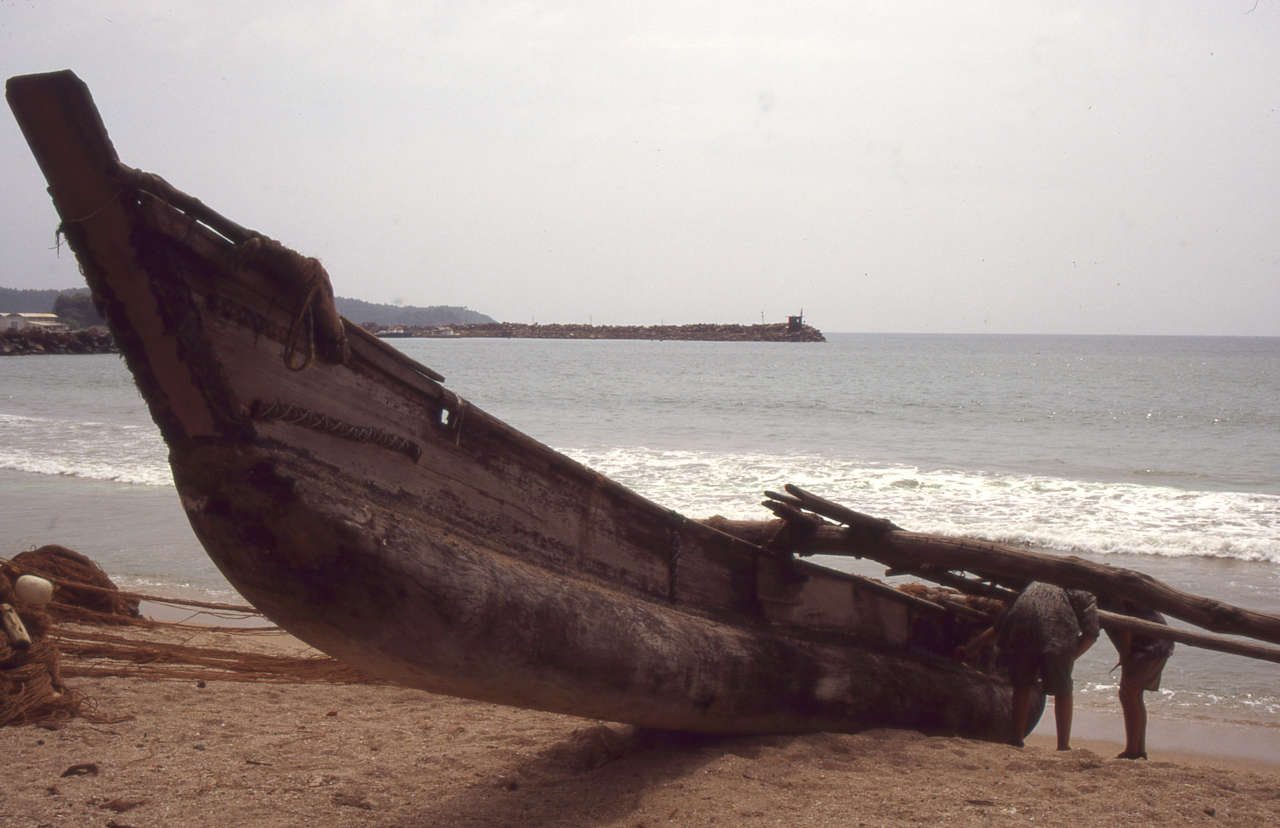
In making that assessmment we were wrong. An easier way of tacking a 'Proa' has been observed by Westerners for 300 years. Holiday brochures of Sri Lanka in the Indian Ocean invariably show the Sri Lankan outrigger sailing craft, called the 'ORU'. But the ORU was seen as part of the Indian Ocean, separate from the Pacific and therefore not seen as a Proa. Of course to the ancient Canoeform World it was all one sailing area.
The ORU tacks end for end like the Micronesian Proa. Hundreds of fishing ORUs still sail the Sri Lankan coast. The Sri Lankan government has encouraged the building of ORUs with fibreglass main hulls, and certain fishing is restricted to sailing outriggers only (like the sailing oyster work boats in the Fal estuary).
So deep is the concept of safety (at sea) connected to outriggers , that a small harbour fishing craft (see photo) made out of a Western yacht dinghy has an outrigger added 'for safety'!!
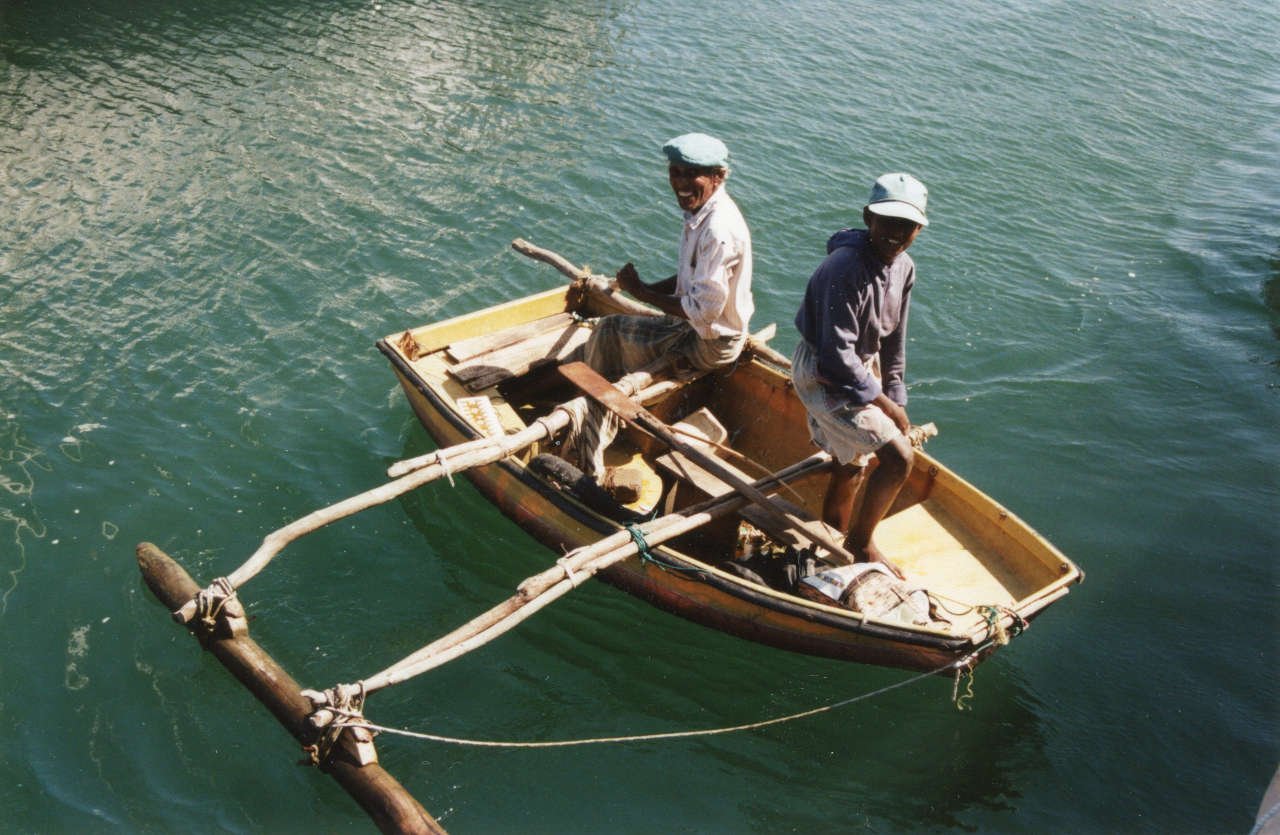
The Sri Lanka ORU would not win any Wooden Boat competition for elegance of form or finish. The first one we measured loomed over my head like an archaeic sea animal. Its long dugout hull was pitted with age and mended with stitched on tingles. As I found out, it was 50 years old. Its built up single plank topsides were sewn on.
Compared to the light woodwork elegance of the Micronesian 'Walap', it was brutally strong and easily repairable. The flat plank overhanging bows had an enormous lift which could not only ride the surf on beaching but also lift over stormy seas. My gut instinct said, I would like to sail one of these craft, and I did, not in strong wind conditions but in the lightest of winds.
Six of us pushed the 1 1/4 ton craft into the sea, and in the glassy calm she was moving out to sea. When the first wind ripples began showing on the sea, the absurd rectangular sail filled like a spinnaker, and the craft was moving at 3-4 knots off the apparent wind.
Light weather sailing ability is as important as strong wind ability. This archaeic looking craft moved well in the lightest of winds. From the crews' description of where their offshore fishing areas were and the time they took to get there, this craft could average 7 knots. Other people reported 10 knots averages in winds which are described as 1, 2, 3 or 4 men winds, i.e. attained with the number of people out on the outrigger beam to add stability.
Once we had a good way on, I said: "Tack". After bearing away bringing the float into the wind, the two men crew eased a few ropes and well... the drawing shows what happened ( Fig. 7 ). This Proa rig, compared to the Proa of Micronesia, needed no big men for heavy lifting when tacking. It is a rig that could be developed to be used by Western sailors.
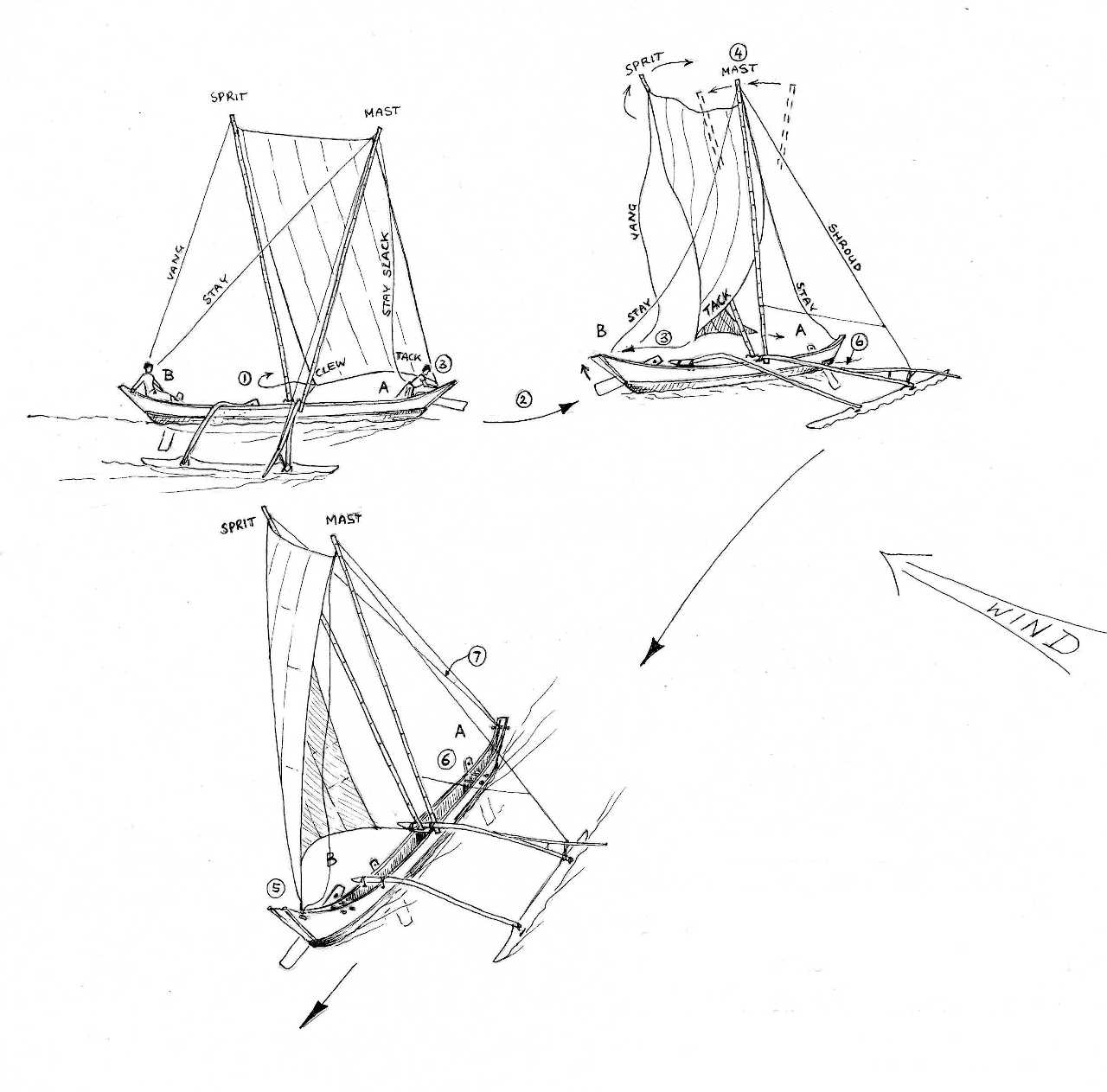
- The sheet is taken between the mast and the sprit by man A and belayed, while...
- The canoe is steered away from the wind by man B
- The tack of the sail is untied by A from the 'bow' and passed between the spars to B at the other end, while the canoe lies beam on to the wind. B raises the rudder
- Meanwhile, by means of a tug on the stay, the mast starts to cant to the other end
- B ties tack down
- A sheets in sail and lowers his rudder
- The vang is passed round the lee side and tightened at the 'stern' by A
A Canoe For The Future
From our studies of Canoeform designs in the Pacific and Indian Ocean we believe that the basic sailing hull of the ancient Pacific sailing canoes is still ahead of Modern Multihulls in subtlety of underwater hull shape. Improvements in the performance of Modern Multihulls, as indeed much 'improvement' of yachts in recent years, have less to do with designers' hull shaping skills and more with improvements in modern sail fabric. Synthetic sailcloth allows you to sail closer to the wind, with more drive than the matting sail of the Pacific, the leather of the Roman sails, the wool of the Viking sails or the flax of the Channel lugger sails."''
"'What defines a modern light displacement yacht is mathematical formulae: sail area/displacement ratio, displacement/length ratio, sail area/wetted surface ratio. Using these formulas for analysis, there is an accepted scale of comparison defining a yacht as heavy displacement, medium displacement and light displacement.
An assumption was made at the Royal Lymington Debate in February 1998 that the fast light displacement boat is a modern concept. We applied these defining formulae to the crude looking ORU (See Fig. 8 ) shows that the crude looking low cost ORU is in fact by modern mathematical definition, a high speed, performance, light displacement sailing craft!
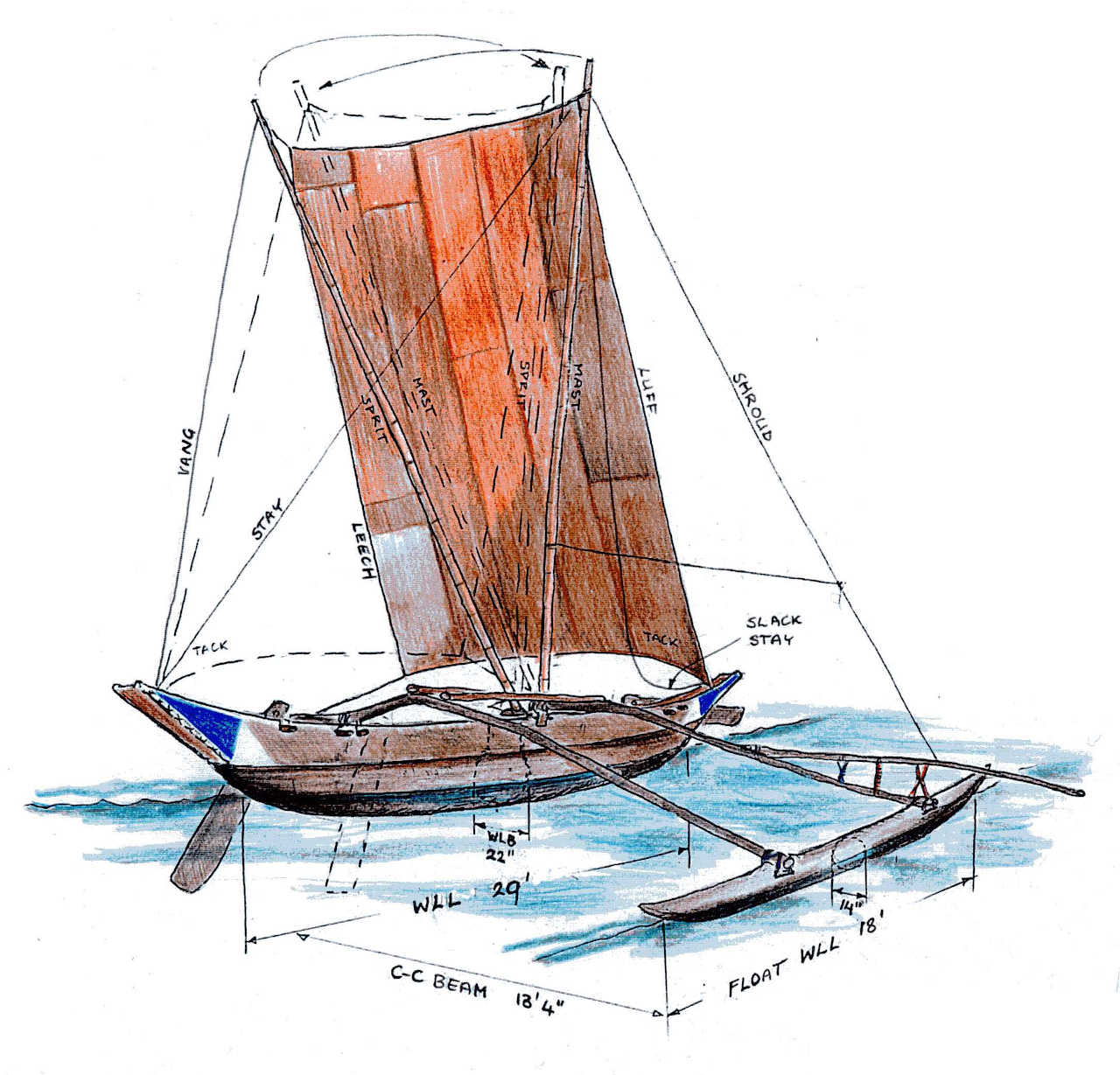
Comparisons
- 2.6 is excellent ghoster (sail area/wetted surface ratio)
- 20 - 22 racing monohulls (sail area/displacement ratio)
- 22+ very high performance monohulls (sail area/displacement ratio)
- 25-30 high performance multihulls (sail area/displacement ratio)
- 50 - 120 ultra light multihulls (displacement/length ratio)
- 1.5 x √WLL is max speed for high performance monohull (speed/length ratio)
- 15:1+ high performance racing cats (hull length/beam ratio)
Using modern multihull design analysis, the 15:1 main hull length/beam ratio and float length/beam ratio equals modern high speed multihulls. The blunt ends of the dugout log ORU give a high prismatic coefficient, again considered an important aspect of modern multihull design. Their semi circular cross section give minimum wetted surface for maximum speed..
The only negative, to me a serious negative, of the Performance Orientated light displacement ORU is its calculated stability which is similar to that used in three modern production 'Performance' cruising catamarans. In use, they all capsized with injuries and loss of life!! I do not recommend cruising for 'fun' with such a low stability factor (Other people do differ). However, from out observations, it does seem that vital extra stability is gained from flexibility in the outrigger and rigging. If one reduces the sailarea to a 2:1 sail area to wetted surface ratio the shown ORU would have a stability equal to many proven stable multihulls.
Treasure House Of Practical Knowledge
The development of modern catamarans and trimarans is an important pointer to the vast treasure house of design knowledge, experience and ideas that exists not on the screen of a computer, but in the traditional small craft still sailing and found in ship museums or books of historic sailing craft.
The outrigger craft of the Pacific are 'Light displacement cruising craft that can be fun to sail'. So is the Norwegian 'FEMBORING' and other Viking era style craft. Traditional craft can offer modern would be yachtsmen who put "'sailing"' before urban comforts, interesting sparkling sail boats, sail boats that can be easily built at affordable prices.
Home » LIST of WOODEN BOAT PLANS – By Michael Storer » Drop-in Outrigger Plan for Canoes & Kayaks (some dinghies) Sailing Videos
Drop-in Outrigger Plan for Canoes & Kayaks (some dinghies) Sailing Videos
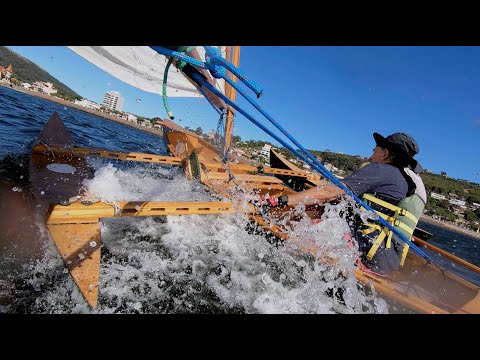
The drop in outrigger can transform many unstable canoes, narrow dinghies and some kayaks into a stable platform for fishing or diving or convert your boat into a formidable sailing outrigger or trimaran sailing canoe .
- Turn a Canoe or Kayak into a formidable sailing boat or a super stable fishing platform. Drop in Outrigger Plan info here.
- Whizz Along in Armchair Comfort – or – the Ideal Fishing Platform (paddle/motor)
- Diving or Snorkelling Platform
- All Components under 10lbs
- Everything removes from the original boat easily
- 2 sheets ply
Specification
Hull length 2350 Beam 290 Hull Depth at middle of hull 265 Hull Depth from line joining bow and stern measured perpendicular to keel 340mm
NEW Mini Outriggers – click here for information.
These smaller and simpler outriggers are designed to be kept above the water most of the time. But if a gust hits it gives the sailor of a canoe or narrow dinghy with a bit more time to react by easing the sheet (first!) and/or hiking out.
The “Drop in Outrigger” design explained below is bigger for full time sailing on the outrigger.
The first time I worked on this concept we took an elegant Strip Planked REDBIRD canoe and fitted it with this outrigger system. All components are light and easily removable. And as with our other sailing canoe work very well.
With the additional stability we were able to cram on a significant amount of sail in a simple Lateen Rig. – about 7.5 sq metres (80 sq ft) for real sailing performance. One of the advantages of the lateen rig is that the sail can be a backyard manufactured item. We made ours out of a blue plastic tarpaulin – I think the total sail cost was about $40. The Lateen even if cut completely flat develops a useful driving shape when loaded up by the wind.
The boat whipped along nicely and did not require a leeboard when the leeward hull was well immersed and the speed was maintained. Try to point high and low speed combined with leeway counters upwind progress. But point at 70 degrees and the speed greatly exceeds the upwind speed of a normal monohull and leeway reduces.
Unfortunately I don’t have any pics of Mr Webb’s Fabulous Redbird under full sail – but it was great fun. The photos of the black outriggers here are on Daniel Caselli’s Eureka Canoe in Uruguay.
Video 1- of the drop in outrigger Plan conversion of a canoe or dinghy into a fast stable sailing trimaran
The Bolger designed Teal is a lovely simple dinghy, but it can be an exciting handful in stronger winds. Video below: Jan Cudak added the outriggers to turn the Teal into a very pleasant stress free sailing outrigger.
You also see the little 12ft dinghy is sailing way faster than the original design.
It had a surprising turn of speed and was quite exciting to sail.
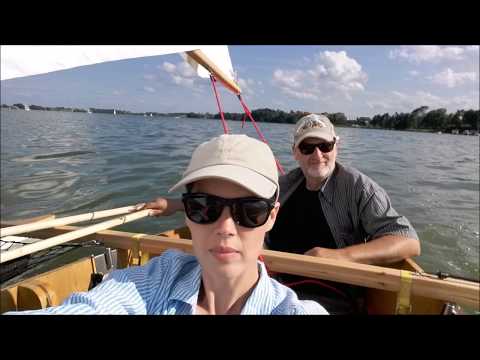
This applies the dynamics of Proa, Trimaran and outrigger design to an existing boat.
Loads on the structure are limited by the modest ama volume. As the amas are loaded up speed is increased. However, when the load starts getting closer to the design strength of the crossbeams the amas start submerging. Thus providing feedback to ease the sail and back off.
With larger outrigger hull designs which do not submerge it is the load in the main hull of crew and gear along with platform weight that set the loads on the crossbeams. As this can vary it means the crossbeams have to be heavier to carry unanticipated loads.
We also have plans for other sailing canoes
Additional free pack for plan purchasers – basic sail and crossbeams for low Freeboard canoes
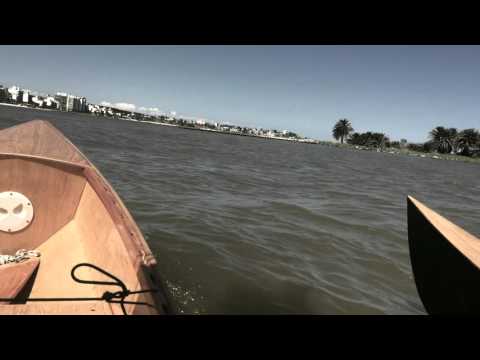
Portability of the lightweight drop in outrigger components
None of the components weigh more than 10 pounds (4.5kg).
Some downsides from the conversion – not serious but so you know.
The only downside was that the Redbird canoe hull, being a brilliant straight line paddling boat, just refused to go round corners easily – it just refused to tack through the wind.
Either it had to be assisted by someone with a paddle – or the tack was completed by the boat picking up a little bit of speed in reverse then steered out with reverse rudder. Not a big problem at all – and the speed in a straight line made it all very worthwhile!!
This depends on the characteristics of the original hull. If it is easy to turn the trimaran will too. Here one of my Quick Canoes with the the drop in outrigger components inside the hull for transport.
Outrigger hull construction is simple
The hulls are simple stitch and glue. Two panels, timber around the sheer and an epoxy fillet and glass along the keel line.
The crossbeams are simple laminations and look light and simple on the boat.
The hulls attach to the crossbeams with butterfly nuts. Crossbeams are lashed into the canoe hull. The attachment point for lashings is a doubler glued to the canoe hull with a deck eye (saddle bolted through.
For sailing versions the upper mast partner is built into the forward crossbeam and the mast steps on a simple block glued to the bottom of the boat.
Any relatively narrow hull (under 3ft, 1.2m) is suitable, whether a canoe, kayak or rowboat. The crossbeams can be extended for wider boats by increasing the length of the flattish section in the middle. But there are limits as the distance between the gunwale of the main hull and the furthest point of the crossbeam should not exceed 1200mm .
In other words, the steering characteristic of the whole shebang is defined by the main hull.
The owners use it for holidays – it all roofracks easily because of the light weight – and for fishing.
There have been a couple of these built to make a canoe into an excellent fishing platform. For that purpose they used a small outboard (2 or 3hp pushes a canoe along quite quickly) attached to a bracket on one of the crossbeams. The outer hulls provide an extra level of safety as they are watertight.
Fitting a single outrigger hull only makes a tacking proa. The ends without the outrigger hull should project about 12 to 18″ (300 to 400mm) outside the gunwale and the two ends tied together with a piece of timber so they can’t move relative to each other.
The hulls and crossbeams can fit some small dinghies particularly if they are quite narrow and not too long.
The other advantage is that like the “drop-in kayak rig” when the outriggers are removed from the hull there is only the small block of wood acting as a mast step still attached to the canoe.
Because of the potential speed and power of sailing versions we recommend a rudder be fitted to the main hull. Steering it with a paddle would just be too much work! While a simple rudder makes things easy.
Powering with a Small outboard or Electric Trolling motor
Recommended power is a couple of horsepower maximum or an electric trolling motor with a couple of deep cycle batteries will give a good few hours moderate speed motoring.
It is possible for a motor or paddling configuration to use one hull only – a one sided outrigger canoe. But the ends of the crossbeam without a hull have to have a tie bar between the ends. This might potentially make a nice diving platform. The outboard could be attached to the rear crossbeam close to the hull.
This outrigger canoe project below was to make a too unstable boat much more stable for outings and diving in the Philippines.
There are two free additions to the plan in a package available to purchasers. Email me with evidence of purchase.
- A flatter curve to the crossbeam for canoes and kayaks with lower freeboard.
- Drawings for an integrated sailing rig with mast supported by front crossbeam. This includes a sail design for polytarp or you can purchase a sail from our sailmaking arm;
Link for sails for Drop in Outrigger plan from our Really Simple Sails
Drop-in outrigger sails are available from reallysimplesails.com
- Skip to main content
- Skip to header right navigation
- Skip to site footer

Albom Adventures
Capturing the essence of travel through photography
Inspiring New Zealand travel through photography
Polynesian Outrigger Canoes Close Up: In the Museum and on the Water
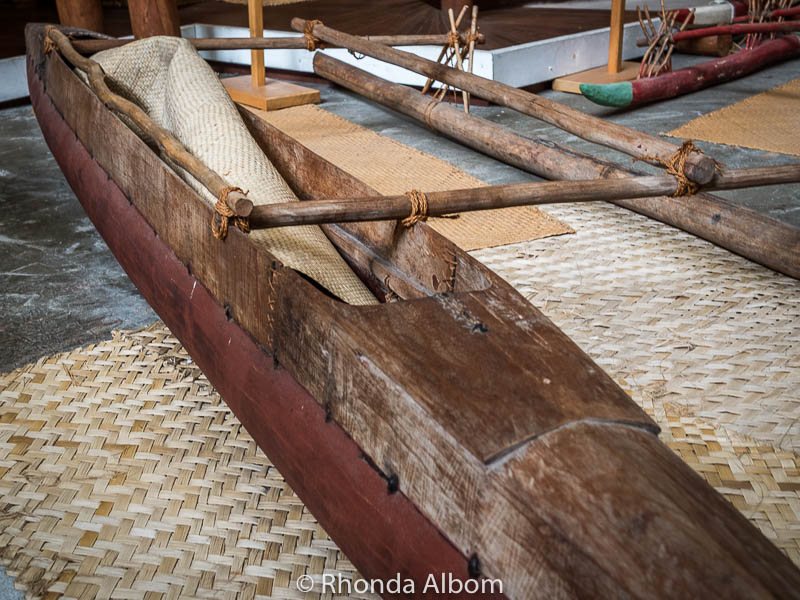
Long before the days of GPS and satellites, curious and brave seafaring explorers used their knowledge of the ocean and the night sky for guidance. They explored the oceans in Polynesian outrigger canoes, the style of which has sailed the Southern Pacific Ocean for over 5,000 years.
In some places, single wooden-hulled Polynesian outrigger canoes are still in use today.
While a single carved-out tree makes up the hull, what distinguishes Polynesian outrigger canoes is that traditionally, they have only one outrigger. In contrast, Southeast Asia more often had double outriggers. Importantly, double-hulled canoes (catamarans) were also popular amongst the early Polynesian people.
Today, many original style wooden vessels can be found on the waters, but more often we have seen Polynesian outrigger canoes made from modern materials. However, the basic long narrow shape with the addition of only a single outrigger has withstood the test of time.
It is the detailed handwork of the older vessels that I find so intriguing.
Taking a closer look at the construction details of the Polynesian outrigger canoes, the challenge these brave men faced seems multiplied.
The New Zealand Maritime Museum displays replicas of voyaging canoes from Polynesia, Melanesia, and Micronesia.
Larger vessels were used for migration sailing and were often double-hulled canoes. In fact, these are the type of boats that brought the first Polynesian people to New Zealand.
As American expats who have been living in and exploring NZ for over 20 years, we see things from both a local’s perspective and from that of a visitor. Therefore, we understand what it’s like to come here and have things be similar, but not always exactly what we are used to. We share the information on this page from this perspective.
The legend of Kupe
Maori legend tells us that Kupe discovered New Zealand about 1,000 years ago. He sailed to Aotearoa (New Zealand) from Hawaiki, the traditional homeland of the Maori people. Today, no one today knows the exact location of Hawaiki. However, the accepted belief is that it is somewhere in Polynesia.
Where is Polynesia?
Polynesia is an eastern subgroup of Oceania and consists of over 1,000 islands in the Southern Pacific Ocean. It is not as clearly defined as many regions with land borders. In fact, different sources include different countries in Polynesia. The conflict is generally regarding the outliers.
However, regardless of where you draw the physical borders, most will agree that the countries listed just below are culturally Polynesian. A triangle from Hawaii to New Zealand to Easter Island defines this group.
The commonly agreed-upon list of countries of each region:
- Polynesia: American Samoa , Cook Island , Easter Island, French Polynesia , Hawaii , New Zealand , Norfolk Island, Niue, Pitcairn Islands, Rotuma, Samoa , Tokelau, Tonga, Tuvalu, Solomon Islands, and Wallis and Futuna.
- Melanesia: Fiji, New Caledonia, Papua New Guinea, Solomon Islands, and Vanuatu.
- Micronesia: includes the archipelagos of the Caroline Islands, the Gilbert Islands, the Mariana Islands, and the Marshall Islands. There are also independent islands in the region.
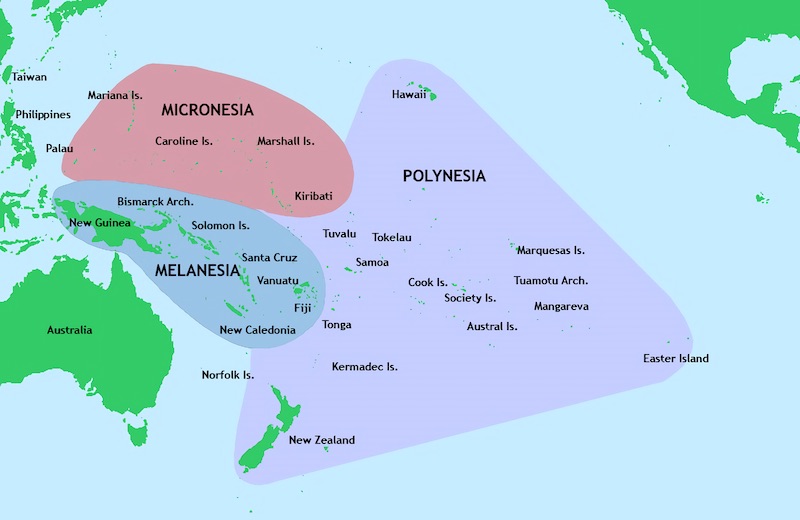
Polynesian outrigger canoes
What we do know is the detailed craftsmanship that went into building Polynesian outrigger canoes is similar throughout the region.
Many replicas of these boats are on display at the Maritime Museum in Auckland, and it’s a great place to get a closer look at some of the details.
At the top of this page is a classic example of an outrigger canoe. The main parts are:
- Hull/canoe – the hull that holds the canoe paddlers, carved from a single log, or stitched together.
- Boom: Rather than a single boom like modern sailing vessels, the sail is lashed to two separate booms to raise the sail.
- Sail: woven from plant materials and sewn together in strips. Pandanus matting is the most common in Polynesia. However, New Zealand used flax.
- Outrigger boom: spars leading out from the hull.
- Outrigger: the smaller lateral supports that float on the water and offer balance.
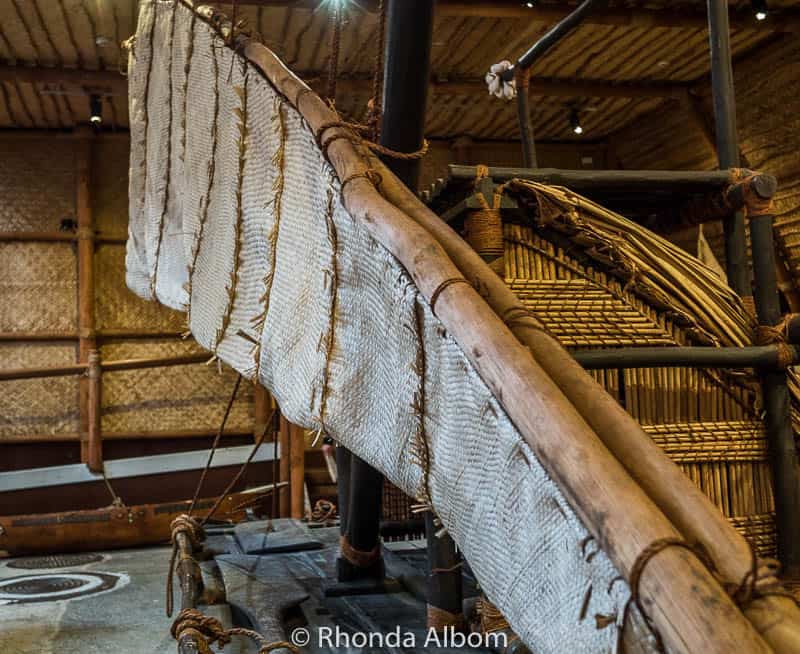
Polynesian outrigger canoes from Tonga
Just below is a Tongan Tongiaki, a double-hulled voyage canoe. The small hut offers the only protection the brave sailors had against the oceans. It’s similar in style to the boats that originally brought the Polynesian Maori to New Zealand. Although, the Maori migration boats are believed to have been about 20 meters in length.
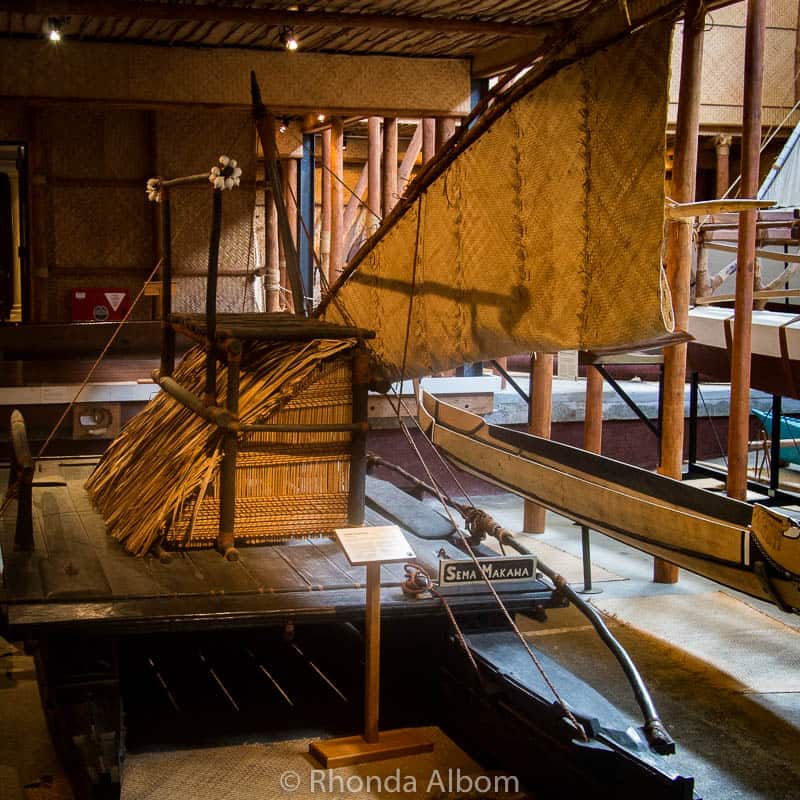
Polynesian outrigger canoes from New Caledonia
This vessel is from the Isle of Pines, an island in the archipelago of New Caledonia ( Melanesia ). It’s a mix of modern and traditional styles and base materials.
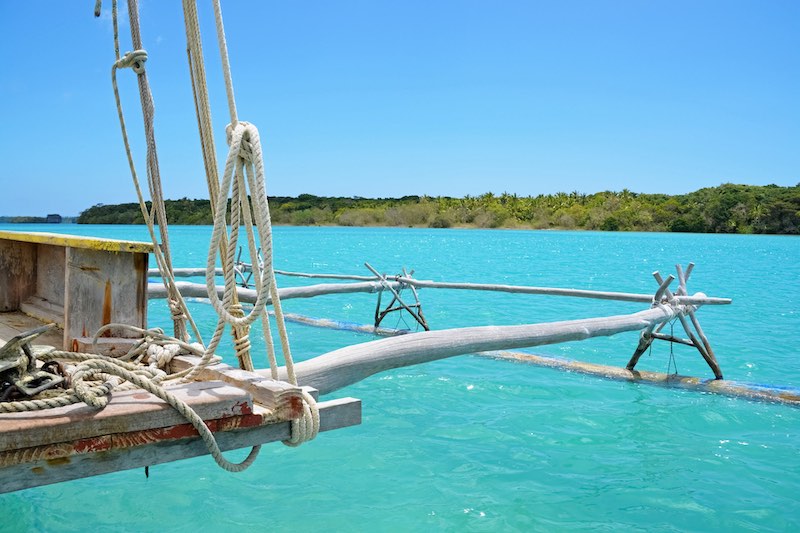
Polynesian outrigger canoes from Kiribati Atolls
Also at the museum is this Polynesian outrigger sailing canoe. In the background of the first shot below is the hull, outrigger boom and part of the sail of Taratai, a 76-foot baurua voyaging canoe from the Kiribati Atolls (Micronesia).
Check out the impressive detail in the lashings on both the smaller canoe and the larger migration vessel.
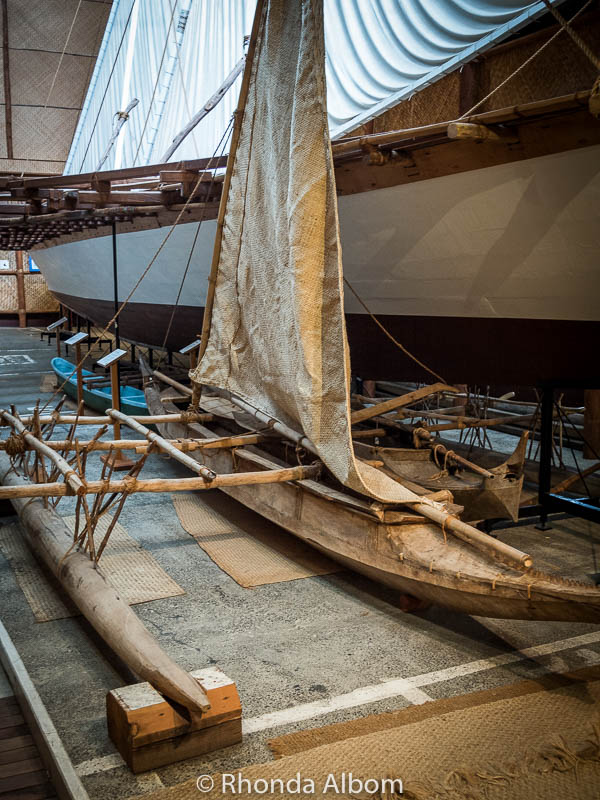
Polynesian outrigger canoes from the Cook Islands
We took all three of these shots on Rarotonga in the Cook Islands. The first two were modern racing vessels. The third is a historic waka outside the Cook Islands Museum and Library.
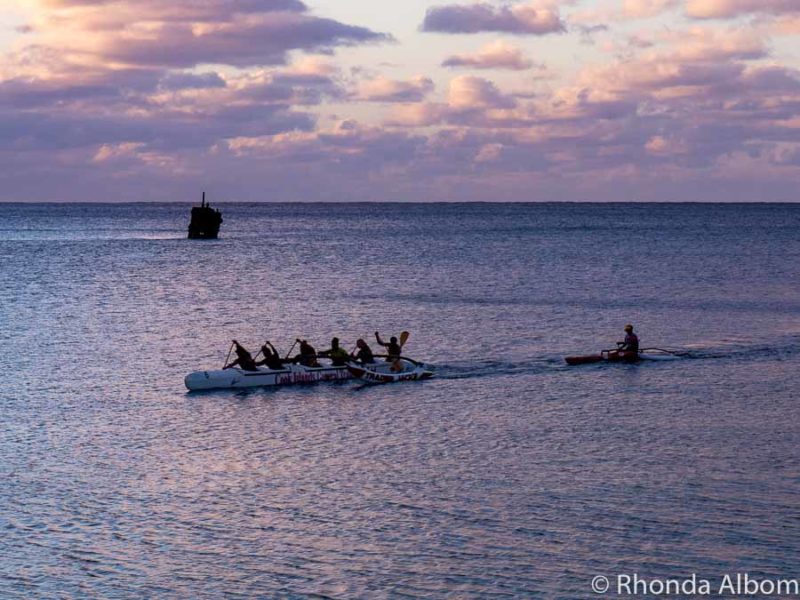
Canoes from French Polynesia
French Polynesia consists of over 100 islands stretching for more than 2,000km. The capital Papeete is located on the island of Tahiti , one of the better known of the islands.
We have visited a few of these islands but captured photos of Polynesian outrigger canoes only in Moorea.
Where to have your own outrigger experience
We are always on the lookout for new experiences that have great reviews from people who have tried them. Here are three that are now on our radar:
- Outrigger Canoe Surfing in Honolulu, Hawaii An exciting way for the entire family (ages 5+) to catch a wave, this adventure will have you surf three waves as you learn a bit about the history of what was once the official sport of the royal family. Considered so safe, life jackets are not required. Reserve your outrigger canoe surfing experience here.
- Outrigger Canoe Snorkel Tour in Maui, Hawaii Starting from Wailea Beach you will paddle down the south shore to a snorkel spot featuring sea turtles, a variety of fish, and coral that can easily be observed in the pristine waters. You will learn a bit about the culture and celestial navigation from your guide as you paddle to your snorkel spot. Reserve your outrigger canoe snorkel tour here .
- Combo Sunset Cruise & Romantic Dinner in Bora Bora, French Polynesia Not a traditional canoe, as this outrigger vessel is powered, but you will enjoy a two-hour romantic cruise, a glass of champagne, and the sunset along with not more than five other couples. Then you will be taken to the renowned St James Restaurant, where you will have a private romantic dinner at a pre-reserved table. Reserve your cruise and dinner here .
More wooden canoes at the New Zealand Maritime Museum
Documenting New Zealand’s nautical history, the maritime museum in Auckland takes us through the arrival of the nation’s early population. Here are two more images of single-hulled canoes without outriggers.
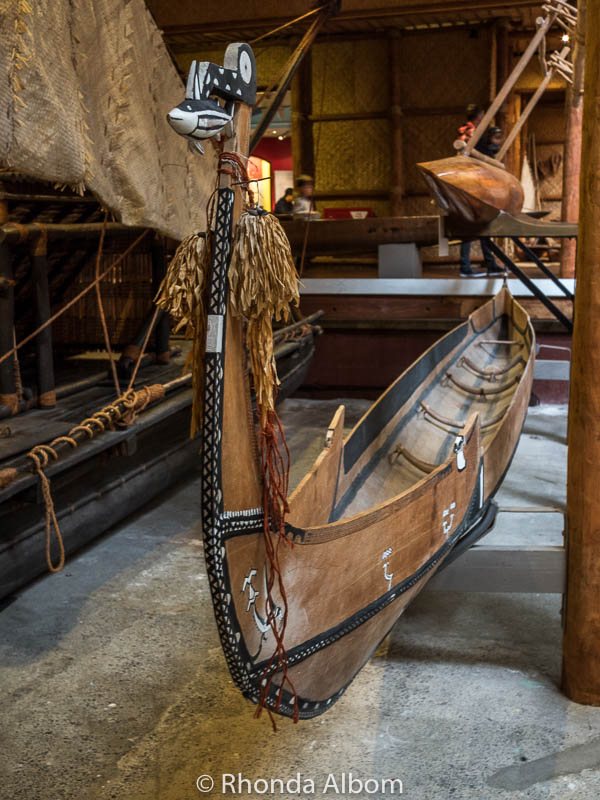
Practical information and tips for visiting the museum in Auckland
- The museum is at Auckland’s Viaduct Harbour at the corner of Quay and Hobson Streets.
- The museum is open nearly every day from 10 am – 5 pm. Also available are optional sailings on the Ted Ashby most days, which offer a chance to get out on the water on a ketch-rigged deck scow. Reserve your often discounted Ted Ashby tickets here .
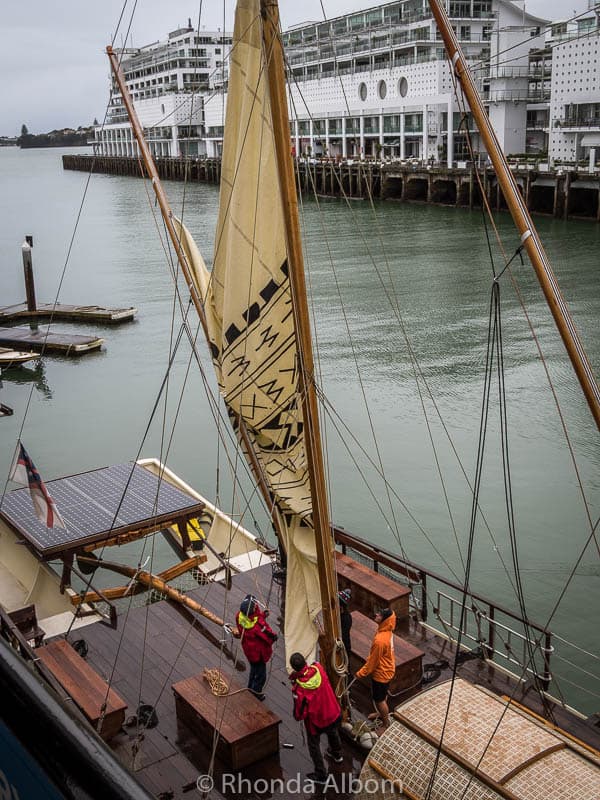
Save on your trip with these resources
These are our go-to companies when we travel. We believe this list to be the best in each category. You can’t go wrong using them on your trip too.
- Flights : we use Expedia for the best and cheapest flight options.
- Accommodations: we use Booking.com (hotels), VRBO (self-contained), or Hostelworld (budget).
- Cars (gas or electric): we use RentalCars to search for deals and dealer ratings.
- Motorcycles : we have heard good things about BikesBooking .
- Campervans or Motorhomes : we use Campstar where Albom Adventures readers get a 3% discount.
- Private guides : we love the private guides at Tours by Locals .
- Travel Insurance: while not required, we always opt for travel insurance and start at InsureMyTrip to compare coverage plans.
Check out our travel resources page for more companies that we use when you travel.
Save for later
If you enjoyed taking a closer look at these Polynesian outrigger canoes, please share this pin on Pinterest:
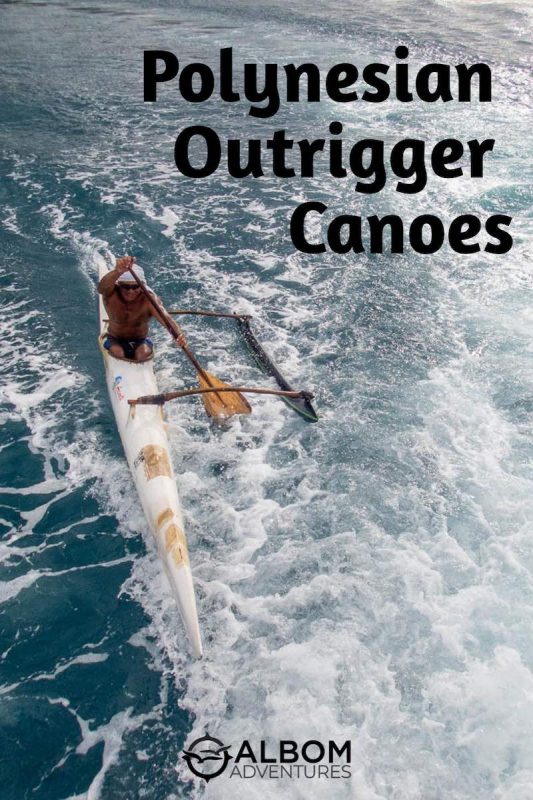
Can you imagine crossing the oceans on one of these Polynesian outrigger canoes?
Other islands you might like to see:

Best Things to Do in Koh Samui, Thailand – Paradise in a Day
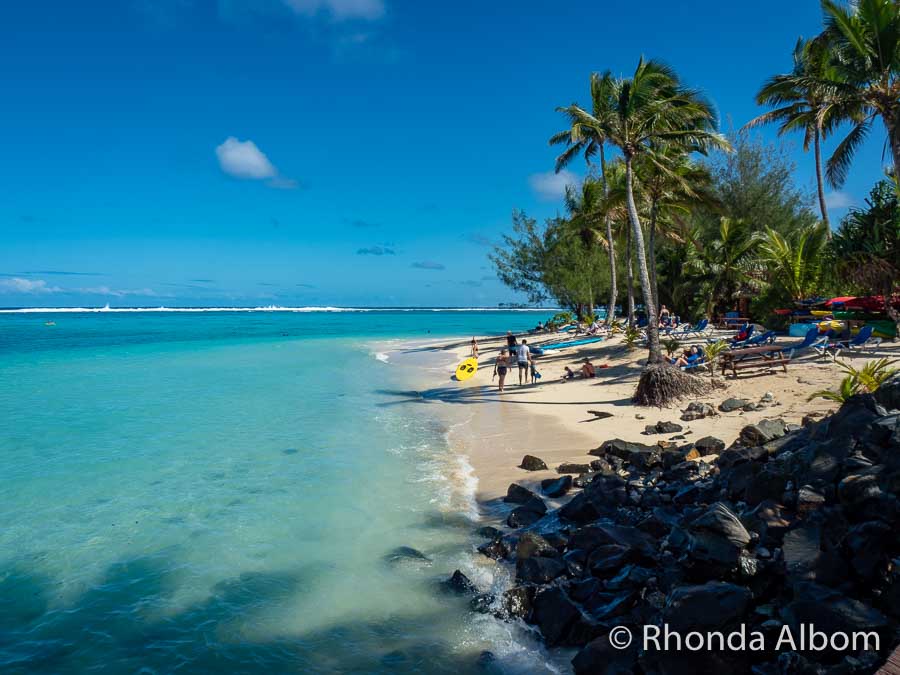
26 Things to Do in Rarotonga: White Sand Beaches, Culture, or Adventure
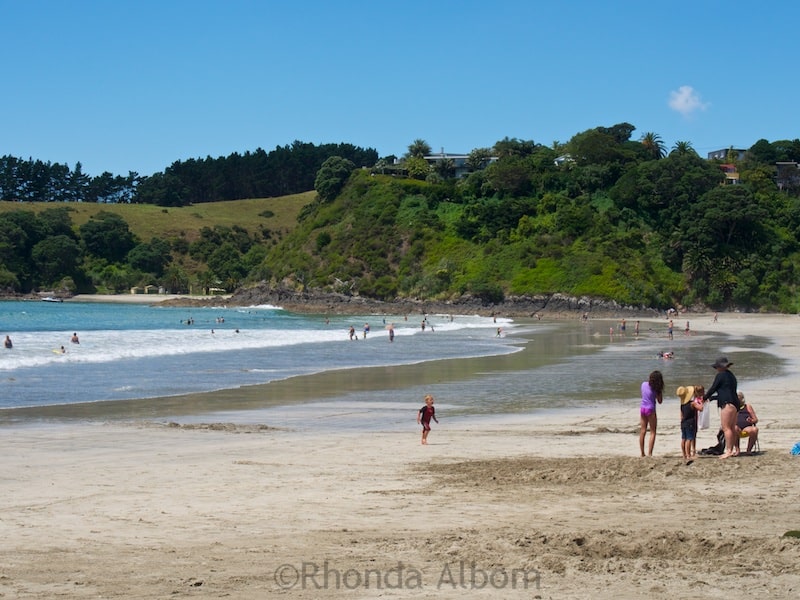
Waiheke Island Beaches: Which is Your Style of Paradise in New Zealand?
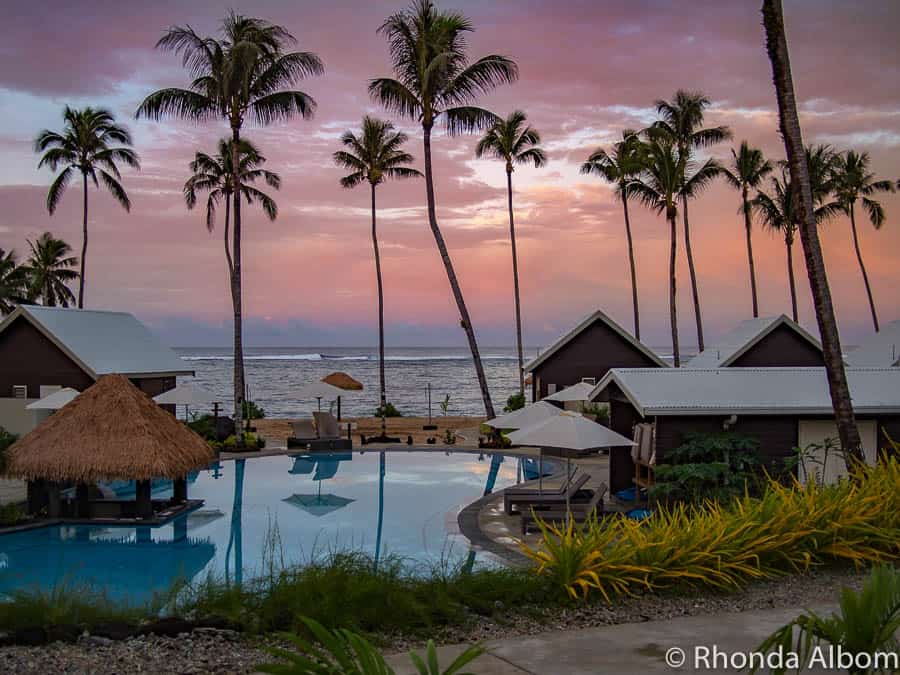
Resort Life vs Living in Samoa: My Window into the Contrasting Lifestyles
For more tips … join Explore New Zealand, the country’s largest NZ travel and photography group on Facebook (free).
About Rhonda Albom
Capturing the essence of travel through photography, Rhonda Albom is the primary author and photographer at Albom Adventures. She is an American expat based in New Zealand. She travels the world with her husband.
Reader Interactions
Glenda Cates
August 3, 2017 at 12:39 am
Lovely and makes me wish I had a boat to take my son out in. Have a great day.
Rhonda Albom
August 4, 2017 at 10:45 pm
A boat like one of these, or something a bit more modern?
August 2, 2017 at 6:31 pm
this is one of my favourite museums because of the details.
Sandy N Vyjay
August 2, 2017 at 2:36 pm
The word Polynesia itself evokes images of exotic beaches and islands for me. The history of New Zealand and how it was discovered is fascinating. The Maritime museum sounds really interesting, a window to the past. The canoes look ingenious and a silent tribute to the skills of the Maoris of yore.
August 2, 2017 at 6:36 pm
I agree, when I hear the word I think of exotic destinations, palm trees, and white sand beaches. The maritime museum is the perfect place to learn about the history and how the cultures intermix.
Siddhartha Joshi
August 1, 2017 at 4:09 am
Excellent post and really enjoyed looking the history of NZ through it’s original inhabitants! Great pictures of the boat too…gorgeous stuff!
July 31, 2017 at 8:52 pm
What an interesting cultural post. I like that they pass down their skills from generation to generation. Thank you for more knowledge.
July 31, 2017 at 11:29 pm
I am always impressed with skills like this that are passed down for hundreds of years.
July 31, 2017 at 4:37 pm
Very interesting post. The craftsmanship of these outriggers are incredible, the pictures definitely brought me there at the museum to appreciate this.
I hope you get a chance to visit live, it’s a wonderful museum.
July 31, 2017 at 2:38 pm
I can’t even imagine making one of these! What craftsmanship. It’s an amazing art!
July 31, 2017 at 11:25 pm
I could imagine making one, but I couldn’t image sailing one.
July 31, 2017 at 9:05 am
How beautiful is that outrigger? I studied anthropology in college, so I know that I would love this museum. It’s so amazing to see how amazingly they used their materials to travel so far. It’s so fascinating!
July 31, 2017 at 11:16 pm
The museum moves through the ancient history really quickly. The rest focuses mostly on the last 150 years.
July 31, 2017 at 12:05 am
What an unusual museum. It looks pretty fascinating
July 31, 2017 at 11:08 pm
It takes visitors through New Zealand’s maritime history.
Megan Jerrard
July 30, 2017 at 6:27 pm
This is quite incredible, I imagine the Polynesian outrigger canoes would have been quite cutting edge technology for their day. It’s quite fascinating to imagine a world of exploration and discovering new lands before we had electronics and motors and all the wonders of knowledge of the modern day. I was really drawn in by the story of Kon Tiki, where Thor Heyerdahl lead an expedition in 1947 across the Pacific Ocean from South America by traditional Polynesian raft. Obviously doesn’t have much to do with New Zealand, but your photos reminded me of that 🙂 Incredible that they crossed oceans in these isn’t it!
July 31, 2017 at 11:01 pm
The boats are pretty impressive for their age, and the balance must be quite incredible for them to sail so far.
Niels Thomas
July 30, 2017 at 5:52 pm
Very interesting read, but also my compliments for your excellent photography skills. Really makes the article stand out. 🙂
July 29, 2017 at 12:02 pm
They are quiet impressive.
July 29, 2017 at 1:23 am
That’s incredible!!
July 29, 2017 at 12:03 pm
They are quite impressive.
Paul F. Pietrangelo
July 28, 2017 at 2:45 am
This was a very interesting blog Rhonda. The binding was different and amazing. I really liked the canoe. How were these Polynesian outrigger made? Did the Polynesian people have materials to create canoe and outriggers? I would like to go on these Polynesian outriggers and see what it likes in the water. Interesting!
Have a great day Rhonda. See ya.
Cruisin Paul
July 29, 2017 at 12:01 pm
These boats are 100% hand carved and tied, from natural ingredients like trees and vines. I wouldn’t want to sail on one for very long. I prefer a bit of luxury.
Mindi Hirsch
July 27, 2017 at 6:45 pm
The Auckland Maritime Museum looks fascinating. In a way, it reminds me of the maritime museum in Palamos (Costa Brava) since both museums provide glimpses into the maritime past.
July 29, 2017 at 11:58 am
How small world. We did a long term home exchanged and lived in Palamos. The two museums are somewhat similar, yet quite different as Palamos seemed to focus on fishing and commercial industry.
July 27, 2017 at 8:31 am
I love reading post like this. I love anything historic really. These canoes are too cool. Hopefully I’ll make it to the museum one day!
July 27, 2017 at 9:13 am
Thnaks Shannon, I love learning about things like this, and really focusing in on the details.
Cindy Ladage
July 26, 2017 at 11:29 pm
I love the story of the canoes and especially the fact that after viewing you can go out and sail in a version of what you just learned about. Awesome!
July 27, 2017 at 9:12 am
The modern waka that you can sail on is quite a bit different as it is required to have all the modern safety standards in place.
Patrick Weseman
July 26, 2017 at 3:15 pm
Wow, what a cool place to visit. Your photos are amazing. I would so love to cool there.
Joyce Lansky
July 26, 2017 at 11:20 am
Wonderful post. As much as I want to voyage to New Zealand, I don’t want to go by boat. 🙂
July 26, 2017 at 6:12 pm
LOL – certainly not one of these boats. There is some modern luxury that would be nice to sail across the oceans.
Alissa Apel
July 26, 2017 at 7:44 am
The details are so artistic. I couldn’t imagine going through all the work involved in making one. I strongly appreciate it.
July 26, 2017 at 6:11 pm
There are still boat makers. When we were in Oman, we saw some of the boat builders who work in teams for five years to hand build a dow boat.
L. Diane Wolfe
July 26, 2017 at 5:50 am
So simple and yet so beautiful!
July 26, 2017 at 6:09 pm
And graceful if you see them sail.
July 26, 2017 at 1:14 am
Fascinating story of ancient migration and cool boats! The child in me always wanted to run away to a tropical island. The practical adult drove to Florida but it’s not really polynesia!
LOL – New Zealand is NOT tropical. We are subtropical. It is winter now, and about 50F right now. Parts of the island even get snow.
indah nuria savitri
July 26, 2017 at 12:14 am
Love all the details, Rhonda..such an incredible collections!
July 26, 2017 at 5:45 pm
I love the details too. Amazing craftsmanship.
July 25, 2017 at 11:20 pm
To my eye, it appears that these would be easy to tip over. I bet they’re sturdier than they look to me, though. Interesting shots!
July 26, 2017 at 5:38 pm
The distance between the hull and the outrigger determines stability: Closer is less stable. Further is more stable.
Hilary Melton-Butcher
July 25, 2017 at 9:20 pm
Hi Rhonda – what a stunning and fascinating museum to be able to look round – and yes ‘how did they do it’ … except we know they managed to use the winds to traverse the oceans … Love the craftsmanship … and it’s wonderful we can re-create the things our ancestors used – to enable us to realise a little more about early life … cheers Hilary
July 26, 2017 at 4:04 pm
They passed the skill down from father to son, using wind, stars, moon, birds and whale migration patterns. They could identify about 150 stars, and used them to find their way. I took a celestial navigation course once, but I was completely lost.
Teresa Kindred
July 25, 2017 at 1:54 pm
I love these! They look so big!
July 25, 2017 at 3:35 pm
I guess I should have put some people in them for perspective. Standing there and thinking about people being on them for months at a time, they looked really small.
Carol L McKenna ~ A Shutterbug Explores
July 25, 2017 at 11:01 am
Fascinating post and great photos ~ looks like a lovely area to visit ~ ^_^
stevebethere
July 25, 2017 at 10:13 am
Nice captures Rhonda interesting and clever 🙂
Have a tanfastical day 🙂
Photo Cache
July 25, 2017 at 10:09 am
What a very interesting cultural post. The photos are wonderful too.
July 25, 2017 at 3:34 pm
It was an interesting way to look at the exhibits I have seen so many times before.
July 25, 2017 at 9:56 am
Great shots of the craftsmanship. I would love to see these for real.
Have a fabulous day. ☺
July 25, 2017 at 3:33 pm
I knew you, my boatie friend, would love these images. If you ever come to New Zealand it will be the first place we take you.
Leave a Reply Cancel reply
Your email address will not be published. Required fields are marked *
Save my name, email, and website in this browser for the next time I comment.
This site uses Akismet to reduce spam. Learn how your comment data is processed .
Privacy Overview
Great choice! Your favorites are temporarily saved for this session. Sign in to save them permanently, access them on any device, and receive relevant alerts.
- Sailboat Guide
Malibu Outrigger
Malibu Outrigger is a 18 ′ 0 ″ / 5.5 m monohull sailboat designed by Warren Seaman starting in 1952.

Rig and Sails
Auxilary power, accomodations, calculations.
The theoretical maximum speed that a displacement hull can move efficiently through the water is determined by it's waterline length and displacement. It may be unable to reach this speed if the boat is underpowered or heavily loaded, though it may exceed this speed given enough power. Read more.
Classic hull speed formula:
Hull Speed = 1.34 x √LWL
Max Speed/Length ratio = 8.26 ÷ Displacement/Length ratio .311 Hull Speed = Max Speed/Length ratio x √LWL
Sail Area / Displacement Ratio
A measure of the power of the sails relative to the weight of the boat. The higher the number, the higher the performance, but the harder the boat will be to handle. This ratio is a "non-dimensional" value that facilitates comparisons between boats of different types and sizes. Read more.
SA/D = SA ÷ (D ÷ 64) 2/3
- SA : Sail area in square feet, derived by adding the mainsail area to 100% of the foretriangle area (the lateral area above the deck between the mast and the forestay).
- D : Displacement in pounds.
Ballast / Displacement Ratio
A measure of the stability of a boat's hull that suggests how well a monohull will stand up to its sails. The ballast displacement ratio indicates how much of the weight of a boat is placed for maximum stability against capsizing and is an indicator of stiffness and resistance to capsize.
Ballast / Displacement * 100
Displacement / Length Ratio
A measure of the weight of the boat relative to it's length at the waterline. The higher a boat’s D/L ratio, the more easily it will carry a load and the more comfortable its motion will be. The lower a boat's ratio is, the less power it takes to drive the boat to its nominal hull speed or beyond. Read more.
D/L = (D ÷ 2240) ÷ (0.01 x LWL)³
- D: Displacement of the boat in pounds.
- LWL: Waterline length in feet
Comfort Ratio
This ratio assess how quickly and abruptly a boat’s hull reacts to waves in a significant seaway, these being the elements of a boat’s motion most likely to cause seasickness. Read more.
Comfort ratio = D ÷ (.65 x (.7 LWL + .3 LOA) x Beam 1.33 )
- D: Displacement of the boat in pounds
- LOA: Length overall in feet
- Beam: Width of boat at the widest point in feet
Capsize Screening Formula
This formula attempts to indicate whether a given boat might be too wide and light to readily right itself after being overturned in extreme conditions. Read more.
CSV = Beam ÷ ³√(D / 64)
It is said the MALIBU OUTRIGGER was the very beginning of the American west coast ‘beach cat’ phenomenon. PROA/outrigger with single daggerboard on main hull, which could be launched off the beach in moderate surf conditions. The first boats were built by members of Malibu Yacht Club. (at this time, by no means, a ‘yachtie’ establishment). From plans intended for amateur (plywood) construction. A general write up appeared in a 1959 issue of ‘Popular Mechanics’ and shown in the 1964 hit film ‘Endless Summer’. There probably never was a ‘professional’ builder. It is thought that at least 1000 boats were completed to this basic design, though very few are seen today.
Embed this page on your own website by copying and pasting this code.
- About Sailboat Guide
©2024 Sea Time Tech, LLC
This site is protected by reCAPTCHA and the Google Privacy Policy and Terms of Service apply.
What is an Outrigger Canoe? Everything You Need to Know
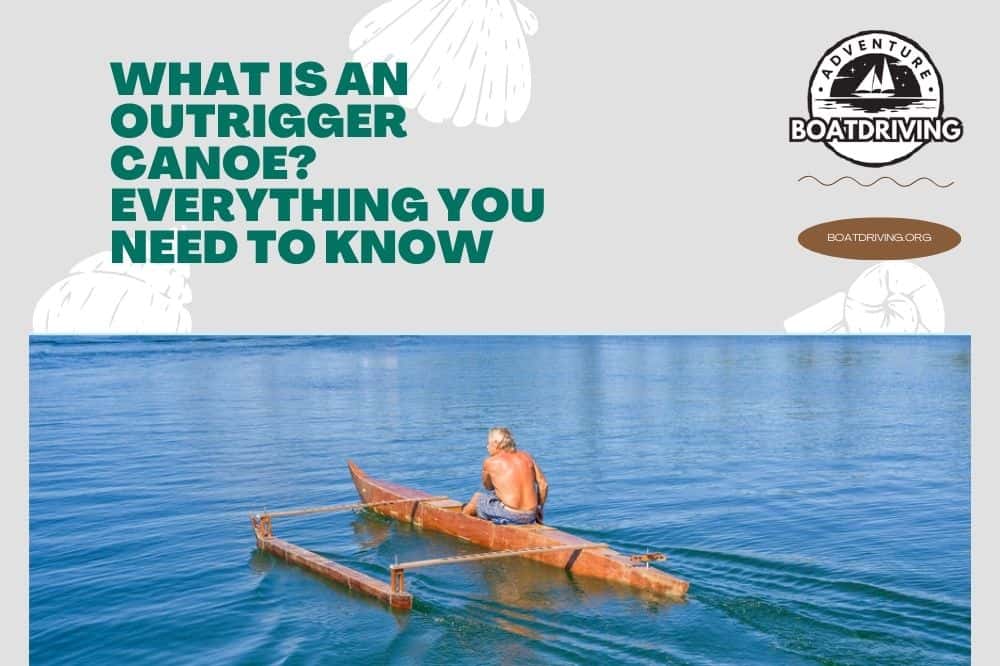
Outrigger canoes are quintessential reminders of Austronesian roots- purposed to navigate through rough ocean conditions. Over the years, outriggers have evolved from a means of ancient sea travel into adrenaline-packed racing vessels.
Table of Contents
A Way To Sea Life
Making of the ancient outrigger canoe, the modern-day outrigger, types of outrigger canoe, outrigger canoe parts, paddling an outrigger canoe, outrigger canoe racing, outrigger canoe tours, outrigger canoe manufacturers.
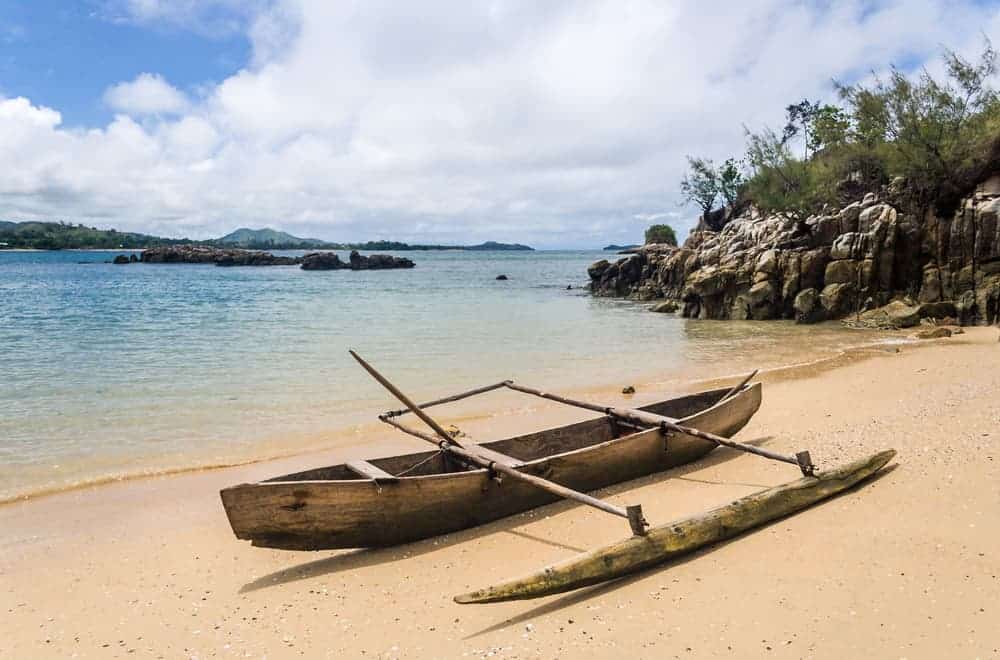
With a hot beverage in hand, I sometimes reflect on all the commodities of life, realizing that our generation is undoubtedly the most fortunate throughout history in terms of access and privilege.
So, next time you find yourself walking to your local corner store or driving to your favorite wholesale department store, take a second to imagine what life must have looked like thousands of years ago.
Separated from the mainland by at least 2,000 miles exist thousands of islands spread out amidst the vast blue waters of the Pacific Ocean. And this is why you would have a hard time convincing me that another culture could respect the ocean as much as the inhabitants of these islands.
For the Austronesians that lived 5,000 years ago, it became evident that a well-constructed vessel would be necessary for transporting people and goods amongst the vast expanse of the various groups of archipelagos.
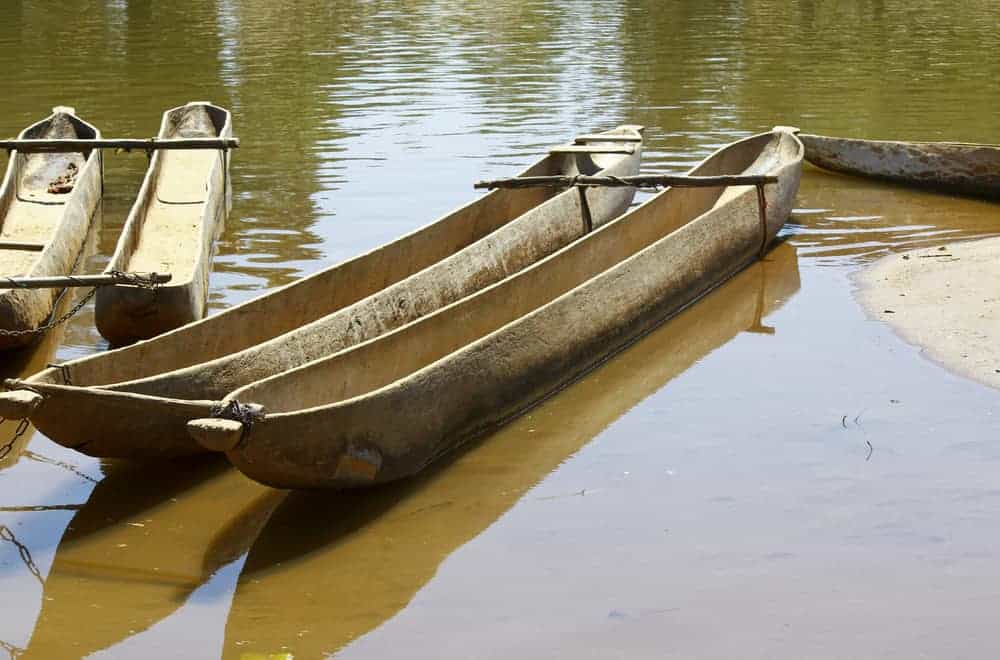
Interwoven with a culture of brave explorers, innovative builders, and exquisite cuisine is a spiritual realm only understood by the land’s indigenous peoples.
Both curiosity and necessity demanded extended sea voyages, so ancient fabricators tasked themselves with numerous structural construction and design variations to meet the operational requirements of their fleet.
The outrigger canoe first docked on Hawaiian turf just shy of two millennia ago when early explorers trailed the migratory patterns of birds. As of 1986, outrigger canoeing has been Hawaii’s official state team sport- still recognizing the earliest ancient traditions.
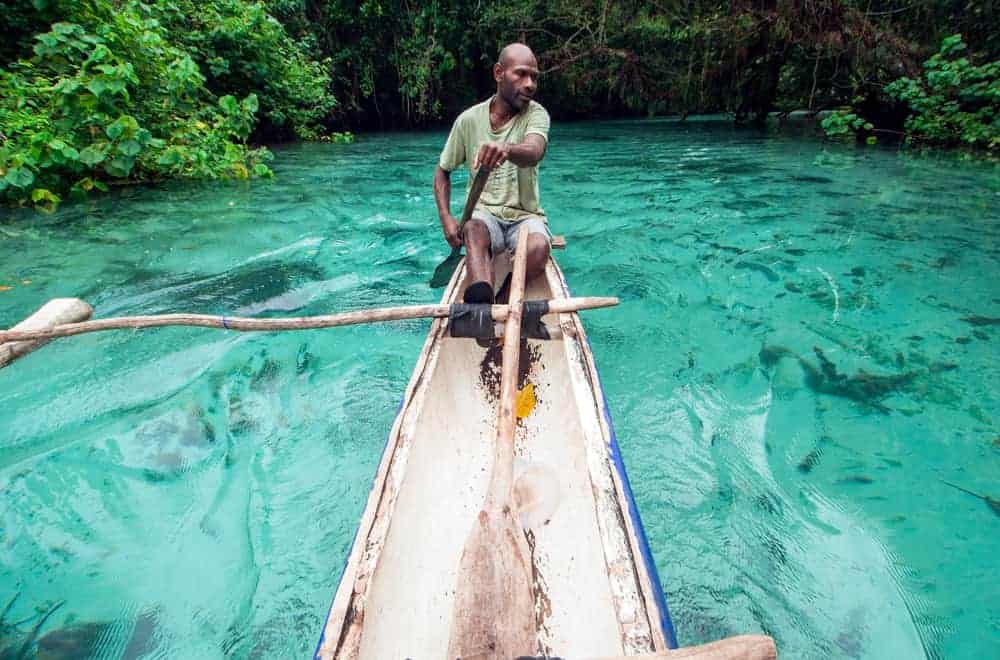
Outrigger canoes come in smaller and larger configurations depending on their primary purpose- fishing, island hopping, or longer voyages. As you can imagine, crafting a boat out of a single tree log was no easy task.
The building process of the wa’a (Hawaiian for canoe) intertwined practicality, ceremony, and careful engineering every step of the way. From the initial selection of a tree to its first launching, the experience and sensibility of the kahuna kalai wa’a (canoe-building specialist) were essential.
If revelation granted the approval of a particular tree to the kahuna , then the building process could begin. Early settlers and Hawaiians alike found that the island’s native koa trees would become the preferred wood for the boat’s hull.
Crafted from a single tree trunk, it would take months, if not years, to complete a sea-worthy vessel. A finished product, depending on size, could weigh between hundreds to thousands of pounds.
In addition to the koa tree, artisans relied on wood from the kukui (candlenut) and ulu (breadfruit) trees. A mix of softer and harder woods would ultimately make up the various parts of the build.
Workers utilized various handmade tools, including chisels, drills, and hammering stones; however, the adze was the most valuable asset for the cutting, chipping, and shaping the traditional outrigger canoe.
Banana and pandanus leaf, cordage from coconut fibers, feathers, roots, and oils carefully bound together, caulked, and even waterproofed these vessels for a safe voyage.
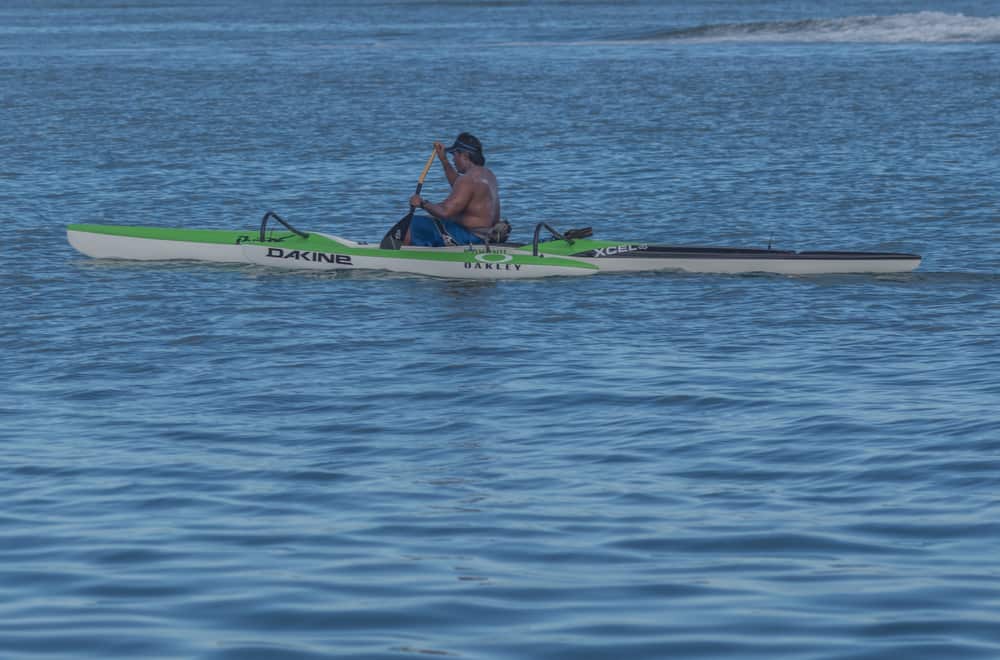
I can certainly envision the early Austronesians competing for bragging rights amongst their villages for having the fastest outrigger canoe. The sport suffered many ups and downs; however, modern outrigger canoe racing experienced a revival once Hawaii’s earliest racing club formed in 1908.
Outrigger canoe racing has become one of the leading intramural school activities within the Hawaiian school system, but the sport has reached international acclaim at the professional level.
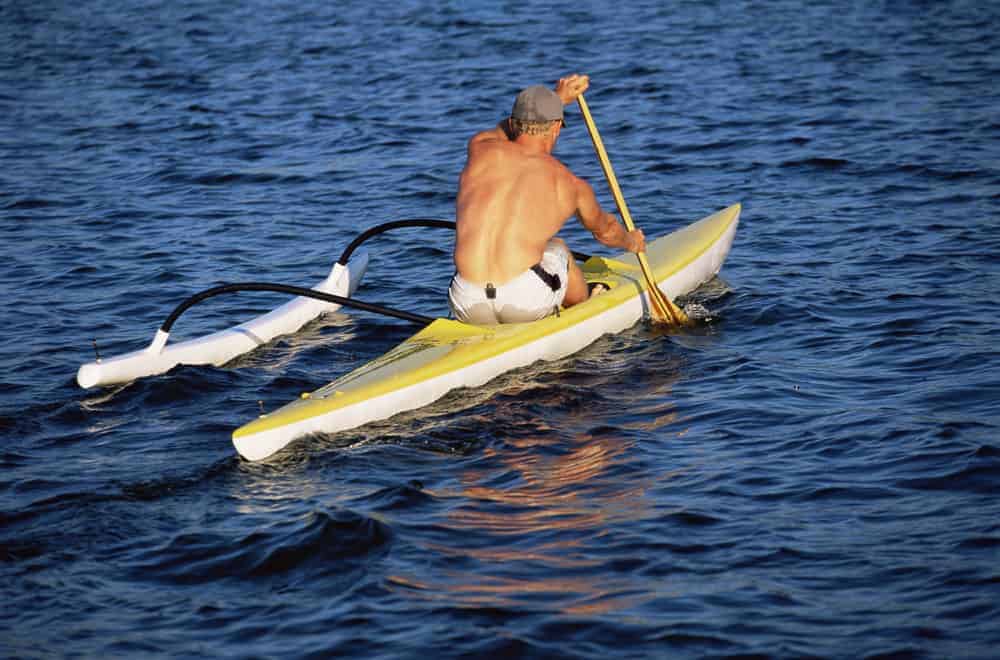
Though modern outriggers have turned to contemporary materials such as fiberglass, molded plastic, Kevlar, and aluminum- its design is reminiscent of ancient times.
The purpose behind the outrigger, or lateral float, is to provide stability to the canoe. Furthermore, ancient and modern versions may host either a single or double outrigger.
While the single outrigger is an essential stability mechanism for short travel and net fishing, the larger double outrigger configurations are more robust for handling deep-sea voyages.
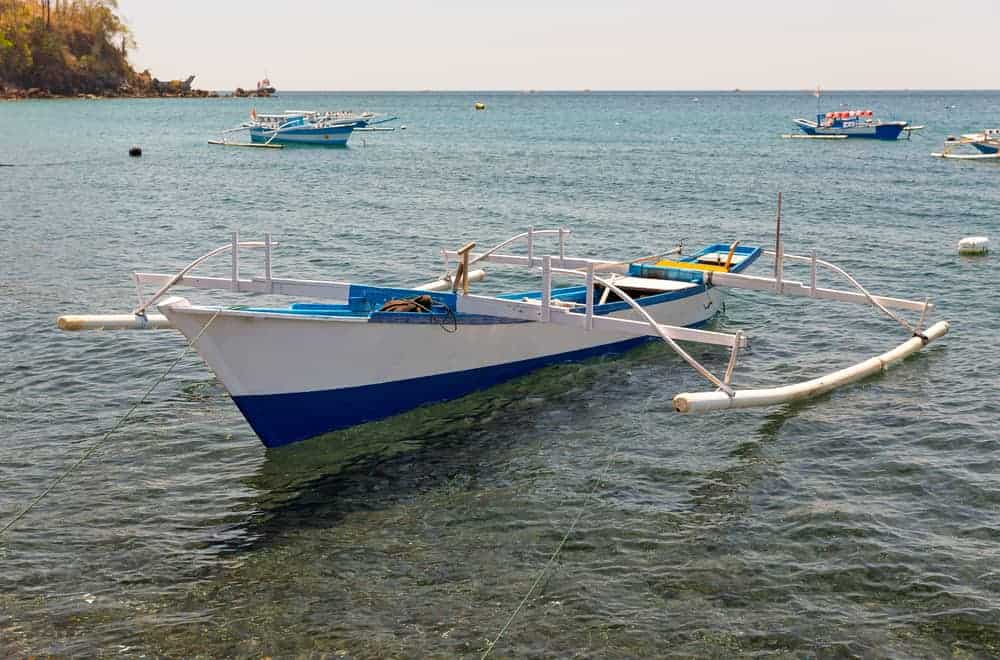
Another similarity between past and present is the versatility of the outrigger canoe. These dynamic vessels can be paddled or sailed depending on the length and conditions of the journey ahead.
Besides this, the main parts of the outrigger canoe closely follow its ancient design. Therefore, you must ensure proper rigging of the three main features of the outrigger canoe , which include the hull, boom, and float for optimal buoyancy and stability on the water.
While terms may differ slightly due to the various cultural transformations dating from the earliest Austronesian influences to the modern-day Hawaiian language, here is a list outlining the anatomy of the outrigger canoe:
- Ka ‘Ele : hull
- ‘Lako : boom
- Muku : outboard portion of the boom (where you rig it to the canoe)
- Manu O Ka ‘Lako : knobs on the float where lashing is tied
- Ama : float
- Aha : lashing (rope)
- Pale : gunwale (top piece of hull’s sides)
- Manu Ihu : bow end piece (front)
- Manu Hope : stern end piece (back)
- Lupe : forward portion of the float
- Kanaka : aft portion of the float
- Noho Ana Wa’a : seat
- Hoe : paddle
- Pe’a : sail
- Paepae : the sail’s boom
Please note that I sourced these terms from two places: a Hawaiian Canoe-Building Traditions and a Hawaiian Paddle Sports article focusing on the history of the outrigger canoe.
Paddling an outrigger canoe is quite different from typical rowing or kayaking. Without the proper technique, form and function are in jeopardy.
Often the payload carried medicinal plants, animals, food, and other goods from one island to the next. So besides sturdy construction, each member had a particular function and responsibility for the efficient operation of the canoe .
Outrigger canoes range from individual use or teams of up to six persons in the racing world. Each tea.0m member fulfills a specific role and must be attentive to the call-and-response commandeering of the canoes steersperson.
Suppose you are interested in learning more about outrigger canoe racing or would like to experience a guided tour. In that case, I recommend that you first watch Nappy Napoleon’s Paddling Instructional For Outrigger Canoe’s.
The official Hawaiian state sport has spread rapidly across the worldwide aquatic community. So chances are, if you find yourself near the water, you may see an outrigger canoe.
The primary purpose of an outrigger canoe association is to preserve the ancient traditions of the wa’a along with promoting the sport. In addition, organized races foster new friendships, competition, fitness, and camaraderie.
For more information about outrigger canoe racing , please request information from one of the following:
- Northern California Outrigger Canoe Association
- The American Canoe Association
- East Coast Outrigger Racing Association
- International Va’a Federation
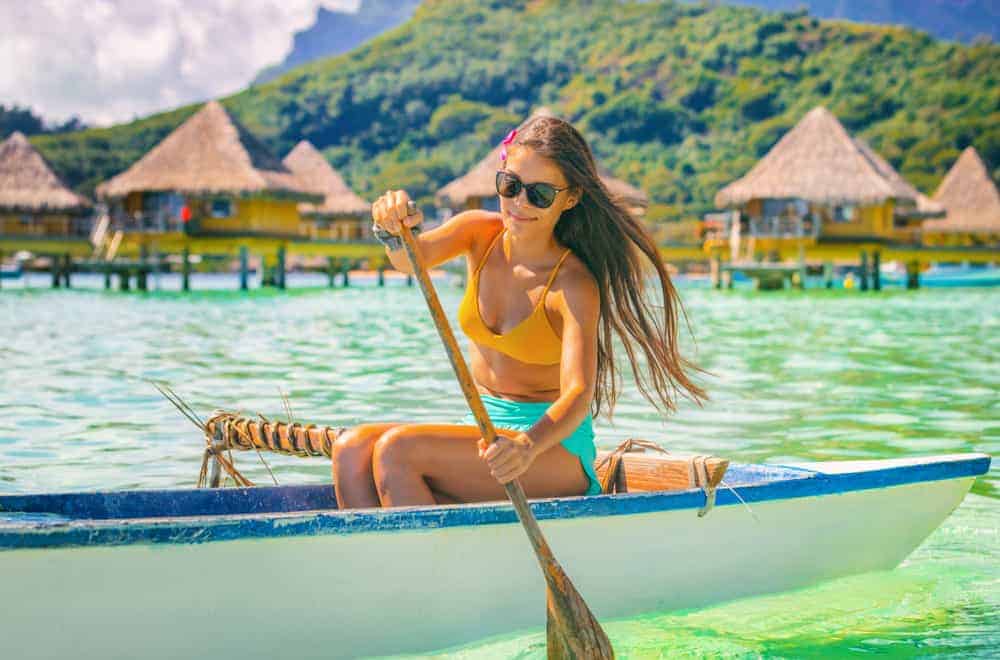
One of my dreams, yet to be fulfilled, is to explore the natural beauty of the Hawaiian archipelago. Although, one trip to Hawaii may not be enough to master an outrigger canoe’s complete art and skill or become a racing professional.
However, borrowing from the experience of a trusted guide, you have the opportunity to enjoy snorkeling with green sea turtles, whale watching, canoe surfing, and more with one of these fantastic outrigger canoe tour operators:
- Maui Outrigger Canoe Tours: Owned and operated tours hosted by Hawaiian Paddle Sports offer an exciting balance of history, culture, wildlife, and adventure.
- Hawaiian Ocean Sports: Ancestral knowledge passed down through generations is what culture is all about. When you book an outrigger canoe tour with this company, you are signing up for a lot more than just a thrilling ride upon the water. You and your family will indeed walk away with an unforgettable experience marked by traditional Hawaiian values.
- Blue Soul Maui Exclusive Tours: If your definition of fun is getting splashed by a breaching humpback whale, learning the history of the wa’a (Hawaiian for canoe), meeting sea turtles, and enjoying a cool beverage with traditional ukelele music in the background, then head on over to Blue Soul to book your tour.
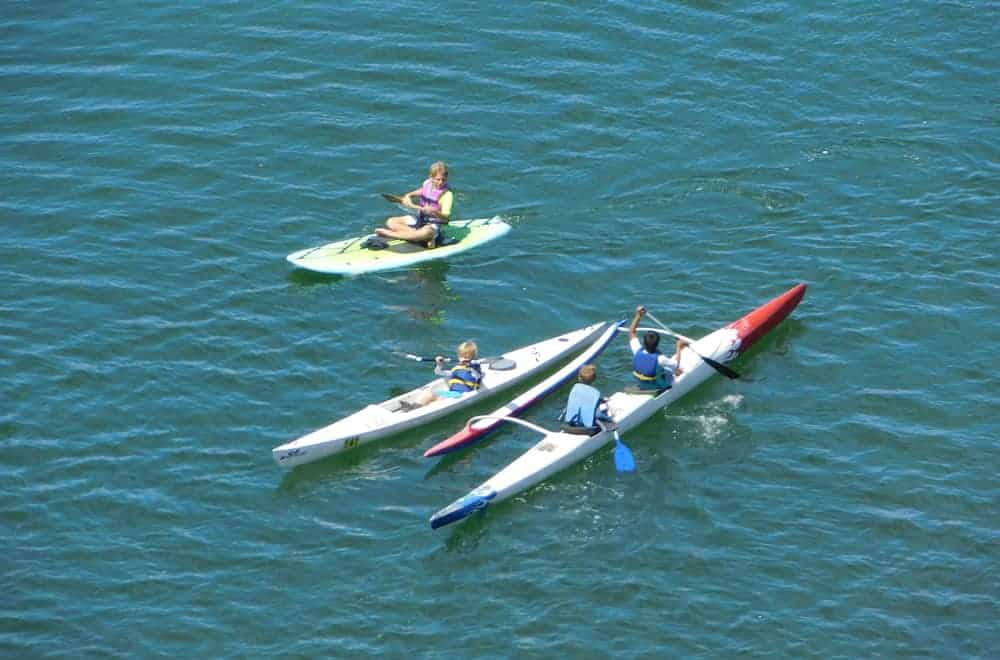
If containing your excitement about outrigger canoeing is as hard for you as it is for me, then you can plan to splurge a little on yourself this upcoming tax season.
Here are some outstanding manufacturers of outrigger canoe’s that understand the true blessings that the ocean gives to us:
- Holopuni Canoes : With over fifty years of experience in hand-crafting outrigger canoes, Owner Nick Beck found that a three-manned thirty-foot hull delivered the best configuration in lightness and ruggedness to handle both light and more extreme conditions on the water. Whether you prefer leisurely paddling, more extreme sailing out to sea, or desire your canoe to be retrofit with a small outboard motor for fishing, this native Hawaiian family company does it all.
- Kamanu Composites: Born in 2007, this friendly group of composite technicians, artists, paddlers are focused on providing their passionate customers with locally sourced and sustainable outrigger canoes. This lively crew offers various build options and whether you desire a custom-build or purchase an off-the-shelf canoe, rest assured that you will be hitting the waves with precision style.
- Puakea Designs: Founded by world-renowned technical coach Johny Puakea, the Puakea Designs company combines his paddling experience with his father’s traditional crafting techniques to produce world-class outrigger canoes built for speed.
Once you recognize yourself as a man or woman of the water, you have a deeply endowed connection with nature- that in return is so happy to call you a son or daughter.
Remember, you do not need to be a member of an exclusive canoe club or participate in a racing competition to enjoy outrigger canoes . You can experience leisure, fishing, wildlife exploration, surfing, and more in the wa’a .
If you would like to know more about the outrigger canoe, please leave your questions or concerns in the comment section below.

Joseph Fabiano is a writer, nature enthusiast, and stay-at-home father of two wild and free boys. He enjoys starting his day with a good run, hot mug of coffee, and a jump in the Ionian Sea, no matter the weather. Currently based in the Apuglia region of southern Italy, he enjoys discovering the world with his best traveling buddies (his little monkey’s and beautiful wife) at every given opportunity. Every trip, long or far, should be made an adventure according to Joseph as he believes inspiration and creation is right in front of you.
Related posts:
- How to Choose A Trolling Motor for Your Canoe?
Leave a Comment Cancel reply

Outrigger Magazine
Outrigger Canoe (bangka), Puerto Galera, Philippines. The outrigger canoe (Filipino and Indonesian: bangka; Māori: waka ama; Hawaiian: waa; Tahitian: vaa) is a type of canoe featuring one or more lateral support floats known as outriggers, which are fastened to one or both sides of the main hull. Smaller canoes often employ a single outrigger on the port side, while larger canoes may employ a single outrigger, double outrigger, or double hull configuration (see also catamaran). The sailing canoes are an important part of the Polynesian heritage and are actively raced and sailed in Hawaii and Tahiti. Using an outrigger or double hull configuration greatly increases the stability of the canoe, but introduces much less hydrodynamic inefficiency than making a single hull canoe wider. Compared to other types of canoes, outrigger canoes can be quite fast, yet are also capable of being paddled and sailed in rougher water. This paddling technique, however, differs greatly from kayaking or rowing. The paddle, or blade, used by the paddler is single sided, with either a straight or a double-bend shaft. Because there isn't a dual paddle arrangement, the paddler has to alternate sides often in order to maintain stamina and stability. The outrigger float is called the ama in many Polynesian and Micronesian languages. The spars connecting the ama to the main hull (or the two hulls in a double hull canoe) are called iako in Hawaiian and kiato in Māori (with similar words in other Polynesian languages); in Micronesian languages, the term aka is used. The traditional pōpao of Tonga. Hawaiiloa, a double hull sailing canoe built as a replica of Polynesian voyaging canoes. Outrigger canoes were originally developed by the Austronesian speaking peoples of the islands of Southeast Asia for sea travel, and were used to transport these peoples both eastward to Polynesia and New Zealand and westward across the Indian Ocean as far as Madagascar during the Austronesian migration period. Even today, it is mostly among the Austronesian groups (Malay, Micronesian, Melanesian and Polynesian peoples) that outrigger canoes are used. Outrigger fishing canoes are also used among certain non-Austronesian groups, like the Sinhala in Sri Lanka, where they are known as oruwa, as well as among some people groups in the Andaman and Nicobar Islands. The ethnological significance of this spread has been studied by James Hornell. When Magellan's ships first encountered the Chamorros of the Mariana Islands in 1521, Antonio Pigafetta recorded that the Chamorros' sailboats far surpassed Magellan's in speed and maneuverability. The Polynesian Voyaging Society has two double hull sailing canoes, Hōkūlea and Hawaiiloa, and sails them between various islands in the Pacific using traditional Polynesian navigation methods without instruments. The technology has persisted into the modern age. Outrigger canoes can be quite large fishing or transport vessels, and in the Philippines, outrigger canoes (called bangka, parao or balanghai) are often fitted with petrol engines. The links between seafaring and outrigger canoes in the Philippines extend through to political life, in which the smallest political unit in the country still called Barangay after the historical Balanghai outrigger proas used in the original migrations of the first Austronesian peoples across the archipelago and beyond. Modern Outrigger sport Outrigger racing has become a popular canoeing sport, with numerous clubs located around the world. Outrigger Canoe Racing is the State sport of Hawai'i and an interscholastic high school sport. In Hawai'i entire families participate in summer regattas with age groups from manini (children as young as 6 with an adult steersperson) and age 12 through age 60+. Major races in Hawai'i include the Moloka'i Hoe (43 mile men's race from the island of Moloka'i to 'Oahu across the Ka'iwi Channel), Na Wahine O Ke Kai (same race for women) and the Queen Lili'uokalani Race held near Kona on the Big Island of Hawai'i. Racing outrigger canoes. The canoe in the front right, with a narrower hull and smaller body, is a single person outrigger canoe, or OC1. The other canoes are six person outrigger canoes, or OC6. Six person outrigger canoes (or OC6) are among the most common used for sport use; single person outrigger canoes (or OC1) are also very common. Two and four person outrigger canoes are also sometimes used, and two six person outrigger canoes are sometimes rigged together like a catamaran to form a twelve person double canoe. Modern OC6 hulls and amas are commonly made from glass-reinforced plastic. However, some canoes are made of more traditional materials. In Hawaii, canoes were carved from the trunks of very old koa trees. These canoes, although rare, are still very much in use today. The iako are usually made of wood; the iako-ama and iako-hull connections are typically done with rope wrapped and tied in interlocking fashion to reduce the risk of the connection coming completely apart if the rope breaks. Modern OC1 hulls and amas are commonly made from glass-reinforced plastic, carbon fiber reinforced plastic, and/or Kevlar to produce a strong but light canoe. OC1 are often made with rudders operated by foot pedals. More traditional designs do not have rudders. OC1 commonly use ʻiako made of aluminium, with a mechanism for quickly assembling and disassembling the canoe (snap buttons, large wing nuts, etc.). Links to Outrigger Canoe Clubs and Information Polynesian Voyaging Society Takia Outrigger Canoe Club Fiji Northern California Outrigger Canoe Association Hawai'i Association and Race Links Hawaiian Canoe Racing Association Queen Lili'uokalani Canoe Race (Kai 'Opua) Moloka'i Hoe Na Wahine O Ke Kai Japan Outrigger Canoe Network World of Boats at Eyemouth ~ Outrigger Canoes: Tongan Pao Pao Fijian Proa Traditional Papuan Single Outrigger Original Outrigger Canoe (Drua) in the Fiji Museum An Introduction to Outrigger Canoe Paddling Orchid Outriggers - Experience photo tours in handmade outrigger canoes on the central coast of California. An interactive for kids featuring a traditional outrigger canoe commissioned by the National Museum of Australia Dragon Boat and Outrigger Canoe website "The Longest Canoe Paddle in Modern History" Article about outrigger canoe trip to the Northwest Hawaiian Islands Hawai'i. Maui No Ka 'Oi Magazine Vol. 11, No. 1 (January 2007). "Canoes That Carve" Article about surfing outrigger canoes Hawai'i. Maui No Ka 'Oi Magazine Vol. 11, No. 3 (May 2007). "Master Strokes." Article about outrigger canoe club in Haleiwa, Hawai'i. Hana Hou! Vol. 10, No. 3 (June/July 2007). New hope outrigger - Complete online resource to the sport and history of outrigger canoeing. Travel Services - Book your travel to your next Reggatta

The outrigger canoe – in Hawaiian it is called a waʻa ( vah-ah) – is a type of canoe featuring one or more lateral support floats known as outriggers which are fastened to one or both sides of the main hull. Smaller canoes often employ a single outrigger on the port side, while larger canoes may employ a single-outrigger, double-outrigger, or double-hull configuration (see also catamaran). The sailing canoes are an important part of the Polynesian heritage and are raced and sailed in Hawaii, Tahiti, Samoa and by the Māori of New Zealand.

Using an outrigger or double-hull configuration greatly increases the stability of the canoe, but introduces hydrodynamic inefficiency relative to making a single-hull canoe wider. Compared to other types of canoes, outrigger canoes can be quite fast, yet are also capable of being paddled and sailed in rougher water. This paddling technique, however, differs greatly from kayaking or rowing.
The Names of Our Canoes
(name, brand of canoe, the racing number, and meaning of the name in English):
Laulima (Mirage) 88A Literally means many hands. Means working together, cooperation.
No’io o ka ie’ie (Bradley Striker) 88B To the best of our knowledge, No’io is a white bird formerly used for navigating to land, o ka ie’ie means of the high …relating to being in the sky.
Oliliko o Makahuena (Bradley Lightening) 88C Refers to the sparkling or shimmering we often see on the water as we return at sunset from Makahuena
Nai’a Uli Uli (Mirage) 88D Blue Dolphin
Keoneloa (Bradley Lightening) 88E Long sand–refers to the bay on which the Grand Hyatt is situated
Rai (Mirage) 88F The Tahitian word for sky.
Kamakani O Maha’ulepu (Bradley Lightening) 88J Refers to the wind found at Maha’ulepu.
Ka Lae o Ka’iwa (Bradley Lightening) 88K Refers to the point at the entrance to Lawai Kai bay.
Liko (Matahina) 88L Named for a young man named Liko who made it safe for his people to go into the waters near Kukui’ula Harbor and Spouting Horn by luring the menacing mo’o (dragon) into the tubes of spouting horn where it got stuck–and can still be heard moaning to this day. Liko also refers to the shimmering of the sun on the water, and the bud–or newly formed blossom of a flower.
Lele i Ke Kai (Matahina) 88M Means to fly or leap across the sea.
Anatomy of an Outrigger Canoe

Parts of the Canoe
Hawaiian names for the parts of an outrigger canoe with English translations:
- ama (float/outrigger)
- hoe (a paddle; to paddle)
- ‘iako (spars, boom)
- manu kupe (curved end pieces covering the fore and aft parts of the hull; to steer a canoe)
- mo’o (gunwale)
- muku (ends of ‘iako that extend beyond the hull)
- wae (spreaders)
- wa’a (canoe, also va’a , waka )

How To Build An Outrigger Sailing Canoe
Hey there! So, picture this: you’re out on the open water, gliding along in your very own outrigger sailing canoe. Sounds pretty amazing, right? Well, guess what? You can actually build one yourself! In this article, I’m going to show you step by step how to construct your very own outrigger sailing canoe. Trust me, if I can do it, so can you.
We’re going to start by gathering all the necessary tools and materials. Then, we’ll dive into the design and planning phase to make sure we get everything just right.
Next, we’ll construct the hull of the canoe, followed by building the outrigger and attaching it securely. Once that’s done, we’ll install the sailing rig and mast, making sure everything is shipshape.
But we’re not done yet! We’ll finish and seal the canoe to ensure its durability and longevity. Then, it’s time to test and adjust the canoe’s stability and performance, because safety is key.
And finally, we’ll delve into sailing techniques and safety precautions before you embark on your very first sailing adventure.
Ready to get started? Let’s build that outrigger sailing canoe together!
Key Takeaways
- Choose lightweight and durable woods for construction, such as cedar, mahogany, or plywood.
- Design and plan the canoe based on the intended use, considering dimensions, shape, weight, and stability.
- Construct a strong hull using lapstrake or strip planking techniques, reinforcing joints and seams with epoxy or fiberglass tape.
- Install the outrigger and sailing rig, ensuring proper balance, stability, and maneuverability.
Gather the Necessary Tools and Materials
To begin constructing your outrigger sailing canoe, you’ll need to gather all the necessary tools and materials. Choosing the right type of wood for your canoe is crucial. Opt for lightweight and durable woods such as cedar, mahogany, or plywood. These materials will provide the necessary strength and flexibility for your canoe to withstand the rigors of sailing.
Additionally, finding a suitable location to build your canoe is essential. Look for a spacious area with ample ventilation and enough room to accommodate the canoe’s size. A garage or backyard with a flat surface would be ideal.
Once you have gathered all the tools and materials and found the perfect location, you can move on to the next step of designing and planning your canoe, ensuring every detail is carefully considered.
Design and Plan Your Canoe
To successfully create your own high-performance watercraft, it’s essential to carefully design and strategize every aspect of your personalized vessel. When it comes to designing an outrigger sailing canoe, there are several important design considerations to keep in mind.
First, think about the intended use of your canoe. Will you be using it for racing, cruising, or a combination of both? This will help determine the overall dimensions and shape of the canoe.
Additionally, consider the weight and balance of the canoe, as this will affect its stability and maneuverability on the water.
Once you have a clear design in mind, it’s time to choose the right materials. Lightweight yet durable materials, such as fiberglass or carbon fiber, are often preferred for outrigger canoes. These materials provide the necessary strength and rigidity while keeping the overall weight of the canoe low.
With your design considerations and materials selected, you are now ready to construct the hull of the canoe.
Construct the Hull of the Canoe
To construct the hull of the canoe, start by laying out the framework. Carefully connect the sturdy ribs and beams that will form the strong and sleek shape of your future vessel. Use building techniques such as lapstrake or strip planking to ensure a sturdy and durable hull.
Each rib should be securely attached to the keel and beams, creating a rigid structure that can withstand the forces of the water. Once the framework is complete, reinforce the joints and seams with epoxy or fiberglass tape for added strength.
Regularly inspect and maintain the hull, checking for any signs of damage or wear. Sand down any rough spots and apply a fresh coat of marine-grade paint or varnish to protect the wood from the elements.
With the hull complete, you can now move on to building the outrigger and attaching it to the canoe, ensuring stability and balance on the water.
Build the Outrigger and Attach it to the Canoe
Once the sturdy framework of your canoe’s hull is complete, it’s time to expertly craft and securely attach the outrigger, enhancing the stability and balance of your watercraft. To attach the outrigger, follow these steps:
- Measure and cut the outrigger beam to the desired length, ensuring it extends beyond the hull on both sides.
- Attach the outrigger beam to the hull using sturdy bolts or screws, ensuring a secure connection.
- Install the outrigger float on the outer end of the beam, ensuring it is properly aligned with the hull.
By attaching the outrigger, you enhance the balance and stability of your canoe, making it more suitable for sailing in various conditions. The outrigger provides additional support and prevents the canoe from tipping over.
With the outrigger securely attached, you are ready to move on to the next step of installing the sailing rig and mast.
Install the Sailing Rig and Mast
With the addition of the sailing rig and mast, your canoe will become a magnificent vessel capable of conquering the vast open waters. When it comes to choosing the right sailing rig for your outrigger canoe, there are several different types to consider. The most common options include the lateen rig, the lug rig, and the sprit rig. Each rig offers unique advantages and disadvantages in terms of ease of use, maneuverability, and performance.
In terms of mast materials, the most popular choices include aluminum, wood, and carbon fiber. Aluminum masts are sturdy and durable, but they can be heavy and may require additional reinforcement. Wood masts are traditional and aesthetically pleasing, but they require regular maintenance to prevent rot and warping. Carbon fiber masts are lightweight and strong, providing excellent performance, but they can be expensive.
Next, we will discuss how to create and attach the rudder and steering system, which will complete the transformation of your canoe into a fully functional sailing vessel.
Create and Attach the Rudder and Steering System
After successfully installing the sailing rig and mast, it is now time to focus on creating and attaching the rudder and steering system. This step is crucial as it allows for proper control and maneuverability of the outrigger sailing canoe.
To ensure the longevity and efficiency of the rudder and steering system, it is essential to prioritize proper maintenance and care. Regular inspection and lubrication of the moving parts are necessary to prevent any potential issues.
When constructing the rudder and steering system, it is vital to choose the right materials. Opt for durable and corrosion-resistant materials such as stainless steel or marine-grade aluminum. These materials will withstand the harsh marine environment and provide a long-lasting solution.
In conclusion, by implementing proper maintenance practices and selecting the right materials, the rudder and steering system will function optimally, ensuring a safe and enjoyable sailing experience.
Now, let’s move on to the subsequent section and learn how to finish and seal the canoe, ensuring its durability for years to come.
Finish and Seal the Canoe
To ensure the longevity and durability of your newly constructed watercraft, it’s crucial to carefully finish and seal the canoe. Choosing the right type of finish is essential. Look for a marine-grade varnish or epoxy specifically designed for watercraft. This will provide a protective layer against the elements, preventing damage from UV rays and water exposure. Apply multiple coats as instructed by the manufacturer to achieve a smooth and glossy finish.
Properly sealing the seams of your canoe is also vital. Use a marine-grade sealant or epoxy to seal any gaps or joints in the hull. Apply the sealant evenly, ensuring that all areas prone to leaks are covered. This will keep your canoe watertight, preventing any water from entering the hull.
Once the canoe is finished and sealed, it’s time to test and adjust its stability and performance.
Test and Adjust the Canoe’s Stability and Performance
Before taking your newly finished and sealed canoe out on the water, it’s important to test and make any necessary adjustments to ensure its stability and performance. Testing the canoe’s stability can be done using various methods, such as performing a stability test by adding weights or using a stability index formula. By conducting these tests, you can identify any areas of weakness and make adjustments accordingly, such as adding ballast or modifying the hull shape. It’s also essential to optimize the canoe’s performance by testing its speed and maneuverability. This can be done by taking the canoe out on the water and evaluating its handling characteristics under different wind and wave conditions. By gathering this data, you can make further adjustments, such as fine-tuning the rigging or adjusting the sail size. Once you have tested and adjusted the canoe’s stability and performance, you can move on to learning sailing techniques and safety precautions for your outrigger canoe adventure.
Learn Sailing Techniques and Safety Precautions
Once you’ve mastered the art of navigating the open water, you’ll gain a new appreciation for the intricate dance between wind and sail. Sailing techniques play a crucial role in maneuvering your outrigger sailing canoe effectively.
Here are three key techniques to enhance your sailing skills:
Tacking and Jibing: Learn the art of changing direction by turning your boat into the wind (tacking) or away from the wind (jibing). Mastering these techniques will allow you to sail efficiently against the wind and make smooth transitions.
Sail Trim: Properly adjusting the sail’s position and tension is essential for optimal performance. Experiment with different settings to find the perfect balance between power and control.
Reading the Wind: Understanding wind patterns and how they affect your sail is crucial. Pay attention to wind direction, gusts, and shifts to make informed decisions while sailing.
Safety measures are equally important. Always wear a life jacket, carry a whistle for emergencies, and check the weather conditions before setting sail.
Now, equipped with sailing techniques and safety precautions, you can embark on your first sailing adventure.
Embark on Your First Sailing Adventure
Embarking on your first sailing adventure requires careful planning and consideration. Here are some important factors to keep in mind:
Choose a sailing location with calm waters and minimal boat traffic. This will ensure a safe and enjoyable experience, especially if you are still learning the ropes of sailing. Avoid areas with strong currents or unpredictable weather conditions, as these can be challenging for beginners.
Consider the proximity to land and the availability of rescue services. It’s always better to be prepared for emergencies, so make sure you have access to help if needed.
Plan your route carefully, taking into account the wind direction and potential hazards. Familiarize yourself with the area and be aware of any reefs or shallow waters that could pose a risk to your journey.
By selecting the right sailing location and planning your route carefully, you can set yourself up for a successful and memorable first sailing experience.
Frequently Asked Questions
What are some common mistakes to avoid when constructing the hull of the canoe.
Common mistakes to avoid when constructing the hull of a canoe include improper laminate application, inadequate reinforcement, and poor alignment of the panels. Following construction tips such as using quality materials and ensuring proper curing can help prevent these errors.
How long does it typically take to complete the entire construction process?
On average, the entire construction process of an outrigger sailing canoe takes around 6 months. To ensure efficient construction, it is important to have a well-planned schedule, proper tools, and skilled labor.
Are there any specific weather conditions that are best for testing the canoe’s stability and performance?
The best time to test the stability and performance of an outrigger sailing canoe is in calm weather conditions with minimal wind and waves. Testing methods include conducting controlled maneuvers and analyzing the canoe’s response to different conditions.
What type of maintenance is required to keep the canoe in good condition?
To keep the canoe in good condition, it is important to use the best cleaning techniques such as washing with mild soap and water. Regularly inspect the hull for any damage and promptly fix it to prevent further issues.
Are there any specific licenses or permits required to sail a canoe?
To legally sail a canoe, specific permits and licenses may be required depending on the jurisdiction. It is important to research and comply with the legal regulations governing sailing activities in your area.
After months of hard work and dedication, my outrigger sailing canoe is finally complete. The feeling of accomplishment is like reaching the summit of a mountain.
Every tool and material used, every design decision made, has resulted in a masterpiece that is ready to take me on countless adventures.
The hull is sturdy, the outrigger is secure, and the sailing rig is perfectly balanced.
Now, it’s time to set sail and let the winds guide me towards new horizons.
The world is my oyster, and I am the captain of my own destiny.

Hi, I’m Liz! I love spending time outdoors and enjoying nature. Whether it’s camping, hiking, or just exploring new areas, I love getting out there and experiencing everything that the world has to offer.
I’m also an outdoor enthusiast who loves helping others enjoy the great outdoors too. I’ve been a camp counselor and outdoor education instructor for kids of all ages, and I really enjoy teaching people about nature and getting them excited about being in the wilderness.
How To Haul Canoe In Truck
What Is A Canoe Yoke

You may like
How to draw a canoe.
The first step in learning how to draw a canoe is to draw the shaft. You will need to draw a grip on the shaft and a curved line inside the canoe. Next, draw the paddle’s blade and elongated oval. You will also need to draw two curved lines across the hull of the canoe. Once you’ve completed these steps, you are ready to begin drawing your canoe.
Push-away stroke
The push-away stroke is the opposite of the traditional paddle stroke. The push-away stroke is more efficient because it moves the boat away from the paddler’s side. For the push stroke, the paddler should have his or her arms extended, with the blade facing the water. The paddler then pulls the paddle back toward him or her while pushing with the shaft hand. The paddler then recovers the blade for the second draw stroke.
The stern stroke is used to turn the boat away from the paddling side. The sternperson’s strokes will turn the boat further away from the pivot point of the boat. This can make the paddling less efficient and lead to increased instability. To prevent capsizing, the stern person should use the following stroke, which pushes the stern back in line. The push-away stroke is the most effective when the bowperson is paddling alone.
The forward stroke is the most common type of canoe stroke. It involves positioning the blade at an angle to the canoe’s centerline and drawing it straight back. The push-away stroke is also called the “J” stroke because the paddler is on the side, but pushing the water in the opposite direction. A J-stroke can be used for long paddle trips, as it is efficient and provides course corrections. If you practice it often, it can become second nature and a great way to paddle for long periods of time.
The push-away stroke is a type of paddle stroke that is similar to the pry stroke, but is performed differently. As with the pry stroke, the paddle is held vertically above the gunwale and is pushed away from the hull. The push-away stroke is more awkward and requires more force than the pry stroke. Unlike the pry stroke, however, the push-away stroke utilizes the force more effectively.
To execute the push-away stroke, the paddler must position the paddle blade at an angle of about 20 degrees above the center line. The paddler should also position their shoulders in the water and pivot their shoulders to draw the blade back straight. This allows the paddler to keep the blade parallel to the water. Once the paddler completes the draw, he should track the right side of the canoe.
Cross-draw stroke
When drawing a canoe, it’s important to use the appropriate stroke for the conditions. The cross-draw stroke is similar to the draw stroke, except that it’s done on the opposite side of the boat. Performing this stroke correctly will improve your control of the boat and make it much easier to paddle. It’s also a good way to practice turning. Here are some tips for performing this stroke.
The J-stroke is the simplest turning stroke and can help you steer the canoe in many situations. When used correctly, it can help you enjoy long days out on the water. Practice making turns using the J stroke while sitting in the stern of the canoe. If you’re a novice paddler, it will help you turn quickly. When you’re finished practicing the J stroke, you’ll be able to apply it with confidence.
The cross-draw stroke is a useful maneuver for sharp turns. It’s similar to the pitch stroke, but it requires you to stretch your hand out over the water. It’s an effective stroke when used in a canoe, so practice it in slow speeds before you decide to try it at high speeds. This technique also helps you learn the proper way to paddle in tight turns. In addition to this, it will make it easier to keep your paddling style consistent.
For a faster stroke, try using the cross-draw stroke. By using the cross-draw stroke, you’ll be able to gain momentum as you draw your canoe forward. This technique can help you gain control over your boat. It’s also a great way to increase your endurance. When practicing your cross-draw stroke, it’s important to keep your eye on the water.
The cross-draw stroke is more efficient than the J-stroke when drawing a canoe. This technique requires less muscle, which means you’ll end up with a longer stroke. Moreover, you’ll be able to increase your power to stroke ratio. By using the cross-draw stroke when drawing a canoe, you’ll be able to achieve the perfect balance between speed and power.
Running pry stroke
The running pry stroke is the opposite of the pry stroke and is applied with the blade of the paddle parallel to the canoe’s gunwale. This stroke allows the paddle to move sideways without allowing the canoe to hit anything, and it also slows down the boat. While rowing, keep the paddle blade parallel to the boat and the grip hand over the paddle shaft. The paddle blade should be parallel to the back of the canoe.
The running pry is applied while the canoe is moving. The paddle blade is turned sideways while bracing itself against the gunwale. This force is not generated by force but by the motion of water. This technique slows down the canoe when paddling for long distances. This stroke is a great choice for beginning paddlers. However, it can be difficult to master and requires some experience.
In general, you will want to keep the top hand stationary during the stroke, since it will be acting as the pivot point. You will be making small adjustments in the angle while you’re drawing. You will also want to use a wrist roll if your bow is not completely vertical, as this will make the stroke difficult. However, it’s worth the extra effort to make this stroke work. If you need a more precise angle adjustment, you should use the Superior stroke.
The sweep and the run are complementary strokes that will help you steer your canoe smoothly and efficiently. When used in tandem, they work in harmony to steer the canoe and create the most stability. Ultimately, they must be used in combination to get the most out of the strokes. If you don’t do this, your canoe will lose balance and will not steer well. With practice, you’ll be able to master the sweep and j-stroke.
The bow draw is another accessory stroke, and it’s used to close the turn radius during an eddy. While it’s not as powerful as the running pry, it’s also easier than the outside turn. As it starts to turn, the leading edge of the bow paddle should open up. The leading edge of the bow paddle acts as a brake, so it’s important to have a wide leading edge.
Indian stroke
When you draw a canoe, you use a fundamental stroke, which propels the canoe forward. Many paddlers are unaware of this stroke because it is the most basic and is often wrongly executed. A paddling trip leader from the AMC New York-North Jersey Chapter yells, “vertical paddle!” on outings. This technique involves using the grip hand to draw the canoe across the water .
The Canadian stroke is similar to the J stroke, but there is less push out. The grip hand is in the canoe during recovery, usually in the middle of the chest. The paddle has a slight pitch, which helps the boat move correctly and gives the impression that it is lifting water. The paddle used for this technique should be thin and straight, because it is most easily corrected when the paddle is pitched up. In addition, a straight shaft paddle is best for this stroke.
The J-stroke is similar to the J-stroke but incorporates steering during the recovery phase. It starts like the standard forward stroke but ends with the leading edge of the paddle being turned down aggressively. This maneuver increases the efficiency of the J-stroke in flatwater. It is also useful for correcting the direction of a canoe that has turned too far to the side. The J-stroke is an excellent choice for solo paddlers who don’t want to use a canoe-steering partner.
The draw stroke is another common canoe technique. It starts the same way as the draw stroke, but arcs the paddle downward nearly under the canoe. It ends with a slight burst outward. By following these steps, you can effectively draw a canoe. There are many different strokes to choose from, so make sure you practice all three! You’ll be amazed at how effective and fun they are.
When you’re first learning the stroke, practice in a safe environment. If you have any difficulty, you can learn from a skilled guide. Remember, you’ll be doing many strokes while on a canoe trip, so if you’re using bad form, you’ll quickly burn out. If you’re unsure of which stroke is correct for you, ask a guide to demonstrate it.

I love the outdoors. From camping and hiking in the wilderness, to simply spending time outside surrounded by nature, I enjoy it all. I’m experienced in both backpacking and car camping, and have even done a bit of thru-hiking on the Appalachian Trail.
I grew up in a small town in upstate New York and spent most of my childhood exploring the forests and hills around my home. My parents were always active outdoors people, so I was lucky to be introduced to these activities at an early age.
Beginners Guides
Canoe paddle sizing.
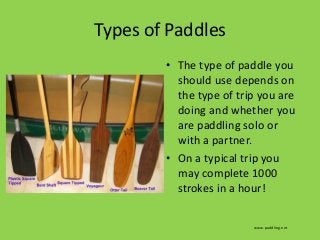
When buying a canoe paddle, the sizing factor depends on your body type and size. Choosing the right length, blade width, and material of the paddle can enhance your canoeing experience and give you more confidence while paddling. In this article, we’ll discuss the different aspects of paddle sizing and how to choose the best canoe paddle for your body type. After reading this article, you’ll be ready to find the perfect paddle for your next canoe adventure!
Proper canoe paddle sizing depends on body type and size
There are several factors to consider when choosing the right size paddle. The length of the shaft, the width of the boat, and the height of the seat will determine the proper size. Paddle lengths vary considerably, but they should be within a reasonable range. A paddle that fits properly will be long enough for the blade to rest above the chin while the upper hand remains comfortably in front of the face.
The length of the canoe paddle shaft, or “throat,” should be adjusted according to the body type and size of the paddler. A longer shaft is better suited for deep lakes, while a shorter blade will be more efficient on a river. The length of the paddle shaft will also be affected by the length of the canoe paddle blade. The overall length of a paddle is also determined by the height of the seat over the water.
The length of the canoe paddle should be adjusted according to the size of the boat. The most common interval for paddle length is three inches. Some paddles are sized at two inches, while others are measured at six inches. The width of the boat and the length of the paddle should be adjusted accordingly, but you should consider your height, body type, and size when choosing the proper length.
There are a few factors to consider when choosing the right canoe paddle. First of all, do not confuse a canoe paddle with an oar. An oar is a different watercraft propelling device that is attached to the gunwales of the boat and is used by two people at a time. They are similar in many ways, but have important differences.
For example, an oval shaft is easier to hold and results in less arm fatigue. Another important factor is grip. Some paddlers prefer a palm grip or T-grip. Whatever style you choose, it should fit comfortably in your hand. Choosing the correct grip will make paddling easier and more comfortable. This is especially important for beginners as they don’t want their hands to cramp.
The overall canoe paddle length is the distance from the seat of the canoe to the water. This measurement is also called “shaft length.” Standard canoe blades measure twenty inches. However, you can find paddles of different lengths, shapes, and sizes. Read on to find out the correct length for you. Listed below are tips for choosing the right paddle for your canoe. And don’t forget to choose the correct paddle grip size!
To determine the proper paddle length, lie on your back. Your knees should be six inches off the floor. Next, take a paddle and hold it with your upper grip hand at nose level. Now, measure the distance from the floor to your nose. Then, take the measurement from there. Using a tape measure, you can also check if the paddle is too short or too long. Remember to account for the extra height the grip adds to the length.
The length of the canoe paddle depends on your size and body structure. Measure the length of your torso while sitting on a chair and add two inches to it. If you’re paddling from the stern of the canoe, you’ll need a shorter paddle, and vice versa. If you plan to paddle from the center of the canoe, it will be longer than the stern.
Another important factor when selecting the proper paddle length is the blades of the paddle. Longer blades require a longer paddle, while short blades will reduce the strain on your shoulders. In addition to the blade length, the tip is another important feature to consider. This part is the bottom part of the canoe paddle. The tip is where the blade makes contact with the water and will help you paddle in a smooth, controlled manner.
The shaft of a canoe paddle can be either straight or bent. The straight shaft is usually two inches longer than its bent counterpart, and is easier to grip than the bent version. Straight shafts are the most popular and versatile and will work for most paddling situations. You can also find bent-shaft canoe paddles in the market. If you have a bent-shaft canoe paddle, make sure to buy the correct length as you’ll be using it frequently.
Blade length
The size of the blade of a canoe paddle is an important consideration. The bigger the blade, the more power the paddle will have. A paddle with a short and skinny blade is not very useful in shallow water because only a small portion of it is under water and will not provide much power. A paddle with a wider blade will provide a lot of power even in shallow water. The size of the paddle blade will also determine the type of paddle you purchase.
Having a longer paddle will increase the power of the stroke and give you more control over the canoe. However, it will take more energy to push the canoe and will cause the paddler to use more force. Also, longer paddles can dig clams in shallow water. They will also make you stand up higher, which can lead to poor posture. Choosing the right blade length will ensure that you get the most out of every stroke.
Once you know the size of the canoe paddle, you can choose the proper blade length. Choose the length based on your height and torso. You should have enough space for your arms and wrist to reach the bottom of the paddle. In addition, you should measure the distance from the seat of your canoe to the bridge of your nose or eye level. If this measurement is not accurate, you can adjust the length to suit your height.
The length and width of the paddle are also important considerations. The blade length and width should be balanced with your style and your ability to paddle. The longer blade will provide more control and finesse and the shorter one will create less turbulence. However, a long paddle can trip up when you are moving on flat water. As long as you have the paddle that fits you well, you’ll have an enjoyable time on the water.
When you choose a paddle, remember to consider the overall length of your body. The length of the shaft should match your height and the width of your canoe. The blade should also be the same length as your body. By using this guide, you can find the perfect paddle for your canoe. It’s also a good idea to measure your canoe and torso. By using the proper measurements, you will have an ideal paddle with a shaft length that matches your body’s needs.
Ovalized shaft
Ovalized shaft canoe paddles are shorter than standard ones. You should measure the length of the paddle’s neck and add the blade length. Standard canoe blades are around 20 inches long. The distance from the tip of the paddle to the end of your nose should be the same length. If you have trouble measuring the length of your paddle, you can also use the broomstick technique.
Ovalized shafts are also easier to hold and have better balance. While a standard paddle shaft is a straight tube, some paddlers prefer an oval shape, as it allows them to see the angle at which they’re holding the blade. Paddle shafts can be made from wood or a composite. A plastic insert can be used to ovalize a round composite paddle shaft. Some paddle shafts are fatter than others, and paddlers with small or medium hands will probably find that a slimmer shaft is easier to handle.
For a more comfortable, efficient paddle, an ovalized shaft is an excellent choice. It is easier to hold, and gives you more control when you’re paddling in shallow waters. Oval shaft canoe paddles are less fatiguing. The grip is rounded and helps to keep your hands from becoming fatigued as you paddle. A paddle with an oval shaft is a good choice for beginners and those who want a more balanced stroke.
A wooden paddle is an excellent choice if you want a traditional look. Wood paddles are flexible and warm on the hands. They can be made of several types of wood, including bent shafts and fiberglass-wrapped blades. Wooden paddles are more expensive but also more durable than lighter paddles. They have an oval shape and a wood blade. They’re made from multiple hardwoods and are lightweight, so they’re not so heavy.
Another difference between oval and round canoe paddles is in the length of the paddle’s shaft. An oval shaft can be easier to grip than a round one, which makes them more durable and comfortable to use. Oval shaft paddles also have a wider throat section that makes them easier to hold in the hand. If you’re new to canoeing, it’s worth looking into the sizing chart to make sure your paddle is sized correctly.
How to Paddle Canoe
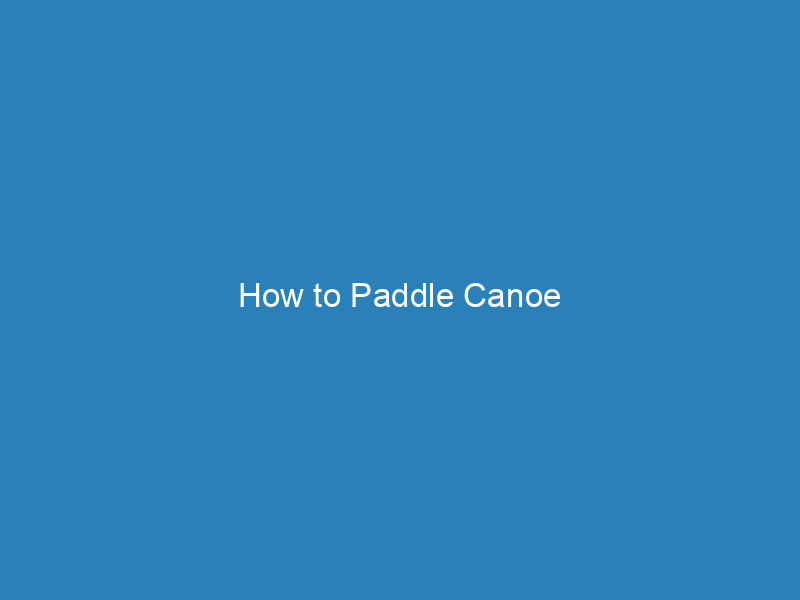
In order to get on the water safely and quickly, you must learn how to paddle canoe properly. There are several basic strokes you must master. These include the Push-away stroke, Indian stroke, Sculling draw stroke, and large back sweep. In this article, we will explore these and other strokes. Once you have mastered these, you’ll be well-equipped to move around on the water. Learn these techniques and enjoy paddling safely.
The push-away stroke has the same purpose as the pry stroke, but is executed differently. This stroke uses more force than the pry stroke and is more awkward. However, it uses the force more effectively and does not damage the paddle. This technique can also be used to slow down or stop a canoe that has forward momentum. Moreover, it can be used by either the stern or bow paddler of a canoe.
The J-stroke is a forward stroke that starts like the standard forward stroke, but then rotates the paddle away from the canoe. This stroke retains the power face of the paddle throughout the motion, reducing the tendency of the canoe to turn while moving forward. It is also known as the “J-stroke” because it traces the letter “J” in the water when performed on the port side.
The push-away stroke starts like a draw stroke, except the paddler turns the paddle blade 90 degrees. It cuts through the water and arcs inward, almost under the canoe. The paddler should slice outward at the end of the stroke so that the stroke does not produce splashes. Once the stroke is complete, the paddler should feel confident in his or her ability to control the canoe.
The push-away stroke is the opposite of the draw stroke. It pushes the canoe away from the paddler’s side. It starts with a paddle blade that is nearly under the canoe. The paddler pulls in with the grip hand while pushing out with the shaft hand. After the paddle has been fully extended, the paddler will recover the blade of the canoe and resume the draw stroke.
The J stroke is a subtle canoe stroke that provides gentle course corrections and ensures a long day on the water. It is also extremely efficient and can be mastered with a little practice. It is the foundation for almost any canoe adventure. There are many variations of the J stroke, but it is generally the most effective. Practice makes perfect! Whether you paddle a canoe solo, with a partner, or in a group, the J stroke is an essential skill to learn.
The Indian stroke can be performed with either a single or double paddle. When paddling right, the paddle rotates 90 degrees counterclockwise, while if paddling left, the paddle rotates clockwise. As you are returning to your first step, it is important to keep your paddle at a low angle. This technique is perfect for sneaking up on wildlife. However, be sure to always follow the directions provided by the instructor and your guide.
The J stroke can be a useful tool for solo canoe steering. It is easier to control the canoe when paddling solo because you flick your wrist at the end of the stroke. However, it can be difficult to coordinate with a partner because of the pause at the end of the power portion. You’ll also want to make sure to keep your wrist moving throughout the entire stroke to maintain your control.
The forward stroke is the most efficient when the paddle blade is fully immersed in the water. It is also the most effective when the arm of the grip hand is horizontal. This arm should be at the same height as your shoulder. The throat of the paddle should be just above the water’s surface. The length of the paddle is also important to maintain its verticality. If the paddle is angled downward, you will have to adjust your stroke accordingly.
Sculling draw stroke
The sculling draw stroke is an effective paddle technique for lateral motion of the canoe. The sculling draw stroke requires full use of the upper body while making a subtle movement with the paddle. The blade should be held at a slight angle – about two feet above the boat – while moving forward. The angle should be as equal as possible, without too much resistance.
The cross draw stroke is a variation of the draw stroke for paddlers in front of the boat. This stroke is similar to the draw stroke, but it is done on the other side of the canoe. While it is a common stroke, it requires a slightly different approach. The blade is pulled towards the paddler as the paddler pulls. The paddler should place his/her hand on the shaft, while the other hand is placed on the grip of the paddle.
The sculling draw stroke is the most basic stroke in canoe paddling. It requires both hands over the water. The top hand should hold the blade steady as the paddle is pulled in. The blade should be deep into the water and then feathered out 90 degrees for recovery. Then, the boat should be tipped away. This allows the boat to slide sideways easier and provides counterbalance to the paddler.
The J stroke is another basic canoe stroke. This stroke is often used by beginners and white water paddlers. Bill Mason called this style the “Goon Stroke.” It is similar to the forward stroke, except that it uses the opposite side of the paddle to straighten the canoe. The J stroke reduces stroke frequency and is more effective. The J stroke is a very basic stroke, but one that can be perfected with practice.
Large back sweeps
When paddling canoes, the back sweep is an important paddle technique. It increases turning speed. However, large back sweeps slow you down and can be difficult to master if you’re new to the sport. Fortunately, there are techniques that can help you achieve this. Listed below are some tips to improve your back sweep technique. Hopefully, one of them will help you get better on your next paddle.
The first thing to remember is that you can perform large back sweeps while paddling canoes. However, you must be aware that this stroke has different form than other strokes. Therefore, it’s important to practice it at slow speeds. The next step is to find an appropriate paddle position for you. If you’re a left-handed paddler, sit at the bow and use your arms to move your hips. If you’re a right-handed paddler, sit on the stern.
The second step is to adjust the angle of the paddle. While paddling canoes, the right angle of the back sweep will help you turn the canoe in the direction you want it to go. In general, you should have an angled paddle at the end of the stroke so that you can pull the paddle upstream to close the angle. You can also adjust the angle by changing sides while paddling.
Finally, the third step is to adjust the size of your stroke. Using a straight shaft paddle is best for beginners. This will make it easier to make subtle corrections during each stroke. When paddling canoes solo, the right stroke will turn the canoe in the opposite direction and provide more control. This is especially important when you’re paddling alone or in strong wind or current.
Silent stroke
Silent stroke when paddling a canoe means that the athlete does not move the paddle. The stroke is the main propulsion of the boat. But when the paddle is out of the water, it will lose velocity. So, how can the athlete maintain a silent stroke while paddling? To make a silent stroke, the athlete must first understand the principle of propulsion. Then, the athlete should try to implement it in a practice session.
The best way to make a silent stroke is by practicing in waist-deep water with a canoe holding onto it. The most efficient catch requires the blade to be buried at the same angle as it hit the water. Pulling back on the bottom arm will make the blade bury at a different angle and cause turbulence throughout the rest of the stroke. Practicing this technique is crucial.
Developing a silent stroke is a technique every canoe paddler should learn. Good technique and posture will allow the canoe to move faster and farther, conserve strength, and make the paddler invisible to the water. If you can achieve these, your canoe will travel farther than before. If you do not have a paddle, it will be harder to propel the canoe, and it will also be more difficult to balance on the water.
Another way to achieve a silent stroke while paddling a canoe is to make a sharp turn. In this case, you should angle your paddle forward, pointing your chin towards the outside of the canoe. Then, you can start a sprint turn. After you have learned how to do a silent stroke, you can practice paddling a canoe with full power.

What Does Douche Canoe Mean

Things to Do For Kids in Redwood National Park California

How To Make A Fibreglass Canoe

How To Build A Canoe Trailer From Scratch

Stillwater Canoe Built By Oldtown What Arethe Demention On The 12 Footer
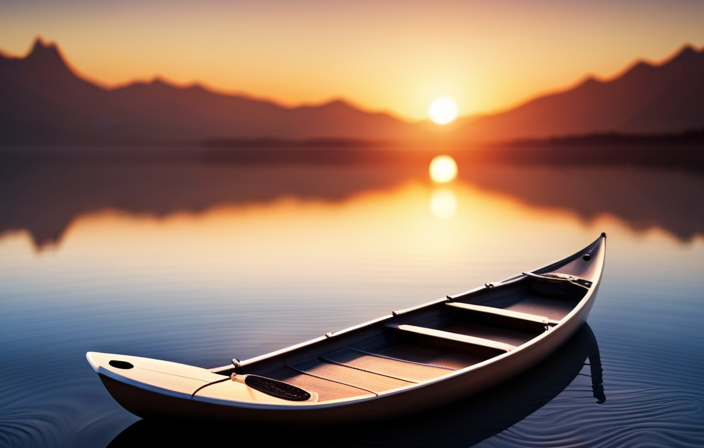
How Much Does A 17 Ft Aluminum Canoe Weigh
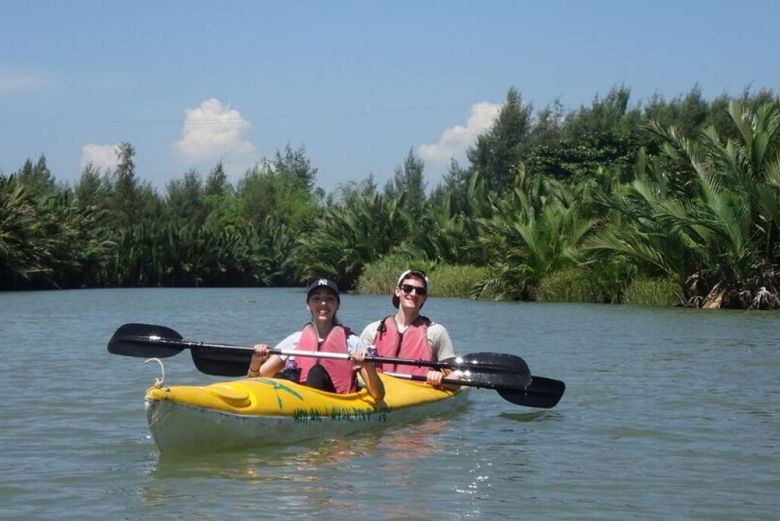
10 Spots for Kayak Exploration
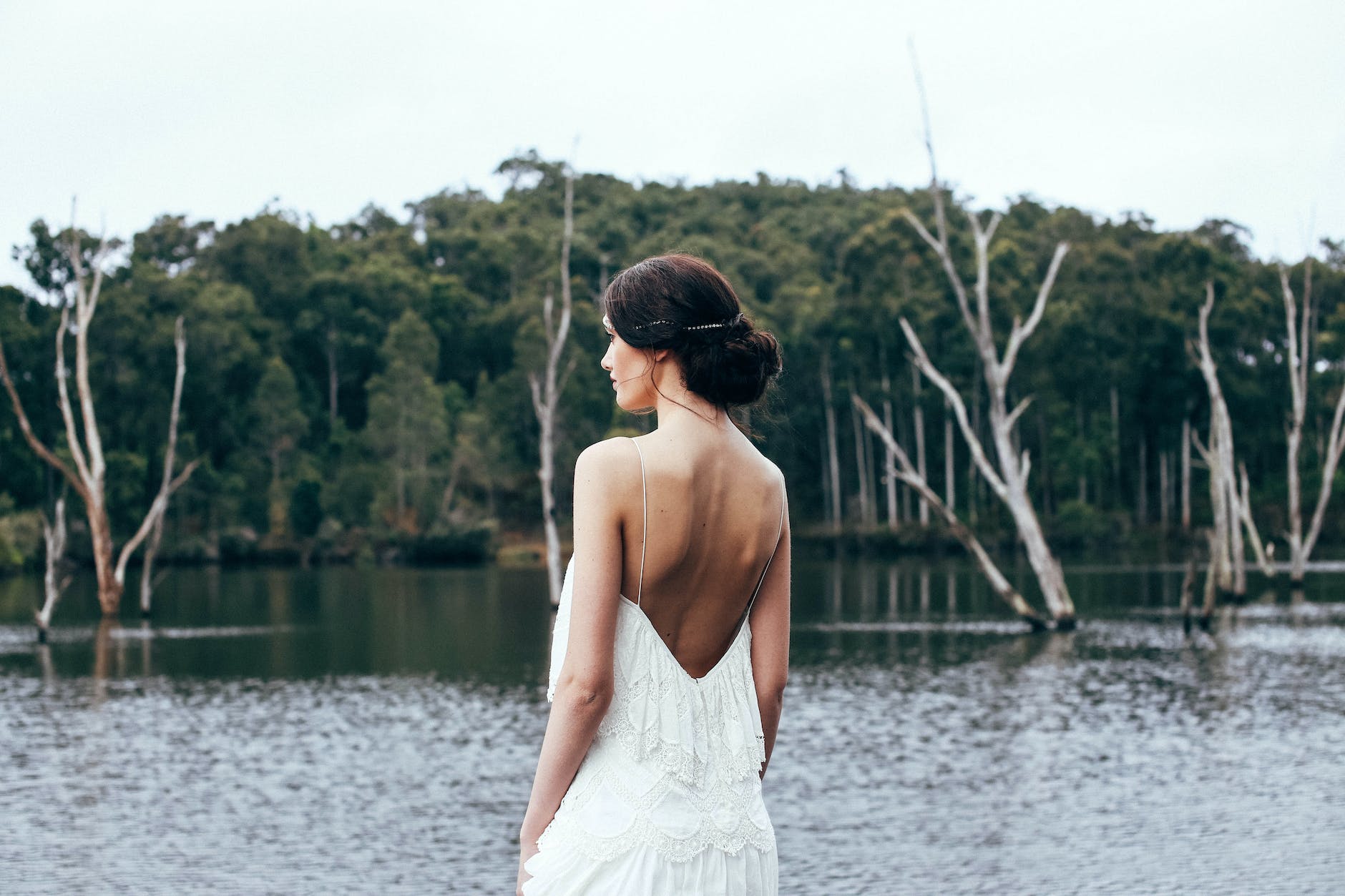
How To Have The Perfect Camping Theme Wedding Shower

- Scholarly Community Encyclopedia
- Log in/Sign up

Video Upload Options
- MDPI and ACS Style
- Chicago Style
The outrigger canoe is a type of canoe featuring one or more lateral support floats known as outriggers, which are fastened to one or both sides of the main hull. Smaller canoes often employ a single outrigger on the port side, while larger canoes may employ a single-outrigger, double-outrigger, or double-hull configuration (see also catamaran). The sailing canoes are an important part of the Austronesian heritage. They are also very popular in Puerto Rico. Unlike a single-hulled canoe, an outrigger or double-hull canoe generates stability as a result of the distance between its hulls rather than due to the shape of each individual hull. As such, the hulls of outrigger or double-hull canoes are typically longer, narrower and more hydrodynamically efficient than those of single-hull canoes. Compared to other types of canoes, outrigger canoes can be quite fast, yet are also capable of being paddled and sailed in rougher water. This paddling technique, however, differs greatly from kayaking or rowing. The paddle, or blade, used by the paddler is single sided, with either a straight or a double-bend shaft.
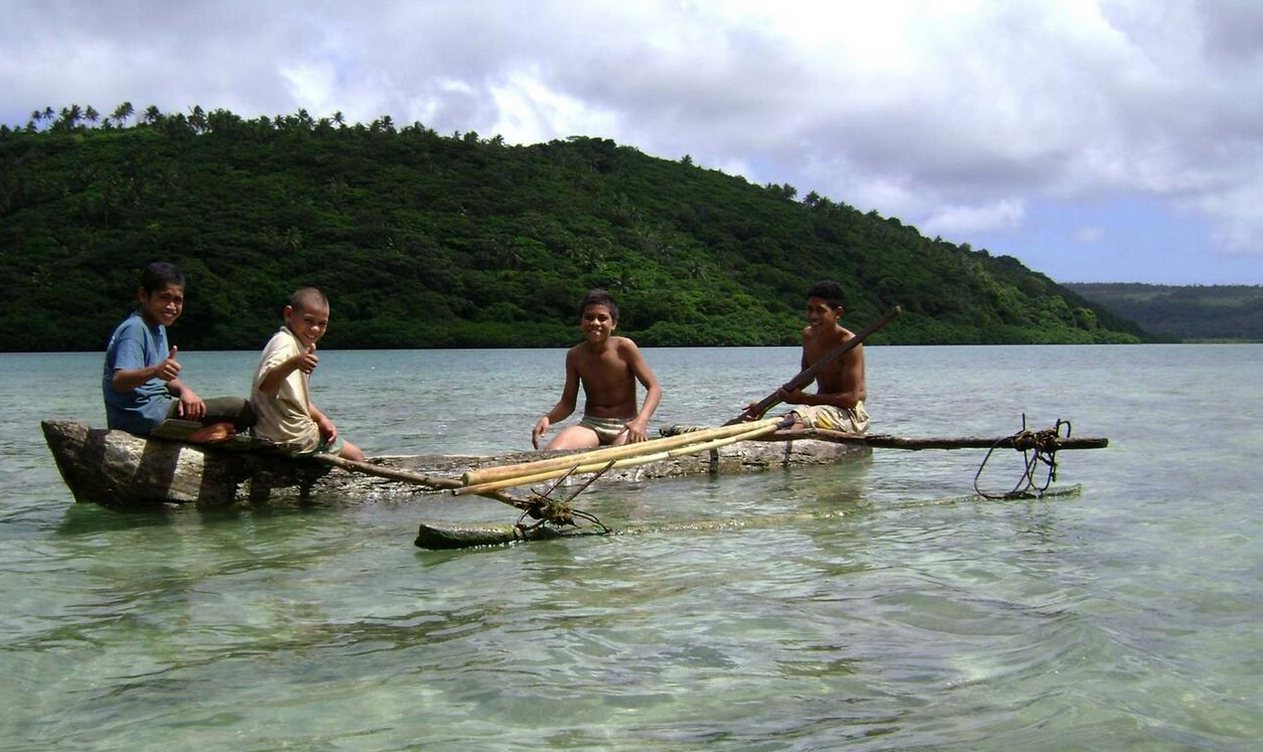
Outrigger canoes were originally developed by the Austronesian-speaking peoples of the islands of Southeast Asia for sea travel. They were used to transport these peoples both eastward to Polynesia and New Zealand and westward across the Indian Ocean as far as Madagascar during the Austronesian migration period. While today they can be found in East Africa (e.g., the ungalawa of Tanzania), the Austronesian peoples (Malagasy, Maritime Southeast Asian, Micronesian, Melanesian, Native Taiwanese, and Polynesian peoples) continue to be the primary users of the outrigger canoes.
Outrigger fishing canoes are also used among certain non-Austronesian groups, such as the Sinhalese in Sri Lanka, where they are known as oruwa , [ 2 ] as well as among some groups in the Andaman and Nicobar Islands. [ 3 ] The ethnological significance of this spread has been studied by James Hornell.
When Magellan's ships first encountered the Chamorros of the Mariana Islands in 1521, Antonio Pigafetta recorded that the Chamorros' sailboats far surpassed Magellan's in speed and maneuverability.
The Polynesian Voyaging Society has two double-hull sailing canoes, Hokulea and Hawaiiloa , and sails them between various islands in the Pacific using traditional Polynesian navigation methods without instruments. The Hikianalia and Alingano Maisu are other extant double-hulled voyaging canoes.
The technology has persisted into the modern age. Outrigger canoes can be quite large fishing or transport vessels. In the Philippines , outrigger canoes (called bangka or paraw ) are often fitted with petrol engines. The links between seafaring and outrigger canoes in the Philippines extend through to political life, in which the smallest political unit in the country is still called "barangay" after the historical balangay outrigger boats used in the original migrations of the first Austronesian peoples across the archipelago and beyond.
2. Terminology and Linguistics

The reconstructed Proto-Austronesian word for the outrigger canoe is *waŋkaŋ. Cognates in modern Austronesian languages include: Ketagalan bangka ; Filipino bangka ; Indonesian bangka ; New Zealand Māori waka ama ; Cook Islands Māori vaka ; Hawaiian waʻa ; Tahitian and Samoan vaʻa ; and Malagasy lakana .
The outrigger float is called the ama in many Polynesian languages (compare Hawaiian ama , Maori ama , and Samoan ama , all meaning 'outrigger float'), realisations of Proto-Malayo-Polynesian *saRman 'outrigger float' [ 4 ] [ 5 ] . Similar terms also exist in other Malayo-Polynesian languages, such as Pohnpeian dahm , Yapese thaam , Ambonese Malay semang , all meaning 'outrigger float', as well as Chamorro sakman meaning '[a] large canoe - from Polynesia or Papua, [with] no outrigger, capable of carrying over 100 people' [ 6 ] . The outrigger boom—spars connecting the ama to the main hull (or the two hulls in a double-hull canoe)—are called ʻiako in Hawaiian and kiato in Māori (with similar words in other Polynesian languages), ultimately from Proto-Oceanic *kiajo or its doublet *kayajo both meaning 'outrigger boom' (compare Loinu kiec , Kiribati kiaro , and Tongan kiato , as well as Seimat ayas and Gedaged ayad , all meaning 'outrigger boom') [ 7 ] [ 8 ] . In Philippine languages, the outrigger floats are called katig or kate , from Proto-Philippine *katiR. [ 9 ] [ 10 ]
Double-outrigger canoes are more prevalent in Southeast Asia and Madagascar . They have two outrigger floats connected to spars lashed across a single hull. They range in size from small vessels like the jukung , vinta , and the paraw ; to medium-sized trading and fishing vessels like the balangay and basnigan ; to very large warships like the karakoa and kora kora . In Philippine vessels, additional booms called batangan are usually added across the outrigger spars ( tadik ), in between the outrigger floats ( katig ) and the main hull ( bangka ). [ 10 ] [ 11 ] In modern terminology, especially in leisure or sport boating, double-outrigger ships are usually termed trimaran or triple-hull ships.
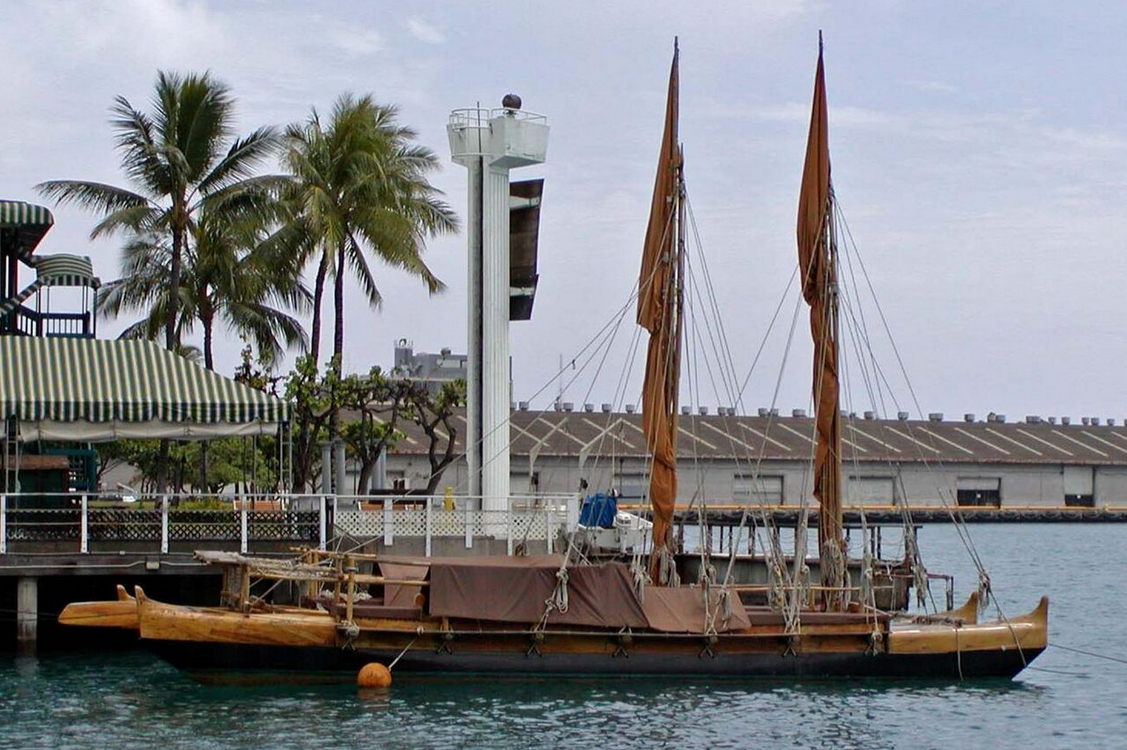
Single-outrigger canoes are more prevalent in Polynesia and Micronesia. Single-outrigger canoes have a single outrigger float ( ama ) connected to the main hull by spars called ʻiako (Hawaiian), ʻiato (Tahitian), or kiato (Māori). The ama, which is usually rigged on the left side, provides stability. The paddlers need to be careful to avoid leaning too far on the opposite side of the ama, as that may cause the canoe to capsize ( huli or lumaʻi ). A variant of single-outrigger canoes with two equal-sized hulls (instead of a hull and an outrigger float) is called catamaran or double-hull ships.
4. Modern Sport
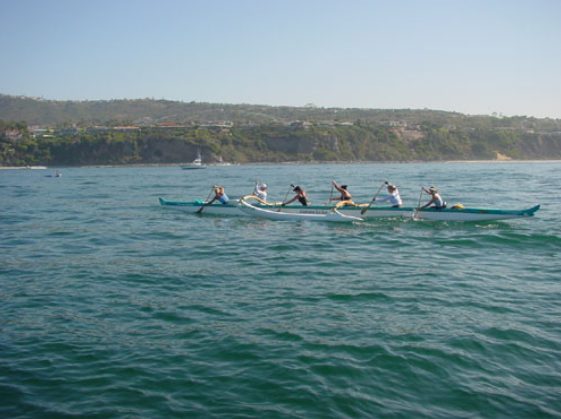
Outrigger canoe racing has become a popular canoeing sport, with numerous clubs located around the world. Outrigger Canoe Racing is the State sport of Hawaii and an interscholastic high school sport. In Hawaii, entire families participate in summer regattas with age groups from keiki (children as young as 6 with an adult steersperson) and age 12 through age 60+.
Major races in Hawaii include the Molokaʻi Hoe 43 mi (69 km) men's race from the island of Molokai to Oahu across the Kaiwi Channel, Na Wahine O Ke Kai (same race for women) and the Queen Liliʻuokalani Race held near Kona on the Island of Hawai.
In modern sport outrigger canoeing, ships are classified according to the configuration and number of the hulls and the number of paddlers, including the OC1, OC2, OC3, OC4 and OC6 (with the respective number of paddlers using a single-hull outrigger canoe), and the DC12 or OC12 (with twelve paddlers using a double-hull outrigger canoe, two six-person canoes rigged together like a catamaran). Outriggers without a rudder are referred to as V1, V2, etc. (where V refers to vaʻa ).
Six-person outrigger canoes (or OC6) are among the most commonly used for sport use; single-person outrigger canoes (or OC1) are also very common. Two and four-person outrigger canoes are also sometimes used, and two six-person outrigger canoes are sometimes rigged together like a catamaran to form a twelve-person double canoe.

Modern OC6 hulls and amas are commonly made from glass-reinforced plastic. However, some canoes are made of more traditional materials. In Ancient Hawaii, canoes were carved from the trunks of very old koa trees. These canoes, although rare, are still very much in use today. The ʻiako are usually made of wood; the ʻiako-ama and ʻiako-hull connections are typically done with rope wrapped and tied in an interlocking fashion to reduce the risk of the connection coming completely apart if the rope breaks.
Modern OC1 hulls and amas are commonly made from glass-reinforced plastic, carbon fiber reinforced plastic, and/or Kevlar to produce a strong but light canoe. OC1 are often made with rudders operated by foot pedals. More traditional designs do not have rudders. OC1 commonly use ʻiako made of aluminium, with a mechanism for quickly assembling and disassembling the canoe (snap buttons, large wing nuts, etc.).
In an outrigger canoe, the paddlers sit in line, facing toward the bow of the canoe (i.e., forward, in the direction of travel, unlike rowing). The seats are numbered from 1 (closest to the bow) to the number of seats in the canoe, usually 6. The steerer (or steersman or steersperson ) sits in the last seat of the canoe (seat 6 in the common OC6) and, as the name indicates, is primarily responsible for steering. The paddler sitting in seat 1 is called the stroke (or stroker ) and is responsible for setting the pace of the paddle strokes. The stroker should have a high level of endurance to keep the rate (the number of strokes taken in a given amount of time) manageable for whatever the situation may be. The first two positions may also be involved in certain steering manoeuvers. This usually involves the draw stroke. During a tight turn, the one seat might poke to make the canoe turn the opposite way. In the middle of the canoe (seats number 3 and 4) known as the powerhouse are the strong and powerful paddlers. Any of the 2 can be the 'caller' who directs when to switch over their blades, when to pick up or slow down the stroking pace, etc. Whoever is caller must have very good leadership skills and know how to think off the top of their heads in any situation. Every position has an important role to play in the canoe.
In an OC1, the single paddler must also steer the canoe. Some OC1s have rudders operated by foot pedals, while OC1s without rudders must be steered by drawing and paddling as needed for steering purposes while paddling to move the canoe forward.
A good steersman is able to maintain the straight attitude of the canoe throughout the course of a race, and also keep the boat and the crew safe in rough sea conditions. S/he may also take advantage of water conditions to gain extra speed by surfing. The steersman uses a single bladed steering paddle which has a larger blade than a standard outrigger paddle, is built stronger, and has less or no bend in its shaft. S/he steers by the following methods:
- Poking: holding the paddle vertically against the side of the canoe, causing drag on that side to cause the canoe to turn that direction. (left to go left and right to go right)
- Drawing: paddling at a 45 to 90-degree angle to pull water under the canoe, causing the canoe to turn the opposite direction.
- Posting: holding the paddle in the water out to the side with the forward edge angled opposite to the desired turn direction, usually as a prelude to drawing.
- Paddling: by applying power on one side of the canoe, the steersman can influence to a small degree which way the canoe will turn. Paddling also increases the total power moving the canoe forward compared to the other steering methods. The steersman should try and paddle as much as possible so he or she doesn't slow down the canoe by contributing to the amount of weight in the canoe.
A steersman also skippers the canoe and instructs all other paddlers as necessary. As an outrigger canoe is a long narrow canoe with the steersman placed at the very end, the steersman must give instructions sufficiently loudly and clearly for the entire crew to hear. From a water safety perspective the steersman should also be among the most experienced crew members, and be knowledgeable with the waterways and weather conditions, relevant maritime rules and other safety considerations such as the use of personal flotation devices, rigging of the canoe, placement of paddlers in the various seating positions, and recovery from a huli by righting the canoe and bailing out the water. The steersman should also be able to keep the ama down during rough water.
Paddlers use single-bladed paddles, usually with single or double bent shafts. The paddling stroke is similar to that of most other racing canoe paddling strokes, involving primarily core and lat strength. Generally, each paddler paddles on the opposite side from the paddler in directly front (for example, in an OC6, paddlers in seats 1, 3, and 5 paddle on one side, while paddlers in seats 2 and 4 paddle on the other side). All paddlers switch sides simultaneously on a call from one who is the designated caller. The steerer may paddle either side or switch sides as needed for steering purposes. The steersman will also switch sides to keep the ama from popping up and capsizing the canoe.
Stronger paddlers are typically placed in the middle of the canoe, while paddlers with the most endurance tend to be placed at the front, as the lead paddler sets the pace for the crew. All other paddlers synchronize their strokes to the paddler in front of them (whom they can directly see).
In rough water, it is often desirable to have a paddler with steering skill in seat 5 (of an OC6), to allow for the steerer to have that paddler also take steering strokes if needed in some situations. In conditions when the boat is surfing, the stern of the canoe will be so far out of the water that seat 5 will have to keep the boat on course. A seat 5 paddler with steering skill can also assist in preventing a huli by staying on the ama side during a particularly rough stretch of water.
In water rough enough to splash into the canoe, paddlers also need to pay attention to the water level in the canoe, report the situation to the steerer, and bail out the water as necessary. Paddlers also need to know how to recover from a huli under the steerer's direction.
In a quick turn situation, paddlers at the front may also be instructed to une (poke steer, causes the canoe to turn the opposite direction) or kahi (post and draw steer, pulls the canoe to the side where this is done) to help bring the canoe around a turn quickly.
4.2. Racing
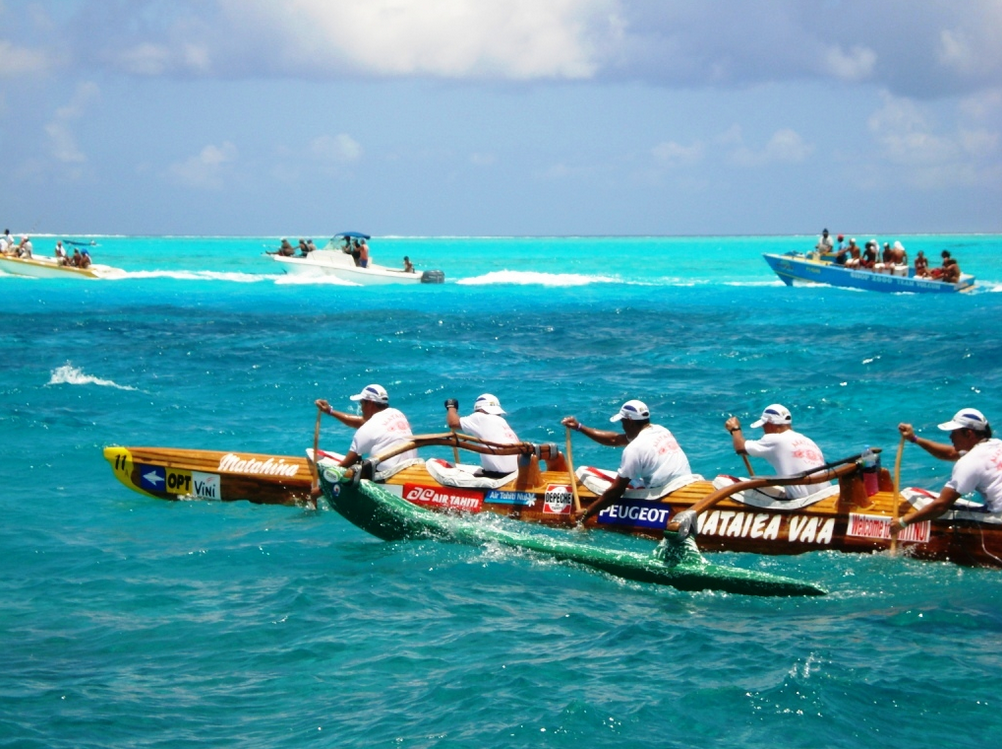
The length of a race ranges from short sprints (e.g., 250–500 metres for the OC1 and the OC12, 500–2000 metres (usually includes turns) for the OC6) to longer events, including marathons (e.g., 42 kilometres). A number of races are raced over distances that far exceed 42 kilometres, including the Molokaʻi Hoe that crosses the Kaiwi Channel between the islands of Molokai and Oahu in Hawaii. However, long-distance races of 20 to 30 kilometres are more common, with shorter 5 to 8 kilometre courses typically being offered to novice paddlers and those under 20 years of age.
Longer races involving the OC6 often involve paddler replacements, which involve exit and entry to the canoe directly from the water while the canoe is underway (this is called a water change ). Typically, nine paddlers form a crew, with six paddling the OC6 and the other three resting, drinking, and/or eating on an escort boat. Replacement typically occurs at 20 to 30 minute intervals; the escort boat drops the relief paddlers into the water ahead of the OC6, which is steered toward them. The relief paddlers climb in on the ama side as those they are replacing roll out into the water on the opposite side. The escort boat then picks up the paddlers in the water so that they can rest, drink, and/or eat before they, in turn, relieve some of the paddlers in the OC6.
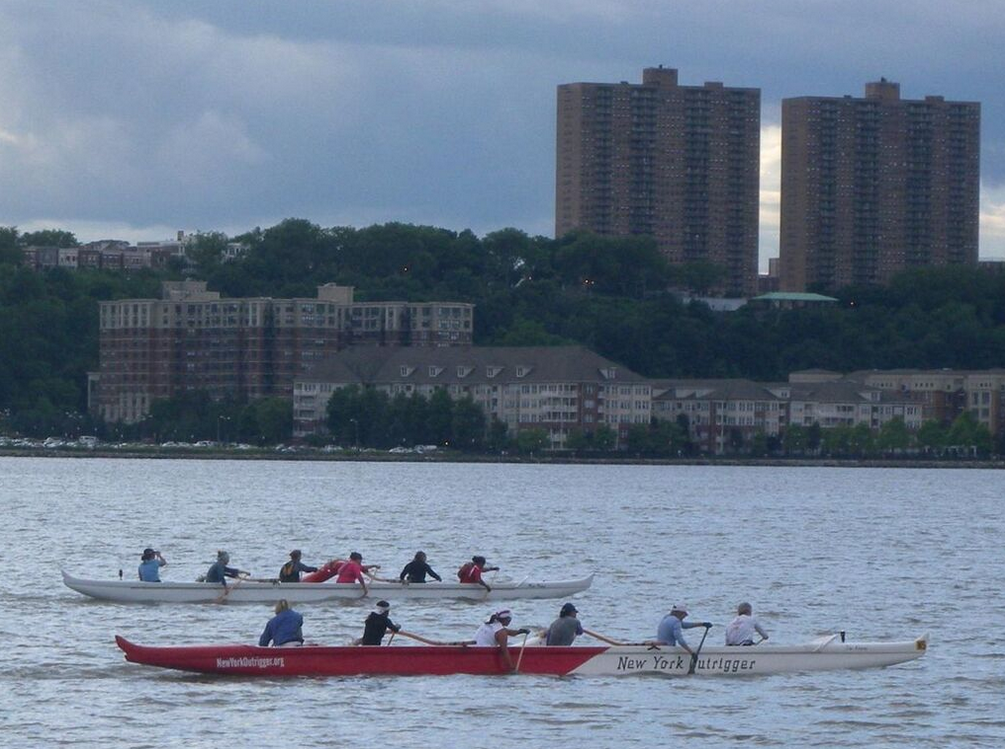
The longer races are typically conducted in the open ocean, e.g., between islands in the South Pacific. The Molokaʻi Hoe in Hawaii, The Hamilton Cup in Australia, [ 12 ] The Vaka Eiva in Rarotonga (Cook Islands), [ 13 ] The Motu2Motu in Aitutaki (Cook Islands) [ 14 ] and the Catalina Channel crossing in California [ 15 ] are four examples of races involving water changes.
Paddlers and crews are usually classified by gender and age. Gender classification is typically straightforward, with male, female, and coed classifications, with the latter being a crew with equal numbers of male and female paddlers (different rules may apply to nine-person coed crews doing a race with paddler replacements). Age classifications typically include youth divisions like 19-and-under, 16-and-under, etc., master divisions with minimum ages typically starting at 35 or 40 years of age, and an open division which allows paddlers of any age. A novice division for paddlers with less than a specified number of years of race experience (usually one or two) may also exist in a given association.
In some races, a particular type of outrigger canoe, usually a more traditional design for the region, may be given its own racing classification. For example, races in Hawaii have a koa division, while southern California has a Bradley OC6 division and northern California OC1 sprint races have a traditional (no rudder) division.
There are several outrigger racing organizations in the United States. They include the East Coast Outrigger Racing Association (ECORA), the Hawaiian Canoe Racing Association (HCRA), the Northern California Outrigger Canoe Association (NCOCA), the Southern California Outrigger Canoe Association (SCORA), and several more.
- Francisco Ignacio Alcina (1668). Historia de las islas e indios de Bisayas. https://trove.nla.gov.au/work/21366897?selectedversion=NBD197673.
- Kapitän, Gerhard (May 1989). "Records of Native Craft in Sri Lanka—I: The single outrigger fishing canoe oruwa—Part 2.2: Rowed, paddled and poled oru". International Journal of Nautical Archaeology 18 (2): 137–149. doi:10.1111/j.1095-9270.1989.tb00185.x. https://dx.doi.org/10.1111%2Fj.1095-9270.1989.tb00185.x
- Irenäus Eibl-Eibesfeldt, Land of a Thousand Atolls: A Study of Marine Life in the Maldive and Nicobar Islands, World Publishing Co., Cleveland and New York, 1964.
- Blust, Robert; Trussel, Stephen (December 2013). "The Austronesian Comparative Dictionary". Oceanic Linguistics 52 (2): 493–523. http://muse.jhu.edu/article/530554.
- Blust, Robert; Trussel, Stephen (2018-01-14). "*saRman outrigger float". http://www.trussel2.com/ACD/acd-s_s1.htm#30758.
- Blust, Robert; Trussel, Stephen (2018-01-14). "*kiajo outrigger boom". http://www.trussel2.com/ACD/acd-s_k.htm#30633.
- Blust, Robert; Trussel, Stephen (2018-01-14). "*kayajo outrigger boom". http://www.trussel2.com/ACD/acd-s_k.htm#30634.
- Lawrence A. Reid (1994). "Unravelling the linguistic histories of Philippine Negritos". in Tom Dutton & Darrell T. Tryon. Language Contact and Change in the Austronesian World. Trends in Linguistics, Studies and Monographs 77. Mouton de Gruyter. p. 456. ISBN 9783110127867. https://books.google.com.ph/books?id=xOlI8czLshIC&dq=katig+philippines+austronesian&source=gbs_navlinks_s.
- Patricia Calzo Vega (1 June 2011). "The World of Amaya: Unleashing the Karakoa". GMA News Online. http://www.gmanetwork.com/news/scitech/content/222283/the-world-of-amaya-unleashing-the-karakoa/story/. Retrieved 4 May 2018.
- Emma Helen Blair & James Alexander Robertson, ed (1906). The Philippine Islands, 1493-1898. http://www.gutenberg.org/cache/epub/15157/pg15157-images.html.
- "Clash of the Paddles - Hamilton Island Events". hamiltonisland.com.au. http://www.hamiltonisland.com.au/hamilton-cup/.
- "Vaka Eiva - Home". vakaeiva.com. http://www.vakaeiva.com/.
- "Motu 2 Motu Aitutaki". Facebook. https://www.facebook.com/motu2motu.
- "SCORA - Catalina Crossing - US Outrigger Championships". hcatalinacrossing.org. Archived from the original on 2015-07-30. https://web.archive.org/web/20150730021657/http://www.catalinacrossing.org/.

- Terms and Conditions
- Privacy Policy
- Advisory Board

Outrigger Canoe With Freestanding Mast

Introduction: Outrigger Canoe With Freestanding Mast

A sailboat built out of luan plywood, fiberglass, epoxy, and a little mahogany. Mostly plywood though. It's an outrigger canoe modeled roughly after a proa, but with a more western style hull shape and sail. I think it took around 200 person-hours to finish, although a boat with less finish work and slightly less laminated mahogany, could be finished in half that time. I should give a general outline of what sort of sailboat this is. A proa is a double-ended outrigger canoe. The sail is rigged up so that it can rotate fully forward of the mast, and the rudder can be moved. The boat never tacks, and instead just stalls and starts going backwards. We didn't want to mess with the rudder for this sort of design, so we opted for a single ended outrigger canoe. This has the downside that one tack is different than the other, which in moderate winds is not especially troublesome. The most interesting thing about this boat is probably the construction technique. We tried to make everything extremely easy to build, as well as tolerant of a lot of slop, but still lightweight enough to carry single-handedly, and as strong as is necessary for a freestanding mast. We compromised a small amount on hydrodynamics to do this (as we have a sharp chine). The high aspect ratio of the hull (5-6) makes this less of a compromise. The basic design is very simple; The main hull has a flat deck which forms the backbone on which the rest of the boat is built (upside-down). The ribs, mast box, and centerboard box, are glued to the bottom of the deck. The sides and bottom of the boat are then glued to the ribs. To make the boat comfortable with a flat top, we put benches out over the water to sit on instead, which facilitates hiking as well. The bottom and sides are all single sheets of quarter-inch luan plywood, but the top is two sheets laminated together (this would have preferably been a sheet of 3/8" or 1/2" marine ply) We wanted to minimize how many pieces we needed to cut and how many numbers we had to crunch (though we still crunched a laborious number of numbers), so we made the outside of the hull out of five pieces: the deck, two side pieces, and two bottom pieces. And a rear transom, which is more of a glorified bulkhead. our side panels were constant width along the boat (they are rectangular). We then simply cut the top and bottom to fit the angle and curve of the side panels. To make sure everything would fit together simply, we only made planks bend along a single axis, and always in parabolic shapes (this is roughly how a uniform stiffness beam wants to bend, at small angles. Since we wanted side planks that could be cut on a table saw, and only bent along their long axis, in a parabolic shape, this became the starting point of the boat. Simply define the boat length, the vertical slope of the side planks, and the maximum width of the boat, and the boat is fully defined in terms of camber and planview. All that remains to be determined is the vertical slope of the bottom planks on the hull. Just pick something pleasing to the eye here, unless you are interested in a particular ratio in the tradeoff between hull drag and static stability. With the above chosen, the hull is fully designed. Now build! wait, no. Now plug everything into any plotting program and figure out all your bulkhead cross sections, taking into account the thickness of your planks. Now build! You'll probably need about a gallon and a half of epoxy, and a gallon of titebond 3 or comparable 'waterproof' woodglue (this can be replaced with epoxy if desired, but is a lot healthier to work with, and sets up quicker. Any wood-wood joint which is only going to encounter splashes, or which will be coated with a protective coat of paint in the end, can be glued in with a waterproof wood-glue)
Step 1: Make a Big Table

Make a table of all of your bulkhead dimensions. No, really, do it. It's worth the time. Then cut out the deck, and glue on some blocks of wood to hold up the bulkheads, added in step 2. In the picture, the centerboard is sitting on top of the square pieces that will be used to join the bulkheads to the deck. The bottom of the hull only takes a very diffuse load, while the top of the deck has to take point loads (your feet). This means the top should be thicks, and thus that it makes a better spine on which to build a keel-less boat.
Step 2: Glue Bulkheads to the Deck

Cut all of your planks and glue your bulkheads to the bottom of the deck. It is helpful if you cut out any holes you need in the deck (say, for the mast and centerboard), before doing this. Make very sure that the bulkheads are centered along the axis of the boat. It wouldn't do to have a wobbly side on your boat. Also make sure that your bulkheads are cut and sanded to within about a millimeter of your design spec. This comes in handy later in decreasing the amount of time you have to spend making things fit when they do not. If you complete this step with great care, everything else will just fit.
Step 3: Make/install Internal Parts

The mast box, the centerboard box, and backing plates for all deck hardware, need to be added before sealing off the bottom of the boat. It is easiest to do before the sides are glued on. If you plan to use stays, don't worry overly about the mast box. Just make a pile of plywood cutouts in the shape of your mast. In our case, the mast was a free aluminum pole, originally intended for the awning on a mobile home. If you intend to have a freestanding mast, do the same thing, but make a lot of plywood cutouts, and be very sure that the whole thing is glued together tightly, and sealed off from water well. The mast box can fill up with water when the boat capsizes, so don't make it any larger than it needs to be. The centerboard box is less important, Figure a good slope for your centerboard and build it. Done. Both the mast and centerboard boxes should be supported by extra-thick bulkheads on either end, and should have extra bracing holding them on to these bulkheads. The picture of mast and centerboard box shown here was taken before some more stiffening blocks were added. As it is, the bulkheads attached to these parts are all either 1/2 marine ply, or 3/4 marine ply. There is an added support between centerboard box front bulkhead and the mast box rear bulkhead, to help convey torque from one to the other (and spread out the rather considerable load of the mast box). The backings for all deck hardware should be made of hardwood. We used mahogany, because we had some scraps lying around. Also, add flotation! Pink foam works well.
Step 4: Glue on Sides

this is easy. Since your sides are (I hope) at a slight slope from being perfectly vertical, they introduce a slight camber into the shape of the boat. This is a good thing. You should have that camber from your previous calculations. Just prop up the deck until it has the proper camber, and drop the sides on. Some slight adjustments might be necessary (a couple millimeters). Then clamp, glue, and apply fiberglass tape along the joints. As a butt joint between pieces of quarter inch ply isn't particularly strong, I highly recommend that you reinforce all joints by a piece of inch or inch and a half fiberglass tape.
Step 5: Glue on Bottom

This can be harder to fit, as the shape of the bottom planks is a bit stranger than the others, and thus harder to cut accurately (in that is asymmetric and all sides are curved). In our case, the pieces didn't quite fit, so we had to go through the hassle of filling the crack, and applying liberal amounts of fiberglass tape to the outside (and inside) of the crack. Note that nothing should be fiberglassed to the outside of the boat before the final coat of fiberglass. This is important in maintaining a sleek finish.
Step 6: Fiberglass!

now that your boat has a hull, fiberglass the outside of it. Once you wrap the whole thing in glass (or, say, the top half of the boat and then the bottom half of the boat), cut out glass around holes in the boat (as in the mast hole or the centerboard hole) before the glass dries. Feel free to tuck the excess glass down into the hole a little bit, for a cleaner look. After you apply the layer of fiberglass, apply a finish layer of epoxy. If you've never done this sort of fiberglassing here is the general process: 1: smear epoxy over the surface on which you wish to apply fiberglass. 2: stick fiberglass on to surface. 3: apply more epoxy until fiberglass is just barely saturated with epoxy (a squeegee helps with this) 4: apply a layer of dacron to create a rough surface for the finish coat to adhere to 5: wait for epoxy to cure 6: remove dacron 7: apply finish coat of epoxy Wear a mask. I don't have any pictures during the process. We layed up the top of the boat and then the bottom. The overlapping area should be a ring a couple of inches tall at the top of the sides. This is less conspicious, and is out of the water.
Step 7: Find or Make a Sail

If you find a sail, then you are done with this step. If you make one, then it goes something like this: 1: buy 10-20 oz dacron 2: figure out how much luff (the extent to which the sail is not flat) you want, and then figure out how to sew this into the sail. The assumption that the sail is roughly a pyramid shape works well in figuring how to adjust your seams 3: use brass or stainless grommets. Spend enough money for good ones.
Step 8: Sail

Done! time to sail. The boat is held together with bicycle inner tube. If tied tightly, these make good joint. The mast is put up, the sail rigged, and it's ready to sail. I originally thought my rudder was too long. I was unfortunately wrong, and when I cut my rudder shorter, the boat became much less manageable.
Recommendations

Fix It Contest
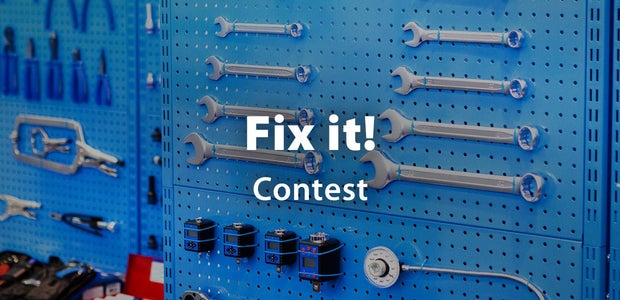
Make it Resilient

Remake It - Autodesk Design & Make - Student Contest

Friday 11 April 2014
Moscow metro - spirit of a city (e.p).

No comments:
Post a comment.

For the first time Rosatom Fuel Division supplied fresh nuclear fuel to the world’s only floating nuclear cogeneration plant in the Arctic
The fuel was supplied to the northernmost town of Russia along the Northern Sea Route.

The first in the history of the power plant refueling, that is, the replacement of spent nuclear fuel with fresh one, is planned to begin before 2024. The manufacturer of nuclear fuel for all Russian nuclear icebreakers, as well as the Akademik Lomonosov FNPP, is Machinery Manufacturing Plant, Joint-Stock Company (MSZ JSC), a company of Rosatom Fuel Company TVEL that is based in Elektrostal, Moscow Region.
The FNPP includes two KLT-40S reactors of the icebreaking type. Unlike convenient ground-based large reactors (that require partial replacement of fuel rods once every 12-18 months), in the case of these reactors, the refueling takes place once every few years and includes unloading of the entire reactor core and loading of fresh fuel into the reactor.
The cores of KLT-40 reactors of the Akademik Lomonosov floating power unit have a number of advantages compared to the reference ones: a cassette core was used for the first time in the history of the unit, which made it possible to increase the fuel energy resource to 3-3.5 years between refuelings, and also reduce the fuel component of the electricity cost by one and a half times. The FNPP operating experience formed the basis for the designs of reactors for nuclear icebreakers of the newest series 22220. Three such icebreakers have been launched by now.
For the first time the power units of the Akademik Lomonosov floating nuclear power plant were connected to the grid in December 2019, and put into commercial operation in May 2020. The supply of nuclear fuel from Elektrostal to Pevek and its loading into the second reactor is planned for 2024. The total power of the Akademik Lomonosov FNPP, supplied to the coastal grid of Pevek without thermal energy consumption on shore, is about 76 MW, being about 44 MW in the maximum thermal power supply mode. The FNPP generated 194 million kWh according to the results of 2023. The population of Pevek is just a little more than 4 thousand, while the FNPP has a potential for supplying electricity to a city with a population of up to 100 thousand people. After the FNPP commissioning two goals were achieved. These include first of all the replacement of the retiring capacities of the Bilibino NPP, which has been operating since 1974, as well as the Chaunskaya TPP, which has already been operating for more than 70 years. Secondly, energy is supplied to the main mining companies in western Chukotka in the Chaun-Bilibino energy hub a large ore and metal cluster, including gold mining companies and projects related to the development of the Baimsk ore zone. In September 2023, a 110 kilovolt power transmission line with a length of 490 kilometers was put into operation, connecting the towns of Pevek and Bilibino. The line increased the reliability of energy supply from the FNPP to both Bilibino consumers and mining companies, the largest of which is the Baimsky GOK. The comprehensive development of the Russian Arctic is a national strategic priority. To increase the NSR traffic is of paramount importance for accomplishment of the tasks set in the field of cargo shipping. This logistics corridor is being developed due regular freight voyages, construction of new nuclear-powered icebreakers and modernization of the relevant infrastructure. Rosatom companies are actively involved in this work. Rosatom Fuel Company TVEL (Rosatom Fuel Division) includes companies fabricating nuclear fuel, converting and enriching uranium, manufacturing gas centrifuges, conducting researches and producing designs. As the only nuclear fuel supplier to Russian NPPs, TVEL supplies fuel for a total of 75 power reactors in 15 countries, for research reactors in nine countries, as well as for propulsion reactors of the Russian nuclear fleet. Every sixth power reactor in the world runs on TVEL fuel. Rosatom Fuel Division is the world’s largest producer of enriched uranium and the leader on the global stable isotope market. The Fuel Division is actively developing new businesses in chemistry, metallurgy, energy storage technologies, 3D printing, digital products, and decommissioning of nuclear facilities. TVEL also includes Rosatom integrators for additive technologies and electricity storage systems. Rosenergoatom, Joint-Stock Company is part of Rosatom Electric Power Division and one of the largest companies in the industry acting as an operator of nuclear power plants. It includes, as its branches, 11 operating NPPs, including the FNPP, the Scientific and Technical Center for Emergency Operations at NPPs, Design and Engineering as well as Technological companies. In total, 37 power units with a total installed capacity of over 29.5 GW are in operation at 11 nuclear power plants in Russia. Machinery Manufacturing Plant, Joint-Stock Company (MSZ JSC, Elektrostal) is one of the world’s largest manufacturers of fuel for nuclear power plants. The company produces fuel assemblies for VVER-440, VVER-1000, RBMK-1000, BN-600,800, VK-50, EGP-6; powders and fuel pellets intended for supply to foreign customers. It also produces nuclear fuel for research reactors. The plant belongs to the TVEL Fuel Company of Rosatom.
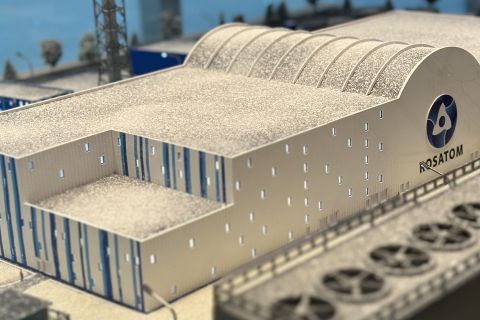
Rosatom obtained a license for the first land-based SMR in Russia
On April 21, Rosenergoatom obtained a license issued by Rostekhnadzor to construct the Yakutsk land-based SMR in the Ust-Yansky District of the Republic of Sakha (Yakutia).

ROSATOM and FEDC agree to cooperate in the construction of Russia's first onshore SNPP
ROSATOM and FEDC have signed a cooperation agreement to build Russia's first onshore SNPP in Yakutia.
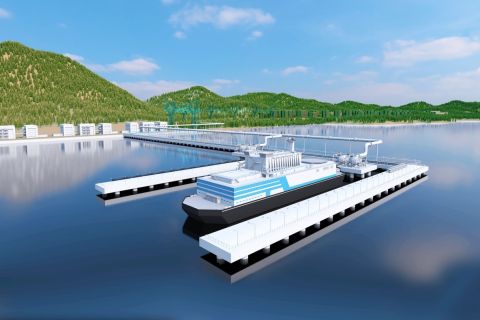
Rosatom develops nuclear fuel for modernized floating power units
Rosatom has completed the development of nuclear fuel for the RITM-200S small modular reactor designed for the upgraded floating power units.
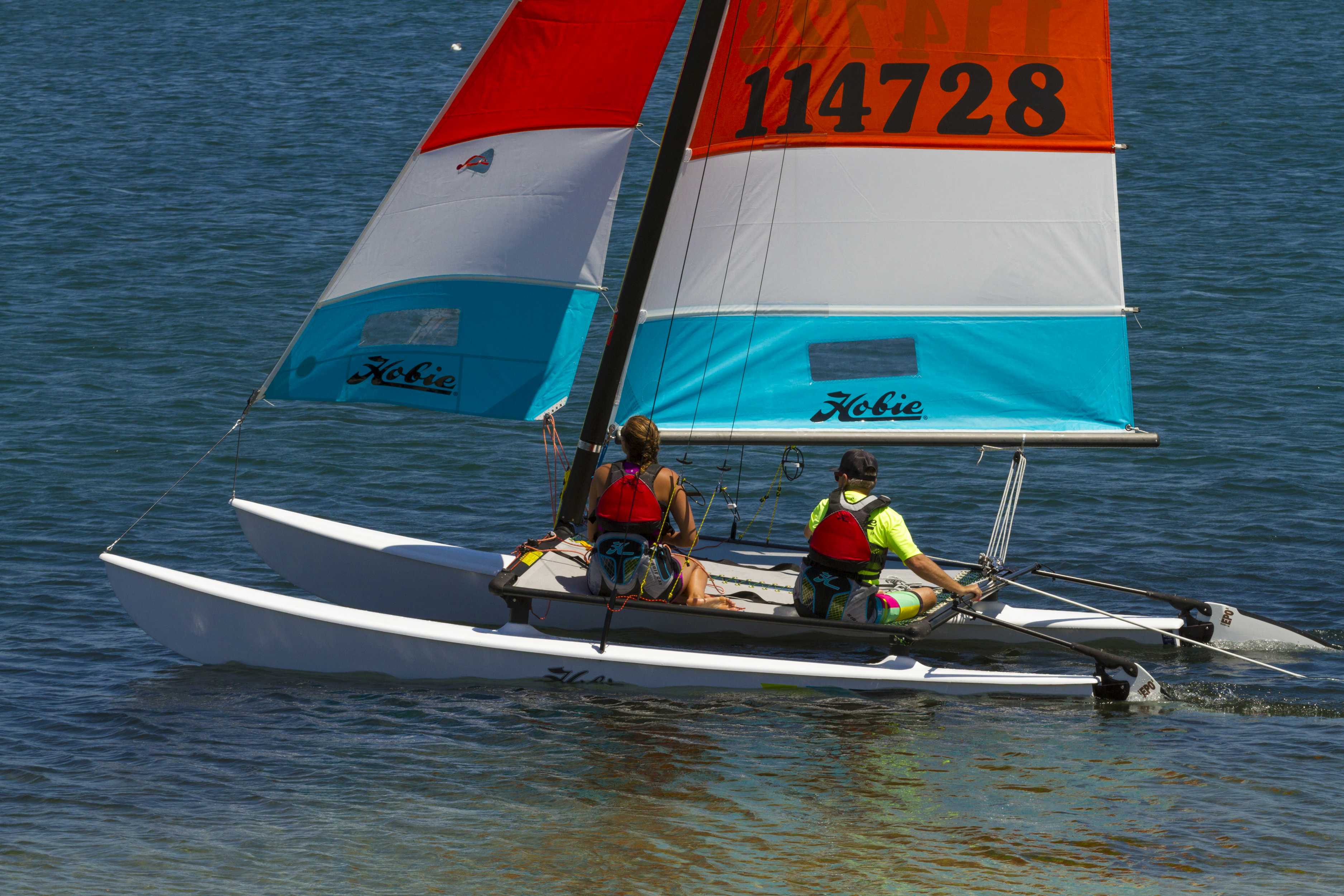
Outrigger boats are various watercraft featuring one or more lateral support floats known as outriggers, which are fastened to one or both sides of the main hull. They can range from small dugout canoes to large plank-built vessels.
PROA/outrigger with single daggerboard on main hull, which could be launched off the beach in moderate surf conditions. The first boats were built by members of Malibu Yacht Club. (at this time, by no means, a 'yachtie' establishment). From plans intended for amateur (plywood) construction.
Amas, single or double, add two things to the boat and have to be analysed from both of those directions. 1/ a slender low wetted surface hull compared to the main hull 2/ lots of stability This doesn't really differ from normal multihull design - all the standard texts will fill in details. "Submersible Amas"
The sailing outrigger canoe is just as symmetrical as our boats, but the axis of symmetry has been rotated ninety degrees. Stand on the outrigger side of one of these canoes that has been correctly built and you will see what I mean. It is the two ends, rather than the two sides, which are exactly alike.
On the Double Canoe, the Double Outrigger and the Single Outrigger (Tikopia style) sail and mast movement is minimal. With the end-for-end proa to get steering balance on tacking, there is a considerable movement of mast and sail, requiring strength, agility and careful teamwork.
The drop in outrigger can transform many unstable canoes, narrow dinghies and some kayaks into a stable platform for fishing or diving or convert your boat into a formidable sailing outrigger or trimaran sailing canoe. Turn a Canoe or Kayak into a formidable sailing boat or a super stable fishing platform. Drop in Outrigger Plan info here.
In some places, single wooden-hulled Polynesian outrigger canoes are still in use today. While a single carved-out tree makes up the hull, what distinguishes Polynesian outrigger canoes is that traditionally, they have only one outrigger. In contrast, Southeast Asia more often had double outriggers.
PROA/outrigger with single daggerboard on main hull, which could be launched off the beach in moderate surf conditions. The first boats were built by members of Malibu Yacht Club. (at this time, by no means, a 'yachtie' establishment). From plans intended for amateur (plywood) construction. A general write up appeared in a 1959 issue of ...
A trimaran (or double-outrigger) is a multihull boat that comprises a main hull and two smaller outrigger hulls (or "floats") which are attached to the main hull with lateral beams. Most modern trimarans are sailing yachts designed for recreation or racing; others are ferries or warships.
Tacking Outrigger.com is the definitive website for tacking outrigger sailing canoes. Vessels of polynesian heritage that are highly practical, seaworthy and efficient . LINK : Smaller Tacking Outriggers: LINK : Larger Tacking Outriggers: LINK : Small Trimarans : LINK : List of 500 Rowing Boat Designs: LINK :
Outrigger canoes are quintessential reminders of Austronesian roots- purposed to navigate through rough ocean conditions. Over the years, outriggers have evolved from a means of ancient sea travel into adrenaline-packed racing vessels. Table of Contents A Way To Sea Life Making Of The Ancient Outrigger Canoe Materials The Modern-Day Outrigger
Smaller canoes often employ a single outrigger on the port side, while larger canoes may employ a single outrigger, double outrigger, or double hull configuration (see also catamaran). The sailing canoes are an important part of the Polynesian heritage and are actively raced and sailed in Hawaii and Tahiti.
The sailing canoes are an important part of the Polynesian heritage and are raced and sailed in Hawaii, Tahiti, Samoa and by the Māori of New Zealand. Using an outrigger or double-hull configuration greatly increases the stability of the canoe, but introduces hydrodynamic inefficiency relative to making a single-hull canoe wider.
It's a decked, tacking single outrigger sailing canoe. The main hull is 18 feet long and 17.5 inches wide. It has full deck with two hatches with lids. The stern has a squared-off transom and a stern-hung kick up rudder with a push tiller. The outrigger float or "ama" is 12" wide and about 14 feet long. There are three wooden crossbeams or ...
Key Takeaways Choose lightweight and durable woods for construction, such as cedar, mahogany, or plywood. Design and plan the canoe based on the intended use, considering dimensions, shape, weight, and stability. Construct a strong hull using lapstrake or strip planking techniques, reinforcing joints and seams with epoxy or fiberglass tape.
The outrigger canoe is a type of canoe featuring one or more lateral support floats known as outriggers, which are fastened to one or both sides of the main hull. Smaller canoes often employ a single outrigger on the port side, while larger canoes may employ a single-outrigger, double-outrigger, or double-hull configuration (see also catamaran).
The Crossword Solver found 30 answers to "Outrigger sailboat", 4 letters crossword clue. The Crossword Solver finds answers to classic crosswords and cryptic crossword puzzles. Enter the length or pattern for better results. Click the answer to find similar crossword clues . Enter a Crossword Clue Sort by Length # of Letters or Pattern Dictionary
A sailboat built out of luan plywood, fiberglass, epoxy, and a little mahogany. Mostly plywood though. It's an outrigger canoe modeled roughly after a proa, but with a more western style hull shape and sail.
History Map showing the migration and expansion of the Austronesians which began at about 3000 BC from Taiwan Austronesians used distinctive sailing technologies, namely the catamaran, the outrigger ship, tanja sail and the crab claw sail.
It has been over a year since first being introduced to Limerick based 4-piece Moscow Metro* through their wonderful debut double-A side containing the tracks "Spirit of a City" and "Cosmos" for free, which sounded near perfect in spite of the band only being together for a few months at the time of recording. Now fast-forward 12 months, and as a result of the initial love for the band, they ...
Get directions to Yuzhny prospekt, 6к1 and view details like the building's postal code, description, photos, and reviews on each business in the building
21 April 2023 Rosatom obtained a license for the first land-based SMR in Russia. On April 21, Rosenergoatom obtained a license issued by Rostekhnadzor to construct the Yakutsk land-based SMR in the Ust-Yansky District of the Republic of Sakha (Yakutia).
ZHUKOVSKY, MOSCOW REGION, RUSSIA - AUG 24, 2015: Towing AgustaWestland AW119 Ke - medium sized single-engined helicopter at the International Aviation and Space salon MAKS-2015. More similar stock images. Tow truck towing helicopter through the airport territory. Towing Helicopter KA-32A.

First refuelling for Russia’s Akademik Lomonosov floating NPP
!{Model.Description}
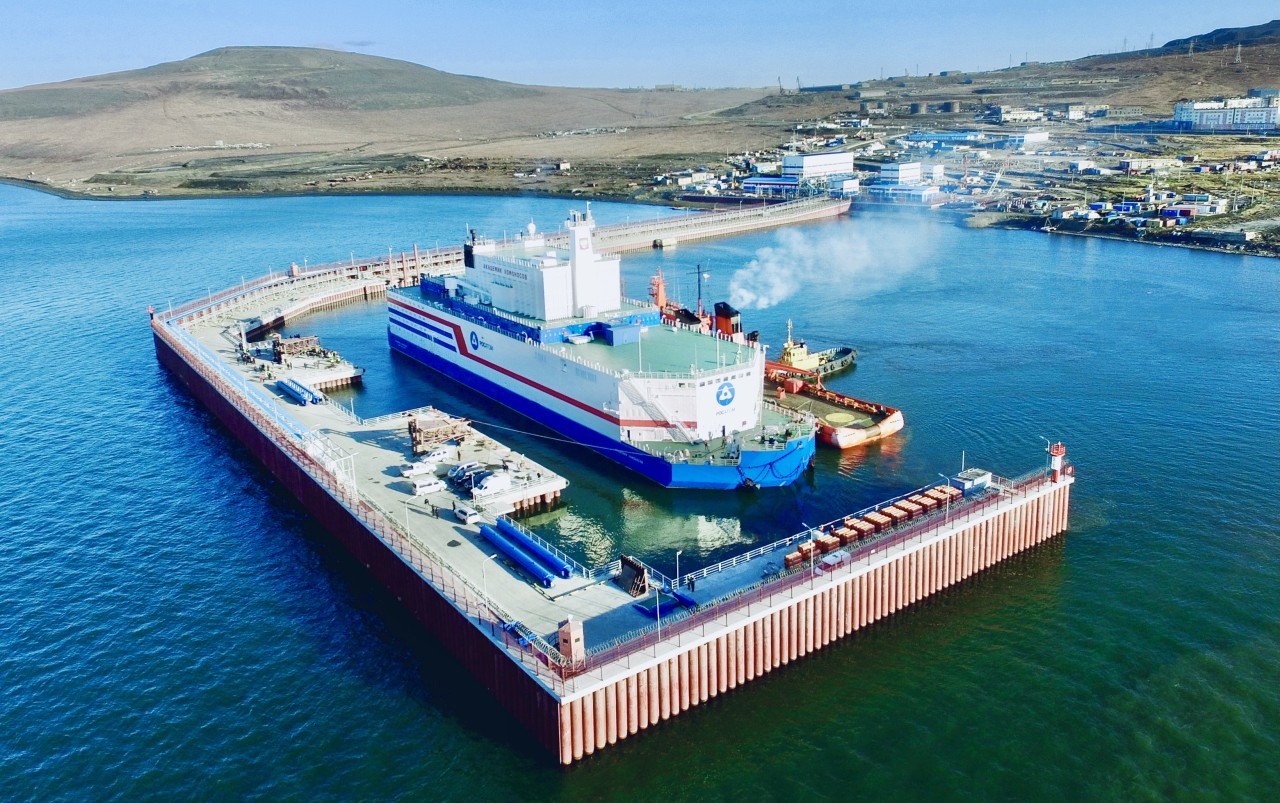
The FNPP includes two KLT-40S reactor units. In such reactors, nuclear fuel is not replaced in the same way as in standard NPPs – partial replacement of fuel once every 12-18 months. Instead, once every few years the entire reactor core is replaced with and a full load of fresh fuel.
The KLT-40S reactor cores have a number of advantages compared with standard NPPs. For the first time, a cassette core was used, which made it possible to increase the fuel cycle to 3-3.5 years before refuelling, and also reduce by one and a half times the fuel component in the cost of the electricity produced. The operating experience of the FNPP provided the basis for the design of the new series of nuclear icebreaker reactors (series 22220). Currently, three such icebreakers have been launched.
The Akademik Lomonosov was connected to the power grid in December 2019, and put into commercial operation in May 2020.
Electricity generation from the FNPP at the end of 2023 amounted to 194 GWh. The population of Pevek is just over 4,000 people. However, the plant can potentially provide electricity to a city with a population of up to 100,000. The FNPP solved two problems. Firstly, it replaced the retiring capacities of the Bilibino Nuclear Power Plant, which has been operating since 1974, as well as the Chaunskaya Thermal Power Plant, which is more than 70 years old. It also supplies power to the main mining enterprises located in western Chukotka. In September, a 490 km 110 kilovolt power transmission line was put into operation connecting Pevek and Bilibino.
Image courtesy of TVEL
- Terms and conditions
- Privacy Policy
- Newsletter sign up
- Digital Edition
- Editorial Standards

Electrostal History and Art Museum

Most Recent: Reviews ordered by most recent publish date in descending order.
Detailed Reviews: Reviews ordered by recency and descriptiveness of user-identified themes such as wait time, length of visit, general tips, and location information.
Electrostal History and Art Museum - All You Need to Know BEFORE You Go (2024)
- (0.19 mi) Elektrostal Hotel
- (1.21 mi) Yakor Hotel
- (1.27 mi) Mini Hotel Banifatsiy
- (1.18 mi) Elemash
- (1.36 mi) Hotel Djaz
- (0.07 mi) Prima Bolshogo
- (0.13 mi) Makecoffee
- (0.25 mi) Amsterdam Moments
- (0.25 mi) Pechka
- (0.26 mi) Mazhor
- Popular Professionals
- Design & Planning
- Construction & Renovation
- Finishes & Fixtures
- Landscaping & Outdoor
- Systems & Appliances
- Interior Designers & Decorators
- Architects & Building Designers
- Design-Build Firms
- Kitchen & Bathroom Designers
- General Contractors
- Kitchen & Bathroom Remodelers
- Home Builders
- Roofing & Gutters
- Cabinets & Cabinetry
- Tile & Stone
- Hardwood Flooring Dealers
- Landscape Contractors
- Landscape Architects & Landscape Designers
- Home Stagers
- Swimming Pool Builders
- Lighting Designers and Suppliers
- 3D Rendering
- Sustainable Design
- Basement Design
- Architectural Design
- Universal Design
- Energy-Efficient Homes
- Multigenerational Homes
- House Plans
- Home Remodeling
- Home Additions
- Green Building
- Garage Building
- New Home Construction
- Basement Remodeling
- Stair & Railing Contractors
- Cabinetry & Cabinet Makers
- Roofing & Gutter Contractors
- Window Contractors
- Exterior & Siding Contractors
- Carpet Contractors
- Carpet Installation
- Flooring Contractors
- Wood Floor Refinishing
- Tile Installation
- Custom Countertops
- Quartz Countertops
- Cabinet Refinishing
- Custom Bathroom Vanities
- Finish Carpentry
- Cabinet Repair
- Custom Windows
- Window Treatment Services
- Window Repair
- Fireplace Contractors
- Paint & Wall Covering Dealers
- Door Contractors
- Glass & Shower Door Contractors
- Landscape Construction
- Land Clearing
- Garden & Landscape Supplies
- Deck & Patio Builders
- Deck Repair
- Patio Design
- Stone, Pavers, & Concrete
- Paver Installation
- Driveway & Paving Contractors
- Driveway Repair
- Asphalt Paving
- Garage Door Repair
- Fence Contractors
- Fence Installation
- Gate Repair
- Pergola Construction
- Spa & Pool Maintenance
- Swimming Pool Contractors
- Hot Tub Installation
- HVAC Contractors
- Electricians
- Appliance Services
- Solar Energy Contractors
- Outdoor Lighting Installation
- Landscape Lighting Installation
- Outdoor Lighting & Audio/Visual Specialists
- Home Theater & Home Automation Services
- Handyman Services
- Closet Designers
- Professional Organizers
- Furniture & Accessories Retailers
- Furniture Repair & Upholstery Services
- Specialty Contractors
- Color Consulting
- Wine Cellar Designers & Builders
- Home Inspection
- Custom Artists
- Columbus, OH Painters
- New York City, NY Landscapers
- San Diego, CA Bathroom Remodelers
- Minneapolis, MN Architects
- Portland, OR Tile Installers
- Kansas City, MO Flooring Contractors
- Denver, CO Countertop Installers
- San Francisco, CA New Home Builders
- Rugs & Decor
- Home Improvement
- Kitchen & Tabletop
- Bathroom Vanities
- Bathroom Vanity Lighting
- Bathroom Mirrors
- Bathroom Fixtures
- Nightstands & Bedside Tables
- Kitchen & Dining
- Bar Stools & Counter Stools
- Dining Chairs
- Dining Tables
- Buffets and Sideboards
- Kitchen Fixtures
- Wall Mirrors
- Living Room
- Armchairs & Accent Chairs
- Coffee & Accent Tables
- Sofas & Sectionals
- Media Storage
- Patio & Outdoor Furniture
- Outdoor Lighting
- Ceiling Lighting
- Chandeliers
- Pendant Lighting
- Wall Sconces
- Desks & Hutches
- Office Chairs
- View All Products
- Designer Picks
- Side & End Tables
- Console Tables
- Living Room Sets
- Chaise Lounges
- Ottomans & Poufs
- Bedroom Furniture
- Nightstands
- Bedroom Sets
- Dining Room Sets
- Sideboards & Buffets
- File Cabinets
- Room Dividers
- Furniture Sale
- Trending in Furniture
- View All Furniture
- Bath Vanities
- Single Vanities
- Double Vanities
- Small Vanities
- Transitional Vanities
- Modern Vanities
- Houzz Curated Vanities
- Best Selling Vanities
- Bathroom Vanity Mirrors
- Medicine Cabinets
- Bathroom Faucets
- Bathroom Sinks
- Shower Doors
- Showerheads & Body Sprays
- Bathroom Accessories
- Bathroom Storage
- Trending in Bath
- View All Bath
- Houzz x Jennifer Kizzee
- Houzz x Motivo Home
- How to Choose a Bathroom Vanity

- Patio Furniture
- Outdoor Dining Furniture
- Outdoor Lounge Furniture
- Outdoor Chairs
- Adirondack Chairs
- Outdoor Bar Furniture
- Outdoor Benches
- Wall Lights & Sconces
- Outdoor Flush-Mounts
- Landscape Lighting
- Outdoor Flood & Spot Lights
- Outdoor Decor
- Outdoor Rugs
- Outdoor Cushions & Pillows
- Patio Umbrellas
- Lawn & Garden
- Garden Statues & Yard Art
- Planters & Pots
- Outdoor Sale
- Trending in Outdoor
- View All Outdoor
- 8 x 10 Rugs
- 9 x 12 Rugs
- Hall & Stair Runners
- Home Decor & Accents
- Pillows & Throws
- Decorative Storage
- Faux Florals
- Wall Panels
- Window Treatments
- Curtain Rods
- Blackout Curtains
- Blinds & Shades
- Rugs & Decor Sale
- Trending in Rugs & Decor
- View All Rugs & Decor
- Pendant Lights
- Flush-Mounts
- Ceiling Fans
- Track Lighting
- Wall Lighting
- Swing Arm Wall Lights
- Display Lighting
- Table Lamps
- Floor Lamps
- Lamp Shades
- Lighting Sale
- Trending in Lighting
- View All Lighting
- Bathroom Remodel
- Kitchen Remodel
- Kitchen Faucets
- Kitchen Sinks
- Major Kitchen Appliances
- Cabinet Hardware
- Backsplash Tile
- Mosaic Tile
- Wall & Floor Tile
- Accent, Trim & Border Tile
- Whole House Remodel
- Heating & Cooling
- Building Materials
- Front Doors
- Interior Doors
- Home Improvement Sale
- Trending in Home Improvement
- View All Home Improvement
- Cups & Glassware
- Kitchen & Table Linens
- Kitchen Storage and Org
- Kitchen Islands & Carts
- Food Containers & Canisters
- Pantry & Cabinet Organizers
- Kitchen Appliances
- Gas & Electric Ranges
- Range Hoods & Vents
- Beer & Wine Refrigerators
- Small Kitchen Appliances
- Cookware & Bakeware
- Tools & Gadgets
- Kitchen & Tabletop Sale
- Trending in Kitchen & Tabletop
- View All Kitchen & Tabletop
- Storage & Organization
- Baby & Kids
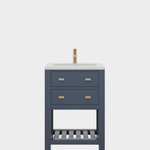
- View all photos
- Dining Room
- Breakfast Nook
- Family Room
- Bed & Bath
- Powder Room
- Storage & Closet
- Outdoor Kitchen
- Bar & Wine
- Wine Cellar
- Home Office
- Popular Design Ideas
- Kitchen Backsplash
- Deck Railing
- Privacy Fence
- Small Closet
- Stories and Guides
- Popular Stories
- Renovation Cost Guides
- Fence Installation Cost Guide
- Window Installation Cost Guide
- Discussions
- Design Dilemmas
- Before & After
- Houzz Research
- View all pros
- View all services
- View all products
- View all sales
- Living Room Chairs
- Dining Room Furniture
- Coffee Tables
- Home Office Furniture
- Join as a Pro
- Interior Design Software
- Project Management
- Custom Website
- Lead Generation
- Invoicing & Billing
- Landscape Contractor Software
- General Contractor Software
- Remodeler Software
- Builder Software
- Roofer Software
- Architect Software
- Takeoff Software
- Lumber & Framing Takeoffs
- Steel Takeoffs
- Concrete Takeoffs
- Drywall Takeoffs
- Insulation Takeoffs
- Stories & Guides
- LATEST FROM HOUZZ
- HOUZZ DISCUSSIONS
- SHOP KITCHEN & DINING
- Kitchen & Dining Furniture
- Sinks & Faucets
- Kitchen Cabinets & Storage
- Knobs & Pulls
- Kitchen Knives
- KITCHEN PHOTOS
- FIND KITCHEN PROS
- Bath Accessories
- Bath Linens
- BATH PHOTOS
- FIND BATH PROS
- SHOP BEDROOM
- Beds & Headboards
- Bedroom Decor
- Closet Storage
- Bedroom Vanities
- BEDROOM PHOTOS
- Kids' Room
- FIND DESIGN PROS
- SHOP LIVING
- Fireplaces & Accessories
- LIVING PHOTOS
- SHOP OUTDOOR
- Pool & Spa
- Backyard Play
- OUTDOOR PHOTOS
- FIND LANDSCAPING PROS
- SHOP LIGHTING
- Bathroom & Vanity
- Flush Mounts
- Kitchen & Cabinet
- Outdoor Wall Lights
- Outdoor Hanging Lights
- Kids' Lighting
- Decorative Accents
- Artificial Flowers & Plants
- Decorative Objects
- Screens & Room Dividers
- Wall Shelves
- About Houzz
- Houzz Credit Cards
- Privacy & Notice
- Cookie Policy
- Your Privacy Choices
- Mobile Apps
- Copyright & Trademark
- For Professionals
- Houzz vs. Houzz Pro
- Houzz Pro vs. Ivy
- Houzz Pro Advertising Reviews
- Houzz Pro 3D Floor Planner Reviews
- Trade Program
- Buttons & Badges
- Your Orders
- Shipping & Delivery
- Return Policy
- Houzz Canada
- Review Professionals
- Suggested Professionals
- Accessibility
- Houzz Support
- COUNTRY COUNTRY
Environmental Services in Elektrostal'
Location (1).
- Use My Current Location
Popular Locations
- Albuquerque
- Cedar Rapids
- Grand Rapids
- Indianapolis
- Jacksonville
- Kansas City
- Little Rock
- Los Angeles
- Minneapolis
- New Orleans
- Oklahoma City
- Orange County
- Philadelphia
- Portland Maine
- Salt Lake City
- San Francisco
- San Luis Obispo
- Santa Barbara
- Washington D.C.
- Elektrostal', Moscow Oblast, Russia
What do environmental services and restoration companies do?
Business services, connect with us.
Executive Office of the Mayor

- Mayor's Biography
- Executive Branch
- Mayor's Cabinet
- Newsletter Archives
- Open Government and FOIA
- Apply for a Job
- Government Services
- Public Information Officer List
- Fact Sheets
- Photo Gallery
- Request the Mayor
Mayor Bowser Presents Fiscal Year 2025 Budget Proposal, A Fair Shot: Strategic Investments and Shared Sacrifice
(Washington, DC) – Today, Mayor Muriel Bowser delivered her Fiscal Year 2025 (FY25) Budget and Financial Plan, A Fair Shot: Strategic Investments and Shared Sacrifice, to the Council of the District of Columbia as part of the District’s annual budget process. The FY25 budget represents strategic investments and shared sacrifices to address a confluence of post-COVID factors and drive economic growth.
“Never bet against Washington, DC. We are a resilient city. We never give up. We know how to make a strong comeback. But our wins are also not accidental. We’re smart, creative, and strategic. That is the spirit of my fiscal 2025 budget. This is a smart budget, it’s a responsible budget, but most important, this is a budget that will keep DC the best city in the world,” said Mayor Bowser. “I know that by continuing to work together – by striking the right balance between investments and sacrifice and by prioritizing investments that will kick off more revenues for the District – we will get back to the economic growth levels that have fueled the renaissance of modern Washington.”
The FY25 budget and financial plan is made up of $21 billion in operating funds and $11.8 billion in capital improvement funds. The post-COVID economic factors include: slower revenue growth; the end of federal stimulus funding; significantly higher operating costs, including an additional $200 million in WMATA funding; and the impacts of the remote work environment. The District’s budget is also unique because DC Government is required to have a balanced financial plan across both the current fiscal year and the upcoming four years of the financial plan. The result of these factors is a widening gap across the financial plan that requires prudent investments now to change the trajectory of our out-year revenue estimates.
Mayor Bowser shared her guiding principles for creating the budget:
- Maintaining and enhancing core services and preserve investments that protect health and safety.
- Prioritizing programs with track records of success that advance equity.
- Resetting spending to align with resources for long-term fiscal stability and focus new spending on catalytic investments, with a focus on public safety, education, and Downtown.
Below are highlights of investments and initiatives in Mayor Bowser’s FY25 budget proposal.
Downtown Prior Investments We’re Maintaining
- $5 million for DMPED’s Vitality Fund, which provides grants to businesses in high-growth sectors like technology and life sciences to encourage them to locate in or remain Downtown
- $50 million in incentives for building owners to convert underutilized Downtown office space into housing for DC residents
- $68 million for major streetscape initiatives, including the I Street Greenway, a new green boulevard connecting Farragut Square and McPherson Square; the Dupont Crown Park deck over of Connecticut Avenue north of Dupont Circle; and completion of the Pennsylvania Avenue NW streetscape between 17th Street and Washington Circle
New Investments for FY 2025
- $515 million for the Chinatown Revitalization Fund to support sports arena renovations, streetscape improvements, public space activations, and/or expanded green space
- $64 million to build additional permanent supportive housing and congregate shelter space on the site with the existing Federal City Shelter
- $32 million in federal tourism grants and marketing, supporting activities for families and workforce development for the hospitality and tourism industries
- $26 million to implement the Business and Entrepreneurship Support to Thrive (BEST) Act that will streamline business licensing
- $13 million to support a new program that will freeze in place property taxes for conversions of office buildings into new uses Downtown
- $5.25 million to support DC’s hosting of World Pride in 2025
- $5 million to create a new Downtown Arts Hub, a flexible, multi-use space for theatre, dance, music, and visual arts organizations
- $3 million for DMPED’s Festival Fund, to continue making it easier for organizations to host festivals and to support the attraction of art fairs and go-go music festivals Downtown
- $2.6 million to activate the Gallery Place Festival Plaza, Dupont Crown Park, and I Street Greenway
- $2.5 million to support pop-up and short-term retail in vacant commercial spaces
- $1 million to establish a comprehensive transportation vision for Downtown
- $564,000 to host more cultural events and programs at the Martin Luther King Jr. Memorial Library and serve more residents and tourists in Downtown DC
- $500,000 for new planning initiatives to identify public space improvements to the Penn West and Downtown West/Golden Triangle neighborhoods in Downtown
- $300,000 for ongoing operation of the new Chinatown Safe Commercial Corridor Hub providing added public safety and human services agency presence
- $300,000 to support the installation of murals that celebrate the history and culture of the Gallery Place/Chinatown neighborhood
- $250,000 to market Penn Quarter as an arts, culture, and entertainment district
Education Prior Investments We’re Maintaining
- $7 million to maintain ARPA-level funding for DC School Connect which provides safe transportation to more than 350 students and boosts school attendance
- $6.8 million to maintain ARPA-level funding for support of out-of-school time educational and enrichment programs for children and youth
- $4.8 million to maintain ARPA-level funding for High Impact Tutoring supports for our most vulnerable learners
- $4.3 million to maintain ARPA-level funding for career and technical education and internship opportunities for the District’s youth, including investments in the District’s first Advanced Technical Center in Ward 5
- $1.9 million to maintain funding for nutritional and food curriculum supports at DC Public Schools
- $1.8 million to continue collecting data on the classes offered at schools to ensure students have access to rigorous coursework
- $1.7 million to maintain a scholarship program at the University of the District of Columbia for residents who seek a career pathway within behavioral health
- $1 million in sustained support of community-based organizations and schools who provide workforce preparation and training to adults in the District
- $700,000 to maintain ARPA-level funding for the District’s dual enrollment program, empowering youth in high school to earn college credit
- $669,000 to maintain ARPA-level funding for commitment to students with special education needs and their families through the Special Education Hub, which provides residents with tools, information, and one-on-one support
- $668,000 to continue support for the Office of Education through Employment, which provides key insights into how education and workforce investments are impacting residents and their families
- $375,000 to maintain investments in “nudge technology” to address chronic absenteeism at the District’s public schools
- $300,000 to maintain ARPA-level funding for virtual course offerings for more than 200 high school students across the District
- $2.2 billion to support full modernization of 33 schools across the District
- $349 million to support a 12.4-percent increase to the Uniform Per Student Funding Formula (UPSFF)
- $255 million to support small capital improvements to DC Public Schools including HVAC replacement, roof repairs, field replacements, and other important upgrades
- $52 million for facility renovations and upgrades at the University of the District of Columbia to ensure facilities are kept in a state of good repair
- $42 million to improve the safety and security of DC Public Schools through enhanced lighting, fencing, and access control
- $17 million to expand the Advanced Technical Center at Penn Center to include a healthcare employer partnership, providing career and technical education to the District’s students and healthcare services to residents, and $600,000 to support the opening of a new Advanced Technical Center at the Whitman-Walker Max Robinson Center in Ward 8
- $10.2 million to bring greater transparency into students’ PK-12 education and workforce data and outcomes
- $7.5 million to support more efficient ways to transport eligible special education students to school
- $5 million to upgrade the audio-visual equipment in auditoriums and other large spaces in schools
- $2 million to implement high quality instructional materials for teachers based on recommendations from the literacy task force
- $1.1 million for additional academic advisors to support student success and outcomes at the University of the District of Columbia
- $581,000 to expand access to career and technical education programming in Ward 8
- $550,000 to continue investments in expanding the teacher pipeline in the District by establishing a teacher apprenticeship program and enrolling 50-100 residents in the first year
- $500,000 to support educator wellness grants to ensure teachers are well supported in the classroom and can bring their best selves to work
Public Safety Prior Investments We’re Maintaining
- $9.7 million to maintain ARPA-level funding for Safe Passage to support students getting to and from school safely and expand coverage through roving teams in neighborhoods experiencing short-term increases in crime
- $21 million to fund increased costs of the Department of Corrections health care contract due to increased population
- $11.7 million to maintain ARPA-level funding and accommodate increased needs for SAVRAA and Victim Services
- $8.9 million to maintain ARPA-level funding for expanded Violence Interrupters
- $4.5 million to maintain mandated academic programs for the increased number of Department of Corrections residents with individualized education plans
- $3.5 million to maintain ARPA-level funding for the Pathways Program helping participants gain job training programming and assisting them in navigating available services
- $2.1 million to restore funding for 12 testing and support staff in the Public Health Lab following expiration of federal grants
- $637,000 to maintain funding to support returning citizens as peer navigators so they can help others navigate available resources and opportunities
- $2.3 million to expand Safe Commercial Corridors and Private Security Camera Incentives
- $1.8 million to support the implementation of Secure DC changes to pre-trial detention
- $322,000 to increase private security camera incentives for businesses
- $160,000 to the Criminal Justice Coordinating Council (CJCC) to stand up a new diversion task force
- $13 million to increase the Metropolitan Police Department’s crime-fighting capabilities by nearly quadrupling the department’s CCTV camera footprint and replacing end-of-life license plate readers
- $8.7 million to create 40 new community safety officers and fund new civilian positions in the Metropolitan Police Department to free up 46 sworn officers for more critical crime-fighting tasks
- $7 million to increase capacity to serve 500 additional youth through PASS and 180 youth through ACE
- $463 million to build a new correctional treatment facility annex, which will provide a secure environment for evidence-based practices that support residents’ safe return to the community and reduce recidivism
- $157 million to purchase new ambulances, ladder trucks, a new fire boat, and other critical lifesaving apparatus
- $4.8 million to fund procurement of critical life-saving equipment for fire and emergency medical response personnel
- $4.8 million to plan and design a new state-of-the-art joint training facility for FEMS and MPD
- $3.4 million to procure and maintain important crime-fighting technology, including upgraded software to support license plate reader technology
- $3.2 million to expand processing capacity for fingerprint, drug, and DNA sample testing
- $3.1 million to hire additional staff at the Department of Youth Rehabilitation Services to provide supervision and positive engagement with youth residents and to evaluate and improve DYRS processes and programming
- $1 million to hire additional 911 call takers and dispatchers at the Office of Unified Communications
- $841,000 to continue the development of the District’s premiere paramedic school, which will train up to 70 local paramedics per year
- $400,000 to fund hiring, retention, and wellness programs for correctional officers to provide sufficient staffing for the increased resident population at the Department of Corrections
- $358,000 to fund hiring and retention incentives for forensic scientists and analysts that increase the District’s capacity to respond to crime scenes 24 hours a day, 7 days a week
Recreation & Libraries Prior Investments We’re Maintaining
- $129 million to modernize and construct recreation and community centers, including $13 million for Emery Heights, $14.5 million for Fort Davis, $7.5 million for Crummell, $17 million for Randall, $17 million for Harry Thomas, $3 million for Marvin Gaye, $11.9 million for Douglas, $12.4 million for Langdon, $20 million for River Terrace, and an additional $8 million for Fort Lincoln to support space for childcare facility seats
- $87 million to modernize and renovate our public libraries, including $25 million for the Shepherd Park Library, $24.7 million for Rosedale, $20.5 million for a new Northwest Library, $6 million for Chevy Chase, and $5.5 million to complete Parklands-Turner;
- $1.1 million to maintain ARPA-level funding to bring more recreation offerings and opportunities to neighborhoods without recreation facilities
- $576,000 to maintain ARPA-level funding for Late-Night Hype and Late-Night Drip at recreation facilities across the District, providing safe spaces for youth and children
- $6 million for a playground equipment blitz, to include refreshes at Hobart Twins, Langdon, Lovejoy, Westminster, and North Michigan
- $5 million for preventative maintenance to ensure DC public libraries are well-maintained
- $2.6 million for an athletic field and basketball court blitz, to include refreshes at the Marvin Gaye Rec Center athletic field, Joy Evans Therapeutic Rec Center basketball court, Ely Place basketball courts, and Fort Stanton football field
- $2.25 million to replace synthetic turf at Joe Cole playground, Guy Mason playground, and Riggs LaSalle
- $2.1 million to modernize technology infrastructure across the DC Public Library system, ensuring residents have continued access to online information sources
- $1.7 million for a playground surface blitz, to include refreshes at Guy Mason, Raymond, Ft. Stevens, Newark, Hamilton, Benning Stoddert, and Mitchell Park
- $1.25 million to renovate the KC Lewis Playground
- $1 million for a tennis court blitz, including refreshes at Harry Thomas Recreation Center, Kennedy Recreation Center, Ely Place, Fort Davis, and Fort Reno
- $886,000 to address necessary building and children’s slide upgrades at the Martin Luther King Jr. Memorial Library
- $825,000 in FY 2024 to replace the windows at Anacostia Library
- $750,000 in FY 2024 to deliver a boxing annex at the Ferebee Hope Recreation Center, as promised to the community
- $663,000 for enhanced security and mental health services throughout the DC Public Library system, including additional special police officers and mental health workers
- $500,000 for a fencing and gate blitz to replace and repair fences and gates at DPR facilities
- $500,000 to begin planning and design efforts for a new state-of-the-art, multi-level sports complex at or near RFK stadium campus
Housing & Economic Development Prior Investments We’re Maintaining
- $59 million contribution to the Housing Production Trust Fund (HPTF), providing financing for developers to create new affordable housing units in the District
- $85 million to support continued infrastructure development at the St. Elizabeths, Hill East, and Fletcher Johnson sites
- $7 million to continue Great Streets, transforming emerging commercial corridors into thriving and inviting neighborhood centers
- $2.5 million to maintain ARPA-level funding for the Commercial Property Acquisition Fund, providing down payment, closing cost, and other assistance to help equity impact enterprises buy commercial property
- $4.2 million to help low-income homeowners make critical upgrades to their homes
- $4 million to help DC government employees become first time homeowners
- $1 million to maintain the Heirs Property Legal Services, to assist multi-generational families in maintaining their family property after the death of the original homeowner
- $1 million to maintain funding for the Strong Families, Strong Futures pilot, providing cash assistance to low-income mothers in Wards 5,7, and 8
- $101 million to rehabilitate and modernize public housing units managed by the DC Housing Authority
- $66 million to complete DMPED’s New Communities Initiative at Bruce Monroe and Park Morton, including 117 public housing replacement units
- $28 million for Home Purchase Assistance Program (HPAP), to help first-time homebuyers with down payment and closing cost assistance
- $10 million to support planning and initial development of the Poplar Point site
- $4.8 million for project-based vouchers to support new affordable housing units coming online
Transportation & Environment Prior Investments We’re Maintaining
- $16 million to continue the Kids Ride Free and Adult Learners’ Transit Subsidy programs
- $12 million to maintain new overnight Metrobus service launched in 2023
- $5 million to maintain ARPA-level funding for the District’s Public Works Employment Program, a job-training program that will also fill critical gaps in the DPW’s workforce and provide a pathway to permanent employment
- $3 million to continue the District’s curbside composting program, providing at-home organic waste pickup for 9,000 households
- $2 million in maintained investments at the Department of Buildings to reduce permit issuance timelines and strengthen overall customer experience
- $900,000 for installation of floodproofing upgrades for homes in vulnerable floodplains, especially in Wards 7 and 8
- $217 million in additional funding for the Washington Metropolitan Area Transit Authority (WMATA) to support Metrorail and Metrobus service levels
- $3 million to support the operating and maintenance costs of Capital Bikeshare’s continued growth, including more stations, e-bikes, and traditional bikes
- $1 million to update IT systems at the headquarters of the Department of Motor Vehicles (DMV) to avoid critical service interruptions
- $750,000 to help restaurants comply with forthcoming Streatery design regulations by providing free consulting services and construction materials
- $620,000 to explore new “microtransit” services in select areas affected by proposed changes in Circulator service
Major Capital Investments
- $289 million to reconstruct the H Street Bridge, providing needed repairs to the bridge and enabling the future redevelopment of Union Station
- $210 million in local and federal funds to support the planned extension of the DC Streetcar to Benning Road, including replacement of the Lorraine Whitlock bridge, improvements to the interchange of Benning Road and I-295, and streetscape improvements in the corridor, including to improve pedestrian and bicyclist safety
- $206 million to plan or implement the redesign of 14 road segments to improve safety for drivers, pedestrians, and bicyclists, focusing on segments with the highest rates of crashes and injuries
- $193 million for paving and maintenance of local streets to maintain a state of good repair
- $115 million for maintenance of the existing sidewalk network and construction of new sidewalks in areas with gaps
- $109 million for the Bus Priority Program, deploying strategies to improve bus speeds and on-time reliability, including bus-only lanes, priority traffic signal installations, bus bulb-outs, and more
- $98 million for rehabilitation of alleys throughout the District
- $77 million to build or rehabilitate seven multi-use walking and biking trails, including multiple new connecting segments on the Anacostia River Trail, another portion of the Metropolitan Branch Trail, and rehabilitation of the Suitland Parkway Trail
- $56 million for construction, maintenance, and hardening of quick-build traffic calming and safety interventions
- $54 million to replace street trees and continually replenish and expand the city’s tree canopy
- $50 million for a third entrance at the NoMa-Gallaudet Metro Station to improve pedestrian access to Union Market and areas east of the station
- $47 million for remediation of hazardous materials in the Anacostia River to make the waterway safe for swimming, fishing, and recreation
- $47 million for the 11th Street Bridge Park, a transformative pedestrian bridge and park that will connect the Anacostia and Fairlawn neighborhoods with Capitol Hill and Navy Yard
- $44 million for design and construction of traffic safety improvements near 75 schools
- $32 million to expand the District’s network of protected bike lanes and make pedestrian safety improvements
- $30 million for the Traffic Safety Inputs program to install traffic safety interventions in response to community requests
- $16 million in federal funds to conduct stream restoration and stormwater management projects
- $11 million to deliver the new pedestrian and bicyclist bridge connecting the Anacostia Metro Station to Barry Farm
- $10 million for Capital Bikeshare to build additional stations, replace stations at the end of their useful life, and to refresh and expand the fleet of traditional bikes and e-bikes
- $1 million to continue planning and design for future dredging of the Anacostia River to expand boating and other recreational opportunities
Health & Human Services Prior Investments We’re Maintaining
- $30 million to support rental assistance through the Family Re-Housing Stabilization Program (FRSP) for families at imminent risk of homelessness
- $18.9 million to continue ARPA-level funding for the Career Mobility Action Plan (Career MAP) program, which will help 500 District families avoid losing public assistance benefits as their careers advance and incomes rise
- $13 million to continue providing long-term housing and intensive case management to individuals and families who are chronically homeless or at imminent risk of becoming homeless
- $7 million to continue ARPA-level funding for 24/7 operations at six homeless shelters in the District
- $4.8 million to continue ARPA-level funding for diversion of some 911 calls for residents experiencing mental health distress to the Department of Behavioral Health’s Community Response Team and Access HelpLine
- $4 million to continue ARPA-level funding for transitional housing and drop-in centers that provide meals, showers, shelter, and case management services to youth experiencing homelessness
- $2.3 million to continue residential support to individuals with intellectual or developmental disabilities
- $600,000 to provide workforce development services for transgender and gender non-conforming residents who are experiencing homelessness and housing instability
- $600,000 to continue the substance abuse pilot and behavioral targeted outreach pilot in Wards 1, 5, and 7
- $23 million for renovations to DHS’s Naylor Road, V Street, Emery, and Madison shelters, as well as various small-scale improvements at other shelters in the system
- $39 million in funding for the Office of Migrant Services to ensure migrants arriving in the District are treated humanely and have the resources they need to reach their destination or resettle
- $22.5 million to build a new city-owned animal shelter replacing the current shelter facility on New York Avenue
- $21.3 million to create a Behavioral Health Alliance benefit that will provide funding for DC residents who do not qualify for Medicaid. This coordination with the Department of Health Care Finance will provide District residents who do not qualify for Medicaid with complete healthcare benefits.
- $12 million to support the Emergency Rental Assistance Program (ERAP), supporting District residents who are facing housing emergencies and evictions
- $20 million to fund required cost-of-living adjustments for recipients of Temporary Assistance for Needy Families (TANF)
- $13 million for operating costs for two new non-congregate homeless shelter facilities—The Aston and 25 E Street—that will soon come online
- $6.8 million to ensure compliance with a new federal mandate requiring the District to provide 12-month continuous eligibility for children under the age of 19 in Medicaid and the Children’s Health Insurance Program (CHIP)
- $6.3 million to support the rising cost of complete care for children in foster care and their associated placements in Family Based Settings and Congregate Care Settings
- $750,000 to support the expansion of the Safe at Home program providing in-home adaptions for seniors to reduce the risk of falls
- $450,000 to support the Dementia Navigators program supporting older adults with dementia by linking them to community resources, providing education, and managing behavioral symptoms
- $350,000 to increase funding for Senior Villages, neighborhood-based nonprofit organizations that help seniors find useful community resources so they can continue to live safely, comfortably, and actively in their homes
- $300,000 to establish a pilot program for emergency childcare needs for birthing parents
Government Operations New Investments for FY 2025
- $48 million to cover increases in the District’s rising costs related to leased office space, building security, and utilities, especially electricity
- $29 million to support critical infrastructure and roof replacements at DC government facilities
- $22 million to support building needed improvements at the Marion S. Barry, Jr. building and John A. Wilson government buildings
- $17 million in capital funding to further protect against cybersecurity threats by replacing outdated network hardware and security applications across District government
- $6.8 million to support energy retrofits at DC government facilities
- $1.7 million for the new Office of Artificial Intelligence, launched in FY 2024 and housed at OCTO, which is responsible for developing an AI strategy for District government as well as tools for agencies to use to make the most of available AI technology
- $1.5 million to continue the development and support the ongoing operations of the new DC Business Portal, which streamlines various licensing processes for District businesses
- $575,000 to add new staff and contractual capacity for the design and rollout of DC.gov 2.0, a redesigned website for District government
Shared Sacrifices To ensure we are able to invest in our comeback and remain fiscally prudent, we need to jointly contribute to filling gaps, across the government and across the community, to move forward, together.
In FY25, DC Government closed $500 million, more than half of the budget gap, through:
- Eliminating positions, rightsizing spending, and focusing on moving forward with programs we know are working.
- Cutting duplicative or lower-performing programs and resisting starting new programs that would only add to longer-term financial pressures.
- Looking across government for savings by eliminating mobile devices and phone lines no longer in use, rebalancing the capital portfolio, maximizing federal reimbursements, and consolidating licenses and software purchases.
To close the remainder of the gap in FY25, or approximately $300 million, the budget identifies new revenues that will be shared across the community:
- Businesses will help through an adjustment to the Paid Family Leave tax back to fiscal 2021 levels to support DC’s human services safety net.
- And guests will help through a small 911 fee on hotel room stays to support increased public safety hiring.
If, after FY25, there is still a gap to close, then beginning in FY26, consumers will help through a modest sales tax increase to support increased Metro costs.
See the full budget presentation at budget.dc.gov .
Mayor Bowser X: @MayorBowser Mayor Bowser Instagram: @Mayor_Bowser Mayor Bowser Facebook: facebook.com/MayorMurielBowser Mayor Bowser YouTube: https://www.bit.ly/eomvideos

IMAGES
VIDEO
COMMENTS
Feb 9, 2022. Returning an older boat to like-new condition is usually less costly than buying a new one, and it'll make you the envy of the marina. You know you're getting old when things you owned as a young man are now considered "classic.". The 289 Mustang I abused back in the early '70s today might be—after the application of ...
Add on around $25,000 for the restoration work carried out by skilled trades, plus $15,000 for your own time—a total cost of approximately $70,000. Compared to the price of a new 30-foot yacht of around $120,000, that's quite a saving. On the flip side, the resale value of the restored boat may only be around $45,000.
This mighty 1937 Purdy commuter yacht, Aphrodite, was completely restored at Brooklin Boat Yard with design support from Stephens Waring. Her rehabilitation shows how traditional design and technological innovation each have their place on the water. With redesigned propulsion and steering systems, new tanks and plumbing systems, and completely ...
How much will a yacht restoration cost? Even if you can commit £1,500 and 1-2 days per week for three months, you should still only be considering project boats under 26ft long. · The skill level, budget and timescale requirements increase exponentially with the size of the boat so careful planning and a couple of attempts with smaller craft ...
A run down 30 foot "classic" FRP boat is purchased for $25,000. The cost to rebuild engines, and hire tradesmen to make necessary repairs and restorations is another $25,000. In addition, the owner invests another $10,000 in sweat equity, for a total investment of $60,000.
So, we don't recommend painting the boat after you finish the restoration if you want to save money on the job. It's a better idea to try and restore the factory finish as best as possible. If the old gelcoat needs some attention, you can buff it out and make the boat look 10% to 20% better with this simple task, saving you the paint costs.
Let's discuss why people choose to restore their boats: 1. Cost Compared to Buying New. Aside from sentimental value, many people opt for restoration because it's cost-effective compared to purchasing a new boat. While material expenses can accumulate, they don't compare to the hefty price tags of brand-new boats.
Over the weeks and months of our old sailboat restoration, I experienced periods of high motivation where working on the boat was the only thing I wanted to do. Things like eating, sleeping, and my day job just got in the way. Other times, making myself get out there was like getting a 6-year-old to eat peas: damn near impossible.
A boat in poor condition may be a good candidate for restoration, but it will also require more work and expense. Budget: Determine your budget for both the purchase of the boat and the restoration process. Keep in mind that restoration costs can quickly add up, so it's important to have a realistic understanding of what you can afford.
Boat Restoration Tips, Tricks, also Costs. August 29, 2021 by Martin Parker 6 Comments. Are him considering boat restoration as a cheap way to get on which water? While restoring a tired boat can storing you money whenever thou take most for the work yourself, there is a lot to consider and plan on if the costs are not to get out of hand. ...
A hybrid of restoration and modification, Yachting Solution's resto-mod process preserves your boat's timeless look with modern upgrades to meet today's performance needs. From small lake boats to large motor yachts, we're passionate about the art of boat restoration. We'll work closely with you to create a personalized resto-mod concept and ...
The cost and value of antique and classic boats vary widely with the condition they are in when purchased. For example, many collectors pay less than $10,000 for a boat that has been sitting in storage for years and put in the time to restore it themselves. Rare and fully restored boats can cost much higher.
Here are 11 tips to keep in mind when restoring an older boat. 1. Take an inventory of your tools, and then roll up your sleeves and start. It's that simple. 2. Clean the boat from stem to stern so you can see exactly what you have to work with. Advertisement. 3. Remove all the water, leaves and debris from the boat.
Tom Slane has seen the refit world change. "In the '80s, you could gut a boat and rebuild it with new engines and systems for half the price of a new boat," he recalls. But the economic realities have changed. While the cost of labor and equipment for a refit has remained relatively the same, the cost of used boats has fallen.
8. Refinishing and Painting. For cosmetic improvements, you can save money by refinishing and painting your boat yourself. Proper sanding, priming, and using quality marine paint can make your boat look as good as new. Don't forget to choose colors that won't fade quickly under the sun. 9.
The cost depends on how much a particular boat needs and the owner's desire for the level of materials and craftsmanship. . . but if you have to do deck, hull structure, engine, and interior restoration, on a 25 foot-ish boat, at least $15,000 - $20,000 would certainly be expected. Of course someone who picks up an old hull for $1,000 with the ...
Much the same applies to yachts. A refit by Setag is there to add value. It isn't the equivalent of fixing a dilapidated house - rather it should be seen as a way to futureproof your yacht and make it reflect your taste, personality and needs. One of the most common customer situations the yacht business caters for is the returning customer ...
Wooden Boat Restoration Services Timeless Boatworks offers wooden boat restoration services on small wooden boats up to 20 ft in length. ... As a result, often the cost of restoring a wooden boat will exceed its value. These projects require extra time to carefully dismantle the boat, strip paint and varnish, remove old fasteners, separate ...
I paid $700 for a 1974 20' chrysler center console fishing boat. $500 for a composite transom, it will never rot again. $400 for all new ply and glassing of stringers and new/used alum fuel tank, new fuel lines all around, wiring etc. $1500 for a 150hp outboard and $500 for a better trailer.
Imagined by Flynt for the serious owner and strengthened by Dutch superyacht design studio Vripack's robust naval architecture, Flynt 956 means business. A deep-V planing hull tears across water making the boat efficient, rapid and easy to manoeuvre. It delivers top speed performance from the comfort of adjustable Recaro sport seats.... The Flynt 956 Nova is a 9.56 meters caddy boat with 1 ...
The KLT-40S reactor cores have a number of advantages compared with standard NPPs. For the first time, a cassette core was used, which made it possible to increase the fuel cycle to 3-3.5 years before refuelling, and also reduce by one and a half times the fuel component in the cost of the electricity produced.
Mission Inn Museum Bukit Ampang Lester Park Mount Huashan Ostional National Wildlife Refuge Wiener Stadthalle Long Island Rail Road Animate Ikebukuro Flagship Store Boston Water Taxi Torrox Market Patom organic village farm Thai cultural work shop Floating market tour bangkok Victoria to Seattle High-Speed Passenger Ferry: ONE-WAY Whale Watching in Kaikoura by Boat 2 hours Boat Rental Lake ...
Before you hire an environmental restoration service in Elektrostal', Moscow Oblast, browse through our network of over 3 local environmental service & restoration companies. Read through customer reviews, check out their past projects and then request a quote from the best environmental service & restoration companies near you.
Repairs range from $150 to $7,000, but most homeowners pay close to $700. Meanwhile, a full chimney rebuild costs between $8,000 and $10,000, on average. But sometimes you can get away with a ...
$157 million to purchase new ambulances, ladder trucks, a new fire boat, and other critical lifesaving apparatus ; $4.8 million to fund procurement of critical life-saving equipment for fire and emergency medical response personnel; $4.8 million to plan and design a new state-of-the-art joint training facility for FEMS and MPD